Psion 7530RA2040 HANDHELD COMPUTER User Manual 8000007 Book
Psion Inc HANDHELD COMPUTER 8000007 Book
Psion >
users manual
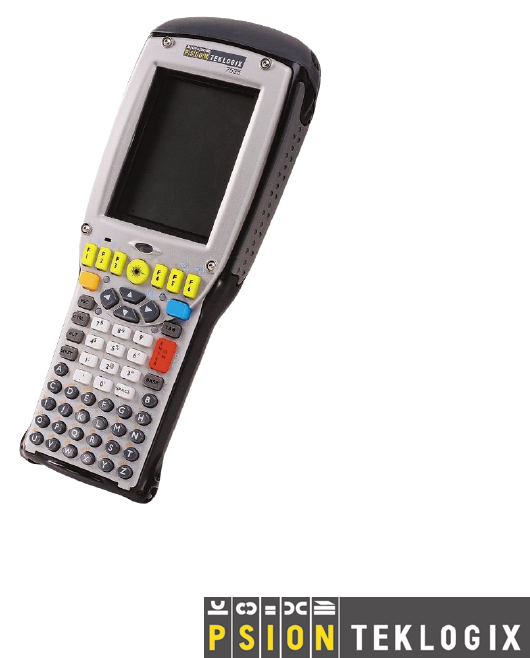
I
SO 9001 Certified
Quality Management System
7530 Hand-Held
Computer
User Manual
December 10, 2003 Part No. 8000007.B
© Copyright 2003 by Psion Teklogix Inc., Mississauga, Ontario
This document and the information it contains is the property of Psion Teklogix Inc.,
is issued in strict confidence, and is not to be reproduced or copied, in whole or in
part, except for the sole purpose of promoting the sale of Teklogix manufactured
goods and services. Furthermore, this document is not to be used as a basis for
design, manufacture, or sub-contract, or in any manner detrimental to the interests
of Psion Teklogix Inc.
All trademarks are the property of their respective holders.
Return-To-Factory Warranty
Psion Teklogix warrants a return-to-factory warranty for a period of one year from
shipment. The warranty on Psion Teklogix manufactured equipment does not extend
to any product that has been tampered with, altered, or repaired by any person other
than an employee of an authorized Psion Teklogix service organization. See Psion
Teklogix terms and conditions of sale for full details.
Service
When requesting service, please provide information concerning the nature of the
failure and the manner in which the equipment was used when the failure occurred.
Type, model, and serial number should also be provided. Before returning any
products to the factory, call the Customer Services Group for a Return
Authorization number.
Support Services
Psion Teklogix provides a complete range of product support services to its custom-
ers. In North America, these services can be accessed through the Psion Teklogix
Helpdesk. The Helpdesk coordinates repairs and training, helps you to troubleshoot
problems over the phone and arranges for technicians or engineers to come to your
site. For contact information and a listing of worldwide offices, please refer to
Appendix A: Support Services And Worldwide Offices
.
Disclaimer
Every effort has been made to make this material complete, accurate and up-to-date.
Teklogix Inc. reserves the right to make changes without notice and shall not be
held responsible for damages resulting from reliance on the material presented in
this manual.

Psion Teklogix 7530 Hand-Held Computer User Manual
I
P
ROGRAM
L
ICENSE
A
GREEMENTS
Microsoft's End User License Agreement
You have acquired a device (“DEVICE”) that includes software licensed by Psion
Teklogix Inc. from Microsoft Licensing Inc. or its affiliates (‘MS”). Those installed
software products of MS origin, as well as associated media, printed materials, and
“online” or electronic documentation (“SOFTWARE”) are protected by interna-
tional intellectual property laws and treaties. The SOFTWARE is licensed, not sold.
All rights reserved.
IF YOU DO NOT AGREE TO THIS END USER LICENSE AGREEMENT
(“EULA”), DO NOT USE THE DEVICE OR COPY THE SOFTWARE.
INSTEAD, PROMPTLY CONTACT PSION TEKLOGIX INC. FOR INSTRUC-
TIONS ON RETURN OF THE UNUSED DEVICE(S) FOR A REFUND.
ANY
USE
OF THE SOFTWARE, INCLUDING BUT NOT LIMITED TO USE ON
THE DEVICE, WILL CONSTITUTE YOUR AGREEMENT TO THIS EULA
(OR RATIFICATION OF ANY
PREVIOUS CONSENT).
GRANT OF SOFTWARE LICENSE.
This EULA grants you the following
license:
• You may use the SOFTWARE only on the DEVICE.
•
NOT FAULT TOLERANT
. THE SOFTWARE IS NOT FAULT TOLER-
ANT. PSION TEKLOGIX INC. HAS INDEPENDENTLY DETER-
MINED HOW TO USE THE SOFTWARE IN THE DEVICE, AND MS
HAS RELIED UPON PSION TEKLOGIX INC. TO CONDUCT SUFFI-
CIENT TESTING TO DETERMINE THAT THE SOFTWARE IS SUIT-
ABLE FOR SUCH USE.
• NO WARRANTIES FOR THE SOFTWARE.
THE SOFTWARE is pro-
vided “AS IS” and
with all faults. THE ENTIRE RISK AS TO SATIS-
FACTORY QUALITY, PERFORMANCE, ACCURACY, AND
EFFORT (INCLUDING LACK OF NEGLIGENCE) IS WITH YOU.
ALSO, THERE IS NO WARRANTY AGAINST INTERFERENCE
WITH YOUR ENJOYMENT OF THE SOFTWARE OR AGAINST
License Agreement
II
Psion Teklogix 7530 Hand-Held Computer User Manual
INFRINGEMENT.
IF YOU HAVE RECEIVED ANY WARRANTIES
REGARDING THE DEVICE OR THE SOFTWARE, THOSE WARRAN-
TIES DO NOT ORIGINATE FROM, AND ARE NOT BINDING ON, MS.
•
Note on Java Support
. The SOFTWARE may contain support for pro-
grams written in Java. Java technology is not fault tolerant and is not
designed, manufactured, or intended for use or resale as online control
equipment in hazardous environments requiring fail-safe performance, such
as in the operation of nuclear facilities, aircraft navigation or communica-
tion systems, air traffic control, direct life support machines, or weapons
systems, in which the failure of Java technology could lead directly to
death, personal injury, or severe physical or environmental damage. Sun
Microsystems, Inc. has contractually obligated MS to make this disclaimer.
• No Liability for Certain Damages.
EXCEPT AS PROHIBITED BY
LAW, MS SHALL HAVE NO LIABILITY FOR ANY INDIRECT,
SPECIAL, CONSEQUENTIAL OR INCIDENTAL DAMAGES
ARISING FROM OR IN CONNECTION WITH THE USE OR PER-
FORMANCE OF THE SOFTWARE. THIS LIMITATION SHALL
APPLY EVEN IF ANY REMEDY FAILS OF ITS ESSENTIAL PUR-
POSE. IN NO EVENT SHALL MS BE LIABLE FOR ANY AMOUNT
IN EXCESS OF U.S. TWO HUNDRED FIFTY DOLLARS
(U.S.$250.OO).
•
Limitations on Reverse Engineering, Decompilation, and Disassembly.
You
may not reverse engineer, decompile, or disassemble the SOFTWARE,
except and only to the extent that such activity is expressly permitted by
applicable law notwithstanding this limitation.
•
SOFTWARE TRANSFER ALLOWED BUT WITH RESTRICTIONS.
You
may permanently transfer rights under this EULA only as part of a per-
manent sale or transfer of the Device, and only if the recipient agrees to this
EULA. If the SOFTWARE is an upgrade, any transfer must also include all
prior versions of the SOFTWARE.
•
EXPORT RESTRICTIONS.
You acknowledge that SOFTWARE is
subject to U.S. export jurisdiction. You agree to comply with all applicable
international and national laws that apply to the SOFTWARE, including the
U.S. Export Administration Regulations, as well as end-user, end-use and
destination restrictions issued by U.S. and other governments. For addi-
tional information see http://www.microsoft.com/exporting/.
Psion Teklogix 7530 Hand-Held Computer User Manual
III
License Agreement
Meetinghouse Data Communications, Inc. End User License Agreement
End User License Agreement:
ATTENTION: PLEASE READ THIS SOFTWARE LICENSE AGREEMENT
("LICENSE") CAREFULLY BEFORE INSTALLATION. USE OF THE SOFT-
WARE IS SUBJECT TO THE SOFTWARE LICENSE TERMS SET FORTH
BELOW. USING THE SOFTWARE INDICATES YOUR ACCEPTANCE OF
THESE LICENSE TERMS. IF YOU DO NOT ACCEPT THESE LICENSE
TERMS, YOU MUST RETURN THE SOFTWARE FOR A FULL REFUND. IF
THE SOFTWARE IS SUPPLIED WITH ANOTHER PRODUCT, YOU MAY
RETURN THE ENTIRE UNUSED PRODUCT FOR A FULL REFUND.
Software License Terms:
The following terms govern your use of the enclosed Software unless you have a
separate written agreement with Meetinghouse Data Communications, Inc. herein
also known as “MDC”.
License Grant:
MDC grants you a non-exclusive and non-transferable license to Use one copy of
the Software. "Use" means storing, loading, installing, executing or displaying the
Software. “Software” means software, documentation and any fonts accompanying
this License whether on disk, in read only memory, on any other media or in any
other form. You may not modify the Software or disable any licensing or control
features of the Software. If the Software is licensed for "concurrent use", you may
not allow more than the maximum number of authorized users to Use the Software
concurrently.
The Software is licensed as a "Shareware" version, on one computer only. You may
use the Software distributed and licensed as Shareware on a trial basis only. The
shareware version of the Software may be distributed freely without any associated
fees to other parties who wish to try the software as long as the Software is distrib-
uted within an exact copy of the original MDC self-extracting installation file. In
other words, nothing may be left out of the Shareware as distributed on MDC's web
site at http://www.mtghouse.com.
License Agreement
IV
Psion Teklogix 7530 Hand-Held Computer User Manual
All permanent licenses are prepaid and the Software is licensed to you by MDC.
You own the media on which the Software is recorded but MDC and/or MDC’s
licensor(s) retain title to the Software. The Software and any copies which this
License authorizes you to make are subject to this License.
Permitted Uses and Restrictions:
This License allows you to install and use the Software on a single computer at a
time. This License does not allow the Software to exist on more than one computer
at a time. You may make one copy of the Software in machine-readable form for
backup purposes only. The backup copy must include all copyright information con-
tained on the original. Except as expressly permitted in this License, you may not, in
whole or part, decompile, reverse engineer, disassemble, modify, rent, lease, loan,
sublicense, distribute or create derivative works based upon the Software, or trans-
mit the Software over a network. You may not copy the Software onto any bulletin
board or similar system. You agree that you will not utilize any information obtained
from MDC or obtained or learned in the course of using the Software, to develop or
improve technology with similar functionality to the Software, nor will you directly
or indirectly assist any other party in doing so. You further agree that you will not
separate the various modules of the software for their different purposes, if any.
High Risk Activities:
The Software is not fault-tolerant and is not designed, manufactured or intended for
use or resale as on-line control equipment in hazardous environments requiring fail-
safe performance, such as in the operation of nuclear facilities, aircraft navigation or
communication systems, air traffic control, direct life support machines, or weapons
systems, in which the failure of the Software could lead directly to death, personal
injury, or severe physical or environmental damage ("High Risk Activities").
Accordingly, MDC and its suppliers specifically disclaim any express or implied
warranty of fitness for High Risk Activities. You agree that MDC and its suppliers
will not be liable for any claims or damages arising from the use of the Software in
such applications.
Ownership:
The Software is licensed, not sold. The Software is owned and copyrighted by MDC
or its third party suppliers. Your license confers no title or ownership in the Software
and is not a sale of any rights in the Software. You acknowledge such ownership and
intellectual property rights and will not take any action to jeopardize, limit or inter-
fere in any manner with MDC's or its suppliers' ownership of or rights with respect
Psion Teklogix 7530 Hand-Held Computer User Manual
V
License Agreement
to the Software. The Software is protected by copyright and other intellectual prop-
erty laws and by international treaties. MDC's third party suppliers may protect their
rights in the event of any violation of these License Terms.
Termination:
Your rights under this License will terminate automatically without notice from
MDC if you fail to comply with any term(s) of this License. Upon termination, you
must immediately destroy the Software, together with all copies, adaptations and
merged portions in any form.
U.S. Government Restricted Rights:
The Software and documentation have been developed entirely at private expense
and are provided as "Commercial Computer Software" or "restricted computer soft-
ware". They are delivered and licensed as "commercial computer software" as
defined in DFARS 252.227-7013 (Oct 1988), DFARS 252.211-7015 (May 1991) or
DFARS 252.227-7014 (Jun 1995), as a "commercial item" as defined in FAR 2.101
(a), or as "Restricted computer software" as defined in FAR 52.227-19 (Jun 1987)
(or any equivalent agency regulation or contract clause), whichever is applicable.
You have only those rights provided for such Software and Documentation by the
applicable FAR or DFARS clause or the MDC standard software agreement for the
product.
Export Law Assurances:
You may not use or otherwise export or reexport the Software except as authorized
by United States law and the laws of the jurisdiction in which the Software was
obtained. In particular, but without limitation, the Software may not be exported or
reexported (i) into (or to a national or resident of) any U.S. embargoed country or
(ii) to anyone on the U.S. Treasury Department's list of Specially Designated
Nationals or the U.S. Department of Commerce's Table of Denial Orders. By using
the Software, you represent and warrant that you are not located in, under control of,
or a national or resident of any such country or on any such list.
Limited Warranty on Media: (if applicable)
MDC warrants the media on which the Software is recorded to be free from defects
in materials and workmanship under normal use for a period of ninety (90) days
from the date of original retail purchase. Your exclusive remedy under this para-
graph shall be, at MDC's option, a refund of the purchase price of the product con-
taining the Software or replacement of the Software which is returned to MDC or a
License Agreement
VI
Psion Teklogix 7530 Hand-Held Computer User Manual
MDC authorized representative with a copy of the receipt. THIS LIMITED WAR-
RANTY AND ANY IMPLIED WARRANTIES ON THE MEDIA INCLUDING
THE IMPLIED WARRANTIES OF MERCHANTABILITY AND FITNESS FOR
A PARTICULAR PURPOSE ARE LIMITED IN DURATION TO NINETY (90)
DAYS FROM THE DATE OF ORIGINAL RETAIL PURCHASE. SOME JURIS-
DICTIONS DO NOT ALLOW LIMITATIONS ON HOW LONG AN IMPLIED
WARRANTY LASTS, SO THIS LIMITATION MAY NOT APPLY TO YOU. THE
LIMITED WARRANTY SET FORTH HEREIN IS EXCLUSIVE AND IN LIEU
OF ALL OTHERS, WHETHER ORAL OR WRITTEN, EXPRESS OR IMPLIED.
LICENSOR SPECIFICALLY DISCLAIMS ALL OTHER WARRANTIES. THIS
LIMITED WARRANTY GIVES YOU SPECIFIC LEGAL RIGHTS, AND YOU
MAY ALSO HAVE OTHER RIGHTS WHICH VARY BY JURISDICTION.
Disclaimer of Warranty on Software:
You expressly acknowledge and agree that use of the Software is at your sole risk.
The Software is provided "AS IS" and without warranty of any kind and MDC and
MDC’s licensor(s) (for the purposes of warranty and liability, MDC and MDC's
licensor(s) shall be collectively referred to as "MDC") EXPRESSLY DISCLAIM
ALL WARRANTIES AND/OR CONDITIONS, EXPRESS OR IMPLIED,
INCLUDING, BUT NOT LIMITED TO, THE IMPLIED WARRANTIES
AND/OR CONDITIONS OF MERCHANTABILITY OR SATISFACTORY
QUALITY AND FITNESS FOR A PARTICULAR PURPOSE AND NONIN-
FRINGEMENT OF THIRD PARTY RIGHTS. LICENSOR DOES NOT WAR-
RANT THAT THE FUNCTIONS CONTAINED IN THE SOFTWARE WILL
MEET YOUR REQUIREMENTS, OR THAT THE OPERATION OF THE SOFT-
WARE WILL BE UNINTERRUPTED OR ERROR-FREE, OR THAT DEFECTS
IN THE SOFTWARE WILL BE CORRECTED. FURTHERMORE, LICENSOR
DOES NOT WARRANT OR MAKE ANY REPRESENTATIONS REGARDING
THE USE OR THE RESULTS OF THE USE OF THE SOFTWARE OR
RELATED DOCUMENTATION IN TERMS OF THEIR CORRECTNESS,
ACCURACY, RELIABILITY, OR OTHERWISE. NO ORAL OR WRITTEN
INFORMATION OR ADVICE GIVEN BY LICENSOR OR AN LICENSOR
AUTHORIZED REPRESENTATIVE SHALL CREATE A WARRANTY OR IN
ANY WAY INCREASE THE SCOPE OF THIS WARRANTY. SHOULD THE
SOFTWARE PROVE DEFECTIVE, YOU (AND NOT LICENSOR OR AN
LICENSOR AUTHORIZED REPRESENTATIVE) ASSUME THE ENTIRE
COST OF ALL NECESSARY SERVICING, REPAIR OR CORRECTION. SOME
JURISDICTIONS DO NOT ALLOW THE EXCLUSION OF IMPLIED WAR-
Psion Teklogix 7530 Hand-Held Computer User Manual
VII
License Agreement
RANTIES, SO THE ABOVE EXCLUSION MAY NOT APPLY TO YOU. THE
TERMS OF THIS DISCLAIMER DO NOT AFFECT OR PREJUDICE THE
STATUTORY RIGHTS OF A CONSUMER ACQUIRING LICENSOR PROD-
UCTS OTHERWISE THAN IN THE COURSE OF A BUSINESS, NEITHER DO
THEY LIMIT OR EXCLUDE ANY LIABILITY FOR DEATH OR PERSONAL
INJURY CAUSED BY LICENSOR’S NEGLIGENCE.
Limitation of Liability:
UNDER NO CIRCUMSTANCES, EXCEPT TO THE EXTENT PROHIBITED
BY LOCAL LAW, INCLUDING NEGLIGENCE, SHALL LICENSOR, ITS SUB-
SIDIARIES, AFFILIATES, OR SUPPLIERS BE LIABLE FOR ANY DIRECT,
INCIDENTAL, SPECIAL, INDIRECT OR CONSEQUENTIAL DAMAGES
(INCLUDING LOST PROFIT, LOST DATA, OR DOWNTIME COSTS) ARIS-
ING OUT OF OR RELATING TO THIS LICENSE, THE USE, INABILITY TO
USE, OR THE RESULTS OF USE OF THE SOFTWARE, WHETHER BASED IN
WARRANTY, CONTRACT, TORT OR OTHER LEGAL THEORY, AND
WHETHER OR NOT ADVISED OF THE POSSIBILITY OF SUCH DAMAGES.
In no event shall MDC's total liability to you for all damages exceed the price paid
for the license to use the Software, regardless of the form of the claim.
Government End Users:
If the Software is supplied to the United States Government, the Software is classi-
fied as "restricted computer software" as defined in clause 52.227-19 of the FAR.
The United States Government's rights to the Software are as provided in clause
52.227-19 of the FAR.
Controlling Law and Severability:
This License shall be governed by the laws of the United States and the State of
New Hampshire. As to any dispute relating to this License or the Software, you fur-
ther agree to jurisdiction and venue in the Federal and State Courts located in the
State of New Hampshire. If for any reason a court of competent jurisdiction finds
any provision, or portion thereof, to be unenforceable, the remainder of this License
shall continue in full force and effect.
Acknowledgement:
Your use of any software produced by MDC is based only on your acknowledge-
ment that you have read this License, understand it, and agree to be bound by its
terms and conditions.
License Agreement
VIII
Psion Teklogix 7530 Hand-Held Computer User Manual
MDC Acknowledgments:
This product includes software developed by MDC and its licensors. This product
includes software developed by the OpenSSL Project for use in the OpenSSL Tool-
kit (http://www.openssl.org/)". This product includes cryptographic software written
by Eric Young (eay@cryptsoft.com). This product includes software written by Tim
Hudson (tjh@cryptsoft.com).
Complete Agreement:
This License constitutes the entire agreement between the parties with respect to the
use of the Software and supersedes all prior or contemporaneous understandings
regarding such subject matter. No amendment to or modification of this License will
be binding unless in writing and signed by MDC.
NOTE: EXCEPT TO THE EXTENT ALLOWED BY LOCAL LAW, THESE
WARRANTY TERMS DO NOT EXCLUDE, RESTRICT, OR MODIFY, AND
ARE IN ADDITION TO, THE MANDATORY STATUTORY RIGHTS APPLICA-
BLE TO THE LICENSE OF THE SOFTWARE TO YOU.
Meetinghouse Data Communications, Inc.
150 Greenleaf Avenue, Unit F
Portsmouth, NH 03801
Revised 8/12/2002

Psion Teklogix 7530 Hand-Held Computer User Manual
i
T
ABLE
OF
C
ONTENTS
Program License Agreements
..............................I
Approvals And Safety Summary
...........................xiii
Chapter 1: Introduction
1.1 About This Manual ............................3
1.2 Text Conventions .............................4
1.3 About The 7530 Hand-Held Computer ..................5
1.3.1 Features...............................5
1.3.2 The 7530 Hand-Held Computer ..................7
1.3.3 Regulatory Labels .........................9
Chapter 2: Basic Checkout
2.1 Preparing The 7530 For Operation ....................13
2.1.1 Equipment You Need To Get Started ...............13
2.1.2 Charging The Battery .......................13
2.1.3 Attaching Carrying Accessories ..................13
2.1.3.1 Attaching The Hand Strap ................14
2.1.3.2 Attaching The Pistol Grip ................15
2.2 Powering Up The 7530 And Configuring The Radio ...........16
2.2.1 Installing The Battery And Switching The 7530 On........17
2.2.2 Configuring An IEEE 802.11 Radio Installed In The 7530 ....18
2.2.3 Assigning An IP Address .....................24
2.2.4 Name Servers Tab .........................25
2.2.5 Advanced Features .........................26
2.2.5.1 Rearranging Preferred Networks ............26
2.2.5.2 Deleting A Preferred Network..............27
2.2.5.3 Changing Network Properties ..............27
2.3 Checking The Scanner ..........................27
2.4 Using Microsoft® ActiveSync® To Work With Files...........27
Contents
ii
Psion Teklogix 7530 Hand-Held Computer User Manual
2.5 Calibrating The Touchscreen ......................28
2.6 Resetting The 7530 Hand-Held .....................28
Chapter 3: Getting To Know Your 7530
3.1 Features Of The 7530 ..........................31
3.2 The Battery................................32
3.2.1 Battery Safety ...........................32
3.2.2 Removing And Installing The Battery Pack ...........32
3.2.3 Charging The Battery .......................33
3.3 Switching The 7530 Hand-Held On And Off ..............34
3.4 The Keyboard ..............................35
3.4.1 Modifier Keys...........................35
3.4.1.1 Activating Modifier Keys................36
3.4.1.2 Locking Modifier Keys.................36
3.4.2 The Keys .............................36
3.4.3 The 58-Key Keyboard ......................37
3.4.4 The 36-Key Keyboard ......................38
3.4.5 The Keypad Backlight ......................40
3.5 The Display ...............................40
3.5.1 Adjusting The Display Backlight.................40
3.5.2 Adjusting The Contrast ......................41
3.5.3 Calibrating The Touchscreen ...................41
3.6 7535 Indicators..............................42
3.6.1 LEDs ...............................42
3.6.1.1 Charge LED ......................43
3.6.1.2 Radio Traffic LED ...................44
3.6.1.3 Scan LED........................44
3.6.1.4 User Application LED .................44
3.6.2 Onscreen Indicators........................45
3.6.3 Audio Indicators .........................47
3.6.3.1 Adjusting The Beeper Volume .............48
3.7 Internal Scanners.............................48
3.7.1 Scanning Techniques .......................49
3.7.2 Scan LED Indicators .......................49
3.7.3 Troubleshooting..........................50
3.7.4 Operating One Dimensional (1D) Internal Laser Scanners....50
3.7.5 Operating Internal PDF Laser Scanners .............51
Psion Teklogix 7530 Hand-Held Computer User Manual
iii
Contents
3.7.6 Operating Internal Two Dimensional (2D) Imager Scanners . . .51
3.8 Connecting & Disconnecting Tethered Peripherals............52
3.9 Monitoring The Battery And Maximizing Run Time ...........53
3.9.1 Storing Batteries ..........................55
3.10 Monitoring The Network Connection...................55
3.11 Uploading Data In A Docking Station ..................56
3.12 General Maintenance ...........................56
3.12.1 Caring For The Touchscreen....................56
3.12.2 Cleaning The 7535 .........................57
Chapter 4: Working With Windows CE
4.1 Navigating In Windows CE And Applications ..............61
4.1.1 Navigating Using A Touchscreen And Stylus ...........61
4.1.2 Navigating Using The Keyboard..................62
4.2 Working With Files, Folders And Programs ...............63
4.3 The Startup Desktop............................64
4.3.1 The Desktop Icons .........................65
4.3.2 The Taskbar ............................66
4.3.2.1 Using The Taskbar ....................66
4.3.2.2 Customizing The Taskbar ................67
4.4 The Start Menu ..............................68
4.4.1 The Desktop ............................68
4.4.2 Security Settings ..........................69
4.4.3 The System Tray ..........................70
4.4.4 The Task Manager .........................71
4.4.5 Cycle Tasks.............................71
4.4.6 Power Info .............................71
4.4.7 Programs ..............................72
4.4.8 Settings ...............................73
4.4.9 Run .................................74
4.4.10 Shutdown..............................75
4.5 Using A Dialogue Box ..........................76
Chapter 5: Configuration
5.1 Remote Desktop Connection .......................83
5.2 Pocket PC Compatibility .........................83
Contents
iv
Psion Teklogix 7530 Hand-Held Computer User Manual
5.3 The Control Panel ............................83
5.4 Control Panel Icons ...........................84
5.5 Basic Setup................................88
5.5.1 Display Properties.........................88
5.5.1.1 Display Contrast ....................88
5.5.1.2 Display Backlight ...................89
5.5.1.3 Display Appearance ..................91
5.5.2 Keyboard Properties .......................92
5.5.2.1 Key Repeat .......................92
5.5.2.2 Keyboard Backlight ..................93
5.5.2.3 Keyboard One Shot Modes...............94
5.5.2.4 Keyboard Macro Keys .................95
5.5.2.5 Unicode Mapping ...................97
5.5.3 Volume And Sound Properties ..................99
5.5.3.1 Volume Adjustments ..................99
5.5.4 Power Management Properties ..................100
5.5.4.1 Battery Capacity ....................100
5.5.4.2 Power Saving Schemes.................101
5.5.4.3 Suspend Threshold ...................102
5.5.4.4 Charger Details .....................103
5.5.5 Stylus Properties .........................103
5.5.5.1 Setting Double-Tap Sensitivity.............104
5.5.5.2 Touchscreen Calibration ................104
5.5.6 Certificate Assignment ......................105
5.7 Scanner Properties Setup ........................118
5.7.1 Scanner Options..........................118
5.7.2 Bar Codes .............................121
5.7.2.1 Code 39 Settings ....................122
5.7.2.2 Code 128 Settings ...................124
5.7.2.3 EAN 13 Settings ....................125
5.7.2.4 EAN 8 .........................126
5.7.2.5 UPC And EAN Settings ................127
5.7.2.6 UPC A Settings.....................127
5.7.2.7 UPC E Settings .....................127
5.7.2.8 Codabar.........................128
5.7.2.9 Code 93.........................128
5.7.2.10 Code 11.........................128
Psion Teklogix 7530 Hand-Held Computer User Manual
v
Contents
5.7.2.11 Interleaved 2 of 5 ...................129
5.7.2.12 MSI Plessey ......................129
5.7.2.13 Discrete 2 of 5 .....................129
5.7.2.14 IATA 2 of 5 ......................130
5.7.2.15 Postal: Australian ...................130
5.7.2.16 Postal: Japanese ....................130
5.7.2.17 Postal: Korean .....................130
5.7.2.18 Postal: PlaNET.....................131
5.7.2.19 Postal: PostNET ....................131
5.7.2.20 Postal: Royal Mail ...................131
5.7.2.21 2D DataMatrix.....................131
5.7.2.22 2D Maxicode......................131
5.7.2.23 2D PDF-417 ......................131
5.7.2.24 2D Micro PDF-417 ..................132
5.7.2.25 2D QR Code ......................132
5.7.2.26 2D RSS Code .....................132
5.7.2.27 Aztec ..........................132
5.7.3 Translations ...........................132
5.8 SNMP (Simple Network Management Protocol) Setup ........134
5.8.1 Contact Tab............................135
5.8.2 Communities Tab ........................136
5.8.2.1 Adding A Community .................137
5.8.2.2 Modifying A Community Setting ...........138
5.8.2.3 Removing An Existing Community ..........138
5.8.3 Trap Destination Tab.......................139
5.8.3.1 Enabling Authentication TRAPS ...........139
5.8.3.2 Adding A Destination .................139
5.8.3.3 Changing A Destination ................140
5.8.3.4 Removing A Trap Destination .............140
5.8.4 Permitted Hosts Tab .......................141
5.8.4.1 Adding A Host .....................141
5.8.4.2 Changing A Host....................142
Chapter 6: Tekterm Application
6.1 The Tekterm Application ........................147
6.2 Additional Keyboard Functions .....................147
6.2.1 Function Keys And Softkeys...................147
6.2.1.1 Function Keys .....................147
6.2.1.2 Softkey Function Keys.................148
6.2.2 Macro Keys............................149
Contents
vi
Psion Teklogix 7530 Hand-Held Computer User Manual
6.3 Keyboard Modes.............................150
6.3.1 View Mode ............................150
6.3.1.1 Changing Font Sizes ..................150
6.3.1.2 Panning The Screen Contents .............150
6.3.1.3 Exiting View Mode ...................151
6.3.2 Using The Task Manager To Switch Between Applications. . .152
6.4 The Tekterm Status Area.........................153
6.5 TESS Emulation .............................154
6.5.1 Configuration ...........................154
6.5.2 Working With Multiple Sessions .................154
6.5.3 The Field Types..........................154
6.5.4 IBM 5250 Emulation Keys ....................155
6.5.5 Data Entry.............................155
6.5.5.1 TESS Edit Modes And Cursor Movement .......156
6.5.5.2 <DEL> Key Behaviour In TESS ............157
6.5.5.3 <BKSP> Key Behaviour In TESS ...........158
6.5.6 TESS Status Message.......................159
6.5.7 Lock Messages ..........................160
6.5.8 Control Commands ........................160
6.5.9 Resetting A TESS Session ....................160
6.5.10 The Local Menu .........................161
6.5.11 Selecting Another Host Computer ................161
6.5.12 Queuing Mode ..........................162
6.6 ANSI Emulation .............................162
6.6.1 Configuration ...........................162
6.6.2 Sending Data To The Host ....................163
6.6.3 Psion Teklogix Keyboard And VT220 Equivalent Keys.....163
6.6.4 Block Mode (Local Editing) ...................164
6.6.5 Working With Sessions......................165
6.6.5.1 Establishing A New Session ..............165
6.6.5.2 Listing Sessions And Moving To Other Sessions . . .165
6.6.5.3 Closing A Session ...................165
6.6.5.4 Printing A Screen....................166
6.6.5.5 Smart Echo – Disabling ................166
6.7 The Radio Statistics Screen .......................166
6.8 The Tekterm Startup Display Menu ...................168
6.9 Working With Menus ..........................169
Psion Teklogix 7530 Hand-Held Computer User Manual
vii
Contents
6.9.1 Using The Keyboard To Navigate Through Menus .......170
6.9.1.1 Sub-Menus.......................170
6.9.1.2 Numeric Parameters ..................170
6.9.1.3 Y/N Parameters ....................171
6.9.1.4 Alpha Parameters ...................171
6.9.1.5 String Entry Parameters ................171
6.9.2 Using The Touchscreen To Navigate Through Menus .....173
6.9.2.1 Sub-Menus.......................173
6.9.2.2 Numeric Parameters ..................174
6.9.2.3 Y/N Parameters ....................174
6.9.2.4 Alpha Parameters ...................174
6.9.2.5 String Entry Parameters ................174
6.9.3 Saving Changes To Parameters .................175
6.9.4 Retrieving Default Parameter Values ..............175
6.10 Resetting The 7535 Hand-Held Computer ...............175
6.11 The Parameters Menu ..........................176
6.11.1 Security Settings .........................176
6.12 Display Options .............................177
6.13 More Parameters ............................177
6.14 Radio Parameters ............................179
6.15 System Parameters ...........................180
6.15.1 Keyboard .............................181
6.15.1.1 Macro Control Panel..................181
6.15.1.2 Indicators........................182
6.15.1.3 Softkeys ........................182
6.15.1.4 Ctrl Panel .......................182
6.15.2 Audio ...............................183
6.15.3 Power Mgmt Ctrl Panel .....................184
6.15.4 Security..............................185
6.15.4.1 Default Mode .....................185
6.15.4.2 User Level Options ..................185
6.15.4.3 Sup. Password .....................186
6.15.4.4 Allow Teklogix ....................186
6.16 Scanner Control Panel..........................187
6.17 View Manager..............................187
6.17.1 Split Screen............................188
6.17.1.1 Splitting And Displaying Screens ...........189
6.17.1.2 Moving Between Split Screens ............190
6.17.1.3 Toggling Between Full & Split Screens ........190
Contents
viii
Psion Teklogix 7530 Hand-Held Computer User Manual
6.17.1.4 Using The Asterisk As A Wild Card ..........190
6.17.2 Custom Characters (Unicode™) .................191
6.17.2.1 Creating A Unicode™ Character............191
6.17.2.2 Displaying The Unicode™ Pop-up Window......192
6.18 Applications ...............................194
6.18.1 ANSI Settings...........................195
6.18.1.1 Host Conn .......................196
6.18.1.2 Screen..........................199
6.18.1.3 Xmit Modes ......................202
6.18.1.4 Kbd Modes .......................206
6.18.1.5 Edit Modes .......................209
6.18.1.6 Serial ..........................210
6.18.1.7 Host Char Set......................210
6.18.1.8 Anchor View ......................211
6.18.2 TESS Settings...........................212
6.18.2.1 Host Conn. .......................213
6.18.2.2 Screen..........................214
6.18.2.3 Characters .......................216
6.18.2.4 Tests ..........................218
6.18.2.5 Features.........................219
6.18.2.6 Scanner .........................223
6.18.2.7 Fields ..........................224
6.18.2.8 Anchor View ......................227
6.18.2.9 Emulation........................227
6.19 Ports– Tether And Console........................235
6.19.1 Tether And Console Port Peripheral Options...........235
6.19.2 Tether And Console Port Parameter Settings...........236
6.19.3 Tether And Console Port Scan-See Parameters .........239
6.19.3.1 Scan-See Sub-Menu – Mapping The Viewport ....239
6.19.3.2 Scan-See Keyboard Mapping .............244
6.20 Network .................................244
6.20.1 Network Ctrl Panel Settings ...................245
6.20.2 802.IQ v2 .............................245
Chapter 7: Peripheral Devices & Accessories
7.1 External Bar Code Readers .......................251
7.1.1 PowerScan™ Standard, LR and XLR Bar Code Scanners....251
7.1.2 Entering Data With The Bar Code Reader ............251
7.2 The 7530 Battery.............................251
Psion Teklogix 7530 Hand-Held Computer User Manual
ix
Contents
7.2.1 Lithium-Ion Battery Safety Precautions .............252
7.3 Important Charger Safety Instructions .................253
7.4 Chargers .................................254
7.5 Gang Charger ..............................254
7.5.1 Installation ............................255
7.5.2 Operator Controls ........................255
7.5.3 Charge Indicators.........................256
7.5.4 Charging Batteries ........................256
7.5.5 Troubleshooting .........................257
7.5.5.1 Excessive Charge Duration ..............257
7.5.5.2 Indicator Flashing Red.................257
7.5.5.3 Power LED Does Not Light Up ............257
7.5.5.4 Indicator Does Not Light When Battery Installed. . . 258
7.6 Combo Charger .............................258
7.6.1 Installation ............................258
7.6.2 Operator Controls ........................259
7.6.3 Using the Combo Charger With The 7530............259
7.6.4 Charging The Spare Battery ...................259
7.6.5 Charge Indicators.........................260
7.6.6 Troubleshooting .........................260
7.7 Combo Dock ..............................261
7.7.1 Installation ............................261
7.7.2 Using The Combo Dock .....................261
7.7.3 Network Access .........................261
7.7.4 Troubleshooting .........................262
7.8 Quad Dock ...............................262
7.8.1 Installation ............................262
7.8.2 Indicators And Controls .....................263
7.8.3 Using The Quad Dock ......................263
7.8.4 Network Access .........................263
7.8.4.1 Network Addressing ..................263
7.8.5 Battery Charging .........................263
7.8.6 Troubleshooting .........................264
7.8.6.1 Network Link Unsuccessful ..............264
7.8.6.2 7530 LED Does Not Light When Docked.......264
7.9 Portable Docking Module (PDM)....................264
7.10 Bluetooth Peripherals ..........................268
Contents
x
Psion Teklogix 7530 Hand-Held Computer User Manual
7.11 The 7530 Picker Cradle .........................268
7.11.1 Picker Cradle Mounting Recommendations ...........269
7.11.1.1 Mounting Template...................269
7.11.2 Wiring Guidelines ........................270
7.11.3 Using The Picker Cradle .....................270
7.11.4 Maintaining The Picker Cradle ..................270
7.11.5 Powered Cradle Installation In High Voltage Vehicles .....271
7.11.5.1 Extreme Wet Environments ..............271
7.11.6 Powered Cradle Installation ...................272
7.11.6.1 Wiring Vehicle Power To The Cradle .........273
7.11.7 The Port Replicator ........................274
Chapter 8: Specifications
8.1 7530 Hand-Held Computer Specifications ...............277
8.2 Radio Specifications ...........................279
8.3 Bar Code Scanning............................279
8.3.1 Internal Scanners .........................279
8.3.2 Internal Scanner Port .......................280
8.3.3 External Scanners .........................280
8.4 Internal Scanner Specifications .....................281
8.4.1 SE1200 High Performance & Long Range Specs ........281
8.4.2 SE1200 Advanced Long Range & SE2223 PDF Specs .....282
8.4.3 Decode Zones ...........................284
8.5 External Scanner Specifications .....................284
8.5.1 PowerScan™ LR and XLR Industrial Scanner Specs ......284
8.5.2 PowerScan™ Standard Range Scanner Specs ..........287
8.6 Lithium-Ion Battery Pack ........................288
Appendix A: Support Services And Worldwide Offices
A.1 Support Services .............................A-1
A.1.1 Canada and USA: Technical Support and Repair Services . . .A-1
A.1.2 International Support.......................A-1
Appendix B: Port Pinouts
B.1 7530 Tether Port Pinout .........................B-1
Psion Teklogix 7530 Hand-Held Computer User Manual
xi
Contents
B.2 Docking Station Connector .......................B-1
B.3 Battery Contacts.............................B-2
Appendix C: USB Setup Application
C.1 USB Setup................................C-1
C.1.1 Launching The Application ...................C-1
C.1.2 Pre-Installation: Updating usbstor.inf And wceusbsh.inf ....C-2
C.1.3 Installation: Installing The 7530 As a Device On Your PC . . . C-4
C.1.4 Post Installation .........................C-5

Psion Teklogix 7530 Hand-Held Computer User Manualxiii
APPROVALS AND SAFETY SUMMARY
Declaration Of Conformity
Product: 7530 Hand Held Micro-computer with Portable Docking Module
Application of Council R&TTE Directive: 1999/5/EEC
Directive(s): EMC Directive: 89/336/EEC
Low Voltage Directive: 73/23/EEC
Conformity Declared Article 3.1a (Health): EN 60950: 2000
to Standards: Article 3.1b (EMC): EN 301 489-17: v1.1.1; 09-2000
Article 3.2 (RF Spectrum): EN 300 328-2: v 1.1.1; 07 2000
EN 55022: 1998 + Am 1, Class B;
EN 61000-3-2; EN 61000-3-3
EN 55024:1998;
EN 61000-4-2; ±4kV CD; ±8kV AD
EN 61000-4-3; 3V/m, 80-1000 MHz
EN 61000-4-4; ±1kV Power lines
EN 61000-4-5; ±1kV Differential mode
EN 61000-4-6; 3VRMS, 150kHz-80MHz
EN 61000-4-11; AC Mains Ports
Manufacturer: PSION TEKLOGIX INC.
2100 Meadowvale Boulevard
Mississauga, Ontario, Canada
L5N 7J9
Year of Manufacture: 2003
Manufacturer’s Address PSION TEKLOGIX S.A.
in the European La Duranne; 135 Rue Rene Descartes; BP 421000
Community: 13591 Aix-En-Provence
Cedex 3; France
Type of Equipment: Information Technology Equipment
Equipment Class: Commercial and Light Industrial
I the undersigned hereby declare that the equipment specified above conforms to
the above directives and standards.
Manufacturer: Rob Williams
Vice President of Engineering
Psion Teklogix Inc. Ontario
Legal Representative Domique Binckly
Vice President International Sales
Psion Teklogix S.A. France

Approvals And Safety Summary
xivPsion Teklogix 7530 Hand-Held Computer User Manual
FCC DECLARATION OF CONFORMITY (DoC)
Applicant’s Name & Address: PSION TEKLOGIX
2100 Meadowvale Blvd.
Mississauga, Ontario
Canada L5N 7J9
Contact Person: Iain Roy
Telephone No.: (905) 813-9900
US Representative’s Name & Address: 1810 Airport Exchange Blvd., Suite 500
Erlanger, KY, 41018, USA
Contact Person: Joe Musgrave
Telephone No.: (859) 372-4106
Equipment Type/Environment: Computing Devices
Trade Name / Model No.: 7530 Hand Held Micro-computer with
Portable Docking Module
Year of Manufacture: 2003
Standard(s) to which Conformity is Declared:
The 7530 Hand Held Micro-computer with Portable Docking Module, supplied by Psion
Teklogix, has been tested and found to comply with FCC PART 15, SUBPART B -
UNINTENTIONAL RADIATORS, CLASS B COMPUTING DEVICES FOR
HOME & OFFICE USE.
I, the undersigned, hereby declare that the equipment as tested is representative within
manufacturing tolerance to units.
Applicant Legal Representative in U.S.
Signature Signature
Rob Williams Joe Musgrave
Full Name Full Name
Vice President of Engineering V.P. Global Solutions, Americas
Position Position
Mississauga, Ontario, Canada Erlanger, KY 41018, USA
Place Place
July 4, 2003 July 4, 2003
Date Date

Psion Teklogix 7530 Hand-Held Computer User Manualxv
Approvals And Safety Summary
This equipment complies with Class B Part 15 of the FCC rules.
Operation is subject to the following two conditions:
1. This device may not cause harmful interference, and
2. This device must accept any interference received, including interfer-
ence that may cause undesired operation.
Changes or modifications not expressly approved by Psion Teklogix, the party
responsible for compliance, may void the user's authority to operate the equipment.
1. FCC Information to Users
For Class B Unintentional Radiators:
This equipment has been tested and found to comply with the limits for a Class B
digital device, pursuant to Part 15 of the FCC Rules. These limits are designed to
provide reasonable protection against harmful interference in a residential instal-
lation. This equipment generates, uses, and can radiate radio frequency energy
and, if not installed and used in accordance with the instruction manual, may
cause harmful interference to radio communications. However, there is no guaran-
tee that interference will not occur in a particular installation. If this equipment
does cause harmful interference to radio or television reception, which can be
determined by turning the equipment off and on, the user is encouraged to try to
correct the interference by one of more of the following measures:
• Reorient or relocate the receiving antenna
• Increase the separation between the equipment and receiver
• Connect the equipment into an outlet on a circuit different from that to
which the receiver is connected.
• Consult the dealer or an experienced radio/TV technician for help.
2. Warning to Users
Warning: Changes or modifications not expressly approved by Psion
Teklogix Inc. could void the user's authority to operate the
equipment.

Approvals And Safety Summary
xviPsion Teklogix 7530 Hand-Held Computer User Manual
LASER WARNINGS
For your own safety, it is critical that you comply with the following warnings:
CAUTION
Do not look into the laser beam or point the beam at people or animals.
CAUTION
Using controls or adjustments, or performing procedures other than those
specified herein may result in hazardous radiation exposure.
CAUTION
The use of optical instruments with this product will increase eye hazard.
This product contains a laser scanner that emits less than 1.2 mW maximum radiant
power at a wavelength of 650nm or 680nm. This product complies with 21 CFR
1040.10, 1040.11 and DIN EN 60825-1: 2001, and is classified as a Class 2 laser
product.
The SE1200 ALR has an maximum radiated power less than 1.4 mW; according to
EN 60825-1: 2001 it is classified as a Class 3B laser product.
DO NOT OPERATE IN AN EXPLOSIVE ATMOSPHERE
Operating Psion Teklogix equipment where explosive gas is present may
result in an explosion.
DO NOT REMOVE COVERS OR OPEN ENCLOSURES
To avoid injury, the equipment covers and enclosures should only be
removed by qualified service personnel. Do not operate the equipment
without the covers and enclosures properly installed.
WARNING: This portable RF transmitting device has been tested and found to
comply with FCC and IC RF exposure requirements with the maximum SAR of 0.77
Watts/Kg with body tissue. The antenna used for this transmitter must not be
co-located in conjunction with any other antenna or transmitter.

Psion Teklogix 7530 Hand-Held Computer User Manualxvii
Approvals And Safety Summary
CAUTION!Danger of explosion if a 7535 battery is incorrectly handled, charged,
disposed of or replaced. Replace only with the same or equivalent type
recommended by the manufacturer. Dispose of used batteries according to
the instructions described in “Lithium-Ion Battery Safety Precautions” on
page 252. Carefully review all battery safety issues.
VORSICHT!Explosiongefahr bei unsachgemäßem Austausch der Batterie Ersatz nur
durch denselben oder einen vom Hersteller empfohlenen gleichwertigen
Typ. Entsorgung gebrauchter Batterien nach Angaben des Herstellers.

Psion Teklogix 7530 Hand-Held Computer User Manual1
INTRODUCTION 1
1
1.1 About This Manual ..............................3
1.2 Text Conventions ...............................4
1.3 About The 7530 Hand-Held Computer ....................5
1.3.1 Features .................................5
1.3.2 The 7530 Hand-Held Computer .....................7
1.3.3 Regulatory Labels ............................9
Psion Teklogix 7530 Hand-Held Computer User Manual3
Chapter 1: Introduction
About This Manual
1.1 About This Manual
This manual describes how to configure, operate and maintain the Psion Teklogix
7535 hand-held computer.
Chapter 1: Introduction
provides a basic overview of the 7530 hand-held.
Chapter 2: Basic Checkout
describes the steps required to get the 7530 ready for operation.
Chapter 3: Getting To Know Your 7530
describes the 7535 features and outlines how to charge and maintain the battery.
This chapter also provides a description of the keyboard, how to navigate in
Microsoft® Windows® CE, how to use the internal scanner, and so on.
Chapter 4: Working With Windows CE
describes the Microsoft® Windows® CE desktop and how to use it. This
chapter also outlines the basics of moving around a Windows CE window,
selecting and opening icons, files, folders and working with a Windows
dialogue box.
Chapter 5: Configuration
provides a description of the Windows CE Control Panel and how to use it
to configure the 7530, along with the scanners attached to the hand-held,
and so on.
Chapter 6: Tekterm Application
describes TESS and ANSI operations. This chapter also provides descriptions of
the Tekterm parameters.
Chapter 7: Peripheral Devices & Accessories
describes the peripherals and accessories available for your 7535 hand-held.
Chapter 8: Specifications
details radio, hand-held computer and battery specifications.
Appendix A: Support Services And Worldwide Offices
provides the helpdesk phone number at the Mississauga, Ontario, Canada office
and details the support services available. This appendix also lists the world-
wide office addresses and phone numbers.
Appendix B: Port Pinouts
includes 7530 pinouts.

Chapter 1: Introduction
Text Conventions
4Psion Teklogix 7530 Hand-Held Computer User Manual
1.2 Text Conventions
Note: Notes highlight additional helpful information.
Important: These statements provide particularly important instructions
or additional information that is critical to the operation of
the equipment.
Warning: These statements provide critical information that may prevent
physical injury, equipment damage or data loss.
Psion Teklogix 7530 Hand-Held Computer User Manual5
Chapter 1: Introduction
About The 7530 Hand-Held Computer
1.3 About The 7530 Hand-Held Computer
The 7535 is a ruggedized hand-held personal computer, running the Microsoft®
Windows® CE.net operating system. It is intended for use in commercial and light
industrial applications with a focus on real time wireless data transactions. All
possible bar code input methodologies are supported by one of the variety of
scanners available. Optimization for specific operational environments is supported
with a wide range of peripheral options and carrying accessories.
1.3.1 Features
• Rugged design:
- sealed from water and dust to IP54 (light rain) rating.
- withstands multiple drops of up to 6.5 feet onto concrete.
• Large 240 x 320 portrait mode display that is available in colour or black
and white with or without a touchscreen
• Automatic backlighting for both the display and the keypad.
- automatic backlight and contrast control.
- daylight readable screen.
• Processor and memory:
- Intel PXA255 400Mhz CPU with 32 MB FLASH and 64 MB RAM
standard.
• Microsoft® Windows® CE.net operating system
• Application software:
- Internet Explorer for CE.
- Tekterm terminal emulation.
• Ergonomic keyboard designed to accommodate left- and right-handed use.
• Two keyboard formats available:
- 58-key with 6 function keys (standard).
- 36-key large button with 10 function keys.
- keypads feature EL backlight for visibility in low-light conditions.
• Wireless communication:
- Compact FLASH slot normally equipped with an IEEE 802.11b
11 Mbps 2.4GHz Wi-Fi radio.
Chapter 1: Introduction
Features
6Psion Teklogix 7530 Hand-Held Computer User Manual
- standard antenna integrated onto radio card.
- optional high performance internal antenna available.
- Bluetooth SD I/O radio.
• Expansion slot:
- SD I/O slot that supports extra FLASH memory (up to 512 MB)
• Programming environment:
-HTML
- .net Compact framework
- Java, Visual C++
• Bar code applications:
- internal 1D and 2D scan engines.
- internal CMOS image capture scan engine.
- supports decoded and undecoded tethered scanners.
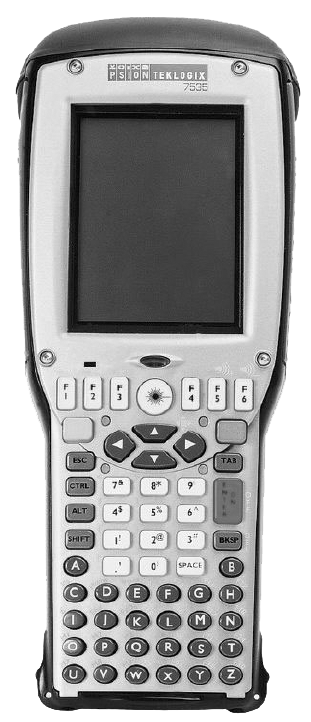
Psion Teklogix 7530 Hand-Held Computer User Manual7
Chapter 1: Introduction
The 7530 Hand-Held Computer
1.3.2 The 7530 Hand-Held Computer
Figure 1.1 7530 With 58-Key Keyboard
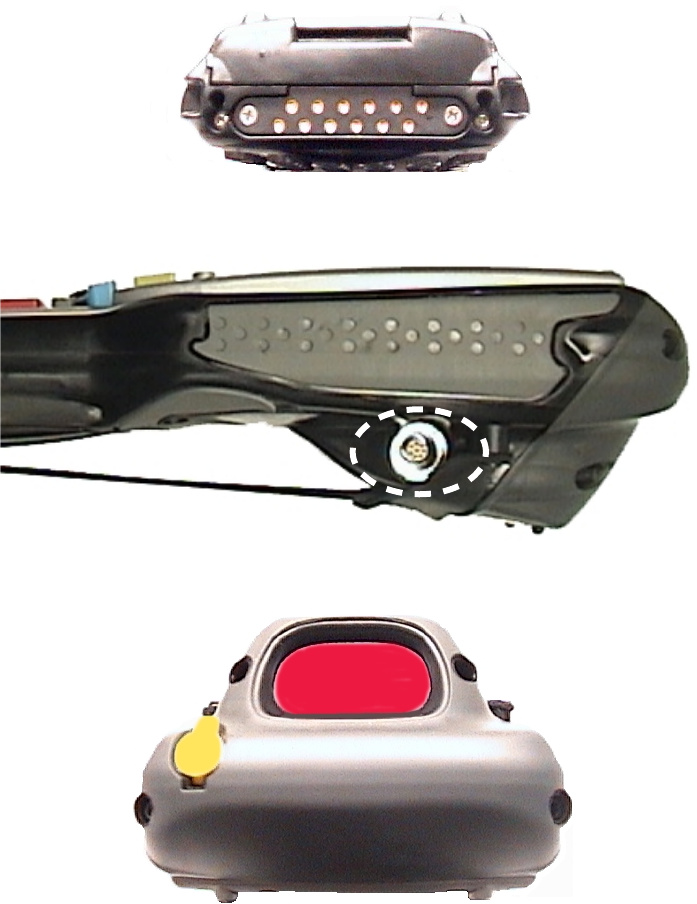
Chapter 1: Introduction
The 7530 Hand-Held Computer
8Psion Teklogix 7530 Hand-Held Computer User Manual
Figure 1.2 7530 Docking Port
Figure 1.3 Tether Port
Figure 1.4 Scanner Window
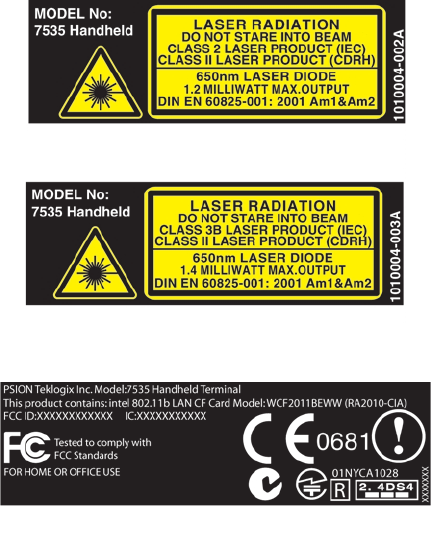
Psion Teklogix 7535 Hand-Held Computer User Manual 9
Chapter 1: Introduction
Regulatory Labels
1.3.3 Regulatory Labels
Figure 1.5 Laser Warning Labels
Figure 1.6 Radio Labels
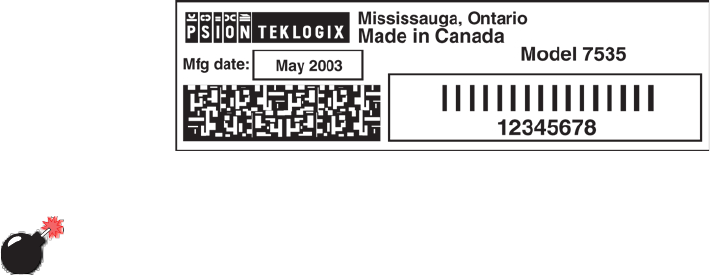
Chapter 1: Introduction
Regulatory Labels
10Psion Teklogix 7530 Hand-Held Computer User Manual
Figure 1.7 Manufacturer’s Label
Warning: Using controls or adjustments or performing procedures other than
those specified herein may result in hazardous radiation exposure.

Psion Teklogix 7530 Hand-Held Computer User Manual11
BASIC CHECKOUT 2
2
2.1 Preparing The 7530 For Operation .....................13
2.1.1 Equipment You Need To Get Started .................13
2.1.2 Charging The Battery .........................13
2.1.3 Attaching Carrying Accessories ...................13
2.1.3.1 Attaching The Hand Strap ..................14
2.1.3.2 Attaching The Pistol Grip ..................15
2.2 Powering Up The 7530 And Configuring The Radio ............16
2.2.1 Installing The Battery And Switching The 7530 On .........17
2.2.2 Configuring An IEEE 802.11 Radio Installed In The 7530 .....18
2.2.3 Assigning An IP Address .......................24
2.2.4 Name Servers Tab...........................25
2.2.5 Advanced Features ..........................26
2.2.5.1 Rearranging Preferred Networks ..............26
2.2.5.2 Deleting A Preferred Network ................27
2.2.5.3 Changing Network Properties ................27
2.3 Checking The Scanner ...........................27
2.4 Using Microsoft® ActiveSync® To Work With Files............27
2.5 Calibrating The Touchscreen ........................28
2.6 Resetting The 7530 Hand-Held .......................28

Psion Teklogix 7530 Hand-Held Computer User Manual13
Chapter 2: Basic Checkout
Preparing The 7530 For Operation
2.1 Preparing The 7530 For Operation
Typically, 7530 hand-helds are configured at the factory and arrive ready for use.
Although the 7530 is equipped with an internal Compact Flash and SD I/O slot,
these slots are not intended for user modification. If a device needs to be changed or
added in these slots, contact qualified Psion Teklogix personnel. Refer to
Appendix A: Support Services And Worldwide Offices for the service number
closest to you.
2.1.1 Equipment You Need To Get Started
You’ll need:
• A 7530 compatible battery charger, docking station or portable docking
module (PDM) with power supply.
• An operating wireless network (if you are not operating the equipment in
batch mode).
• A medium Phillips head screwdriver.
2.1.2 Charging The Battery
Important: The 7530 uses a high capacity Lithium-Ion battery. It is critical
that you review the battery safety guidelines in “Lithium-Ion
Battery Safety Precautions” on page 252 before charging the
battery.
Batteries shipped from the factory are not charged. They must be fully charged prior
to use. Full capacity may not be reached until at least 5 full charge/discharge cycles
have been performed.
7530 batteries can be charged using a gang charger or the 7535 internal charger.
When using the internal charger, a suitable power source is required. All chargers
and docking stations are described in Chapter 7: Peripheral Devices & Accessories
beginning on page 254.
2.1.3 Attaching Carrying Accessories
Psion Teklogix recommends that a carrying accessory – a hand strap, pistol grip or
shoulder strap – be installed on the 7530 before use.
If your hand-held is not fitted with a hand strap or pistol grip, you can install either
using the carrying accessory kit supplied. You’ll need:
• A Phillips head screwdriver.
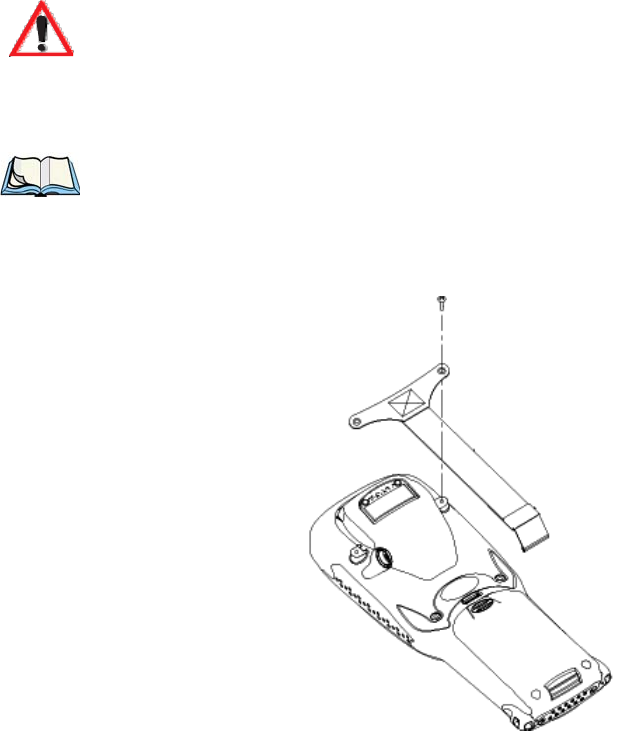
Chapter 2: Basic Checkout
Attaching The Hand Strap
14Psion Teklogix 7530 Hand-Held Computer User Manual
Important: Do not use adhesives such as Loctite to secure the screws on the
carrying accessories. These chemicals may damage the plastic
casing.
2.1.3.1 Attaching The Hand Strap
Note: A Phillips head screwdriver is required.
Two Phillips head screws are provided with the hand strap.
• Attach the strap to the two threaded inserts located at the back of the 7535
near the top of the unit.
Figure 2.1 Attaching The Hand Strap
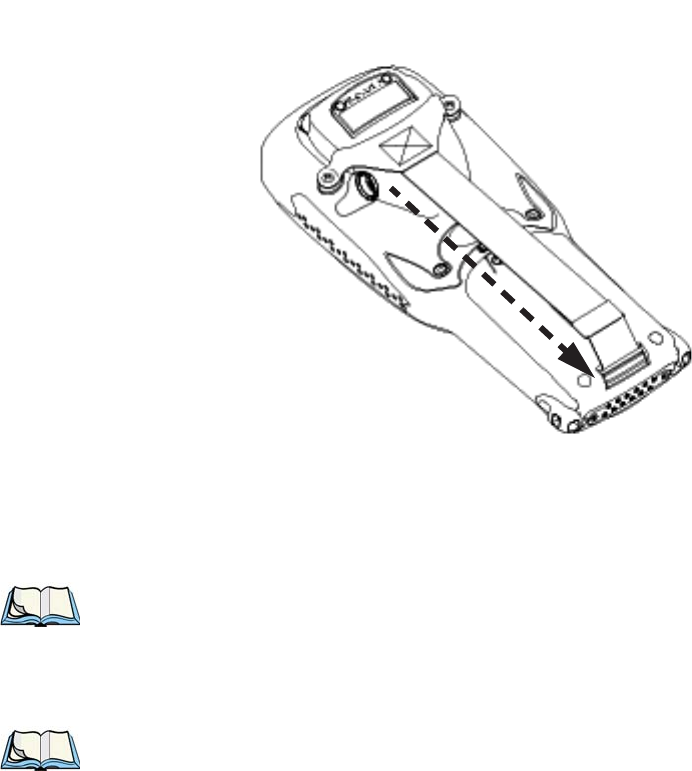
Psion Teklogix 7530 Hand-Held Computer User Manual15
Chapter 2: Basic Checkout
Attaching The Pistol Grip
• Stretch the handstrap toward the base of the 7535, and hook the bottom of
the handstrap into the slot near the base of the battery pack.
Figure 2.2 Hooking The Hand Strap To The 7530
2.1.3.2 Attaching The Pistol Grip
Note: A Phillips head screwdriver is required.
The pistol grip is attached to the back of the 7530 using the four threaded inserts in
the upper part of the 7530 casing. Four black #4-40 Phillips head screws are
provided with this accessory.
Note: Prior to installation, make sure the trigger mechanism is securely
snapped into the pistol grip body and that the trigger operates properly.
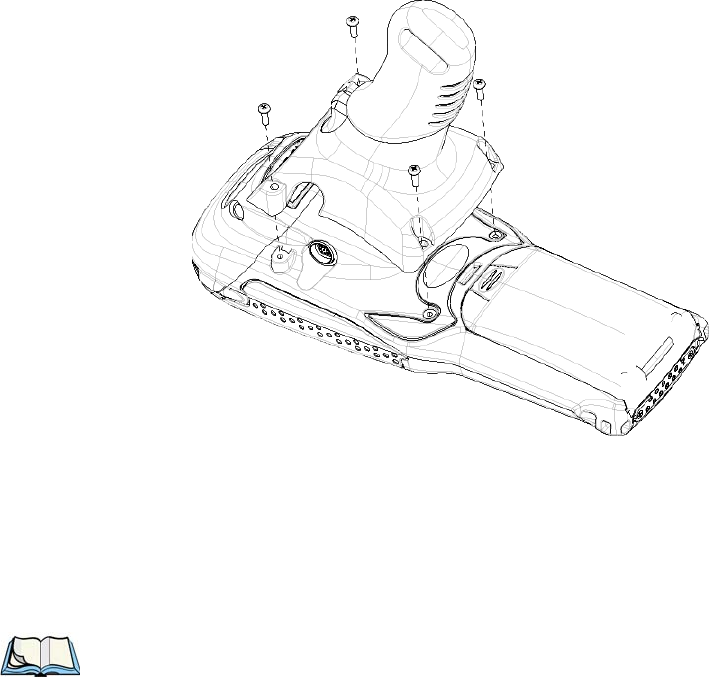
Chapter 2: Basic Checkout
Powering Up The 7530 And Configuring The Radio
16Psion Teklogix 7530 Hand-Held Computer User Manual
• Position the pistol grip so that it fits snugly over the back of the unit and
the inserts on the back of the 7530 align with the holes in the pistol grip.
Figure 2.3 Attaching The Pistol Grip
• Using a Phillips screwdriver, securely fasten the pistol grip to the back of
the 7530.
2.2 Powering Up The 7530 And Configuring The Radio
Note: Psion Teklogix offers a Portable Docking Module (PDM) along with its
power supply to help speed the checkout and confirmation process for
your 7530. The PDM can power your hand-held with or without a battery
installed in the 7530. Refer to Chapter 7: Peripheral Devices & Accesso-
ries beginning on page 249 for more information about this accessory.
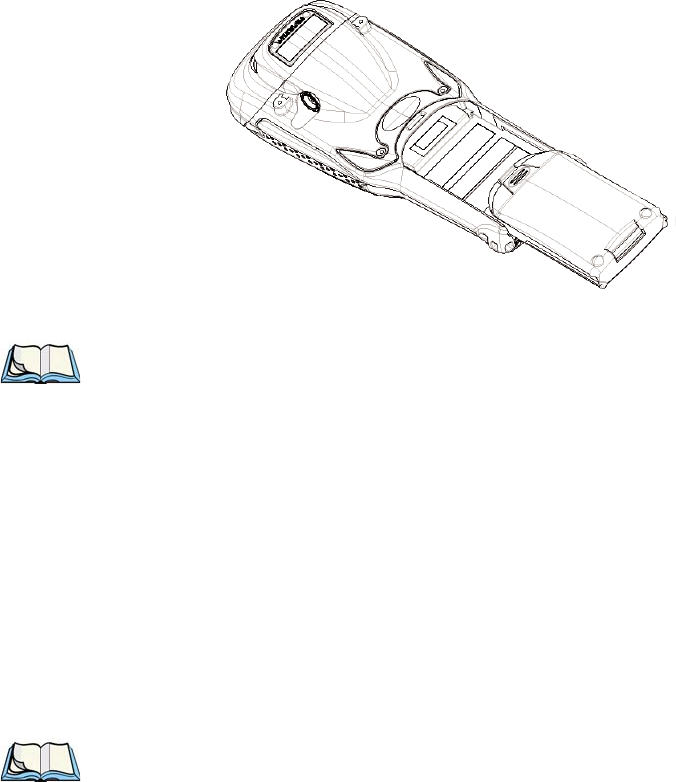
Psion Teklogix 7530 Hand-Held Computer User Manual17
Chapter 2: Basic Checkout
Installing The Battery And Switching The 7530 On
2.2.1 Installing The Battery And Switching The 7530 On
If you are not using a docking station or PDM:
• Slide the charged battery with the contoured plastic facing you into the
7530. Click the battery into place.
Figure 2.4 Installing The Battery
Note: If you are using a docking station, you can insert an uncharged battery,
dock the unit and switch it on.
If you are using a PDM, you can configure your unit without a battery, with
a charged battery or with an uncharged battery.
If you are using a hand strap:
• Hook the bottom of the hand strap into the slot at the base of the battery.
To switch the 7530 on:
• Press and hold down the <ENTER/ON> key for at least one second.
• When all four LEDs flash orange, release the <ENTER/ON> button.
A splash screen displaying the Psion Teklogix logo and the Microsoft®
Windows® CE. net logo appears. When Windows® CE has successfully loaded, the
startup desktop is displayed.
Note: The screen may go blank for a few seconds after the splash screen loading
bar reaches the end. This is part of the normal Windows CE cold boot
process. The desktop is displayed after a few moments.
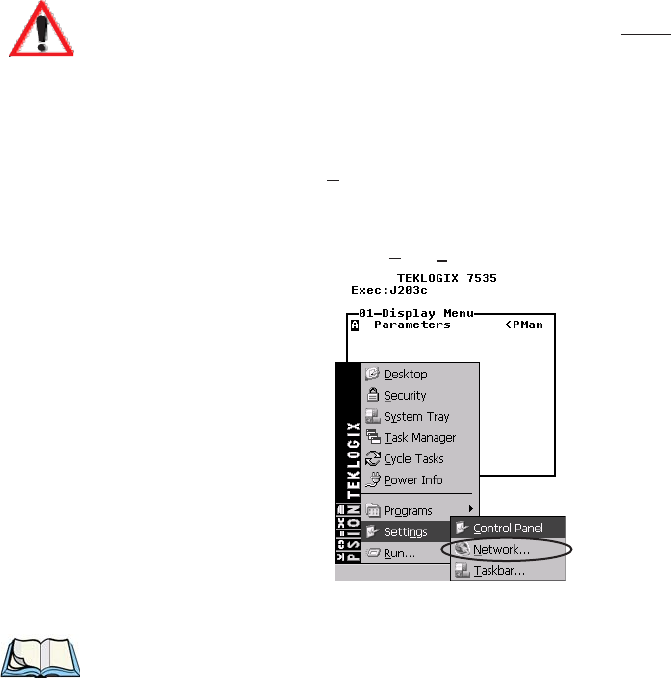
Chapter 2: Basic Checkout
Configuring An IEEE 802.11 Radio Installed In The 7530
18Psion Teklogix 7530 Hand-Held Computer User Manual
2.2.2 Configuring An IEEE 802.11 Radio Installed In The 7530
The most common 802.11b settings are configured as defaults. However, there are
some fields that must be completed, including the SSID of your access point and the
security methods implemented in the network (including access keys).
Important: If the 7535 is equipped with a radio that has never been config-
ured, the radio settings dialogue box opens automatically when
the unit is powered on. In this case, skip to Step 4 on page 20.
To configure the 802.11b radio:
1. Press <BLUE> 0 to display the Start Menu. Use the <DOWN> arrow key
to highlight Settings. Press the <RIGHT> arrow key to display the
sub-menu. Highlight Network... and press <ENTER>.
If you have a touchscreen, tap on the Windows® Start Menu button in the
taskbar, and tap on Settings>Network and Dial-up Connections.
Figure 2.5 Network And Dial-Up Connections
Note: You can also press <CTRL> <ESC> to display the Start Menu.

Psion Teklogix 7530 Hand-Held Computer User Manual19
Chapter 2: Basic Checkout
Configuring An IEEE 802.11 Radio Installed In The 7530
2. Choose the radio icon to open the 802.11b Wireless LAN Settings window – in
the sample screen this is labelled $NETWLAN1.
Figure 2.6 802.11b Wireless LAN Settings Window
3. Wireless Statistics Tab
When you choose the Wireless LAN icon, an 802.11b Wireless LAN Settings
window ($NETWLAN1 in the sample below) is displayed.
Figure 2.7 Wireless Statistics
This tab lists your radio statistics. Choosing the Zero button resets the statis-
tics of the last four items – Packets IN, Packets OUT, IN errors and OUT errors.
• Press the <TAB> key followed by the <RIGHT> arrow key to display
the next tab in this window – Wireless Information.
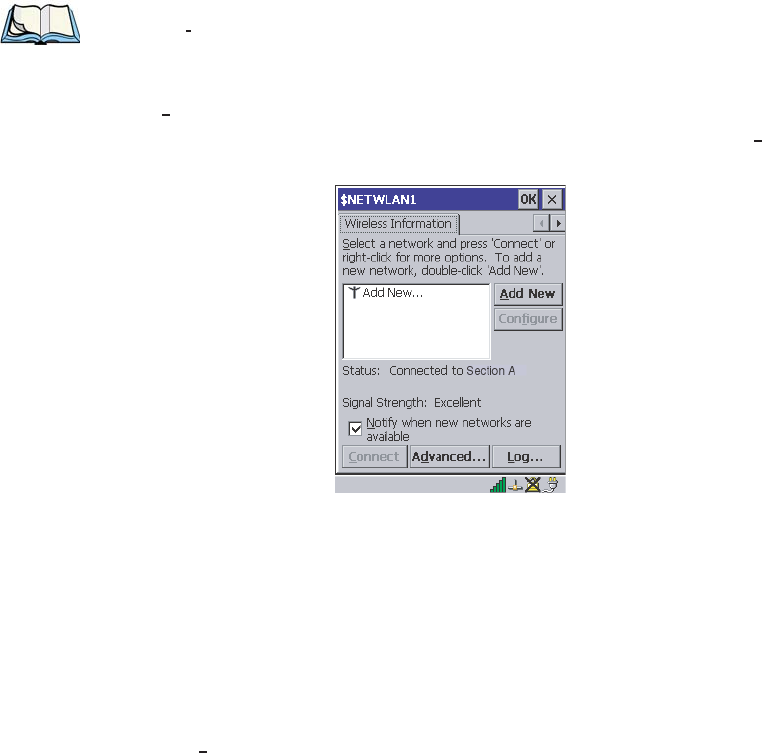
Chapter 2: Basic Checkout
Configuring An IEEE 802.11 Radio Installed In The 7530
20Psion Teklogix 7530 Hand-Held Computer User Manual
4. Wireless Information Tab
The options under this tab display existing networks to which you can
connect, and it allows you to add a new network or modify the settings
for an existing network.
Note: Configure button – To change the settings in an existing network, highlight
the network you want to modify, and choose the Configure button to display
the Wireless Properties dialogue box.
Connect button – To force connection to a specific, existing network, highlight
the network to which you want your 7530 to connect, and choose the Connect
button.
Figure 2.8 Wireless Information Tab
This tab lists available networks – any access points that are broadcasting
an SSID, and it lists preferred networks – networks that you have config-
ured. Since access points are generally secure, they will most likely not
be listed here. By default, 7535 attempts to connect to preferred networks.
This behaviour can be changed by enabling (√) ‘Automatically connect to non-pre-
ferred networks’ in the Advanced dialogue box (page 26).
•To add a new configuration, press the <TAB> key to highlight the
Add New button, and press <ENTER>. A blank Wireless Properties dialogue
box is displayed.
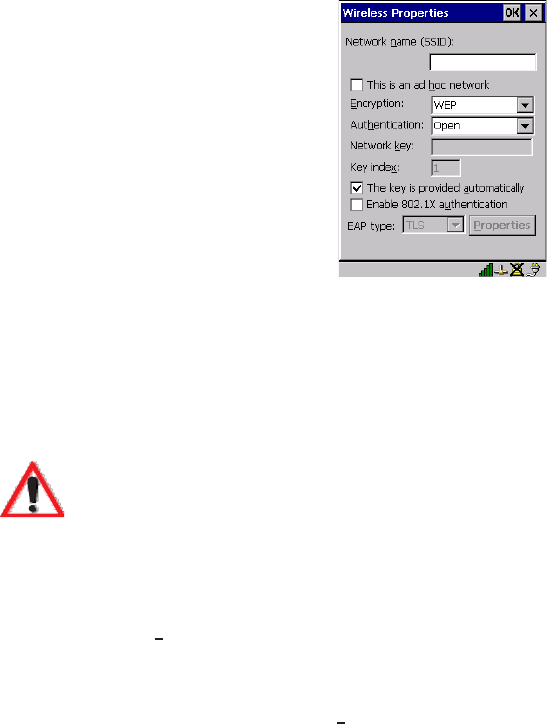
Psion Teklogix 7530 Hand-Held Computer User Manual21
Chapter 2: Basic Checkout
Configuring An IEEE 802.11 Radio Installed In The 7530
5. Wireless Properties
Figure 2.9 Wireless Properties Dialogue Box
Network name (SSID):
• Type the appropriate SSID (Service Set Identifier) in the ‘Network name
(SSID):’ text entry field at the top of this dialogue box.
The Network name field can contain a maximum of 32 characters. The name
assigned here is listed as a preferred network.
Important: Keep in mind that the 7530 will only communicate with access
points that are configured with the same SSID.
Ad Hoc And Infrastructure
If you are using an “Infrastructure” network – one in which 7530s must
pass data through an access point – leave the checkbox next to ‘This is an ad
hoc network’ blank.
If you are using an “Ad Hoc” network – a network in which 7530s pass data
directly to other 7530s without an access point – press the <TAB> key to
highlight ‘This is an ad hoc network’, and press the <SPACE> key to enable (√)
Ad Hoc.
Encryption
WEP (Wired-Equivalent Privacy) encryption prevents others from acciden-
tally accessing your network. If you are not using encryption, you can
choose ‘Disabled’ from the dropdown encryption menu. Otherwise, leave
this field as is.
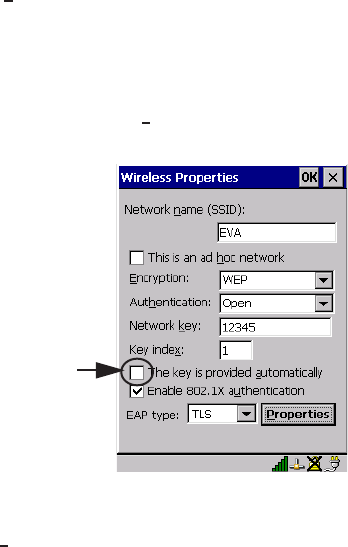
Chapter 2: Basic Checkout
Configuring An IEEE 802.11 Radio Installed In The 7530
22Psion Teklogix 7530 Hand-Held Computer User Manual
Authentication
802.11 supports two subtypes of network authentication services: Open
and Shared. Under Open authentication, any wireless station can request
authentication. The station that needs to authenticate with another wireless
station sends an authentication management frame that contains the identity
of the sending station. The receiving station then sends back a frame that
indicates whether it recognizes the identity of the sending station.
Under Shared authentication, each wireless station is assumed to have
received a secret shared key over a secure channel that is independent from
the 802.11 wireless network communications channel.
Network Key:
This text box is used to specify a 5 or 13 ASCII character sequence or an
equivalent 10 or 26 Hexadecimal digit sequence that matches the active
WEP key on the access point.
• To assign a Network key, press <TAB> to highlight ‘The key is provided auto-
matically’, and press the <SPACE> key to disable this option.
Figure 2.10 Accessing Network Key And Key Index
Key Index:
This field is used to identify the WEP key.
• Enter a value from 1 to 4.
Disable this option to
access
Network Key
&
Key Index
fields.

Psion Teklogix 7530 Hand-Held Computer User Manual23
Chapter 2: Basic Checkout
Configuring An IEEE 802.11 Radio Installed In The 7530
Enable 802.1x authentication
“802.1X” is the IEEE standard that offers additional security for local area
networks. It provides authentication for user devices attached to an Ethernet
network, whether wired or wireless. A security protocol packet such as TLS
or MD5 encapsulated in an “EAP” is used in conjunction with the “802.1x”
standard to authenticate users at the MAC layer. Available EAPs are listed
in the dropdown menu next to the ‘EAP’ option.
• To activate “802.1X”, press <TAB> to highlight ‘Enable 802.1x authentica-
tion’, and press the <SPACE> key to enable (√) it.
EAP Type (Extensible Authentication Protocol):
This dropdown menu lists the EAP types available on your system. The
items in this dropdown menu will vary depending on your network setup.
Keep in mind also that some authentication protocols require that you select
a ‘Certificate’. By selecting the Properties button, you will be able to select a
Certificate. “Certificate Assignment” on page 105 provides a website that
outlines how to create certificates for your network.
6. Saving and exiting the radio setup.
Once you have completed your configuration, press <ENTER> or tap
on OK.
The connection you created will be listed in the Wireless Information tab as a preferred
network. The radio will search for the SSID and will compare the WEP and
authentication information you specified. If there is a match between your 7530
settings and the access point settings, the 7530 will communicate on the network
through the access point.
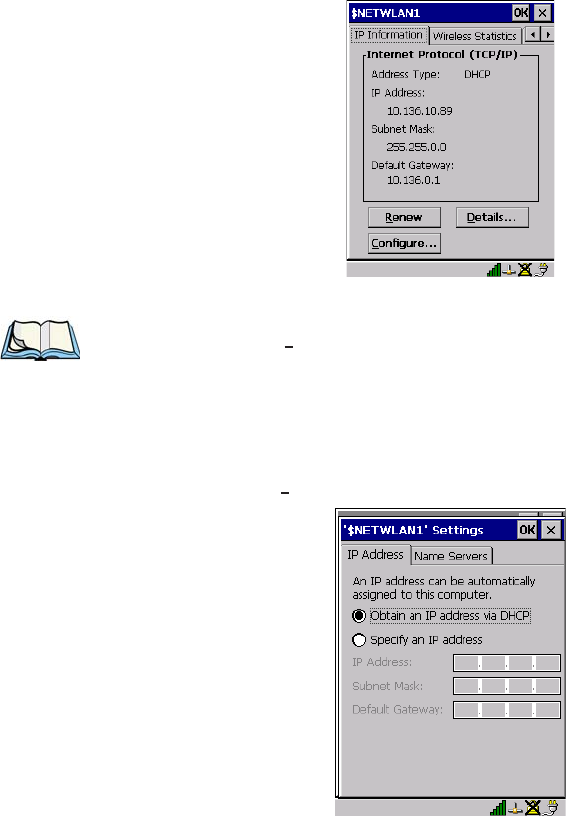
Chapter 2: Basic Checkout
Assigning An IP Address
24Psion Teklogix 7530 Hand-Held Computer User Manual
2.2.3 Assigning An IP Address
If your network is not using a DHCP server, you will need to assign an IP address.
• In the $NETWLAN1 Settings window, press the <TAB> key followed by the
<LEFT> arrow key to display the IP Information tab.
Figure 2.11 IP Information
Note: Choosing the Renew button forces the 7530 to renew or find a new IP
address. This is useful if, for example, you are out of communication
range for a longer period of time and your 7530 is dropped from the net-
work.
To define a static IP address:
• Highlight the Configure... button, and press <ENTER>.
Figure 2.12 Defining An IP Address
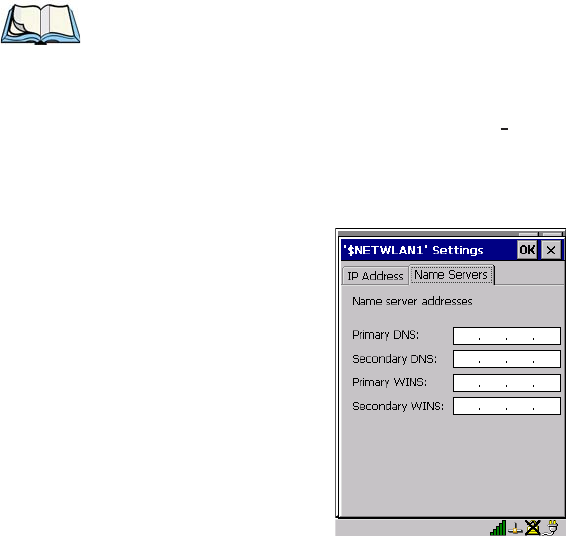
Psion Teklogix 7530 Hand-Held Computer User Manual25
Chapter 2: Basic Checkout
Name Servers Tab
• Press the <DOWN> arrow key to highlight Specify an IP address.
• Press the <TAB> key to move from field to field, and type an IP, Subnet Mask
and Default Gateway address. Press <ENTER> to save your information.
2.2.4 Name Servers Tab
Note: If DHCP is enabled, name server addresses are assigned automatically.
• In the $NETWLAN1 Settings window, press the <TAB> key followed by the
<LEFT> arrow key to display the IP Information tab.
• In the IP Information tab, highlight the Configure... button, and press
<ENTER>.
• Press the <TAB> key followed by the <RIGHT> arrow key to display the
Name Servers tab.
Figure 2.13 Name Servers Tab
The DNS and WINS fields in the Name Servers tab allow you to specify additional
WINS and DNS resolvers. The format for these fields is ###.###.###.###.
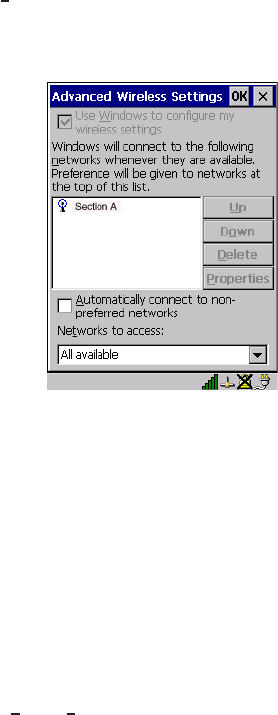
Chapter 2: Basic Checkout
Advanced Features
26Psion Teklogix 7530 Hand-Held Computer User Manual
2.2.5 Advanced Features
To display the Advanced Wireless Settings dialogue box:
• Highlight the Advanced... button in the Wireless Information tab and press
<ENTER>.
This window lists the available preferred networks.
Figure 2.14 Advanced Settings
2.2.5.1 Rearranging Preferred Networks
The 7535 attempts to connect with the networks listed in this dialogue box in
sequence, beginning at the top of the list. If you need to rearrange this list of
networks – move networks up and down in the list:
• Press the <TAB> key to move the cursor into the networks list.
• Use the <UP> or <DOWN> arrow keys to highlight the network that you
want to move up or down in the list.
• To move the highlighted item in the list upward or downward, press <TAB>
to highlight the Up or Down button, and press <ENTER>.

Psion Teklogix 7530 Hand-Held Computer User Manual27
Chapter 2: Basic Checkout
Deleting A Preferred Network
2.2.5.2 Deleting A Preferred Network
To delete a network from this list:
• Press the <TAB> key to highlight the networks list.
• Use the <UP> or <DOWN> arrow keys to highlight the network that you
want to remove.
• Highlight the Delete button, and press <ENTER>.
2.2.5.3 Changing Network Properties
To change the properties of an existing preferred network:
• Highlight the network that you want to modify.
• Press <TAB> to highlight the Properties button, and press <ENTER>.
• Make any necessary changes in the Wireless Properties dialogue box, and press
<ENTER> to save the changes.
2.3 Checking The Scanner
If your 7535 is equipped with an internal scanner, it will successfully decode most
1D bar codes as delivered. Press the SCAN button and check for a valid decode on
any UPC bar code. If desired, set the “Dot Time” parameter to zero in the ‘Teklogix
Scanners’ applet in the Control Panel to turn off the default aiming dot.
Performance is improved if you disable all unneeded bar codes under the ‘Bar
Codes’ dialogue screen. Review “Scanner Properties Setup” on page 118 for details
about bar codes.
2.4 Using Microsoft® ActiveSync® To Work With Files
ActiveSync® – Microsoft PC connectivity software – can be used to connect the
7535 to PCs running this software. By connecting the 7535 to a PC with a cable and
running ActiveSync on the PC, you can:
• View 7535 files from Windows Explorer.
• Drag and drop files between the 7530 and the PC in the same way that you
would between PC drives.
• Back up 7530 files to the PC, then restore them from the PC to the
hand-held again, if needed, and so on.
Note: You’ll need the USB setup utility to configure the .ini file. For information
about this USB application, refer to Appendix C: USB Setup Application.

Chapter 2: Basic Checkout
Calibrating The Touchscreen
28Psion Teklogix 7530 Hand-Held Computer User Manual
To install ActiveSync, follow the step-by-step instructions provided with the
program’s setup wizard. Refer to the following website for details:
http://www.microsoft.com/windowsmobile/resources/downloads/pocketpc/activesync35.mspx
2.5 Calibrating The Touchscreen
If your 7530 is equipped with a touchscreen, it will need to be calibrated. Refer to
“Calibrating The Touchscreen” on page 41 for details.
2.6 Resetting The 7530 Hand-Held
Important: Because Psion Teklogix cannot guarantee what has been saved
(registry) after a reset, this should be considered as a last resort.
To reset the 7530:
• Press and hold down the <BLUE> key and the <ENTER/ON> key simulta-
neously for a minimum of six seconds.
A reset results in a complete reboot of the unit. All RAM memory contents are lost.
The contents of the flash memory and memory card may be preserved, but Psion
Teklogix cannot guarantee. However, you should keep in mind that When the 7530
is reset, the screen displays the Psion Teklogix and Microsoft® Windows® CE.net
splash screen before displaying the startup desktop.
Note: You do not need to reset your 7530 after configuring the radio.

Psion Teklogix 7530 Hand-Held Computer User Manual29
GETTING TO KNOW YOUR 7530 33
3.1 Features Of The 7530 ............................31
3.2 The Battery .................................32
3.2.1 Battery Safety.............................32
3.2.2 Removing And Installing The Battery Pack .............32
3.2.3 Charging The Battery .........................33
3.3 Switching The 7530 Hand-Held On And Off ................34
3.4 The Keyboard ................................35
3.4.1 Modifier Keys.............................35
3.4.1.1 Activating Modifier Keys ..................36
3.4.1.2 Locking Modifier Keys ...................36
3.4.2 The Keys ...............................36
3.4.3 The 58-Key Keyboard ........................37
3.4.4 The 36-Key Keyboard ........................38
3.4.5 The Keypad Backlight ........................40
3.5 The Display .................................40
3.5.1 Adjusting The Display Backlight ...................40
3.5.2 Adjusting The Contrast ........................41
3.5.3 Calibrating The Touchscreen .....................41
3.6 7535 Indicators ...............................42
3.6.1 LEDs .................................42
3.6.1.1 Charge LED .........................43
3.6.1.2 Radio Traffic LED ......................44
3.6.1.3 Scan LED ..........................44
3.6.1.4 User Application LED ....................44
3.6.2 Onscreen Indicators..........................45
3.6.3 Audio Indicators ...........................47
3.6.3.1 Adjusting The Beeper Volume ................48
3.7 Internal Scanners ..............................48
3.7.1 Scanning Techniques .........................49
3.7.2 Scan LED Indicators .........................49
3.7.3 Troubleshooting............................50
3.7.4 Operating One Dimensional (1D) Internal Laser Scanners......50
3.7.5 Operating Internal PDF Laser Scanners ...............51
3.7.6 Operating Internal Two Dimensional (2D) Imager Scanners.....51
Chapter3:Getting To Know Your 7530
30Psion Teklogix 7530 Hand-Held Computer User Manual
3.8 Connecting & Disconnecting Tethered Peripherals .............52
3.9 Monitoring The Battery And Maximizing Run Time ............53
3.9.1 Storing Batteries............................55
3.10 Monitoring The Network Connection ...................55
3.11 Uploading Data In A Docking Station ...................56
3.12 General Maintenance............................56
3.12.1 Caring For The Touchscreen.....................56
3.12.2 Cleaning The 7530..........................57
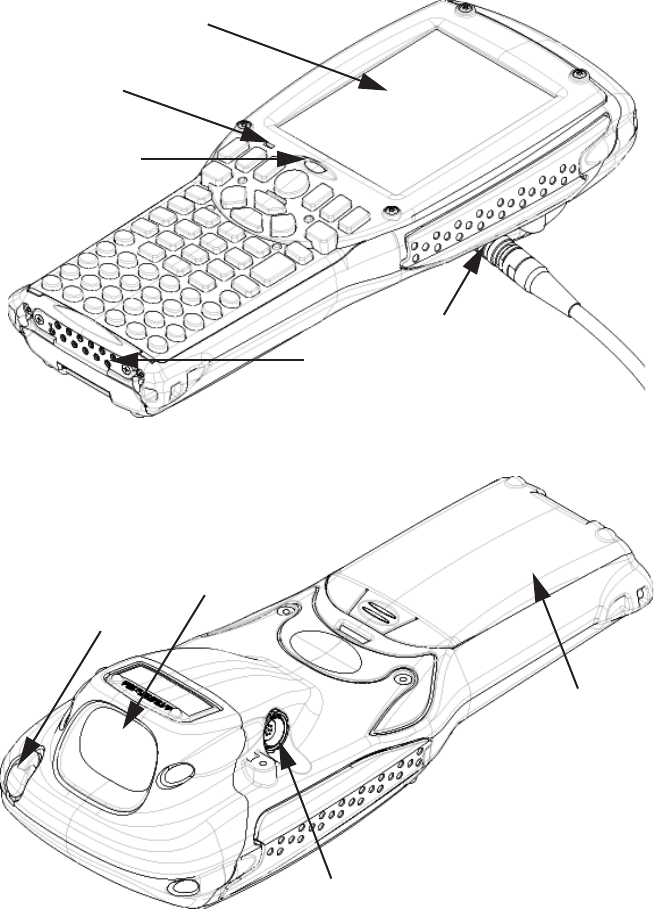
Psion Teklogix 7530 Hand-Held Computer User Manual31
Chapter3:Getting To Know Your 7530
Features Of The 7530
3.1 Features Of The 7530
Figure 3.1 Front Of 7530
Figure 3.2 Back Of 7530
Ambient Light Sensor
Tether Port
Docking Port
7530 Screen
Sound Port
Stylus
(Pointing Tool) Scanner Window
Battery Pack
Tether Port

Chapter3:Getting To Know Your 7530
The Battery
32Psion Teklogix 7530 Hand-Held Computer User Manual
3.2 The Battery
The 7530 hand-held operates with a Lithium-Ion battery pack. Preparing the
hand-held unit for operation requires that a battery pack be charged and installed in
the unit.
3.2.1 Battery Safety
Important: Before attempting to install, use or charge the battery pack, it is
critical that you review and follow the important safety guidelines
in the section entitled “Lithium-Ion Battery Safety Precautions”
beginning on page 252.
3.2.2 Removing And Installing The Battery Pack
Note: TURN OFF THE 7530 HAND-HELD BEFORE REMOVING THE
BATTERY PACK. If you do not turn the hand-held off before removing
the battery, it may be necessary to reboot the unit. Any active sessions
will be lost.
Removing The Battery Pack
• If your 7530 is equipped with a hand strap, unhook it from the base of the
battery.
• Press down the release tab at the top of the battery, and slide the battery out.
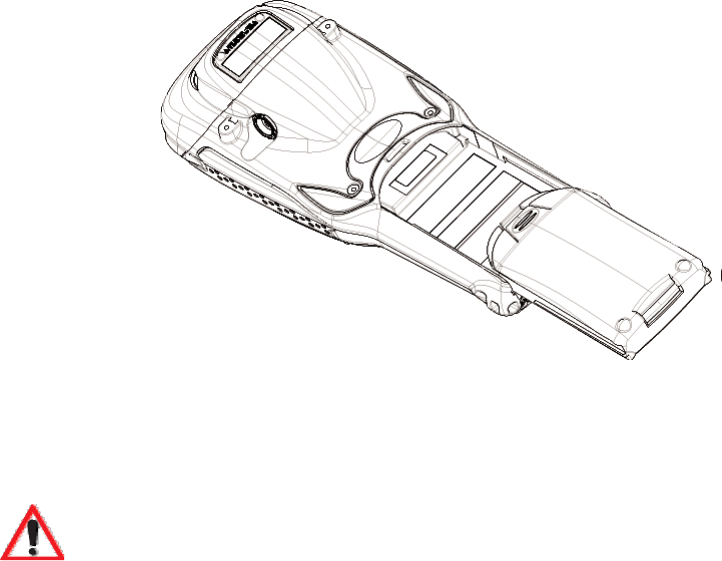
Psion Teklogix 7530 Hand-Held Computer User Manual33
Chapter3:Getting To Know Your 7530
Charging The Battery
Installing The Battery Pack
To install the battery pack:
• Slide the battery pack with the contoured plastic facing you into the 7530.
Click the battery into place.
Figure 3.3 Installing The Battery Pack
• If your computer is equipped with a hand strap, insert the hook at the end of
the hand strap into the slot at the base of the battery.
3.2.3 Charging The Battery
Important: FOR DETAILED INFORMATION about 7535 chargers and
docking stations, refer to Chapter 7: Peripheral Devices & Acces-
sories beginning on page 249. For battery safety, refer to “Lith-
ium-Ion Battery Safety Precautions” beginning on page 252.
All batteries must be charged before use. The 7530 battery can be charged with a
variety of chargers. These include:
• 6-Gang Charger (Model #HU3006) – charges up to six Lithium-Ion batter-
ies at one time.
• Portable Docking Module (Model #HU4001 or HU1005 and HU3220 or
HU3220) – charges the 7530 battery (with the battery installed in the unit).
• Combo Charger (Model #HU3002) – a desktop charger that charges the
7535 internal battery along with a spare battery pack.

Chapter3:Getting To Know Your 7530
Switching The 7530 Hand-Held On And Off
34Psion Teklogix 7530 Hand-Held Computer User Manual
• Combo Docking Station (Model #HU4002) – operates as both a charger
and a docking station. Operating as a charger, both the battery installed in
the computer and a spare battery can be charged simultaneously.
• Quad Docking Station (Model #HU4004) – can charge the battery of up to
four 7530s inserted in the docking station while transferring data through an
Ethernet connection.
• Powered Cradle (Model #HU1000, HU1010) – can charge the 7530 with
the battery installed in the hand-held.
It can take from 1.5 to 4 hours to charge a battery. The 7535’s intelligent charging
system protects the battery from over-charging by terminating the charge process
when the battery is at maximum capacity.
Note: Refer to “Monitoring The Battery And Maximizing Run Time” on page 53
for additional information about the 7530 battery.
Important: To avoid damaging the battery, chargers will not begin the charge
process until the battery temperature is between 0˚C (32˚F) and
39˚C (102˚F). If the battery is too hot or cold, the battery status
LED flashes yellow and the charge is suspended. Refer to
Table 3.1, “Charge LEDs” on page 43 for details.
3.3 Switching The 7530 Hand-Held On And Off
Switching On The 7530
• Press and hold down the <ENTER/ON> key for at least one second.
• When all four LEDs flash orange, release the <ENTER/ON> button.
A splash screen displaying the Psion Teklogix logo and the Microsoft®
Windows® CE. net logo appears followed by the startup desktop.
Note: If the 7530 is in suspend state, pressing <ENTER/ON> key ‘wakes’ the
unit from this state. The screen in which you were working before the
computer entered suspend state is displayed.

Psion Teklogix 7530 Hand-Held Computer User Manual35
Chapter3:Getting To Know Your 7530
The Keyboard
Switching Off The 7530
Important: Keep in mind that turning off the 7530 does not result in a
complete reboot; rather, the unit enters a power-saving,
“suspend” state. When the 7530 is turned on from suspend state,
operation resumes within a few seconds.
To switch off the 7530:
• Press the <BLUE> key, and then press the <ENTER/ON> key.
Important: If the word ‘BLUE’ is displayed in uppercase in the taskbar area
at the bottom of the screen, this key is locked “on” – the 7535 will
not switch off. Press the <BLUE> key again to unlock it; then
press <BLUE> <ENTER/ON> to switch the 7535 off.
If, however, you’ve disabled the “Blue Key” in the ‘One Shot’ dia-
logue box (see “Keyboard One Shot Modes” on page 94), the 7535
can be turned off even when the <BLUE> key is locked ‘on’.
3.4 The Keyboard
The 7530 offers two types of keyboard layouts – a 58-key keyboard and a 36-key,
large button keyboard. Most of the keys on these keyboards operate much like a
desktop computer. Where a key or key function is not consistent with the PC
keyboard, the differences are noted.
The <BLUE> and <ORANGE> modifier keys provide access to additional keys and
system functions. These functions are colour coded in orange and blue print above
the keyboard keys.
3.4.1 Modifier Keys
The <SHIFT>, <CTRL>, <ALT>, <BLUE> and <ORANGE> keys are modifier
keys. Pressing a modifier key changes the function of the next key pressed. For
example, on a 58-key keyboard, a square bracket is printed in orange print above the
<4> key. Pressing the <ORANGE> key followed by the <4> key displays a square
bracket rather than the number 4.

Chapter3:Getting To Know Your 7530
Activating Modifier Keys
36Psion Teklogix 7530 Hand-Held Computer User Manual
The <SHIFT>, <CTRL> and <ALT> keys operate much like a desktop keyboard
except that they are not chorded (two keys held down simultaneously). The modifier
key must be pressed first followed by the key whose function you want modified.
3.4.1.1 Activating Modifier Keys
When a modifier key is pressed once, it is displayed in lowercase letters in the
taskbar at the bottom of the 7535 screen. For example, if the <CTRL> key is
pressed, ctrl key is displayed at the bottom of the unit screen. Once the next key is
pressed, the modifier key becomes inactive and disappears from the taskbar.
3.4.1.2 Locking Modifier Keys
When a modifier key is pressed twice, it is ‘locked’ on. A ‘locked’ modifier key is
displayed in uppercase letters in the taskbar. For example, pressing the <BLUE> key
twice locks it on – it is displayed as BLUE KEY in the taskbar at the bottom of the
computer screen.
The locked modifier key will remain active until it is pressed a third time to unlock
or turn it off. Once a modifier key is unlocked (pressed a third time), the uppercase
representation at the bottom of the screen is no longer displayed.
Note: The locking function of the <ORANGE> and <BLUE> keys can be dis-
abled so that pressing either of these keys once will lock the keys ‘on’.
If you disable the ‘One Shot’ function of either of these keys, pressing the
<BLUE> and/or <ORANGE> key once will lock the key ‘on’. Pressing
the same key a second time will unlock or turn it ‘off’. Refer to “Keyboard
One Shot Modes” on page 94 for details.
3.4.2 The Keys
The <SHIFT> Key
The <SHIFT> key is used to display uppercase alpha characters and provide access
to the symbols above the numeric keys.
The Arrow Keys
The Arrow keys move the cursor around the screen in the direction of the arrow –
up, down, left and right. The cursor is the flashing box or underline character that
indicates where the next character you type will appear.
Psion Teklogix 7530 Hand-Held Computer User Manual37
Chapter3:Getting To Know Your 7530
The 58-Key Keyboard
The <BKSP/DEL> Key
The <BKSP> key (sometimes referred to as destructive backspace) moves the
cursor one character to the left, erasing the incorrectly entered key stroke.
The <DEL> key (<BLUE> <BKSP>) erases the character at the cursor position.
The <CTRL> And <ALT> Key
The <CTRL> and <ALT> keys modify the function of the next key pressed and are
application dependent.
The <TAB> Key
Typically, the <TAB> key moves the cursor to the next field to the right or
downward.
The <ESC> Key
Generally, this key is used as a keyboard shortcut to close the current menu,
dialogue box or activity and return to the previous one.
The <SPACE> Key
Pressing this key inserts a blank space between characters. In a Windows dialogue
box, pressing the <SPACE> key enables (√) or disables a checkbox.
The <SCAN> Key
Pressing the <SCAN> key – the yellow key with the star-burst scan symbol on it –
activates the scanner beam while pressed. For units that do not have internal
scanners, this key is inoperable.
3.4.3 The 58-Key Keyboard
In addition to alphanumeric keys that are directly accessible on the keyboard (no key
combination is required) and the keys described in this chapter, the 58-key keyboard
also provides function keys and macro keys.
Function keys <F1> through <F24> can be used with the CE operating system or
another application. The additional function keys – <F25> through <F30> along
with the macros are not used as part of the Windows CE operating system.
All function keys and macro keys can be custom defined for each application. The
Tekterm application utilizes these keys. Refer to “Additional Keyboard Functions”
on page 147 for details about Tekterm keys.

Chapter3:Getting To Know Your 7530
The 36-Key Keyboard
38Psion Teklogix 7530 Hand-Held Computer User Manual
3.4.4 The 36-Key Keyboard
On 36-key 7530s, all alpha characters are printed on the unit plastic in orange
typeface above the numeric keys. To access an alpha character, you must first press
the <ORANGE> key and then press the numeric key above which the alpha
character you want to type is printed.
Because the alpha keys on a 36-key keyboard are laid out much like the letters on a
telephone – generally in groups of three letters per numeric key – you need to take a
few extra steps to access the alphabetic characters. The examples in this section help
illustrate how to access alpha characters.
Choosing A Single Alpha Character
Note: Keep in mind that the following examples assume that ‘One Shot’ is
enabled for the <ORANGE> key. Refer to “Keyboard One Shot Modes”
on page 94 for details.
The examples below illustrate how to access A, B and C, all of which are printed in
orange characters above the numeric key, <2>.
To choose the letter ‘a’:
• Press the <ORANGE> key, and press the numeric key <2>.
To choose the letter ‘b’:
• Press the <ORANGE> key twice to lock it ‘on’, and press <2> twice.
• Press the <ORANGE> key again to unlock or turn it off.
To choose the letter ‘c’:
• Press the <ORANGE> key twice to lock it ‘on’.
• Press <2> three times, and then
• Press the <ORANGE> key again to unlock or turn it off.
Creating Uppercase Letters
To display a capital letter:
• Press the <ORANGE> key and then the <SHIFT> key before typing the
alpha character.
Psion Teklogix 7530 Hand-Held Computer User Manual39
Chapter3:Getting To Know Your 7530
The 36-Key Keyboard
Choosing More Than One Alpha Character From The Same Key
If you need to choose more than one alpha character from a single key, you’ll need
to press the ‘Accept’ key between alpha selections. The ‘Accept’ key is presented as
an arrow ⇒ symbol above the ‘0’ (zero) key. Pressing this key signals the 7535 to
display the alpha character you’ve chosen and await the next selection from the
same key.
For example, suppose you want to type the letters ‘a’, ‘b’ and ‘c’. These letters are
all accessible from the numeric key, <2>.
To type the letter ‘a’:
• Press the <ORANGE> key twice to lock it ‘on’, and then press the numeric
key, <2>.
• Press the ‘Accept’ key < ⇒> to indicate that the letter ‘a’ should be
accepted and that another letter from the same key will be chosen.
To type the letter ‘b’:
• Press the <2> key twice.
• Press < ⇒> to accept the letter ‘b’.
To type the letter ‘c’:
• Press the <2> key three times.
When you have completed your alpha selections from this key, you can do one of the
following:
• If you want to choose additional alpha characters from another key(s),
leave the <ORANGE> key ‘on’, and press the next numeric key that
supports the alpha character you require.
• If you do not want to choose any additional alpha characters, press
<ORANGE> again to unlock or turn ‘off’ the key and end alpha selection.
Choosing Multiple Alpha Characters From A Range Of Keys
If you plan on choosing alpha characters from a number of different keys, you are
not required to press the ‘Accept’ < ⇒> key after each alpha selection. The < ⇒>
key is only required when you are choosing more than one alpha character from the
same key – e.g., ‘a’, ‘b’ and ‘c’ from the <2> key.

Chapter3:Getting To Know Your 7530
The Keypad Backlight
40Psion Teklogix 7530 Hand-Held Computer User Manual
Suppose you want to type the letters ‘a’, ‘d’ and ‘g’. These alpha characters are
accessed from the numeric keys <2>, <3> and <4>.
• With the <ORANGE> key locked ‘on’ (press twice), press <2> to type the
letter ‘a’.
• Press <3> to type ‘d’, and press <4> to type the letter ‘g’.
• To end alpha selection, press the <ORANGE> key a third time to unlock it.
3.4.5 The Keypad Backlight
The intensity of the keypad backlight and the conditions under which this backlight
is activated can be configured using the Keyboard icon in the Windows CE Control Panel.
The behaviour of the keypad backlight is tailored in the Keyboard Properties dialogue box.
Refer to “Keyboard Backlight” on page 93 for details about this option.
Note: Keep in mind that this option may be restricted to supervisory use only.
3.5 The Display
7535s are equipped with display backlighting to improve character visibility in low
light conditions. The backlight switches on when a key is pressed and the ambient
light is below the set threshold. A light sensor on the front of the hand-held
determines the ambient light level. On some displays, the contrast can also be
adjusted to further improve character visibility.
3.5.1 Adjusting The Display Backlight
The behaviour of the display backlight – the ambient light threshold below which
the backlight will become active and the intensity of the backlight – can be specified
in the Display Properties dialogue box in the Windows CE Control Panel.
Note: Refer to “Display Backlight” on page 89 for details about the Display
Properties dialogue box.
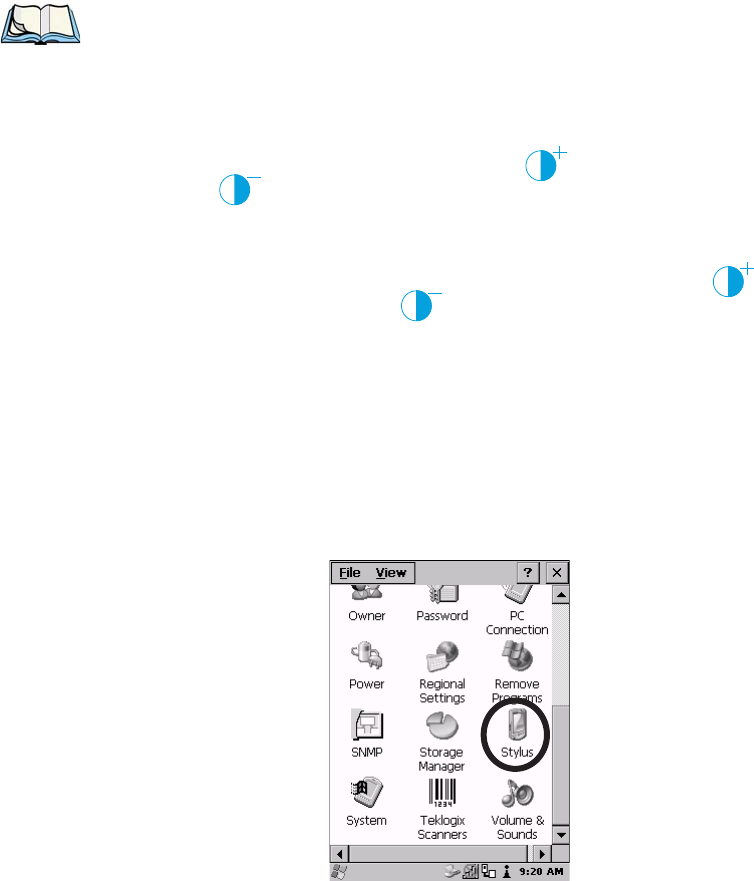
Psion Teklogix 7530 Hand-Held Computer User Manual41
Chapter3:Getting To Know Your 7530
Adjusting The Contrast
3.5.2 Adjusting The Contrast
Note: In addition to the manual adjustments described in this section, the dis-
play contrast can also be adjusted using the Windows CE Control Panel.
Refer to “Display Contrast” on page 88 for details about this dialogue
box.
The display contrast can be adjusted from the unit keyboard using the <BLUE> key
and function keys <F1> and <F2>. Pressing <F1> darkens the display, and
pressing <F2> lightens the display. Keep in mind that adjusting the contrast on
a colour display is much less pronounced than on a monochrome display.
To adjust the display contrast:
• Press the <BLUE> key twice to lock it on, and then press <F1> . to
darken the display or <F2> . to lighten the display.
• Once you’ve successfully adjusted the display contrast, remember to press
the <BLUE> key again to turn it ‘off’.
3.5.3 Calibrating The Touchscreen
If your 7535 touchscreen has never been calibrated or if you find that the stylus
pointer is not accurate when you tap on an item, use the Stylus Properties dialogue box in
the Windows CE Control Panel to recalibrate the screen.
• In the Control Panel, choose the Stylus icon to display the Stylus Properties window.
Figure 3.4 Stylus Icon
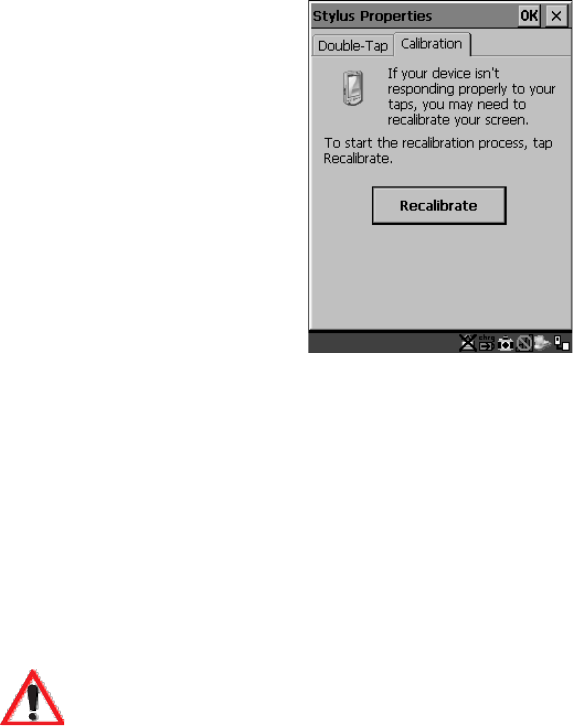
Chapter3:Getting To Know Your 7530
7535 Indicators
42Psion Teklogix 7530 Hand-Held Computer User Manual
• Select the Calibration tab, and then choose the ‘Recalibrate’ button.
Figure 3.5 Calibration Screen
• Follow the directions on the calibration screen to calibrate the screen.
3.6 7530 Indicators
7535s use LEDs (Light Emitting Diode), onscreen messages and audio tones as
indicators.
3.6.1 LEDs
The 7535 is equipped with four tri-coloured LEDs. This section outlines what these
LEDs indicate.
Important: If an LED is illuminated in red, the operator should be cautious
as this generally indicates an abnormal operating condition or
active laser emission.
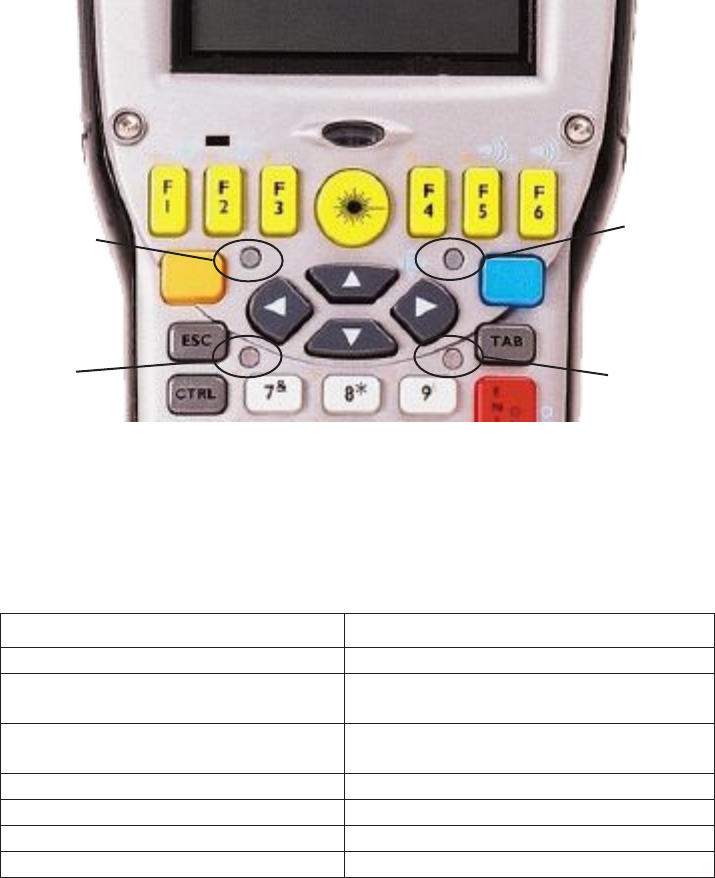
Psion Teklogix 7530 Hand-Held Computer User Manual43
Chapter3:Getting To Know Your 7530
Charge LED
Figure 3.6 Keyboard LEDs
3.6.1.1 Charge LED
The lower-right LED is reserved for internal charger/power status. This indicator is
active even when the 7535 is inserted in a docking station (and in suspend mode) so
that the charge status of the battery can be detected easily.
*If the charge fails, refer to the charger troubleshooting sections in Chapter 7: Peripheral Devices &
Accessories beginning on page 254 for helpful details.
Table 3.1 Charge LEDs
Function Charge LED Behaviour
External power not available. LED off.
Fully charged to within 95% of charge
capacity. LED displays solid green colour.
Quick charge successfully completed to
within 75% of charge capacity. LED flashes slow green.
Charge in progress. LED displays solid yellow colour.
Cell temperature out of range for charge. LED flashes yellow.
Unable to charge battery. LED displays solid red colour.
Charge circuit failure.* LED flashes fast red.*
Radio Traffic
Scanner
LED
LED Charge
LED
User
Application
LED
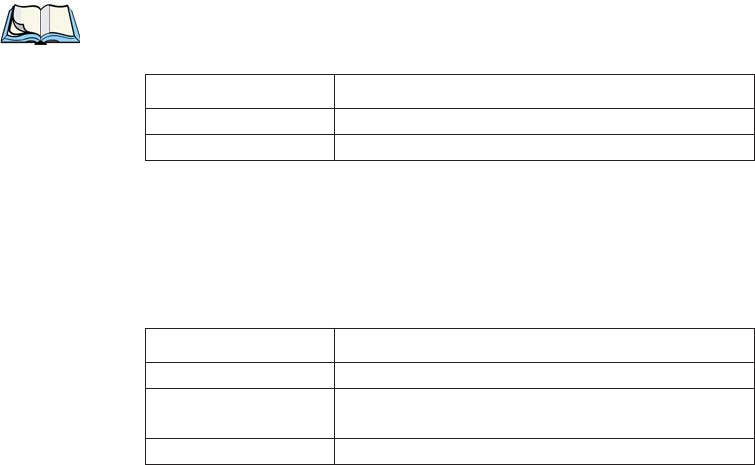
Chapter 3: Getting To Know Your 7535
Radio Traffic LED
44 Psion Teklogix 7535 Hand-Held Computer User Manual
3.6.1.2 Radio Traffic LED
The upper-left LED on your 7535 flashes either orange or green to indicate when the
radio transmits and receives data.
Note: Keep in mind that while the standard 802.11b radio supports the trans-
mit/receive LED, not all radios support this function.
Table 3.2 Transmit and Receive LEDs
3.6.1.3 Scan LED
Successful scans are indicated in two ways – with a scan LED and with an
audio tone.
Table 3.3 Scan LED
3.6.1.4 User Application LED
This indicator is available for user-loaded custom Windows CE applications. Refer
to the 7535 SDK Manual for details about this LED. Neither Windows CE nor
Tekterm use this LED.
Function Radio Traffic LED Behaviour
Radio Transmit LED flashes orange.
Radio Receive LED flashes green.
Function Scan LED Behaviour
Scan in progress LED displays solid red during scan.
Successful scan LED displays solid green after decode.
Off when scan ended.
Unsuccessful scan LED flashes red.
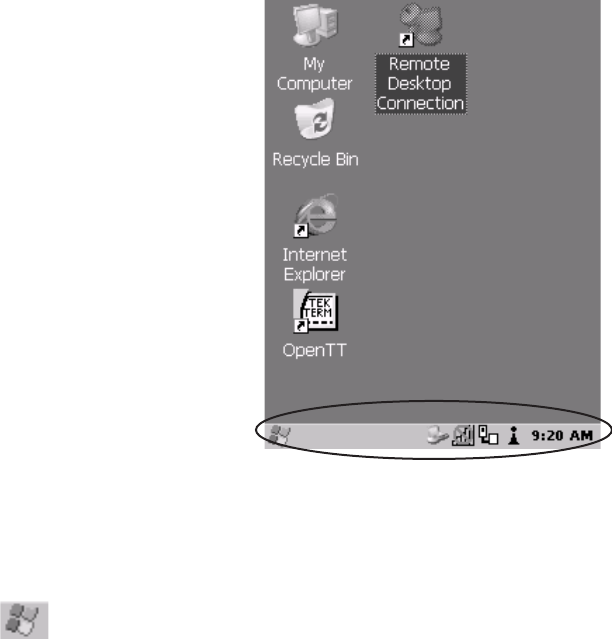
Psion Teklogix 7530 Hand-Held Computer User Manual45
Chapter 3: Getting To Know Your 7535
Onscreen Indicators
3.6.2 Onscreen Indicators
The taskbar at the bottom of the screen displays a variety of system status indicators.
Figure 3.7 Taskbar
This display changes dynamically, and only those icons that are applicable are
displayed. For example, if a radio is not installed in your 7535, the radio signal icon
is not displayed in the taskbar.
Windows® Start Button
If you have a touchscreen, you can display the Start Menu by tapping on the Windows®
Start button in the taskbar.
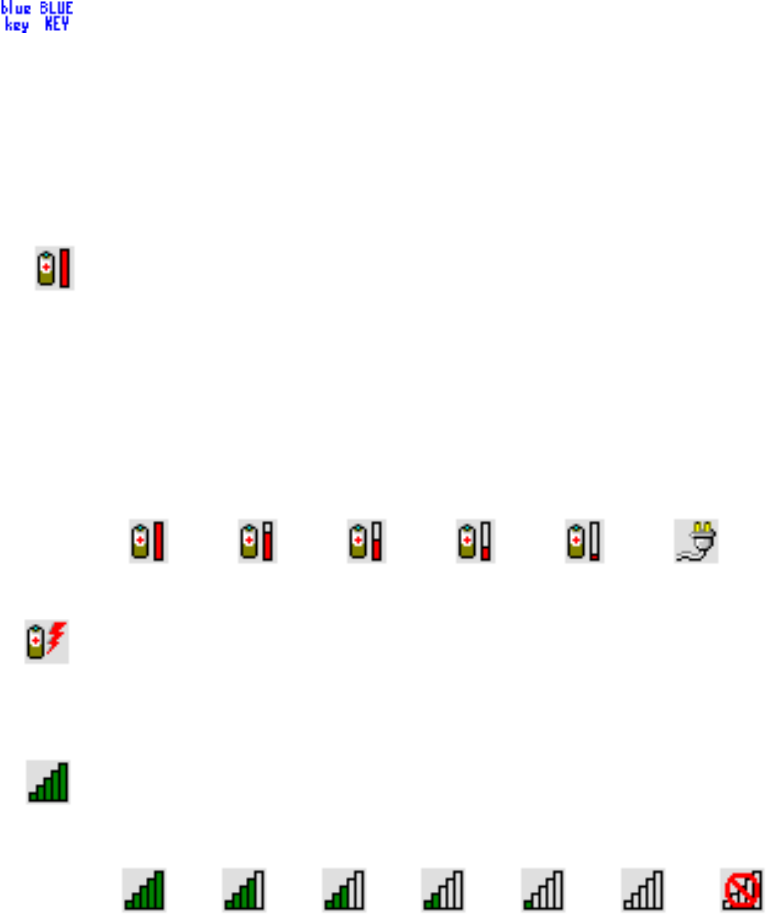
Chapter3:Getting To Know Your 7530
Onscreen Indicators
46Psion Teklogix 7530 Hand-Held Computer User Manual
Modifier Key Indicators
<SHIFT>, <CTRL>, <ALT>, <BLUE> and <ORANGE> are modifier keys that
have onscreen indicators to show when a key is active or locked. If a modifier key is
pressed once to activate it, the key is displayed in the taskbar in lowercase characters
– for example, pressing the <BLUE> key once displays blue key in the taskbar. If a
modifier key is pressed twice, it is ‘locked on’ and the onscreen indicator is
displayed in uppercase letters in the taskbar – for example, pressing <BLUE> twice
displays BLUE KEY in the taskbar.
Battery Gauge
The battery shaped icon displayed in the taskbar provides a visual indication of the
remaining battery power. The icon acts as a meter that is either full, at three-quarter
level, half, quarter level or empty.
When the battery level is low – approximately 15 minutes from empty – a warning
window pops up. When the battery power is completely depleted, a final warning
window indicates that the 7530 will be powered down.
If the 7535 is using external AC power, an AC icon is displayed in the taskbar.
Battery Charge
The battery charge icon is displayed in the taskbar when the 7535 hand-held battery
is being charged.
Radio Signal Quality
Increasing radio signal quality is represented by longer, filled bars within this icon.
AC ConnectionFull
75%
50% 25% Empty
Good No Radio
Reception Weak
Reception Link
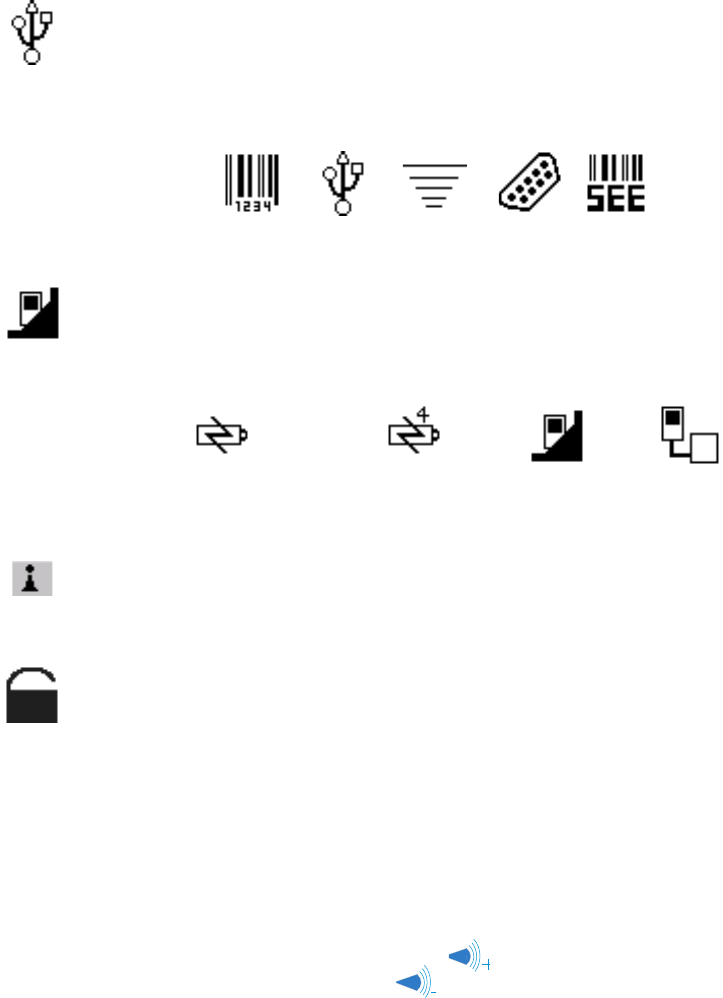
Psion Teklogix 7530 Hand-Held Computer User Manual47
Chapter3:Getting To Know Your 7530
Audio Indicators
Tethered Devices
When a peripheral is attached to the tether port and activated, an associated icon
appears in the taskbar. The sample to the left indicates that a USB device is
connected to the tether port.
Docking Device
When a 7530 is inserted in a docking station, charger or cradle, an associated icon
appears in the taskbar.
Security Level
Security levels can be set to limit user access to 7530 settings. In addition,
applications can be restricted to prevent inadvertent changes.
3.6.3 Audio Indicators
The 7530 beeper provides a variety of sounds and can be configured to emit a sound
when a key is pressed, a keyboard character is rejected, scan input is accepted or
rejected, an operator’s entry does not match in a match field or the battery is low.
The volume function keys are located in the top row of the keyboard. The increase
volume key is labelled with a plus symbol and the decrease volume function
key is labelled with a minus symbol .
Scanner RFID Serial Device Scan-SeeUSB Device
Gang Charger, Combo Charger &
Combo Docking Station Quad Docking Station Power Cradle Portable Docking
Module (PDM)

Chapter3:Getting To Know Your 7530
Adjusting The Beeper Volume
48Psion Teklogix 7530 Hand-Held Computer User Manual
3.6.3.1 Adjusting The Beeper Volume
On 58-key keyboards, the volume function keys are accessed by pressing <BLUE>
<F5> and <F6>.
On 36-key keyboards, the volume function keys are accessed by pressing <BLUE>
< F3> and <F4>.
To adjust the beeper volume:
• Press the <BLUE> key twice to lock the key ‘on’ and then, press the
increase volume function key or the decrease volume function
key until the volume is meets your requirements.
• Remember to press the <BLUE> key again to turn it ‘off’.
3.7 Internal Scanners
Important: For detailed scanner specifications and decode zone tables, refer
to “Internal Scanner Specifications” beginning on page 281.
The scanner installed in your unit can be configured using the Scanner Properties
dialogue box in the Control Panel.
The 7535 can be equipped with a:
• One dimensional (1D) internal laser scanner,
• Internal PDF laser scanner, or a
• Two dimensional (2D) internal imager scanner.
It is critical that you review the warnings listed in “Laser Warnings” on page xvi in
the Approvals and Safety section at the beginning of this manual before using any of
the scanners described in this chapter. “Scanning Techniques” outlines the
mechanics of a successful scan. In addition, review “Scan LED Indicators” on
page 49 to better understand how to interpret whether or not a bar code has been
successfully scanned. Finally, “Troubleshooting” on page 50 provides some helpful
suggestions should the scan fail.

Psion Teklogix 7530 Hand-Held Computer User Manual49
Chapter3:Getting To Know Your 7530
Scanning Techniques
3.7.1 Scanning Techniques
Note: The scanning techniques described here apply to internal and external
scanners.
• Hold the scanner at an angle. Do not hold it perpendicular to the bar code.
•Do not hold the scanner directly over the bar code. In this position, light can
reflect back into the scanner’s exit window and prevent a successful decode.
• Scan the entire bar code. If you are using a 1D or PDF laser scanner, make
certain that the scan beam crosses every bar and space on the bar code,
including the margins on either end of the symbol.
• If you are using a 2D imaging scanner, make certain the red, oval shaped
framing mark is centered within the bar code you want to scan.
• Hold the scanner farther away for larger bar codes.
• Hold the scanner closer for bar codes with bars that are close together.
3.7.2 Scan LED Indicators
The 7535 scanner LED (the lower-left LED) indicates whether or not your scan is
successful. The LED behaves as follows:
• Scan In Progress: scan LED displays solid red colour.
• Successful Scan: scan LED displays solid green colour and turns off when
the scan is ended.
• Unsuccessful scan: scan LED flashes red.
A bar code icon appears on the screen during a scan. While the scanner beam is
active, the onscreen message states – SCANNING. If the scan is successful, the bar
code data is displayed on the screen until the scan button (or pistol trigger) is
released.

Chapter3:Getting To Know Your 7530
Troubleshooting
50Psion Teklogix 7530 Hand-Held Computer User Manual
3.7.3 Troubleshooting
If the scanner is not working, investigate the following:
• Is the 7530 on?
• Check that the bar code symbology being scanned is enabled for the 7530
you are using. Check any other parameters that affect the scanning proce-
dure or the bar code.
• Check the bar code to make sure it is not damaged. Try scanning a different
bar code to verify that the problem is not with the bar code.
• Check that the bar code is within the proper range.
• Does the hand-held display the warning without scanning? This suggests a
hardware problem in the 7530.
• Is the laser beam scanning across the bar code?
• Once the scan beam has stopped, check the scanner window for
dirt or fogging.
3.7.4 Operating One Dimensional (1D) Internal Laser Scanners
• Turn the 7530 on. Wait until the unit has booted up completely.
Important: If an aiming dot is available on the installed scanner, the dot will
be enabled for a configurable time period (including off), after
which normal scanning begins. Refer to “Dot Time (msec)” on
page 120 for details.
Double-clicking the trigger will override the aiming delay and
initiate an immediate scan. Note that the aiming dot is standard
on long-range and high visibility internal scanners.
• Aim at the bar code and press the scan key or the trigger. A scan beam and a
warning indicator appear until a successful decode is achieved or six
seconds have elapsed.

Psion Teklogix 7530 Hand-Held Computer User Manual51
Chapter3:Getting To Know Your 7530
Operating Internal PDF Laser Scanners
3.7.5 Operating Internal PDF Laser Scanners
This scanner decodes PDF417 two-dimensional bar codes.
• Turn the 7530 on. Wait until the unit has booted up completely.
• Aim at the bar code and press the scan key or the trigger. The beam expands
into a rectangle covering the bar code to properly scan it. The scan beam
and a warning indicator are visible until a successful decode is achieved or
three seconds have elapsed.
3.7.6 Operating Internal Two Dimensional (2D) Imager Scanners
An imager scanner takes a snap shot of a single bar code or multiple bar codes (at
one time). It can find a bar code regardless of its orientation – that is, even a bar code
printed at a 45 degree angle to the 7530 will be decoded successfully.
Note: When scanning multiple bar codes, ensure that all of the desired bar
codes are within the field of view of the scanner. It is possible that even
when all bar codes are within the field of view, not all of them may be
decoded. Only successfully decoded bar codes are passed to the applica-
tion program. The application program then issues a warning, asking that
you scan the missing bar codes.
When scanning a single bar code, ensure that only the desired bar code is
within the field of view of the scanner.
Because imager scanners generally have a shorter depth of field than laser scanners,
some practise may be required to find the optimal distance from the types of bar
codes being scanned. Although the imager includes illumination LEDs, ambient
light will help the imager decode the bar codes, especially if the bar code is far from
the 7535.
Important: Keep in mind that the imager scanner is a camera, and the LED
illumination is a flash. Glare can be an issue on reflective media
such as plastic coated bar codes, just as glare is an issue for pho-
tographers. When pointing at a shiny surface, either shift the bar
code to the side or top, or angle the bar code so that the glare
reflects away from the imager scanner.
• Turn the 7530 computer on. Wait until the unit has booted up completely.
• Aim at the bar code and press the scan key or the trigger.
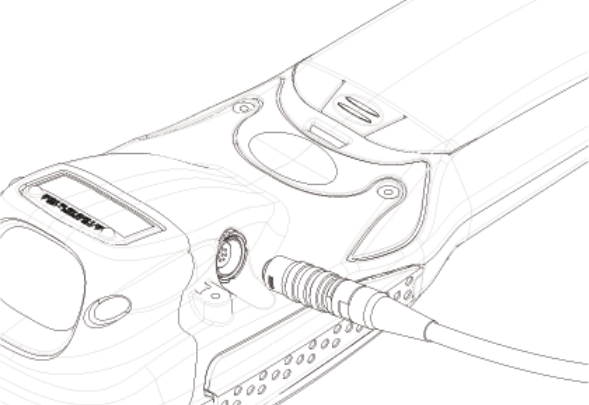
Chapter3:Getting To Know Your 7530
Connecting & Disconnecting Tethered Peripherals
52Psion Teklogix 7530 Hand-Held Computer User Manual
• When the scan button or trigger is pressed, a red, oval shaped light (the
framing marker) is displayed. Centre the framing marker in the field – either
in the centre of the bar code you want to scan or in the centre of the area in
which multiple bar codes are to be scanned.
Illumination LEDs will flash and a picture of the bar code(s) is taken.
3.8 Connecting & Disconnecting Tethered Peripherals
Tethered peripherals such as scanners and printers connect to the hand-held
computer with a quick release, circular connector. When a peripheral is connected to
the hand-held, the 7535 detects the peripheral and loads the necessary drivers for it.
An icon in the taskbar at the bottom of the screen provides a visual representation of
the peripheral and indicates that it is ready for operation.
To attach the peripheral to the round, tether port on the side of the 7530:
• Insert the barrel of the plug into the tether port and rotate slowly until
it clicks into place. The red dot on the port and on the connector should
be aligned.
Figure 3.8 Attaching The Cable To The Tether Port
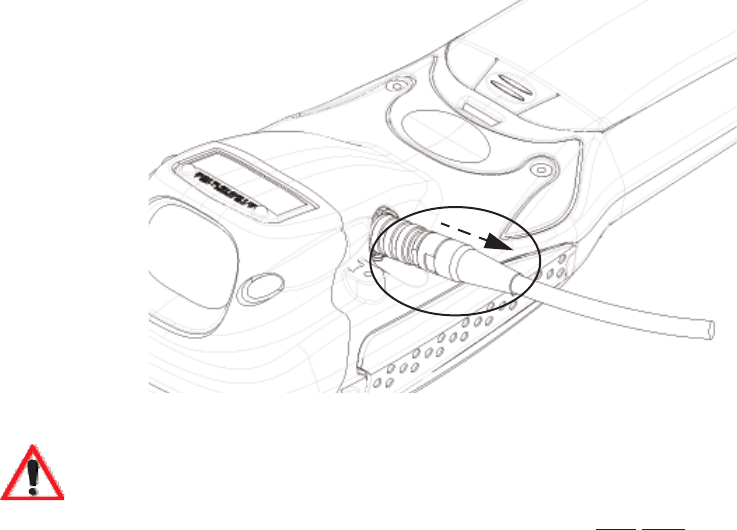
Psion Teklogix 7530 Hand-Held Computer User Manual53
Chapter3:Getting To Know Your 7530
Monitoring The Battery And Maximizing Run Time
To remove the peripheral:
• Grasp the shell of the plug, and pull it back gently to unlock and release the
connector.
Figure 3.9 Disconnecting The Tether Cable
Important: Never attempt to disconnect a peripheral by pulling the connector
by the wire. The connector is locked into place and can only be
unlocked and removed by pulling back the plug shell.
3.9 Monitoring The Battery And Maximizing Run Time
Under normal operating conditions, fully charged batteries last for 10 hours. As
Lithium-Ion batteries age, their capacity decreases gradually, and they are generally
considered depleted after approximately 2 years of use (less than 60% of original
capacity remaining). Keep in mind however that heavy usage or operating the 7530
at temperature extremes will shorten the battery life.
Lithium-Ion batteries do not require conditioning cycles and the 7530 battery
system (including chargers) requires no user interaction to maintain peak
performance.
Chapter3:Getting To Know Your 7530
Monitoring The Battery And Maximizing Run Time
54Psion Teklogix 7530 Hand-Held Computer User Manual
To maximize the run time of your batteries, consider the following:
• The display backlight is the largest drain on the battery. Try to keep its
brightness as low as possible.
• The hand-held is ‘event’ driven – that is, when the unit is not in use, it
reverts to sleep mode (even when it appears to be running), saving battery
power. Events include a key press, touchscreen taps and scan triggers.
Power consumption is reduced if you avoid unnecessary events, and allow
the unit to sleep as much as possible.
• The 7535 battery is a ‘smart battery’ with built-in intelligence. The taskbar
battery icon is a linear gauge used to estimate the remaining run time of the
battery. It is important to note that the battery capacity icon displays quarter
percentages of nominal capacity (the capacity of a new battery). An aged
battery, even when fully charged, shows somewhat less capacity than
nominal.
Double-tapping on the battery icon displays a dialogue box that provides
detailed information about the battery status and performance. If the
remaining capacity indication seems inaccurate, the battery may need recal-
ibration. Recalibration requires that the battery be fully charged, discharged
and then charged again before use. If the battery is fully discharged and
charged on a regular basis, recalibration should not be necessary.
• When the hand-held is switched off, it goes into a low-power, suspend state
but continues to draw a small amount of power from the battery. This
should not be an issue unless the unit is left in suspend state for more than a
week – in this case, the battery should be removed.
• Batteries left unused for durations of more than one or two months should
be fully charged, discharged and then charged again before use. This recali-
brates the gas gauge and allows the internal electronics to determine the
actual capacity of the battery.
• The hand-held can determine when the useful life of the battery has expired
and will notify the user. Chargers may reject batteries that have exceeded
their lifespan.

Psion Teklogix 7530 Hand-Held Computer User Manual55
Chapter3:Getting To Know Your 7530
Storing Batteries
3.9.1 Storing Batteries
Long term battery storage is not recommended. If storage is necessary:
• Always try to use a ‘first-in first-out’ approach to minimize storage time.
• Lithium-Ion batteries age much faster at elevated temperatures. Store bat-
teries at temperatures between 0˚ C and 20˚C.
• Always charge batteries to 40 to 60% before storing them. Batteries can be
damaged by an over-discharge phenomenon that occurs when an empty
battery is stored for a long period of time such that the cell voltage drops
below a lower limit.
• To minimize storage degradation, recharge stored batteries to 40 to 60%
every 4 or 6 months to prevent over-discharge damage.
• A ‘never used’ Li-Ion battery that has been stored for 3 years may have
limited or no useful life remaining once put into service. Think of batteries
as perishable goods.
3.10 Monitoring The Network Connection
If your hand-held is equipped with a wireless LAN radio, it will typically associate
with the nearest access point. The radio signal quality meter in the taskbar indicates
the relative strength of the communication link.
To access the radio signal icon from the keyboard:
• Press <BLUE> <0> to display the Start Menu.
• Choose System Tray from the menu.
• Use the <LEFT> and <RIGHT> arrow keys to highlight the radio signal
icon in the taskbar.
• Press <ENTER> to display the wireless statistics box dialogue box.
If you have a touchscreen:
• Tap on the radio icon in the taskbar to display the wireless statistics
dialogue box.
Note: Moving in and out of the radio coverage area can have varying effects on
a network session. At times, you may need to renew your connection by
logging in again.
Chapter3:Getting To Know Your 7530
Uploading Data In A Docking Station
56Psion Teklogix 7530 Hand-Held Computer User Manual
3.11 Uploading Data In A Docking Station
The Combo Docking and Quad Docking peripherals allow the 7530 to link to an
Ethernet network. They are typically used to upload transaction data to a server
computer when a radio link in not available. When a 7530 is properly inserted in a
docking station, a dock icon is displayed in the taskbar at the bottom of the 7530
screen. The 7530 also detects the presence of the Ethernet network. Review the
documentation provided with the user application installed in your 7530 before
preforming data uploads.
3.12 General Maintenance
3.12.1 Caring For The Touchscreen
The top of the touchscreen is a thin, flexible polyester plastic sheet with a
conductive coating on the inside. The polyester can be permanently damaged by
harsh chemicals and is susceptible to abrasions and scratches. Using sharp objects
on the touchscreen can scratch or cut the plastic, or crack the internal conductive
coating.
The chemicals listed below must not come into contact with the touchscreen:
• mustard,
• sodium hydroxide,
• concentrated caustic solutions,
• benzyl alcohol, and
• concentrated miner acids.
If the touchscreen is used in harsh environments, consider applying a disposable
screen protector (PN HU6110). These covers reduce the clarity of the display
slightly but will dramatically extend the useful life of the touchscreen. When they
become scratched and abraded, they are easily removed and replaced.

Psion Teklogix 7530 Hand-Held Computer User Manual57
Chapter3:Getting To Know Your 7530
Cleaning The 7530
3.12.2 Cleaning The 7530
Important: Do not immerse the unit in water. Dampen a soft cloth with mild
detergent to wipe the unit clean.
• Use only mild detergent or soapy water to clean the hand-held unit.
• Avoid abrasive cleaners, solvents or strong chemicals for cleaning. The
7530 has a plastic case that is susceptible to harsh chemicals. The plastic is
partially soluble in oils, mineral spirits and gasoline. The plastic slowly
decomposes in strong alkaline solutions.
• To clean ink marks from the keypad and touchscreen, use isopropyl
alcohol.

Psion Teklogix 7530 Hand-Held Computer User Manual59
WORKING WITH WINDOWS CE 4
4
4.1 Navigating In Windows CE And Applications ...............61
4.1.1 Navigating Using A Touchscreen And Stylus ............61
4.1.2 Navigating Using The Keyboard ...................62
4.2 Working With Files, Folders And Programs ................63
4.3 The Startup Desktop ............................64
4.3.1 The Desktop Icons ..........................65
4.3.2 The Taskbar ..............................66
4.3.2.1 Using The Taskbar ......................66
4.3.2.2 Customizing The Taskbar ..................67
4.4 The Start Menu ...............................68
4.4.1 The Desktop .............................68
4.4.2 Security Settings ...........................69
4.4.3 The System Tray ...........................70
4.4.4 The Task Manager ..........................71
4.4.5 Cycle Tasks ..............................71
4.4.6 Power Info ..............................71
4.4.7 Programs ...............................72
4.4.8 Settings ................................73
4.4.9 Run ..................................74
4.4.10 Shutdown ..............................75
4.5 Using A Dialogue Box ...........................76

Psion Teklogix 7530 Hand-Held Computer User Manual61
Chapter 4: Working With Windows CE
Navigating In Windows CE And Applications
4.1 Navigating In Windows CE And Applications
Graphic user interfaces like Windows CE for portable devices and desktop Windows
(2000, XP, etc.) utilize ‘point and click’ navigation. An equivalent keyboard shortcut
is also available for every ‘point and click’ action.
Windows CE supports the same ‘point and click’ user interface and keyboard
shortcuts as desktop Windows with one difference – the ‘point and click’ action is
accomplished using a touchscreen rather than a mouse. Actions can be performed
using any combination of keyboard shortcuts or touchscreen tapping (provided your
7530 is equipped with a touchscreen).
4.1.1 Navigating Using A Touchscreen And Stylus
Note: If the touch screen is not registering your screen taps accurately, the
touchscreen may need recalibration. Refer to “Calibrating The Touch-
screen” on page 41.
A touchscreen is an optional feature. A 7530 equipped with a touchscreen has a
stylus – a pointing tool that looks like a pen – stored in a slot at the top of the 7530.
The stylus is used to select objects on the touchscreen.
Note: To prevent damage to the touchscreen, use only the stylus (pen)
supplied with your 7530.
To open a file, launch an applet or open a folder:
• Double-tap the stylus on the appropriate icon.

Chapter 4: Working With Windows CE
Navigating Using The Keyboard
62Psion Teklogix 7530 Hand-Held Computer User Manual
4.1.2 Navigating Using The Keyboard
If your 7530 has a standard screen (rather than a touchscreen), choosing icons and
navigating dialogue boxes, displaying the desktop, and so on requires keyboard
input. If your unit has already been fully configured and your application is
launched at startup, you’ll have little need for keyboard navigation.
Table 4.1 Keyboard Navigation
Keep in mind that unlike a desktop computer, the 7530 does not support key
chording (pressing two keys at the same time). You must press one key followed by
the next in sequence.
Refer to “Working With Files, Folders And Programs” on page 63 for additional
details about keyboard navigation.
Operation Key or Key Combination
Switch between active applications <ALT> <TAB>
Open task manager <ALT> <ESC>
Move the cursor Arrow keys
Open file, folder or icon <ENTER>
Exit & Save <ENTER>
Close/Exit & Do Not Save <ESC>
Navigate Dialogue Boxes
<TAB>
To move cursor up <SHIFT> <TAB>
To display the contents of the next ‘tab’ in
a dialogue box <CTRL> <TAB>
Select Radio Button/Press Button <SPACE>
Go to Start Menu <BLUE><0>
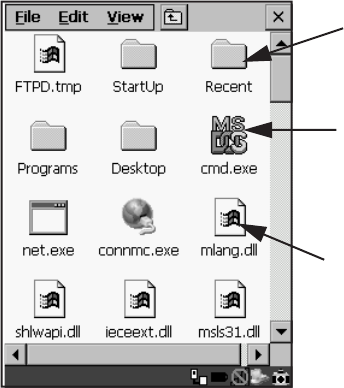
Psion Teklogix 7530 Hand-Held Computer User Manual63
Chapter 4: Working With Windows CE
Working With Files, Folders And Programs
4.2 Working With Files, Folders And Programs
Figure 4.1 Working With Windows Icons
• Use the arrow keys to highlight the icon you want to open or launch.
• Press <ENTER>.
If you have a touchscreen:
• Double-tap on the appropriate icon – either a folder icon, a program icon or
a file icon – to open or launch your selection.
Folder
File
Program Icon
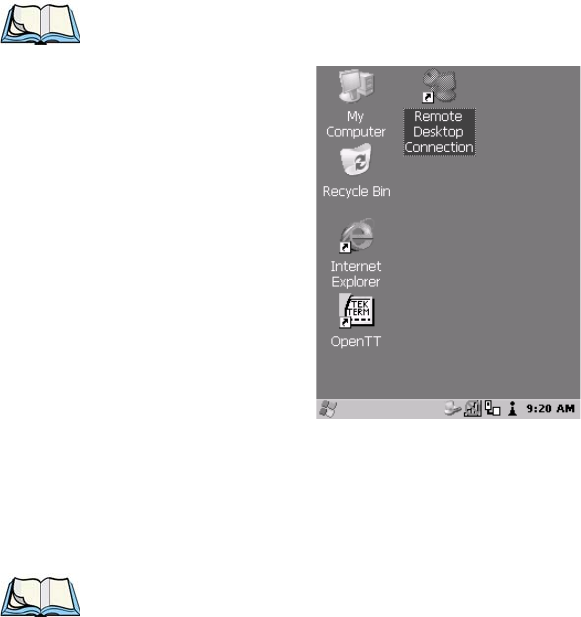
Chapter 4: Working With Windows CE
The Startup Desktop
64Psion Teklogix 7530 Hand-Held Computer User Manual
4.3 The Startup Desktop
When the 7530 boots up, the startup desktop (shell) is displayed. Any applications
stored in the Startup folder start up immediately.
Note: The startup folder is located in \Windows\StartUp and
\Flash Disk\StartUp.
Figure 4.2 The 7530 Startup Desktop
To access desktop icons:
• Use the arrow keys to highlight the icon, and press <ENTER> to launch the
highlighted icon.
Note: If the arrow keys do not highlight the desktop icons, the desktop may not
be selected. Press <BLUE> 0 (zero) to display the Start Menu, and select
Desktop. Now the desktop will be “in focus” and the arrow keys will high-
light the icons.
If you have a touchscreen:
• Tap on the icon to open a window or, in the case of an application icon,
launch an application.
Psion Teklogix 7530 Hand-Held Computer User Manual65
Chapter 4: Working With Windows CE
The Desktop Icons
4.3.1 The Desktop Icons
The icons displayed in the startup desktop operate in much the same way as those
displayed on any standard PC desktop that is running Windows®.
My Computer
Choosing this icon displays the contents of your 7530 computer. If you’re not sure
how to work with the files, folders and programs displayed, refer to “Working With
Files, Folders And Programs” on page 63.
Recycle Bin
This option temporarily contains items that were deleted, allowing you to either
permanently delete or restore these items.
Internet Explorer
Choosing this icon launches Internet Explorer – a standard Windows CE version.
Keep in mind that your supervisor will need to set up access using the Internet Options
and the Network and Dial-up Connections icons in the Control Panel.
Remote Desktop Connection
This option allows your 7530 to communicate with a remote desktop PC. “Remote
Desktop Connection” on page 83 provides a website with step-by-step instructions.
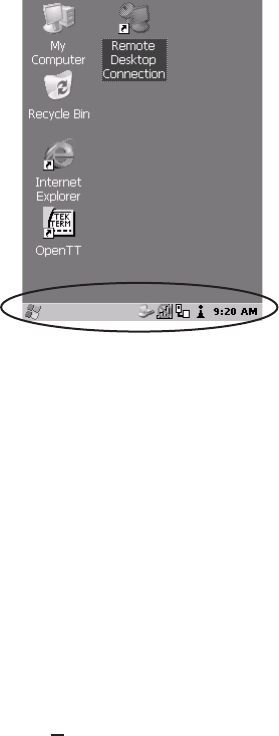
Chapter 4: Working With Windows CE
The Taskbar
66Psion Teklogix 7530 Hand-Held Computer User Manual
4.3.2 The Taskbar
Figure 4.3 The Taskbar
The 7530 is equipped with a taskbar at the bottom of the screen. It displays icons
through which you can view the battery capacity and radio signal quality of your
unit. If the hand-held is attached to a charger, cradle, docking station or PDM, an
associated icon is displayed. In addition, the taskbar displays the application(s)
currently running on your unit and the security level assigned to your 7535.
The taskbar also displays active modifier keys – <SHIFT>, <ALT>, <CTRL>,
<BLUE> and <ORANGE>. Keys that have been locked “on” are displayed in
uppercase letters. For example, if you press the <CTRL> key twice to lock it “on”, it
is displayed as CTRL KEY in the taskbar.
4.3.2.1 Using The Taskbar
• Press <BLUE> <0> to display the Start Menu.
• Type <Y> to choose System Tray from the menu.
• Use the arrow keys to highlight the icon in the taskbar about which you’d
like more information.
• Press <ENTER> to display the appropriate dialogue box.
If you have a touchscreen:
• Using the stylus, tap on the indicator you want to view – the battery icon for
example – to display a dialogue box listing the current battery capacity
information.
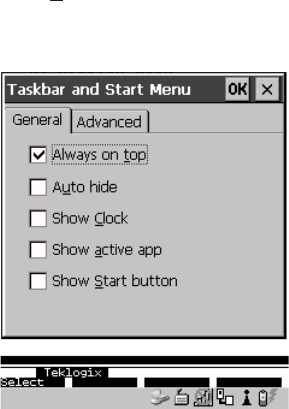
Psion Teklogix 7530 Hand-Held Computer User Manual67
Chapter 4: Working With Windows CE
Customizing The Taskbar
4.3.2.2 Customizing The Taskbar
To customize the taskbar so that it displays only those icons you require:
• Press <BLUE> <0> (zero) to display the Start Menu.
• Highlight the Settings option, highlight Taskbar... in the sub-menu, and
press <ENTER>.
The Taskbar and Start Menu dialogue box is displayed.
Figure 4.4 Taskbar And Start Menu Settings
• Under the General tab, highlight the options you want to activate, and press
the <SPACE> key to select them. A check mark indicates active items.
If you have a touchscreen:
• Tap the stylus on the items you want to activate or deactivate. The check
mark indicates active items.
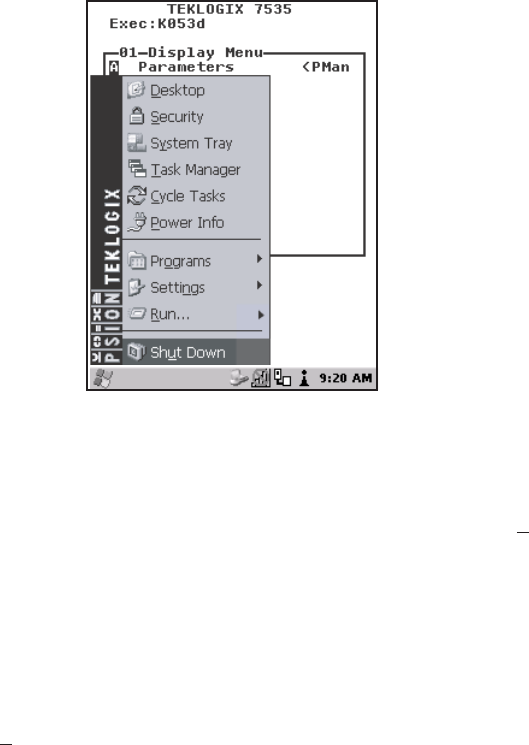
Chapter 4: Working With Windows CE
The Start Menu
68Psion Teklogix 7530 Hand-Held Computer User Manual
4.4 The Start Menu
Note: Some of the Start Menu items may be disabled based on the 7530’s
current security settings.
The Start Menu lists the operations you can access and work with. It is available from
the startup desktop or from within any application.
To display the menu:
• Press <BLUE> <0> (zero).
Figure 4.5 Start Menu
• Use the arrow keys to highlight a menu item, and press <ENTER>, or
If the menu item has an underlined character:
• Type the underlined alpha character – for example, to display the Power
Info dialogue box, type the letter p.
If you have a touchscreen:
• Tap on the Windows® Start button in the taskbar. Tap on the item in the
menu with which you want to work.
4.4.1 The Desktop
Choosing the Desktop option from the Start Menu displays the 7535 desktop.
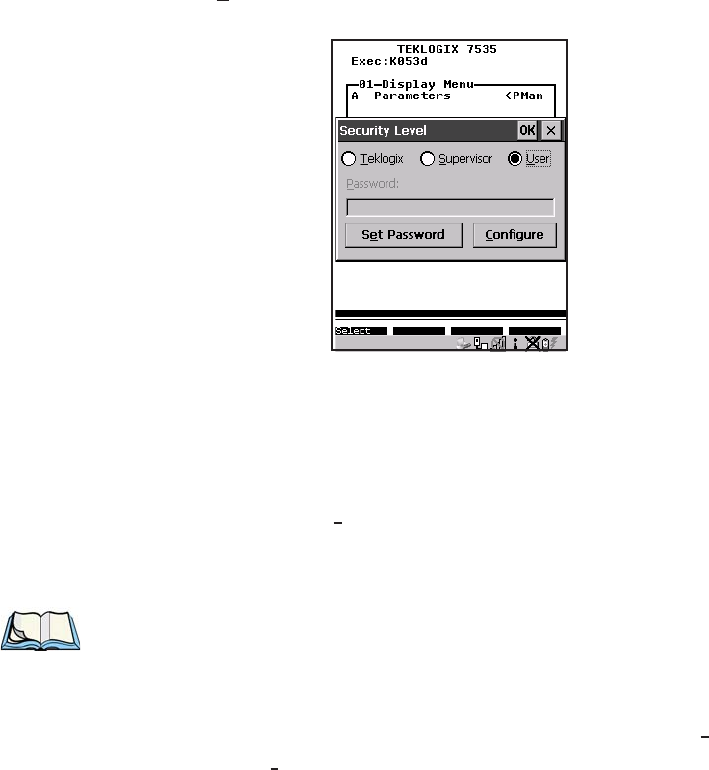
Psion Teklogix 7530 Hand-Held Computer User Manual69
Chapter 4: Working With Windows CE
Security Settings
4.4.2 Security Settings
Choosing the Security option from the Start Menu displays a dialogue box in
which you can define the access level for the 7530 – Teklogix, Supervisor or User.
Figure 4.6 Security Levels
Security Level
These security levels define the options accessible to the operator in the Start Menu
and the taskbar. When you change security levels, you’ll need to enter the
appropriate password in the Password textbox. The security level is represented by an
icon in the shape of a lock in the taskbar.
Changing A Password
Note: Keep in mind that this is the same password as that assigned through the
Password control panel applet. Refer to “Control Panel Icons” on page 84.
To assign a password:
• Choose a security level, and enter the existing password in the Password field
• Choose the Set Password button.
A dialogue box labelled Password Properties is displayed.
• Type the new password in the Password: text box
• In the Confirm Password: text box, retype the new password.
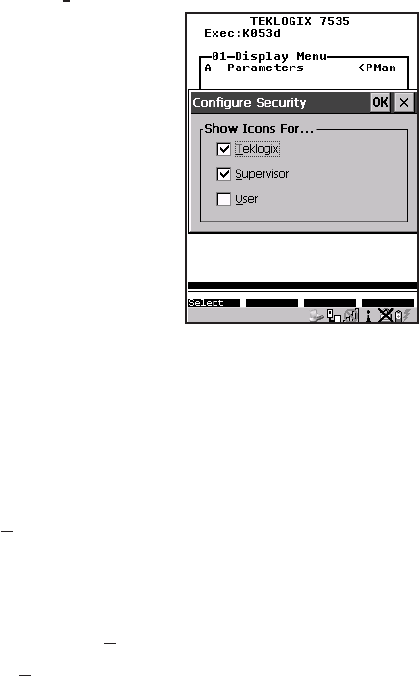
Chapter 4: Working With Windows CE
The System Tray
70Psion Teklogix 7530 Hand-Held Computer User Manual
Configuring Security
Choosing the Configure button displays the Configure Security dialogue box.
Figure 4.7 Configuring Security
This dialogue box allows you to determine which security levels will have an
associated icon displayed in the taskbar. By default, a security icon is not displayed
for user-level security.
4.4.3 The System Tray
The System Tray option allows access to the icons in the taskbar at the bottom
of the screen. The taskbar displays indicators such as a battery capacity gauge and
the security level. These indicators are attached to dialogue boxes that provide
additional information.
• Choose System Tray from the Start Menu.
When System Tray is chosen, the taskbar icons become accessible. To display
the dialogue box attached to an icon:
• Use the arrow keys to highlight an icon – for example – the security icon.
• Press <ENTER> to display the security level dialogue box.
If you have a touchscreen:
• Tap on the icon with which you want to work. The associated dialogue box
is displayed.
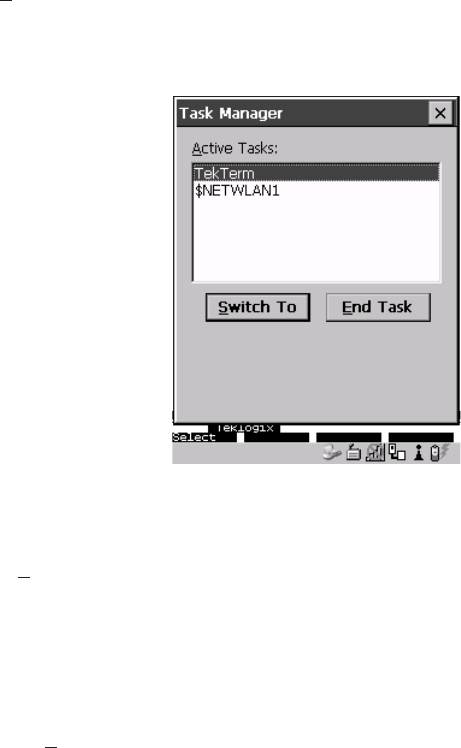
Psion Teklogix 7530 Hand-Held Computer User Manual71
Chapter 4: Working With Windows CE
The Task Manager
4.4.4 The Task Manager
The Task Manager option allows you to switch to another task or to end an
active task. To display the task manager window:
• Press <BLUE><0><T>, or
• Press <ALT> <ESC>.
Figure 4.8 Task Manager
4.4.5 Cycle Tasks
When Cycle Tasks is selected (and the Task Manager is not open), you can
cycle through active applications. To choose this option:
• Press <BLUE><0>, and type <C>, or
• Press <ALT> <TAB>.
4.4.6 Power Info
Selecting Power Info from the Start Menu displays the Power Properties dialogue box.
This dialogue box indicates the remaining charge capacity of the battery.
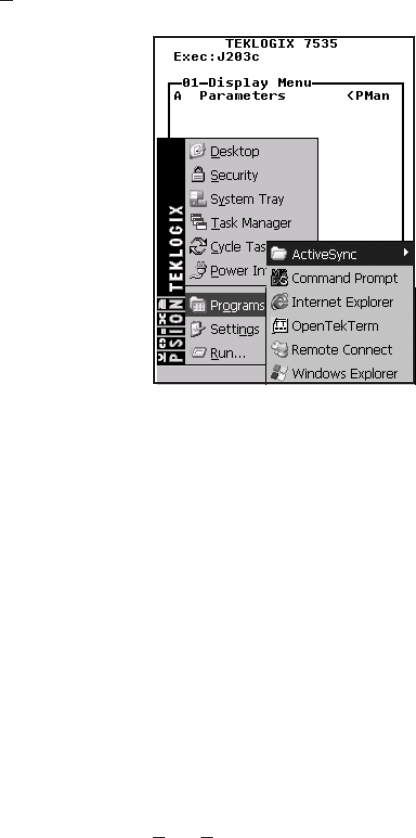
Chapter 4: Working With Windows CE
Programs
72Psion Teklogix 7530 Hand-Held Computer User Manual
4.4.7 Programs
With Programs highlighted, press the <RIGHT> arrow key to display a
sub-menu of options.
Figure 4.9 Program Sub-Menu
This sub-menu allows you to choose ActiveSync and Command Prompt, and you can access
the Internet Explorer, installed applications (e.g., Open Tekterm), Remote Desktop Connection or
Windows Explorer.
ActiveSync®
This option allows you to connect to another device using ActiveSync.
Command Prompt
Command Prompt is used to access the DOS command prompt. At the prompt, you can
type DOS commands such as dir to display all the directories in the drive.
Internet Explorer
The 7535 is equipped with Microsoft® Internet Explorer consistent with all
Windows CE devices on the market. You can access the Internet Options icon through
the Start Menu under Settings>Control Panel or by double-tapping on the
desktop icon labelled My Computer and then, double-tapping on the Control Panel icon.
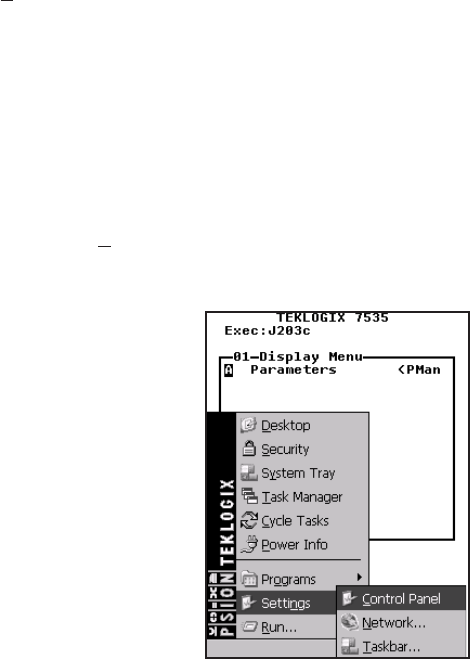
Psion Teklogix 7530 Hand-Held Computer User Manual73
Chapter 4: Working With Windows CE
Settings
Windows Explorer
Windows Explorer installed on your 7530 is consistent with all Windows CE.NET 4.2
devices. You can access this option either from the Start Menu under
Programs>Windows Explorer.
Remote Desktop Connection
Remote Desktop Connection is a 7530 application used to connect to a Windows Terminal
Server so that you can run a “session” on the Server machine using the 7530
(Windows CE device). “Remote Desktop Connection” on page 83 provides a
website with details about this option.
4.4.8 Settings
With Settings highlighted, pressing the <RIGHT> arrow key displays a
sub-menu of options, including Control Panel, Network and Dial-up Connections and Taskbar and
Start Menu settings.
Figure 4.10 Settings Sub-Menu
Control Panel
The Control Panel contains applets used to configure hardware, the operating system
and the shell. If your 7530 is running with the Psion Teklogix Tekterm application or
another application, additional configuration applets may appear in the Control Panel.
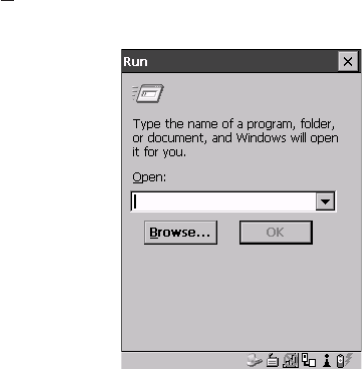
Chapter 4: Working With Windows CE
Run
74Psion Teklogix 7530 Hand-Held Computer User Manual
Network And Dial-Up Connections
The Network and Dial-up Connections window allows you to configure the 7530 radio or
execute an existing configuration. Refer to “Configuring An IEEE 802.11 Radio
Installed In The 7530” on page 18 for radio setup details.
Taskbar And Start Menu
The Taskbar and Start Menu option displays a dialogue box in which you can
customize the taskbar, choosing which options will be displayed. Refer to
“Customizing The Taskbar” on page 67 for additional details about this option.
4.4.9 Run
Choosing the Run option from the Start Menu displays a dialogue box in which you
can enter the name of the program, folder or document you want to open or launch.
Figure 4.11 Run Dialogue Box
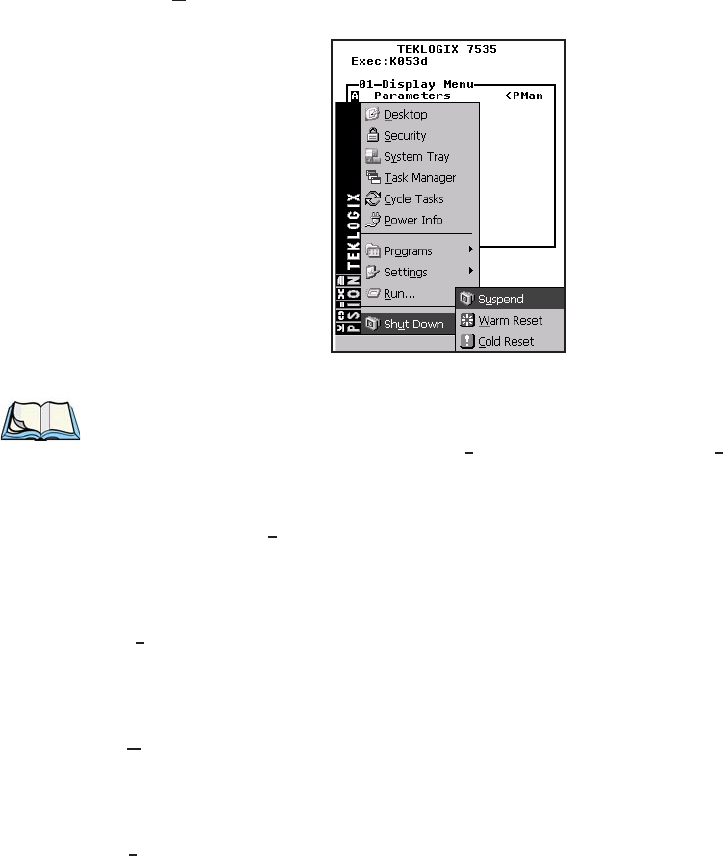
Psion Teklogix 7530 Hand-Held Computer User Manual75
Chapter 4: Working With Windows CE
Shutdown
4.4.10 Shutdown
With Shutdown highlighted, pressing the <RIGHT> arrow key displays a
sub-menu of options, including Suspend, Warm Reset and Cold Reset.
Figure 4.12 Shutdown Sub-Menu
Note: This menu varies slightly depending on the security level chosen. When
the 7530 is set to User level, the Shutdown option is replaced by Suspend.
A sub-menu is not available.
At Teklogix security level, an additional option is available in the
sub-menu – Bootloader. This option behaves like cold-reset, except
that the 7530 starts Bootloader rather than Windows CE.
Suspend
The Suspend option suspends the 7530 immediately – this is equivalent to turning the
hand-held off.
Warm Reset
The Warm Reset option resets the 7530, leaving all saved files and (registry) settings
intact. Any unsaved data is lost.
Cold Reset
The Cold Reset option resets the 7530. Any files not stored in permanent memory are
lost. However, the registry settings are saved.
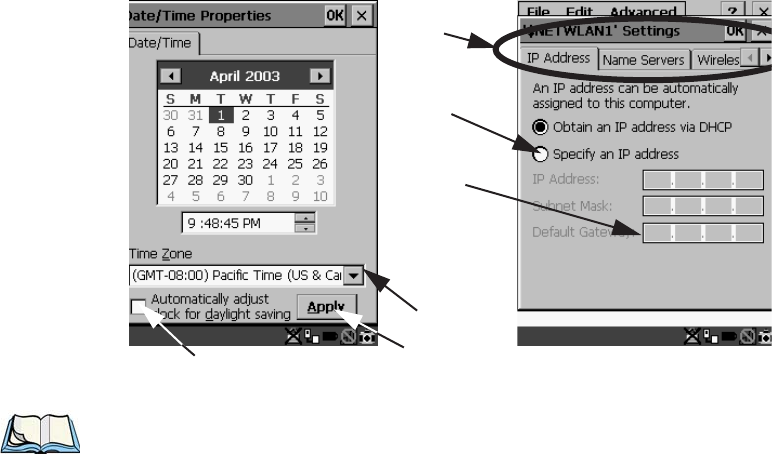
Chapter 4: Working With Windows CE
Using A Dialogue Box
76Psion Teklogix 7530 Hand-Held Computer User Manual
4.5 Using A Dialogue Box
A dialogue box (like the samples in Figure 4.13) appears when you need to make
selections and enter further information.
You can move between dialogue items by tapping on them, or by pressing the arrow
keys and the <TAB> key. (<SHIFT> <TAB> moves the cursor backwards.)
Figure 4.13 Dialogue Boxes
Note: If your unit is equipped with a touchscreen, you can use the stylus to tap
on an element in a dialogue box to select or deselect it, display dropdown
menu items, save your selections, and so on.
Dialogue boxes contain one or more of the following elements:
Tab: A tab separates different elements of a dialogue box. Press the <TAB> key
until a tab in the dialogue box is highlighted. To display adjoining tabs, press the
<RIGHT> or <LEFT> arrow key. To display the information in the next tab from
anywhere in the window, press <CTRL> <TAB>.
Textbox: A textbox requires that you type information. Press the <TAB> key to
highlight the textbox and then type the appropriate information.
Dropdown: This type of menu is identified by up and down arrows next to the
dropdown menu to indicate that additional options are available. Press the <TAB>
key to highlight the menu, and use the arrow keys on your keyboard to cycle through
the options.
Checkbox Dropdown Menu
Button
Textbox
Radio
Button
Tabs

Psion Teklogix 7530 Hand-Held Computer User Manual77
Chapter 4: Working With Windows CE
Using A Dialogue Box
Checkbox: This box allows you to select or deselect an option. To select or deselect
a checkbox, press the <TAB> key to highlight the checkbox, and press the
<SPACE> key to select (√) or deselect it.
Radio buttons: These buttons allow you to choose from a number of options. For
example, in the sample screen in Figure 4.13 on page 76 you can choose to ‘Obtain an
IP address via DHCP’ or ‘Specify an IP address’. Press the <TAB> key to highlight a radio
button option, and then select a radio button by pressing the arrow keys to highlight
the appropriate option.
Buttons: This type of button allows you to ‘Save’, ‘Delete’ and so on the options
you’ve chosen in a dialogue box. Use the <TAB> key to highlight the button you
want to use. Press the <ENTER> key to activate it.
Saving Your Choices: Once you’ve made all your changes, press the <ENTER>
key to save your changes and exit the window.
Note: A dialogue box item that is displayed in grey text indicates that it is not
currently available.

Psion Teklogix 7530 Hand-Held Computer User Manual79
CONFIGURATION 5
5
5.1 Remote Desktop Connection ........................83
5.2 Pocket PC Compatibility ..........................83
5.3 The Control Panel ..............................83
5.4 Control Panel Icons .............................84
5.5 Basic Setup .................................88
5.5.1 Display Properties ..........................88
5.5.1.1 Display Contrast .......................88
5.5.1.2 Display Backlight ......................89
5.5.1.3 Display Appearance .....................91
5.5.2 Keyboard Properties .........................92
5.5.2.1 Key Repeat..........................92
5.5.2.2 Keyboard Backlight .....................93
5.5.2.3 Keyboard One Shot Modes .................94
5.5.2.4 Keyboard Macro Keys ....................95
5.5.2.5 Unicode Mapping ......................97
5.5.3 Volume And Sound Properties ....................99
5.5.3.1 Volume Adjustments .....................99
5.5.4 Power Management Properties ................... 100
5.5.4.1 Battery Capacity ...................... 100
5.5.4.2 Power Saving Schemes .................. 101
5.5.4.3 Suspend Threshold..................... 102
5.5.4.4 Charger Details ...................... 103
5.5.5 Stylus Properties .......................... 103
5.5.5.1 Setting Double-Tap Sensitivity .............. 104
5.5.5.2 Touchscreen Calibration .................. 104
5.5.6 Certificate Assignment ....................... 105
5.7 Scanner Properties Setup ......................... 118
5.7.1 Scanner Options .......................... 118
5.7.2 Bar Codes .............................. 121
5.7.2.1 Code 39 Settings ...................... 122
5.7.2.2 Code 128 Settings ..................... 124
Chapter 5: Configuration
80Psion Teklogix 7530 Hand-Held Computer User Manual
5.7.2.3 EAN 13 Settings ......................125
5.7.2.4 EAN 8 ...........................126
5.7.2.5 UPC And EAN Settings ..................127
5.7.2.6 UPC A Settings.......................127
5.7.2.7 UPC E Settings.......................127
5.7.2.8 Codabar...........................128
5.7.2.9 Code 93...........................128
5.7.2.10 Code 11 ..........................128
5.7.2.11 Interleaved 2 of 5 .....................129
5.7.2.12 MSI Plessey........................129
5.7.2.13 Discrete 2 of 5 ......................129
5.7.2.14 IATA 2 of 5 ........................130
5.7.2.15 Postal: Australian .....................130
5.7.2.16 Postal: Japanese......................130
5.7.2.17 Postal: Korean.......................130
5.7.2.18 Postal: PlaNET ......................131
5.7.2.19 Postal: PostNET......................131
5.7.2.20 Postal: Royal Mail ....................131
5.7.2.21 2D DataMatrix ......................131
5.7.2.22 2D Maxicode .......................131
5.7.2.23 2D PDF-417........................131
5.7.2.24 2D Micro PDF-417 ....................132
5.7.2.25 2D QR Code .......................132
5.7.2.26 2D RSS Code .......................132
5.7.2.27 Aztec ...........................132
5.7.3 Translations .............................132
5.8 SNMP (Simple Network Management Protocol) Setup..........134
5.8.1 Contact Tab .............................135
5.8.2 Communities Tab ..........................136
5.8.2.1 Adding A Community ...................137
5.8.2.2 Modifying A Community Setting .............138
5.8.2.3 Removing An Existing Community ............138
5.8.3 Trap Destination Tab ........................139
5.8.3.1 Enabling Authentication TRAPS..............139
5.8.3.2 Adding A Destination ...................139
5.8.3.3 Changing A Destination ..................140
5.8.3.4 Removing A Trap Destination ...............140

Psion Teklogix 7530 Hand-Held Computer User Manual83
Chapter 5: Configuration
Remote Desktop Connection
5.1 Remote Desktop Connection
Remote Desktop Connection is a 7530 application used to connect to a Windows Terminal
Server so that you can run a “session” on the Server machine, using the 7535
(Windows CE device).
Refer to the following website for step-by-step information about setting up this
connection:
http://www.microsoft.com/WindowsXP/pro/using/howto/gomobile/remotedesktop/default.asp
5.2 Pocket PC Compatibility
The 7535 supports the AYGShell API set that allows PocketPC-compatible
applications to run on the hand-held. Microsoft® Windows® CE.NET 4.2 is
designed to include application programming interface (API) compatibility support
for the Microsoft Windows Powered Pocket PC 2002 shell in 7535s running
Windows® CE.NET 4.2.
The website listed below describes the APIs exposed through AYGShell and the
application compatibility between Windows Powered Pocket PC 2002-based
applications and Windows CE.NET 4.2-based devices:
http://msdn.microsoft.com/library/default.asp?url=/library/en-us/dncenet /html/WINCENET_CEPCC_App.asp
5.3 The Control Panel
The Windows CE Control Panel provides a group of icons through which you can set a
variety of system-wide properties, such as mouse sensitivity, network configuration
and the desktop color scheme.
Note: If you are uncertain how to move around a dialogue box and make selec-
tions, review “Using A Dialogue Box” on page 76.
When the 7535 boots up, the startup desktop (shell) is displayed, and any
applications stored in the Startup folder start up immediately.
To access the Windows CE Control Panel:
• Press BLUE> <0> to display the Start Menu.
• Highlight Settings in Start Menu, and press the <RIGHT > arrow key to
highlight the Control Panel option.
• Press the <ENTER> key to display the contents of the Control Panel window.
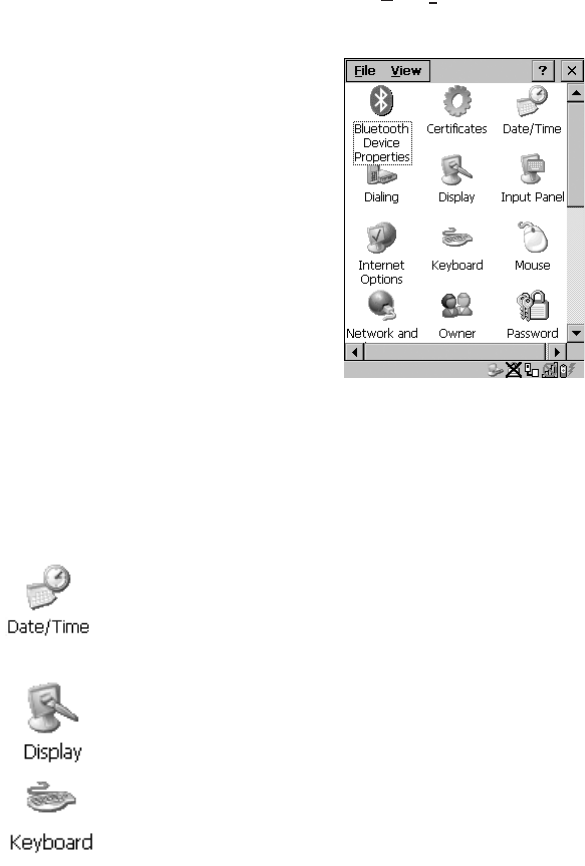
Chapter 5: Configuration
Control Panel Icons
84Psion Teklogix 7530 Hand-Held Computer User Manual
If you have a touchscreen:
• Use the stylus to tap on the Windows Start button in the taskbar to display the
Start Menu. Tap on Settings>Control Panel.
The Control Panel folder contains icons used in the setup of your 7530.
Figure 5.1 Control Panel
5.4 Control Panel Icons
The Windows CE Control Panel provides a group of icons that allow you to customize
and adjust settings on your 7530.
Date/Time
Allows you to set the current Month, Date, Time and Time Zone on your
unit.
Display
Changes the appearance (window colour scheme) on the unit desktop.
Keyboard
Toggles character repeat on and off and specifies delay and rate for repeated
characters. It also allows you to adjust the keyboard backlight threshold and
intensity.

Psion Teklogix 7530 Hand-Held Computer User Manual85
Chapter 5: Configuration
Control Panel Icons
Volume & Sound
Allows you to adjust the volume of the beep that is emitted to indicate
events like warnings, key clicks and, if your unit is equipped with a touch-
screen, screen taps.
Sounds (wave files) cannot be reproduced on 7535 units. The beeper
volume and the conditions under which it sounds are tailored from within
the application installed on your unit.
Mouse Properties
For units equipped with touchscreens, this icon allows you to customize the
sensitivity and speed of the stylus double-tap.
Owner
Provides fields in which you can specify owner information. A ‘Notes’ tab
allows additional information to be entered and displayed when the unit is
powered up. ‘Network ID’ tab information is used to access network resources.
(This information should be provided by your System Administrator.)
Password
Allows you to assign a password to restrict access to elements of the unit.
Once assigned, password access cannot be circumvented so it is important
that you write down your password and keep it in a safe place. Refer to
“Security Settings” on page 69 for details.
Power
Displays battery pack power status. (Alternately, battery status can be
accessed through the taskbar.) The ‘Power Scheme’ tab allows you to deter-
mine a suspend states, and the ‘Charger’ tab determines whether or not a
battery that requires it, can be recalibrated. (Refer to “Power Saving
Schemes” on page 101 for details.)

Chapter 5: Configuration
Control Panel Icons
86Psion Teklogix 7530 Hand-Held Computer User Manual
Regional Settings
Allows you to specify the local language the display text will use along
with the format of numbers, currency, time and date for your region.
Remove Programs
Lists the programs that can be removed from your unit. To remove a pro-
gram, select it and then click on the Remove button.
Stylus
Adjusts how Windows CE recognizes your double-tap (as slow or rapid
successive taps).
Under the ‘Calibration’ tab, you can recalibrate your touchscreen by tapping
on the ‘Recalibrate’ button and following the directions on the calibration
screen.
System
Displays system and memory properties. Under the Memory tab, you can
allocate memory between storage memory and program memory.
Dialing
Specifies dialing settings, including area code, country code, dial type and
the code to disable call waiting. You can store multiple patterns – for exam-
ple, ‘Work’, ‘Home’, and so on using this dialogue box.
Certificates
A public key is transmitted as part of a certificate. The certificate assigned
through this icon is used to ensure that the submitted public key is, in fact,
the public key that belongs to the submitter. The client checks that the cer-
tificate has been digitally signed by a certification authority that the client
explicitly trusts. “Certificate Assignment” on page 105 directs you to the
appropriate setup information.

Psion Teklogix 7535 Hand-Held Computer User Manual 87
Chapter 5: Configuration
Control Panel Icons
PC Connection
Enables direct connections to a desktop computer. Selecting the ‘Change Con-
nection’ button allows you to change the type of direct connect to your PC.
Teklogix Scanners
Used to set up scanner parameters and choose the bar code symbologies
that the 7530 scanner will successfully read.
Network And Dial-up Connections
Displays a network window from which the 7530 radio can be configured
and an existing configuration can be executed. Refer to “Configuring An
IEEE 802.11 Radio Installed In The 7530” on page 18 for details.
Internet Options
Used to configure your Internet browser including options such as identify-
ing the default and search page that the browser applies when connecting to
the Internet, setting the cache size, specifying the Internet connection
options, and defining the security level that is applied when browsing.
SNMP
SNMP (Simple Network Management Protocol) is the protocol used to
monitor and manage devices attached to a TCP/IP network.
Input Panel
The 7535 is equipped with the framework for a Soft Input Panel (SIP)
should you need to design your own SIP.
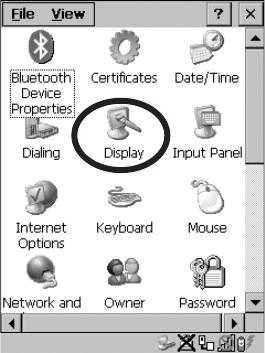
Chapter 5: Configuration
Basic Setup
88Psion Teklogix 7530 Hand-Held Computer User Manual
5.5 Basic Setup
5.5.1 Display Properties
• In the Control Panel, choose the Display icon.
Figure 5.2 Choosing The Display Icon
5.5.1.1 Display Contrast
The Contrast tab allows you to adjust the 7530 display contrast to suit the environment
in which you are using the hand-held.
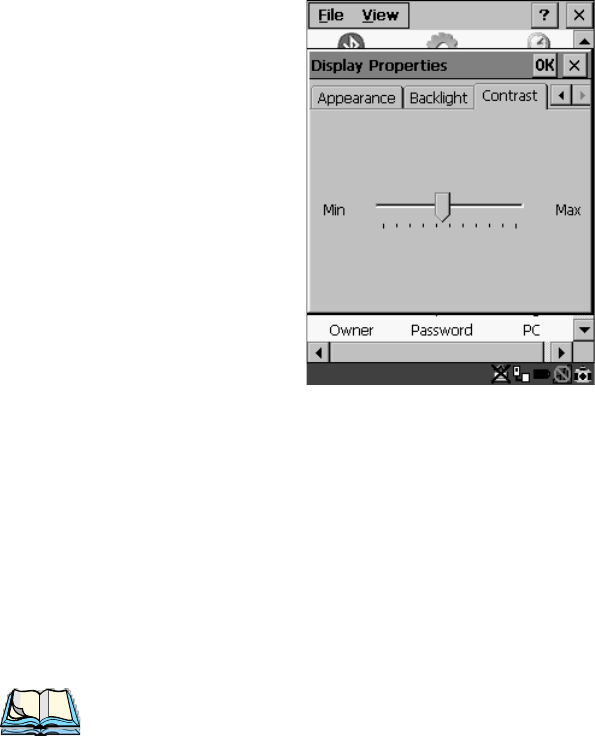
Psion Teklogix 7530 Hand-Held Computer User Manual89
Chapter 5: Configuration
Display Backlight
• In the Display Properties dialogue box, open the Contrast tab.
Figure 5.3 Display Contrast Properties
Sliding bar in the Contrast tab to the left decreases or darkens the display contrast.
Sliding the bar to the right to increases or lightens the display contrast.
5.5.1.2 Display Backlight
The backlight is activated for a configurable amount of time if the ambient light is
below a specified threshold and if the 7535 is in use (key press, scanner trigger or
data received from the host). The Display Properties dialogue box in the Control Panel
allows you to specify the intensity of the backlight along with how the backlight
behaves in low-light conditions and when the unit is not in use.
Note: Keep in mind that this option may be restricted to supervisory use only.
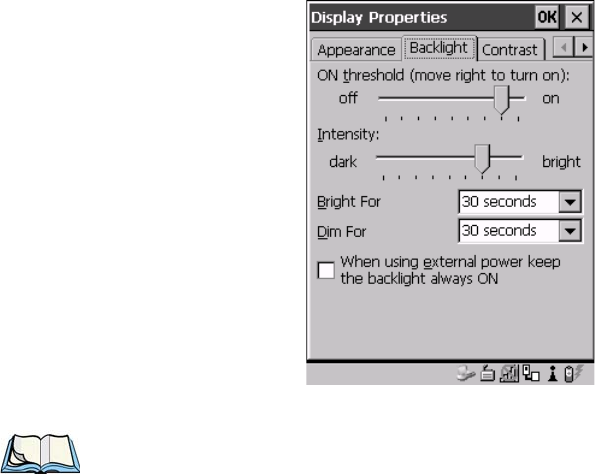
Chapter 5: Configuration
Display Backlight
90Psion Teklogix 7530 Hand-Held Computer User Manual
• In the Display Properties dialogue box, open the Backlight tab.
Figure 5.4 Display Backlight Properties
Note: Backlight changes take affect immediately. You do not need to reset
the 7530.
ON Threshold
The 7530 is equipped with an ambient light sensor. This sliding bar allows you to
determine how dark the ambient light needs to be before the backlight turns on.
Intensity
This parameter is used to adjust the light intensity of the 7530 backlight. Sliding the
bar to the left lowers the light intensity, and sliding it to the right raises the intensity.
Bright For
The value chosen from this dropdown menu determines the duration of time that the
backlight stays on at the configured intensity when a unit is not in use.
Dim For
The value chosen from this dropdown menu determines the duration of time that
the backlight stays on at half the configured intensity (dimmed backlight) when a
unit is not in use.
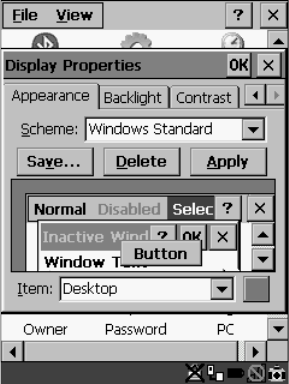
Psion Teklogix 7530 Hand-Held Computer User Manual91
Chapter 5: Configuration
Display Appearance
External Power Checkbox
When you select (√) the checkbox next to ‘When using external power keep the backlight
always ON.’, the backlight remains ON at the configured intensity when the 7530 is
operating with external power (not battery power). If the 7530 is drawing power
from its battery, this option is ignored and the other parameters defined in Display
Properties dialogue box take affect.
5.5.1.3 Display Appearance
• In the Display Properties dialogue box, open the Appearance tab.
Figure 5.5 Display Appearance Properties
This dialogue box allows you to customize the display colour scheme.

Chapter 5: Configuration
Keyboard Properties
92Psion Teklogix 7530 Hand-Held Computer User Manual
5.5.2 Keyboard Properties
This icon displays the Keyboard Properties dialogue box in which you can adjust the
repeat rate of the keys, the intensity of the keyboard backlight and the behaviour of
the <BLUE> and <ORANGE> modifier keys. This dialogue box also allows you to
define macro keys and Unicode characters.
• In the Control Panel, choose the Keyboard icon.
Figure 5.6 Choosing The Keyboard Icon
5.5.2.1 Key Repeat
• In the Keyboard Properties dialogue box, open the Repeat tab.
Figure 5.7 Key Repeat Properties
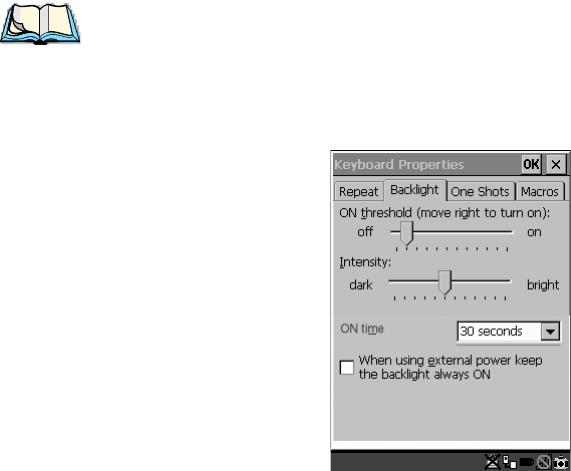
Psion Teklogix 7530 Hand-Held Computer User Manual93
Chapter 5: Configuration
Keyboard Backlight
Repeat Delay
The value assigned for this parameter determines the delay in milliseconds between
repeat characters. Sliding the Repeat Delay bar to the left increases the delay between
key repeats while sliding the bar to the right shortens the repeat delay time.
Repeat Rate
The value assigned for the Repeat Rate parameter determines how quickly the key you
press repeats and is measured in characters per second (cps). Sliding the bar to the
left slows the repeat rate, and sliding the bar to the right increases the repeat rate.
Note: Use the field at the bottom of this dialogue box to test the repeat delay and
rate settings you’ve chosen.
5.5.2.2 Keyboard Backlight
• In the Keyboard Properties dialogue box, open the Backlight tab.
Figure 5.8 Keyboard Backlight Properties
ON Threshold
The ON Threshold sliding bar allows you to determine how dark the ambient light needs
to be before the keyboard backlight turns on.
Intensity
This parameter is used to adjust the light intensity of the 7530 keyboard backlight.
Sliding the bar to the left darkens the keyboard backlight intensity, and sliding it to
the right lightens the intensity.
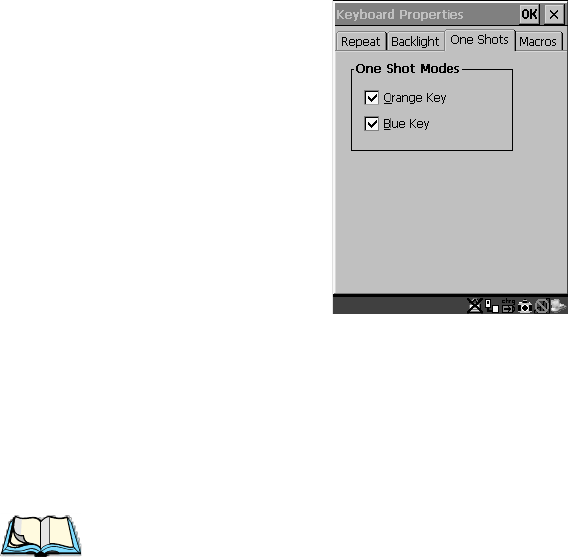
Chapter 5: Configuration
Keyboard One Shot Modes
94Psion Teklogix 7530 Hand-Held Computer User Manual
ON Time
The value chosen from this dropdown menu determines the duration of time that the
keyboard backlight stays on when a unit is not in use.
5.5.2.3 Keyboard One Shot Modes
• In the Keyboard Properties dialogue box, open the One Shots tab.
Figure 5.9 Keyboard One Shot Properties
When these options are enabled (√), the <ORANGE> and <BLUE> keys only
remain active until the next key is pressed. If the ‘One Shots’ options are disabled
(the checkbox is left blank), the <ORANGE> and <BLUE> keys are locked ‘on’
when pressed only once; they remain ‘on’ until they are pressed a second time to
unlock them.
Note: Keep in mind that checking the taskbar lets you know whether or not
these keys are locked on. When the <ORANGE> and <BLUE> keys
are locked ‘on’, the taskbar at the bottom of the screen displays them
in uppercase characters – BLUE KEY and ORANGE KEY. If these keys are dis-
played in lowercase characters in the taskbar, you’ll know that the Blue Key
and the Orange Key are not locked. They will become inactive following a
key press.
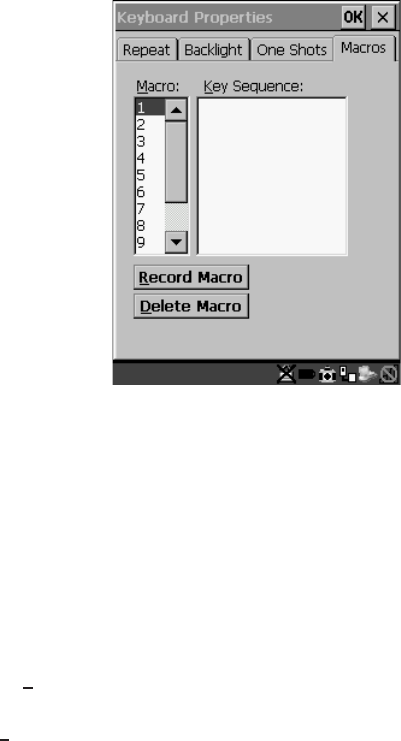
Psion Teklogix 7530 Hand-Held Computer User Manual95
Chapter 5: Configuration
Keyboard Macro Keys
5.5.2.4 Keyboard Macro Keys
• In the Keyboard Properties dialogue box, open the Macros tab.
Figure 5.10 Macro Dialogue Box
A macro has 20 programmable characters (or “positions”). The macro keys can be
programmed to replace frequently used keystrokes, along with the function of
executable keys including <ENTER>, <BKSP> and <DEL> (<BLUE>-<BKSP>),
function keys and arrow keys.
Recording And Saving A Macro
You can program up to 12 macro keys on a 58-key keyboard and 6 macro keys on a
36-key keyboard.
• In the Macro: menu, highlight a macro key number – for example, macro 1 to
assign a macro to macro key <M1>. Press the <TAB> key twice to highlight
the Record Macro button, and press <ENTER>.
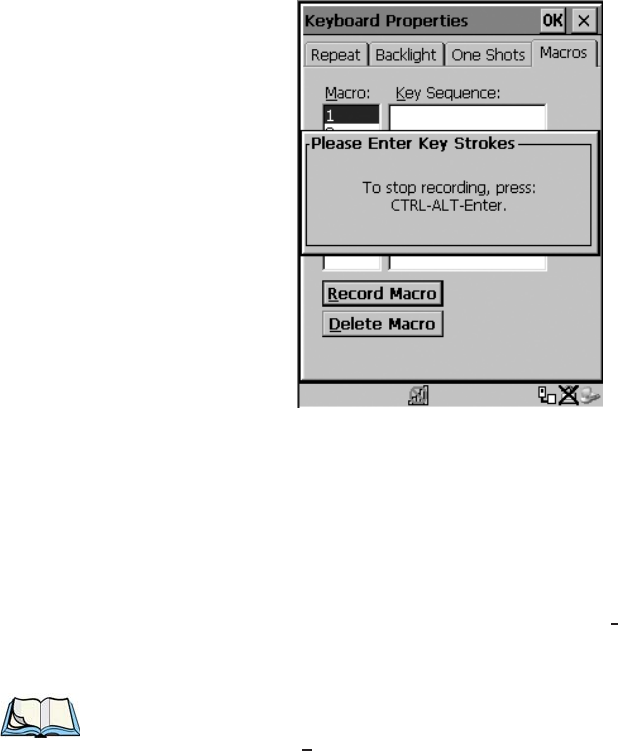
Chapter 5: Configuration
Keyboard Macro Keys
96 Psion Teklogix 7535 Hand-Held Computer User Manual
A message screen is displayed instructing you to ‘Please Enter Key Strokes’.
Figure 5.11 Recording A Macro
• Type the macro sequence you want to assign to the Macro key. You can type
text and numbers, and you can program the function of special keys into a
macro.
• When you’ve finished recording your macro sequence, press the key
sequence – <CTRL> <ALT> <ENTER>.
A new screen displays the macro sequence you created. The Save Macro button is
highlighted.
• Press <ENTER> to save your macro.
Note: If you want to discard the macro you’ve just created, press the <TAB> key
to highlight the Discard Macro button and press <ENTER>.
Executing A Macro
To execute a macro:
• Press the macro key to which you’ve assigned the macro. For example, if
you created a macro for macro key ‘1’, press <M1> to execute the macro.
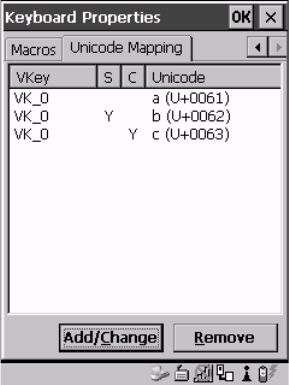
Psion Teklogix 7530 Hand-Held Computer User Manual97
Chapter 5: Configuration
Unicode Mapping
Deleting A Macro
To delete a macro:
• In the Macros tab, use the arrow keys to highlight the macro number you want
to delete.
• Press <TAB> to highlight the Delete Macro button, and press <ENTER>.
5.5.2.5 Unicode Mapping
• In the Keyboard Properties dialogue box, open the Unicode Mapping tab.
Figure 5.12 Unicode Mapping
The Unicode Mapping tab is used to map combinations of virtual key values and
<CTRL> and <SHIFT> states to Unicode™ values. This tab shows the configured
Unicode character along with the Unicode value. For example, the sample screen
above shows “a (U+0061)” indicating that the character “a” is represented by the
Unicode value “0061”, and so on. Keep in mind that Unicode configurations are
represented as hexidecimal rather than decimal values.
All user-defined Unicode mappings are listed in the Unicode Mapping tab in order of
virtual key value, and then by order of the shift state. If a Unicode mapping is not
listed, the Unicode mapping is mapped to the default Unicode value.
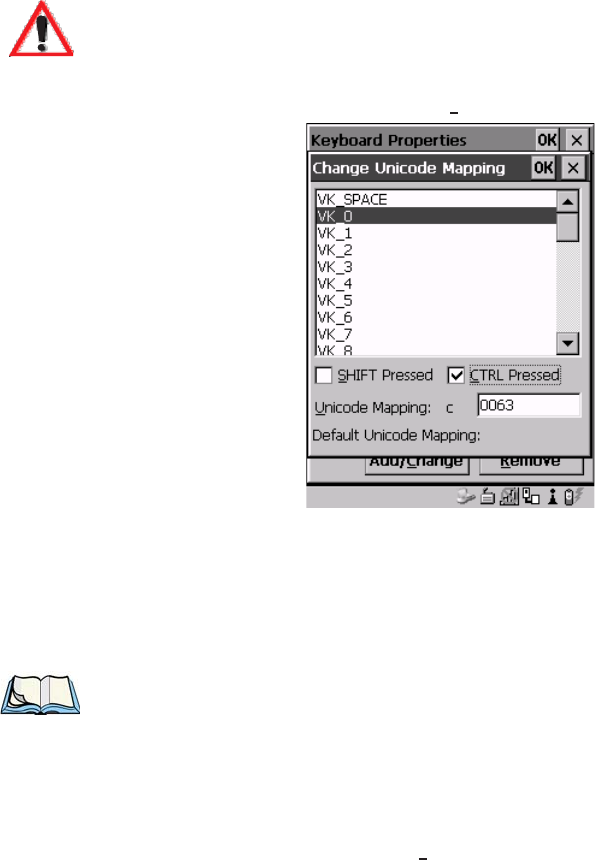
Chapter 5: Configuration
Unicode Mapping
98Psion Teklogix 7530 Hand-Held Computer User Manual
Adding And Changing Unicode Values
Important: Changes to Unicode mappings are not saved until you exit the
Keyboard Properties dialogue box.
• Press <TAB> to highlight the Add/Change button, and press <ENTER>.
Figure 5.13 Adding And Change Unicode Values
• Highlight the a value in the Unicode mapping list – in the sample screen
above, a value will be assigned to virtual key 0 (VK 0).
• Press <TAB> to position the cursor in the ‘Unicode Mapping’ field and
type a Unicode value for the highlighted key.
Note: To add a shifted state – <SHIFT> and/or <CTRL>, press <TAB> to posi-
tion the cursor in the checkbox next to ‘SHIFT Pressed’ and/or ‘CTRL
Pressed’. Press <SPACE> to select (
√
) the shift state you want to assign.
Removing Unicode Values
• In the ‘Unicode Mapping’ tab, highlight the item you want to delete, and
press <TAB> to highlight the Remove button.
• Press <ENTER> to delete the value.
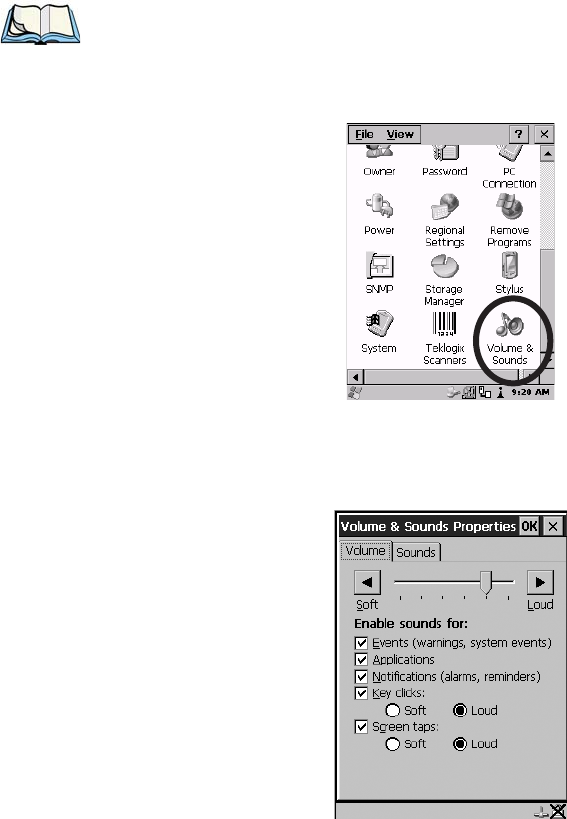
Psion Teklogix 7530 Hand-Held Computer User Manual99
Chapter 5: Configuration
Volume And Sound Properties
5.5.3 Volume And Sound Properties
Note: Sounds (wave files) cannot be reproduced on 7530 units. The conditions
under which 7530s emit sounds are tailored from within the application
installed on your unit.
• In the Control Panel, choose the Volume & Sounds icon.
Figure 5.14 Choosing The Volume Icon
5.5.3.1 Volume Adjustments
Figure 5.15 Volume Settings
• Slide the volume button to the left to lower the beeper volume or to the right
to increase the beeper volume.
• Under the heading ‘Enable sounds for:’, enable (√) the conditions under which
you want the 7530 to emit a beep.

Chapter 5: Configuration
Power Management Properties
100Psion Teklogix 7530 Hand-Held Computer User Manual
5.5.4 Power Management Properties
This icon displays a Power Properties dialogue box that indicates the unit’s battery
capacity and allows you to manage battery use.
• In the Control Panel, choose the Power icon.
Figure 5.16 Choosing The Power Icon
5.5.4.1 Battery Capacity
• In the Power Properties dialogue box, open the Battery tab.
Figure 5.17 Power Battery Properties
The Battery tab details information about the battery installed in your 7530.
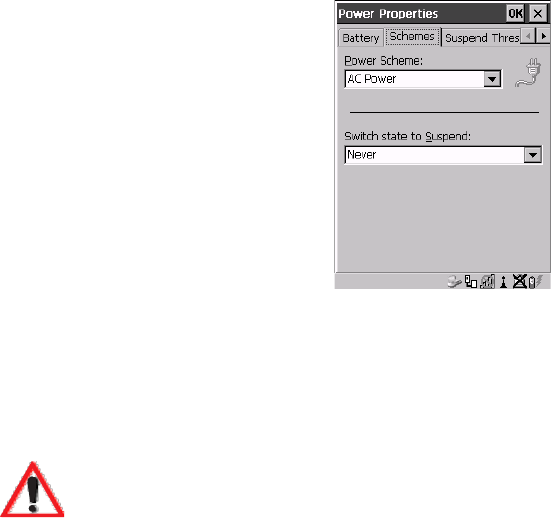
Psion Teklogix 7530 Hand-Held Computer User Manual101
Chapter 5: Configuration
Power Saving Schemes
5.5.4.2 Power Saving Schemes
• In the Power Properties dialogue box, open the Schemes tab.
Figure 5.18 Power Scheme Properties
Power Scheme
This dropdown menu allows you to specify whether the unit is using AC Power or
Battery Power.
Switch State To Suspend
Important: Psion Teklogix recommends setting the Suspend value to 10 min-
utes. Setting ‘Switch State To Suspend’ to ‘Never’ will adversely
affect the battery run time.
To further reduce power consumption, carefully consider the
duration of time that the display backlight is ‘on’ (see “Display
Backlight” on page 89).
When the 7535 is idle – not receiving any user input (a key touch, a scan, and so on)
or system activity (serial data, an activity initiated by an application, and so on), the
hand-held uses the value assigned in the Switch State To Suspend field to determine when
the unit will go to sleep (appear to be off).
When the time in the Suspend field elapses without any activity, the unit enters Suspend
state. In Suspend state, the 7530 CPU enters a sleep state, and the radio is shut off. The
state of the device (RAM contents) is preserved. Pressing <ENTER> wakes the
system from suspend state. When the 7530 is in suspend state, the network
connection will not be broken immediately. If the connection is dropped, you must
re-establish the network connection.
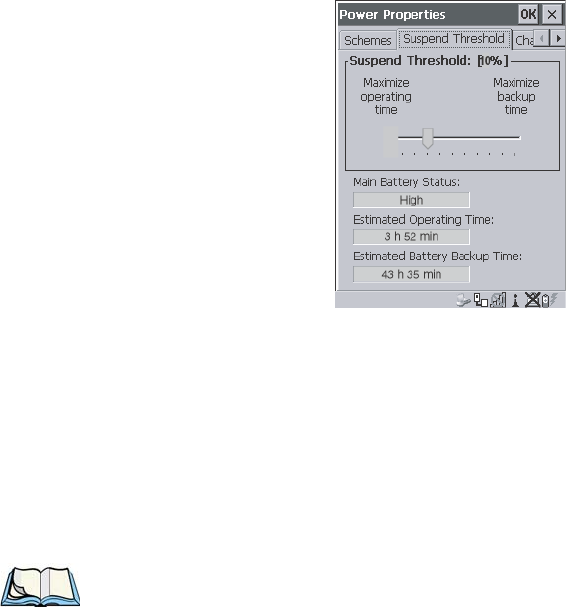
Chapter 5: Configuration
Suspend Threshold
102Psion Teklogix 7530 Hand-Held Computer User Manual
5.5.4.3 Suspend Threshold
• In the Power Properties dialogue box, open the Suspend Threshold tab.
Figure 5.19 Suspend Threshold Properties
Suspend Threshold
The sliding bar in this tab is used to set the battery capacity (as a percentage value)
at which the hand-held will be forced into a suspend state. For example, if you slide
the bar in the Suspend Threshold tab to the right to the 10% level, when the battery
capacity falls to 10%, the 7530 will enter suspend state. You will not be able to
resume until the battery is charged, or you operate the 7530 using AC power. The
allowable threshold ranges from 0 to 50%. The default value is 0%.
Note: The7530 hand-held does not enter suspend state when it is using
AC power.
Main Battery Status
This field indicates the status of the main battery.
Estimated Operating Time
This field estimates the length of time the 7530 can remain ‘on’ (operating) before
reaching the configured Suspend Threshold.
Estimated Battery Backup Time
This field displays the amount of time the state of the 7530 will be maintained in
suspend at the currently configured Suspend Threshold.
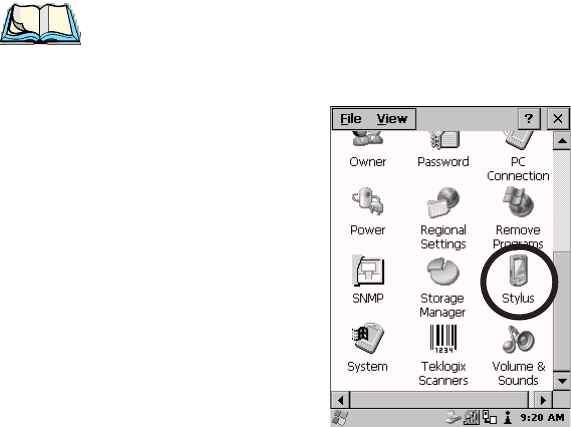
Psion Teklogix 7530 Hand-Held Computer User Manual103
Chapter 5: Configuration
Charger Details
5.5.4.4 Charger Details
• In the Power Properties dialogue box, open the Charger tab.
When the 7530 is in a Combo Dock, enabling (√) Allow Battery Calibration in this tab
allows a battery requiring recalibration to be fully discharged and recharged.
Recalibration occasionally extends the battery charge time. If you prefer that the
battery always be charged in the shortest time possible, do not check this box.
5.5.5 Stylus Properties
Note: Touchscreen calibration may not be enabled on your unit. If your screen
appears to require recalibration, contact your supervisor.
• In the Control Panel, choose the Stylus icon.
Figure 5.20 Stylus Icon

Chapter 5: Configuration
Setting Double-Tap Sensitivity
104Psion Teklogix 7530 Hand-Held Computer User Manual
5.5.5.1 Setting Double-Tap Sensitivity
• In the Double-Tap tab, follow the directions to tailor the sensitivity of the stylus
when you tap on the touchscreen.
Figure 5.21 Setting Stylus Sensitivity
5.5.5.2 Touchscreen Calibration
Touchscreens rarely require recalibration. However, if your touchscreen has never
been calibrated or if you find that the stylus pointer is not accurate when you tap on
an item, follow the directions below.
• Choose the Calibration tab and then tap on the Recalibrate button.
Figure 5.22 Calibrating The Touchscreen
• Follow the directions in the Calibration tab to recalibrate the screen.
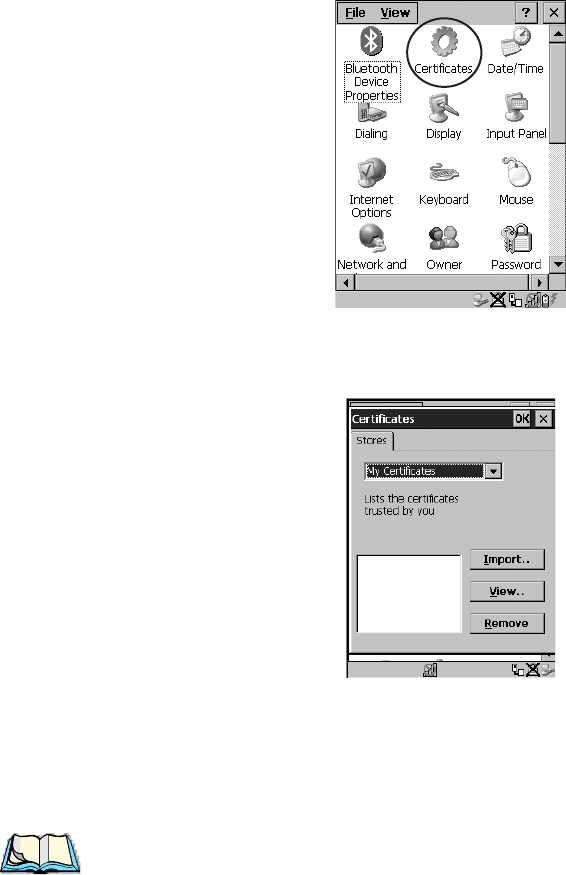
Psion Teklogix 7530 Hand-Held Computer User Manual105
Chapter 5: Configuration
Certificate Assignment
5.5.6 Certificate Assignment
• In the Control Panel, choose the Certificate icon.
The dialogue box is used in conjunction with 802.1x authentication to enhance 7530
security.
Figure 5.23 Certificates Dialogue Box
For a detailed description about Certificate setup for both the server and client-side
devices (7530s), refer to the following website:
www.microsoft.com/windows2000/techinfo/planning/walkthroughs/default.asp - "Security Services"
Note: When importing certificates, the 7530 only recognizes .cer files.
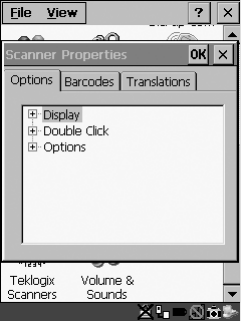
5.7 Scanner Properties Setup
The Teklogix Scanners icon in the Control Panel provides dialogue boxes in which you can
tailor bar code options and choose the bar codes your scanner will recognize.
5.7.1 Scanner Options
Figure 5.45 Bar Code Options
To display the sub-menus available in the Options tab:
• Highlight the option you want to work with, and press the right
<ARROW> key.
To change a parameter:
• Highlight the parameter and press the <RIGHT> arrow key, or press the
<SPACE> key.
If a field requires text entry, a text field is displayed in which you can type
the appropriate value.
Display Parameters
Scan Result
When this parameter is enabled (set to ‘ON’), the type of bar code and the result of
the scan appear on the screen. Note that this information is only displayed after a
successful decode and is visible only while the scanner trigger is pressed. When the
trigger is released, this information is cleared from the screen.

Psion Teklogix 7535 Hand-Held Computer User Manual 119
Chapter 5: Configuration
Scanner Options
Scan Indicator
When this parameter is enabled (set to ‘ON’), the laser warning logo appears on the
display whenever the scanner is activated.
Scan Result Time (sec)
The value assigned to the “Scan Result Time (sec)” parameter determines how long
the scan results of a successful scan are displayed on the screen. Time is measured in
seconds, and a value of “0” (zero) disables the parameter.
Note: To remove the scan result from the screen before the “Result Time” has
expired, point the scanner away from the bar code and press the trigger.
Scan Beep
This parameter determines whether or not the 7535 emits an audible scanner ‘beep’
when a scan is performed. Set this parameter to either ‘ON’ to enable the beeper or
‘OFF’ to disable it.
Scan Log File
If this parameter is enabled, the input barcode and the modified/translated output bar
code are logged in the file \Flash Disk\ScanLog.txt. Keep in mind that if the ‘Scan
Log File’ is enabled, there is a slight performance effect when performing multiple
scans since the log file is written to persistent storage.
Double Click Parameters
Click Time (msec)
This parameter controls the maximum gap time (in milliseconds) for a double-click.
If the time between the first and second clicks of the scanner trigger is within this
time, it is considered a double-click. The allowable range is 0 to 1000. A value of
zero disables this feature.
A double-click produces different results depending on whether or not a value is
assigned in the “Click Data” parameter. When a value is not assigned for the “Click
Data”, double-clicking the scanner trigger overrides the target dot delay set in the
“Dot Time” parameter and initiates a normal scan sweep. If a value is assigned for
the “Click Data” parameter, double-clicking the scanner trigger inserts the “Click
Data” value rather than initiating a scan.
Chapter 5: Configuration
Scanner Options
120Psion Teklogix 7530 Hand-Held Computer User Manual
Click Data
For both integrated and external scanners, this parameter determines which
character is sent to the application installed in your 7535 following a double-click.
A dialogue box appears, asking that you press the key you want to insert. The
ASCII/Unicode key value of the keypress is displayed.
Pressing the <ESC> key in this dialogue box resets the data to zero.
Options
Dot Time (msec)
The value selected for “Dot Time (msec)” determines (in milliseconds) how long the
targeting dot remains on before the scanner switches to a normal scan sweep. The
allowable values are: 0, 0.1, 0.5, 1.0, 1.5, 2.0, 2.5 and 3.0
seconds. A value of 0 (zero) disables the target dot.
Short Code
When enabled (set to ‘ON’), this parameter allows scanning of short I 2 of 5 bar
codes (2 characters). When disabled, these short bar codes are rejected.
Enabling “Short Code” may reduce the robustness of the decoding since the
7535 must decode more potential bar codes; it is therefore not recommended for
general-purpose bar codes with 4 or more characters.
Verify
The value entered for this parameter determines the number of correct additional
decodes required after the initial decode before a bar code is accepted. Higher
values significantly increase the time it takes to decode a bar code but also improve
the reliability of the decoded bar code.
Security
This parameter controls the tolerance for decoding edge-to-edge bar codes
(Code 93, Code 128, UPC/EAN). Lower values have a lower tolerance for misreads,
but they also increase the time it takes to decode the bar code. The default value of
30 is generally a good compromise setting.
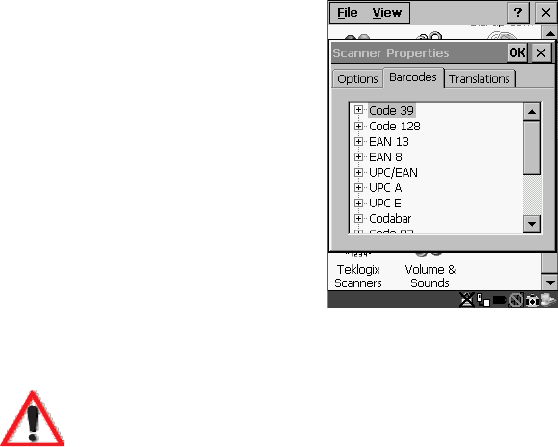
Psion Teklogix 7530 Hand-Held Computer User Manual121
Chapter 5: Configuration
Bar Codes
5.7.2 Bar Codes
Figure 5.46 Bar Code Selection
All the available bar code symbologies can be selected from this menu.
Important: To improve the decode speed and performance, enable (set to
‘ON’) only those codes that are required by the application.
Keep in mind that some bar code types are only available when an internal imaging
scanner is installed. The bar code settings do not affect the operation of internal or
external decoded scanners. These scanners must be configured by scanning special
configuration bar codes. These configuration bar codes affect the communication
speed or data format between the scanner and the 7530 and must not be changed.
The scanner manufacturer provides programming manuals for configuration
purposes.
• For Symbol, refer to “Programming Guide P300”.
• For PSC, refer to “Powerscan Programing guide (PSC)”.
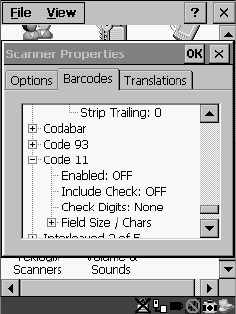
Chapter 5: Configuration
Code 39 Settings
122Psion Teklogix 7530 Hand-Held Computer User Manual
Figure 5.47 Code 39 Bar Code Settings
A ‘plus’ sign (+) to the left of the each bar code listed in this Barcodes tab indicate that
that a sub-menu of parameters is attached. To work with a sub-menu:
• Highlight the bar code you want to work with, and press the <RIGHT>
arrow key to display the sub-menu.
• Use the <UP> and <DOWN> arrow keys to highlight a parameter.
• To change a parameter value, press <SPACE> or the <RIGHT> arrow key.
If a field requires text entry, a text box is displayed in which you can enter
the appropriate value.
5.7.2.1 Code 39 Settings
Full Ascii
If this parameter is enabled (set to ‘ON’), the characters +, %, and / are used as
escape characters. The combination of an escape character and the next character
is converted to an equivalent ASCII character.
Include Check
If this parameter is enabled (set to ‘ON’), the check digit is included with the
decoded bar code data.

Psion Teklogix 7530 Hand-Held Computer User Manual123
Chapter 5: Configuration
Code 39 Settings
AIAG Strip
If this parameter is enabled (set to ‘ON’), the AIAG data identifier is removed from
each decoded Code 39 label. The data identifier occurs in the first position next to
the Code 39 start character. It can be a single alphabetic character or a series of
numeric digits followed by an alphabetic character. This identifier defines the
general category or specific use of the data contained in the rest of the bar code.
Note: If your unit is operating with the Psion Teklogix TESS application, this
parameter should not be used in conjunction with the TESS AIAG feature.
This is because the 7530 hand-held performs the strip function before it
processes the data through the AIAG feature; if the prefix is stripped, the
data is not identified as AIAG.
Error Accept
If the “Err Accept” and “AIAG Strip” parameters are enabled (set to ‘ON’), all label
data without an AIAG identifier character is accepted. If the “Err Accept” parameter
is disabled and the “AIAG Strip” parameter is enabled (set to ‘ON’), the label data is
not accepted.
Mod Checks
Mod 43 Check
If this parameter is enabled (set to ‘ON’), the Mod 43 check digit is calculated.
Mod 10 Check
If this parameter is enabled (set to ‘ON’), the Mod 10 check digit is calculated.
None
If you choose ‘None’, a check is not executed.
Field Size/Chars
Field Size
The field size is the length of the field after the first character is stripped and
the prefix and suffix characters are added. If the field size is non-zero, only
bar codes of that length are passed through.

Chapter 5: Configuration
Code 128 Settings
124Psion Teklogix 7530 Hand-Held Computer User Manual
Prefix Char
This character, if non-zero, is added before a successfully decoded bar code. Press
the key you want to insert in the dialogue box attached to this parameter. The
ASCII/Unicode key value of the keypress is displayed.
Pressing the <ESC> key in this dialogue box resets the data to zero.
Suffix Char
Note: The appended character is treated as any other keyboard character.
For example, if <BKSP> is pressed, the usual action for that key is
performed. If your unit is operating with the Psion Teklogix ANSI
emulation application, the 7530 transmits the escape sequence
associated with the function immediately after the bar code data.
This character, if non-zero, is added after a successfully decoded bar code. Press the
key you want to insert in the dialogue box attached to this parameter. The
ASCII/Unicode key value of the keypress is displayed.
Pressing the <ESC> key in this dialogue box resets the data to zero.
Strip Leading
This parameter determines the number of characters that will be removed from the
beginning of the bar code before the prefix character is added.
Note: For Code 39 bar codes, the “AIAG Strip” is performed before the
“Strip Leading”.
Strip Trailing
The value entered in this parameter determines the number of characters that will be
removed from the end of the bar code before the suffix character is added.
5.7.2.2 Code 128 Settings
Include Sym
Setting “Include Sym” to ‘ON’ causes the group separator(s) and start code
contained in this type of bar code to be displayed on the screen.
Note: This option is available only when ‘EAN/UCC 128’ is selected.

Psion Teklogix 7530 Hand-Held Computer User Manual125
Chapter 5: Configuration
EAN 13 Settings
Variations
When using Code 128, you can choose the variation or type of bar code variation the
scanner will recognize. The options available are Standard, UCC and EAN/UCC.
These options are described below.
Standard
Enable (set to ‘ON’) “Standard” if Code 128 is desired.
UCC 128
“UCC” is a variation of Code 128.
EAN/UCC 128
To successfully scan this type of bar code, “EAN/UCC” must be enabled (set to
‘ON’). “EAN/UCC” bar codes include group separators and start codes.
Field Size/Chars
Refer to the description beginning on page 123 for details.
5.7.2.3 EAN 13 Settings
Include Country
If this parameter is enabled (set to ‘ON’), the country code is included with the
decoded bar code data.
Include Check
If this parameter is enabled (set to ‘ON’), the check digit is included with the
decoded bar code data.
Addendum
Important: Before “Addendum” can take effect, the “Short Code” parameter
in the Options menu (see page 120) must be enabled (set to ‘ON’).
An addendum is a separate bar code, supplementary to the main bar code.
This parameter provides three options: Disabled, Optional and Required.
Depending on the value chosen for this parameter, an addendum is recognized
or ignored.

Chapter 5: Configuration
EAN 8
126Psion Teklogix 7530 Hand-Held Computer User Manual
When “Addendum” is set to Disabled, the scanner does not recognize an
addendum. If this parameter is set to Optional, the scanner searches for
an addendum and if one exists, appends it to the main bar code. When the
parameter is set to Required, the scanner does not accept the main bar code
without an addendum.
Prefix/Suffix
Prefix Char
This character, if non-zero, is added before a successfully decoded bar code. Press
the key you want to insert in the dialogue box attached to this parameter. The
ASCII/Unicode key value of the keypress is displayed.
Pressing the <ESC> key in this dialogue box resets the data to zero.
Suffix Char
This character, if non-zero, is added after a successfully decoded bar code. Press the
key you want to insert in the dialogue box attached to this parameter. The
ASCII/Unicode key value of the keypress is displayed.
Pressing the <ESC> key in this dialogue box resets the data to zero.
Strip Leading
This parameter determines the number of characters that will be removed from the
beginning of the bar code before the prefix character is added.
Note: The appended character is treated as any other keyboard character. For
example, if <BKSP> is pressed, the usual action for that key is per-
formed. If your 7530 is operating with the Psion Teklogix ANSI emulation
application, the hand-held transmits the escape sequence associated with
the function immediately after the bar code data.
Strip Trailing
The value entered in this parameter determines the number of characters that will be
removed from the end of the bar code before the suffix character is added.
5.7.2.4 EAN 8
Include Check
If this parameter is enabled (set to “Y”), the check digit is included with the decoded
bar code data.

Psion Teklogix 7530 Hand-Held Computer User Manual127
Chapter 5: Configuration
UPC And EAN Settings
Addendum
Important: Before “Addendum” can take effect, the “Short Code” parameter
in the Options menu (see page 120) must be enabled (set to ‘ON’).
Refer to “Addendum” on page 125.
Prefix/Suffix
See “Size/Chars” beginning on page 126.
5.7.2.5 UPC And EAN Settings
Field Size/Char
Refer to page 123 for details.
5.7.2.6 UPC A Settings
Include Number Sys
If this parameter is enabled (set to ‘ON’), the number system digit is included with
the decoded bar code data.
Include Check
If this parameter is enabled (set to ‘ON’), the check digit will be included with the
decoded bar code data.
Addendum
Important: Before “Addendum” can take effect, the “Short Code” parameter
in the Options menu (see page 120) must be enabled (set to ‘ON’).
Refer to “Addendum” on page 125.
Prefix/Suffix
Refer to page 126 for details.
5.7.2.7 UPC E Settings
Convert to UPC-A
Setting this parameter to ‘ON’ results in a non-standard decoding that returns 12
digits from the 6 digit UPC E bar code.

Chapter 5: Configuration
Codabar
128Psion Teklogix 7530 Hand-Held Computer User Manual
Include Number Sys
If this parameter is enabled (set to ‘ON’), the number system digit is included with
the decoded bar code data.
Include Check
When enabled (set to ‘ON’), the check digit is included with the decoded bar code
data.
Addendum
Important: Before “Addendum” can take effect, the “Short Code” parameter
in the Options menu (see page 120) must be enabled (set to ‘ON’).
Refer to “Addendum” on page 125.
Prefix/Suffix
Refer to page 126 for details.
5.7.2.8 Codabar
Field Size/Char
Refer to page 123 for details.
5.7.2.9 Code 93
Field Size/Char
Refer to page 123 for details.
5.7.2.10 Code 11
Include Check
If “Include Chk” is enabled (set to ‘ON’), the check digit is included with the
decoded bar code data.
Check Digit
This parameter can be set to None, One Check Digits or Two Check Digits.
If this parameter set to One Check Digits, it is assumed that the last digit is a
check digit.
If this parameter is set to Two Check Digits, it is assumed that the last two digits
are check digits.
Psion Teklogix 7530 Hand-Held Computer User Manual129
Chapter 5: Configuration
Interleaved 2 of 5
Field Size/Chars
Refer to page 123 for details.
5.7.2.11 Interleaved 2 of 5
Mod 10 Chk
If this parameter is enabled (set to ‘ON’), the Mod 10 check digit is calculated. This
calculation is the same as the Code 39 Mod 10 check digit.
ITF Chk
If this parameter is enabled (set to ‘ON’), the ITF-14/16 Mod10 check digit is
calculated.
Include Check
If this parameter is enabled (set to ‘ON’), the check digit is included with the
decoded bar code data.
Field Size/Chars
Refer to page 123 for details.
5.7.2.12 MSI Plessey
One Check Digit
If this parameter is enabled (set to ‘ON’), it is assumed that the last digit is a
check digit.
Include Check
If this parameter is enabled (set to ‘ON’), the check digit is included with the
decoded bar code data.
Field Size/Chars
Refer to page 123 for details.
5.7.2.13 Discrete 2 of 5
Mod 10 Check
If this parameter is enabled (set to ‘ON’), the Mod 10 check digit is calculated. This
calculation is the same as the Code 39 Mod 10 check digit.
Chapter 5: Configuration
IATA 2 of 5
130Psion Teklogix 7530 Hand-Held Computer User Manual
ITF Check
If this parameter is enabled (set to ‘ON’), the ITF-14/16 Mod10 check digit is
calculated.
Include Check
If this parameter is enabled (set to ‘ON’), the check digit is included with the
decoded bar code data.
Field Size/Chars
Refer to page 123 for details.
5.7.2.14 IATA 2 of 5
Mod 10 Check
If this parameter is enabled (set to ‘ON’), the Mod 10 check digit is calculated.
ITF Check
If this parameter is enabled (set to ‘ON’), the ITF-14/16 Mod10 check digit is
calculated.
Include Check
If this parameter is enabled (set to ‘ON’), the check digit is included with the
decoded bar code data.
Field Size/Chars
Refer to page 123 for details.
5.7.2.15 Postal: Australian
Size/Chars
Refer to page 123 for details.
5.7.2.16 Postal: Japanese
Size/Chars
Refer to page 123 for details.
5.7.2.17 Postal: Korean
Size/Chars
Refer to page 123 for details.
Psion Teklogix 7530 Hand-Held Computer User Manual131
Chapter 5: Configuration
Postal: PlaNET
5.7.2.18 Postal: PlaNET
Size/Chars
Refer to page 123 for details.
5.7.2.19 Postal: PostNET
Size/Chars
Refer to page 123 for details.
5.7.2.20 Postal: Royal Mail
Size/Chars
Refer to page 123 for details.
5.7.2.21 2D DataMatrix
Inverse Video
If enabled (set to ‘ON’), this parameter allows symbols that contain light cells on a
dark background to be decoded.
Rectangular Symbols
When enabled (set to ‘ON’), this parameter allows rectangular DataMatrix symbols
to be decoded.
Small Symbols
If enabled (set to ‘ON’), DataMatrix symbols of small physical size can be
successfully decoded.
Field Size/Chars
Refer to page 123 for details.
5.7.2.22 2D Maxicode
Field Size/Chars
Refer to page 123 for details.
5.7.2.23 2D PDF-417
Field Size/Chars
Refer to page 123 for details.
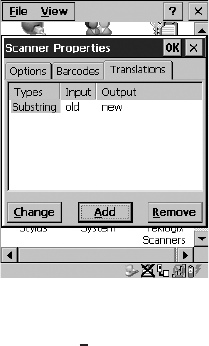
Chapter 5: Configuration
2D Micro PDF-417
132Psion Teklogix 7530 Hand-Held Computer User Manual
5.7.2.24 2D Micro PDF-417
Field Size/Chars
Refer to page 123 for details.
5.7.2.25 2D QR Code
Inverse Video
If enabled (set to ‘ON’), this parameter allows symbols that contain light cells on a
dark background to be decoded.
Field Size/Chars
Refer to page 123 for details.
5.7.2.26 2D RSS Code
Field Size/Chars
Refer to page 123 for details.
5.7.2.27 Aztec
Field Size/Chars
Refer to page 123 for details.
5.7.3 Translations
Figure 5.48 Translation Tab
• In the Translation tab, choose the Add button.
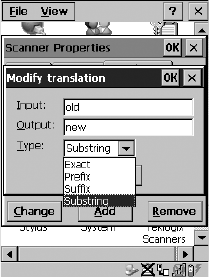
Psion Teklogix 7530 Hand-Held Computer User Manual133
Chapter 5: Configuration
Translations
Figure 5.49 Translation Dialogue Box
Input
This value is compared with the decoded bar code reading. If there is a match, the
“Output” string is translated into the decoded bar code.
Output
If there is a match between the decoded bar code and the corresponding “Input”
string, the decoded bar code will be translated into the “Output” string. This string
entry parameter can be null, or it may contain any combination of standard and
special characters (e.g., function keys, <ENTER>, etc.).
Type
The value chosen from this dropdown menu determines what is compared with the
decoded bar code reading – the beginning of decoded bar code, the end of decoded
bar code, the entire decoded bar code or anywhere within the decoded bar code
(default).
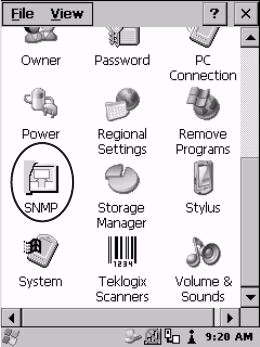
Chapter 5: Configuration
SNMP (Simple Network Management Protocol) Setup
134Psion Teklogix 7530 Hand-Held Computer User Manual
5.8 SNMP (Simple Network Management Protocol) Setup
Simple Network Management Protocol (SNMP) is the protocol used to monitor and
manage devices attached to a TCP/IP network (providing they support SNMP).
SNMP uses Management Information Bases (MIBs) that define the variables an
SNMP Network Management Station can access. Each product has a defined set of
MIBs that determine how SNMP operates, the type of access allowed and so on.
All Teklogix products support the TEKLOGIX-GENERIC-MIB – a MIB that
defines some common features across Teklogix products. All devices also support
MIB-II, a management information base that defines the common features of
TCP/IP networks. The SNMP Agent software embedded in the 7530 product
supports SNMPv1 (RFC 1157).
• In the Control Panel, choose the SNMP icon.
Figure 5.50 SNMP Icon
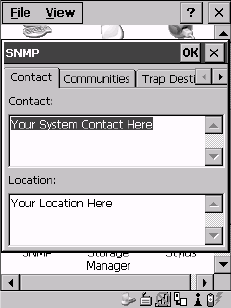
Psion Teklogix 7530 Hand-Held Computer User Manual135
Chapter 5: Configuration
Contact Tab
5.8.1 Contact Tab
The SNMP dialogue box is displayed.
Figure 5.51 Contact Tab
Contact
This field identifies the contact person for this managed node along with
information about how to get in touch with this person. The content of this
parameter is accessible through MIB-II’s sysContact object.
Location
This parameter is used to identify the physical location of this node (e.g., Warehouse
A: Pillar 32B). The content of this parameter is accessible through MIB-II’s
sysLocation object.
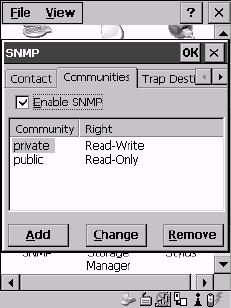
Chapter 5: Configuration
Communities Tab
136Psion Teklogix 7530 Hand-Held Computer User Manual
5.8.2 Communities Tab
Figure 5.52 Community Settings
The “Communities” tab provides a means of limiting access to SNMP managed
devices to those SNMP Managers with matching “community names”, as specified
by RFC 1157.
Enable SNMP
Enabling (√) ‘Enable SNMP’ allows the device to respond to SNMP queries and to send
Traps. After enabling this option and rebooting the device, the SNMP Agent will
automatically start up. To disable this feature, remove the check mark from the
check box.
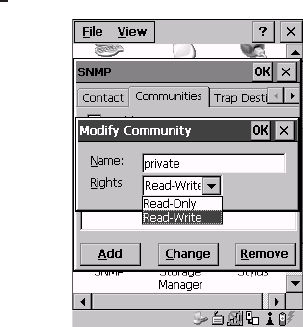
Psion Teklogix 7530 Hand-Held Computer User Manual137
Chapter 5: Configuration
Adding A Community
5.8.2.1 Adding A Community
• Choose the Add button to add a new ‘community’.
Figure 5.53 Adding A Community
Name
The value assigned here is the name assigned by the network administrator to the set
of devices to which this managed node belongs.
Rights
This menu allows you to specify access – that is, ‘Read-Only’ or Read-Write’
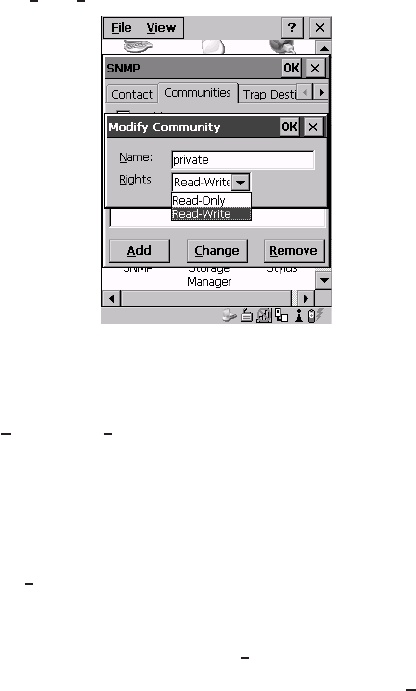
Chapter 5: Configuration
Modifying A Community Setting
138Psion Teklogix 7530 Hand-Held Computer User Manual
5.8.2.2 Modifying A Community Setting
To modify an existing community:
• Highlight the community you want to alter.
• Choose the Change button.
Figure 5.54 Changing Or Removing A Community
A Modify Community dialogue box is displayed, listing the community you highlighted.
• Edit the Name and/or Rights, and press <ENTER> to save your changes.
5.8.2.3 Removing An Existing Community
To remove an item:
• Highlight the community you want to remove in the Communities tab and then
choose the Remove button.
A Delete Confirmation screen is displayed.
• To remove a community, choose the Yes button.
• If you decide not to remove the community, choose the No button.
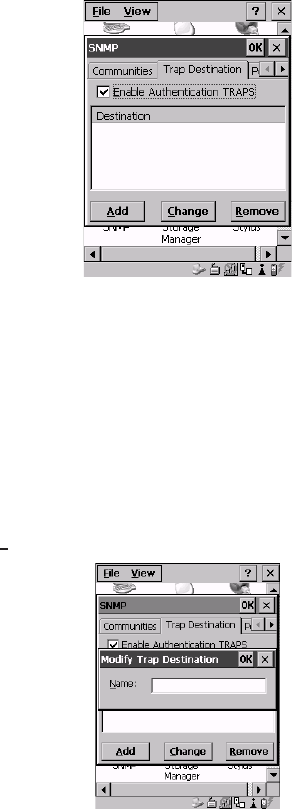
Psion Teklogix 7530 Hand-Held Computer User Manual139
Chapter 5: Configuration
Trap Destination Tab
5.8.3 Trap Destination Tab
A trap is an unsolicited report sent to SNMP Managers by the SNMP Agent running
on the managed node. This option allows you to define where the report will be sent.
Figure 5.55 Trap Destination Tab
5.8.3.1 Enabling Authentication TRAPS
Enabling (√) ‘Enable Authentication TRAPS’ allows authorization traps to be sent when a
failure is detected (e.g., an SNMP message received with a bad community name).
5.8.3.2 Adding A Destination
To add a new destination:
• Choose the Add button.
Figure 5.56 Adding A Trap Destination
• Type a destination in the text box provided, and press <ENTER>.
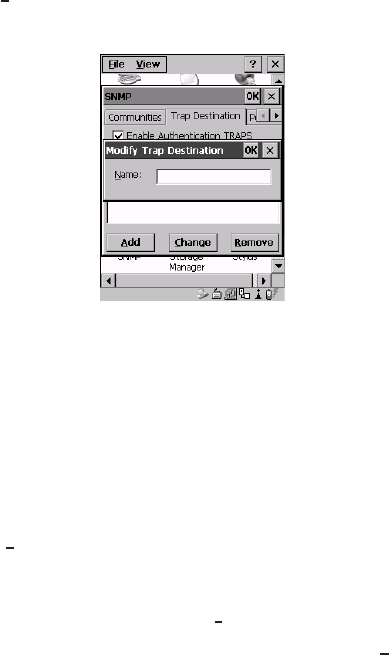
Chapter 5: Configuration
Changing A Destination
140Psion Teklogix 7530 Hand-Held Computer User Manual
5.8.3.3 Changing A Destination
To change an existing trap destination:
• Highlight the destination you want to alter in the Trap Destination tab, and then
choose the Change button.
A dialogue box like the one displayed when you add a destination is displayed.
Figure 5.57 Changing A Destination
• Make the changes to the destination, and press <ENTER> to save the
changes.
5.8.3.4 Removing A Trap Destination
To remove a trap destination:
• In the Trap Destination tab, highlight the destination you want to delete.
• Choose the Remove button.
A Delete Confirmation screen is displayed.
• To remove a destination, choose the Yes button.
• If you decide not to remove the destination, choose the No button.
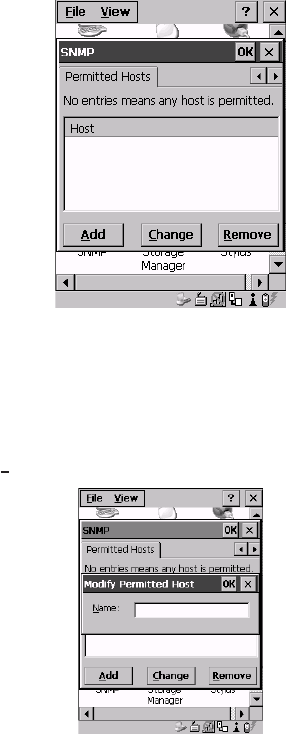
Psion Teklogix 7530 Hand-Held Computer User Manual141
Chapter 5: Configuration
Permitted Hosts Tab
5.8.4 Permitted Hosts Tab
For security reasons, the Network Administrator may want to restrict SNMP-node
access to a known sub-set of SNMP Managers. This tab lists the IP addresses of all
the SNMP Managers which are allowed to monitor and manage this device. If no
entries are listed, the device will accept SNMP queries from any host.
Figure 5.58 Permitted Hosts Tab
5.8.4.1 Adding A Host
To add a new host:
• Highlight the Add button, and press <ENTER>.
Figure 5.59 Adding A Host
• Type a new host IP address in the text box provided, and press <ENTER>.

Chapter 5: Configuration
Changing A Host
142Psion Teklogix 7530 Hand-Held Computer User Manual
5.8.4.2 Changing A Host
To change an existing host IP address:
• Highlight the IP address you want to alter in the Permitted Hosts tab, and then
choose the Change button.
A dialogue box like the one displayed when you add a host is displayed.
• Make the necessary changes, and press <ENTER>.

Psion Teklogix 7530 Hand-Held Computer User Manual143
TEKTERM APPLICATION 6
6
6.1 The Tekterm Application ...........................147
6.2 Additional Keyboard Functions .......................147
6.2.1 Function Keys And Softkeys......................147
6.2.1.1 Function Keys .........................147
6.2.1.2 Softkey Function Keys .....................148
6.2.2 Macro Keys ..............................149
6.3 Keyboard Modes ...............................150
6.3.1 View Mode ...............................150
6.3.1.1 Changing Font Sizes ......................150
6.3.1.2 Panning The Screen Contents .................150
6.3.1.3 Exiting View Mode.......................151
6.3.2 Using The Task Manager To Switch Between Applications......152
6.4 The Tekterm Status Area ...........................153
6.5 TESS Emulation ...............................154
6.5.1 Configuration..............................154
6.5.2 Working With Multiple Sessions....................154
6.5.3 The Field Types ............................154
6.5.4 IBM 5250 Emulation Keys ......................155
6.5.5 Data Entry ...............................155
6.5.5.1 TESS Edit Modes And Cursor Movement ...........156
6.5.5.2 <DEL> Key Behaviour In TESS ................157
6.5.5.3 <BKSP> Key Behaviour In TESS ...............158
6.5.6 TESS Status Message .........................159
6.5.7 Lock Messages.............................160
6.5.8 Control Commands ..........................160
6.5.9 Resetting A TESS Session .......................160
6.5.10 The Local Menu ...........................161
6.5.11 Selecting Another Host Computer ..................161
6.5.12 Queuing Mode ............................162
6.6 ANSI Emulation ...............................162
6.6.1 Configuration..............................162
6.6.2 Sending Data To The Host .......................163
6.6.3 Psion Teklogix Keyboard And VT220 Equivalent Keys........163
144Psion Teklogix 7530 Hand-Held Computer User Manual
6.6.4 Block Mode (Local Editing) ......................164
6.6.5 Working With Sessions .........................165
6.6.5.1 Establishing A New Session .................165
6.6.5.2 Listing Sessions And Moving To Other Sessions.......165
6.6.5.3 Closing A Session.......................165
6.6.5.4 Printing A Screen .......................166
6.6.5.5 Smart Echo – Disabling....................166
6.8 The Tekterm Startup Display Menu......................168
6.9 Working With Menus .............................169
6.9.1 Using The Keyboard To Navigate Through Menus ..........170
6.9.1.1 Sub-Menus ..........................170
6.9.1.2 Numeric Parameters......................170
6.9.1.3 Y/N Parameters ........................171
6.9.1.4 Alpha Parameters .......................171
6.9.1.5 String Entry Parameters....................171
6.9.2 Using The Touchscreen To Navigate Through Menus .........173
6.9.2.1 Sub-Menus ..........................173
6.9.2.2 Numeric Parameters......................174
6.9.2.3 Y/N Parameters ........................174
6.9.2.4 Alpha Parameters .......................174
6.9.2.5 String Entry Parameters....................174
6.9.3 Saving Changes To Parameters.....................175
6.9.4 Retrieving Default Parameter Values ..................175
6.10 Resetting The 7530 Hand-Held Computer .................175
6.11 The Parameters Menu ............................176
6.11.1 Security Settings............................176
6.12 Display Options ...............................177
6.13 More Parameters...............................177
6.14 Radio Parameters ..............................179
6.15 System Parameters..............................180
6.15.1 Keyboard ...............................181
6.15.1.1 Macro Control Panel.....................181
6.15.1.2 Indicators ..........................182
6.15.1.3 Softkeys ...........................182
6.15.1.4 Ctrl Panel ..........................182
6.15.2 Audio .................................183
6.15.3 Power Mgmt Ctrl Panel ........................184
6.15.4 Security ................................185
6.15.4.1 Default Mode ........................185
6.15.4.2 User Level Options .....................185
6.15.4.3 Sup. Password ........................186
6.15.4.4 Allow Teklogix........................186
Psion Teklogix 7530 Hand-Held Computer User Manual145
Chapter 6: Tekterm Application
6.16 Scanner Control Panel............................187
6.17 View Manager ................................187
6.17.1 Split Screen ..............................188
6.17.1.1 Splitting And Displaying Screens...............189
6.17.1.2 Moving Between Split Screens ................190
6.17.1.3 Toggling Between Full & Split Screens ...........190
6.17.1.4 Using The Asterisk As A Wild Card .............190
6.17.2 Custom Characters (Unicode™) ...................191
6.17.2.1 Creating A Unicode™ Character ...............191
6.17.2.2 Displaying The Unicode™ Pop-up Window .........192
6.18 Applications .................................194
6.18.1 ANSI Settings.............................195
6.18.1.1 Host Conn ...........................196
6.18.1.2 Screen .............................199
6.18.1.3 Xmit Modes ..........................202
6.18.1.4 Kbd Modes ..........................206
6.18.1.5 Edit Modes ..........................209
6.18.1.6 Serial .............................210
6.18.1.7 Host Char Set .........................210
6.18.1.8 Anchor View .........................211
6.18.2 TESS Settings.............................212
6.18.2.1 Host Conn. ..........................213
6.18.2.2 Screen .............................214
6.18.2.3 Characters ...........................216
6.18.2.4 Tests ..............................218
6.18.2.5 Features ............................219
6.18.2.6 Scanner ............................223
6.18.2.7 Fields .............................224
6.18.2.8 Anchor View .........................227
6.18.2.9 Emulation ...........................227
6.19 Ports– Tether And Console .........................235
6.19.1 Tether And Console Port Peripheral Options.............235
6.19.2 Tether And Console Port Parameter Settings .............236
6.19.3 Tether And Console Port Scan-See Parameters............239
6.19.3.1 Scan-See Sub-Menu – Mapping The Viewport ........239
6.19.3.2 Scan-See Keyboard Mapping .................244
6.20 Network ...................................244
6.20.1 Network Ctrl Panel Settings .....................245
6.20.2 802.IQ v2 ...............................245
Psion Teklogix 7530 Hand-Held Computer User Manual147
Chapter 6: Tekterm Application
The Tekterm Application
6.1 The Tekterm Application
Tekterm is a powerful emulation application ideally suited for real time data
transaction applications associated with mainframes and servers. The 7535 includes
unique features that support Tekterm – a Psion Teklogix application that has the
ability to maintain multiple simultaneous sessions with a variety of host computers.
6.2 Additional Keyboard Functions
In addition to the standard keyboard functions (see “The Keyboard” on page 35),
Tekterm supports function keys, softkeys and macro keys.
6.2.1 Function Keys And Softkeys
6.2.1.1 Function Keys
The 7535 is equipped with a series of function keys each of which is defined in the
application software. Depending on the type of keyboard your 7535 has – 58-key or
36-key – the number and location of the function keys on the keyboard varies
slightly.
58-Key Keyboard Function Keys
The 58-key keyboard is equipped with thirty function keys. Function keys <F1> to
<F6> are located across the top of the keyboard and are directly accessible – a key
combination is not required. Function keys <F7> to <F30> are colour coded in blue
print above the alpha keys and are accessed using a key combination – <BLUE>
followed by the appropriate alpha key.
To access function keys <F7> to <F30>:
• Press the <BLUE> key followed by the alpha key to which the
function key you want to use is mapped. For example:
To access function key <F7>, press <BLUE> <C>.
To access function key <F8>, press <BLUE> <D>, and so on.
36-Key Keyboard Function Keys
The 36-key keyboard is equipped with thirty function keys. Function keys <F1> to
<F4> are located across the top of the keyboard and function keys <F5> to <F10>
are located at the bottom of the keyboard.
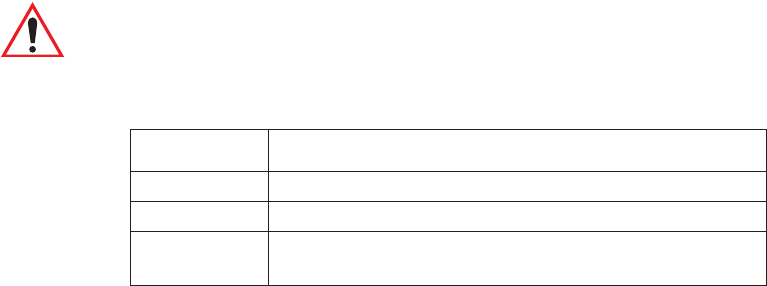
Chapter 6: Tekterm Application
Softkey Function Keys
148Psion Teklogix 7530 Hand-Held Computer User Manual
Additional function keys – <F11> to <F20> – are colour coded in orange print
above function keys <F1> to <F10>.
To access function keys <F11> to <F20>:
• Press the <ORANGE> key followed by the appropriate function key.
For example:
To access function key <F11>, press the <ORANGE> key followed
by <F1>.
To access function key <F12>, press <ORANGE> followed by <F2>,
and so on.
To access function keys <F21> to <F30>, you’ll need to press <SHIFT> <F1> to
<F10>.
To access function keys <F21> to <F30>:
• Press the <SHIFT> key followed by the appropriate function key.
For example:
To access function key <F21>, press the <SHIFT> key followed
by <F1>.
To access function key <F22>, press <SHIFT> followed by <F2>,
and so on.
6.2.1.2 Softkey Function Keys
To speed the process of moving through menus and changing parameters, function
keys <F1> to <F5> have been programmed to perform specific actions in the
Tekterm menus. Table 6.1 describes these function keys.
These softkeys can be reprogrammed to perform different functions within TESS
and ANSI applications.
Important: If your 7530 is equipped with a touchscreen, tapping the stylus on
the appropriate softkey label executes the function of the softkey
providing that the labels are visible at the bottom of the 7535
screen. See “Softkeys” on page 182 if they are not visible.
Function Key Softkey Function
<F1> NEXT – Displays the next sub-menu
<F2> PREV – Displays the previous menu.
<F3> DEFLT – Restores parameters to default settings – even after
pressing <F4> to save the changes.
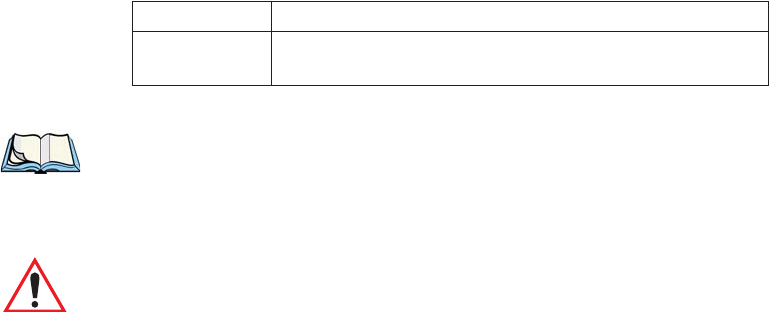
Psion Teklogix 7530 Hand-Held Computer User Manual149
Chapter 6: Tekterm Application
Macro Keys
Table 6.1 Softkeys
Note: The SAVE onscreen label only appears when a parameter value has
been changed and has not yet been saved.
6.2.2 Macro Keys
Important: Refer to “Keyboard Macro Keys” on page 95 for details about
creating macros.
7535 hand-helds are equipped with a series of macro keys that can be programmed
to replace frequently used keystrokes, along with the function of executable keys
like the <ENTER> key, the <BKSP> key, any function key and arrow key, and so
on.
58-Key Keyboard Macro Keys
7535s with 58-key keyboards have twelve macro keys – <M1> to <M12>. These
keys are colour coded in orange print above alpha keys <O> to <Z>.
To access a macro key:
• Press the <ORANGE> key followed by the appropriate alpha key from
O to Z. For example:
To access macro key <M1>, press <ORANGE> <O>.
To access macro key <M2>, press <ORANGE> <P>, and so on.
36-Key Keyboard Macro Keys
36-key keyboards are equipped with six macro keys – <M1> to <M6>. Macro keys
<M1> to <M2> are directly accessible in the bottom row of the keyboard – a key
combination is not required.
Macro keys <M3> and <M4> are colour coded in orange print above macro keys
<M1> and <M2>.
• To access <M3>, press the <ORANGE> key followed by <M1>
• To access <M4>, press <ORANGE> <M2>.
<F4> SAVE – Saves a change to a parameter value.
<F5> LITRL – Literal mode allows special characters to be
entered in a string parameter such as macro key strings.
Chapter 6: Tekterm Application
Keyboard Modes
150Psion Teklogix 7530 Hand-Held Computer User Manual
Macro keys <M5> to <M6> are colour coded in blue print above macro keys <M1>
and <M2>.
• To access <M5>, press the <BLUE> key followed by <M1>.
• To access <M6>, press <BLUE> <M2>.
6.3 Keyboard Modes
6.3.1 View Mode
Placing the 7530 keyboard in View mode allows you to choose another screen font and
to pan the contents of the screen.
To place the computer keyboard in View mode:
• Press <CTRL> <ALT> <V>.
When the hand-held is in View mode, the onscreen message –
View
– is displayed in the
status area at the bottom of the screen.
Keep in mind that this is a toggle key combination – pressing <CTRL> <ALT> <V>
a second time turns View mode off.
6.3.1.1 Changing Font Sizes
To cycle through the available fonts (with the unit in View mode):
• Press the <F> key.
Each time you press the <F> key, the font on the screen changes. Once you’ve
displayed the appropriate font:
• Press <CTRL> <ALT> <V> to exit View mode.
6.3.1.2 Panning The Screen Contents
If the content of a screen is too large to fit in the margins of the 7535 display, the
content can be panned or shifted to bring the information outside the margins into
view. Normally, the Arrow keys move the cursor around the screen in the direction
of the arrow pressed. However, if the 7535 is operating in View mode, the <LEFT>,
<RIGHT>, <UP> and <DOWN> arrow keys pan the entire content of the screen
rather than the cursor.
• Press <CTRL> <ALT> <V> to place the 7535 in View mode. An onscreen
message – View – is displayed in the status area of the screen.

Psion Teklogix 7530 Hand-Held Computer User Manual151
Chapter 6: Tekterm Application
Exiting View Mode
Panning relies on the values set in the “Use Increment”, “X Increment” and
“Y Increment” parameters to determine the number of columns (spaces) and rows
(lines) the screen contents shift.
• In the “More Parameters” menu, position the cursor on “View Manager”
and press <F1>.
• First, enable the “Use Increment” parameter – set it to “Y”.
“X Increment” determines the number of columns (spaces) the screen pans when
the <LEFT> or <RIGHT> arrow key is pressed in View mode.
“Y Increment” determines the number of rows (lines) the screen pans when the
<UP> or <DOWN> arrow key is pressed in View mode.
• Assign a value to the “X Increment” and “Y Increment” parameters.
To pan the screen contents:
• Press the <RIGHT>, <LEFT>, <UP> or <DOWN> arrow key.
Note: Pressing the <LEFT> arrow pans the screen to the right, pressing the
<RIGHT> arrow pans the screen to the left, and so on.
6.3.1.3 Exiting View Mode
To exit View mode and resume normal operation:
• Press <CTRL> <ALT> <V> again.
Note: You can press the <BLUE> key followed by the appropriate arrow key
each time you want to pan the contents one increment at a time in the
direction of the arrow key without placing the 7530 in View mode.
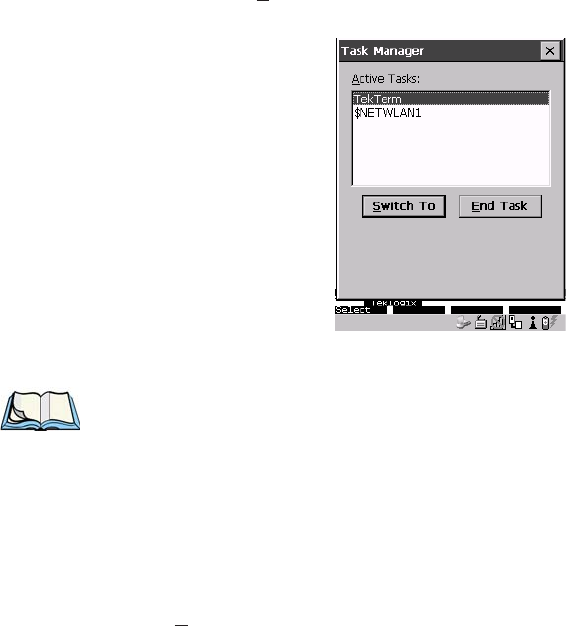
Chapter 6: Tekterm Application
Using The Task Manager To Switch Between Applications
152Psion Teklogix 7530 Hand-Held Computer User Manual
6.3.2 Using The Task Manager To Switch Between Applications
To display the Task Manager screen:
• Press <BLUE> <0> to display the Start Menu.
• Highlight Task Manager, and press <ENTER>, or
• Just type the underlined alpha character – in this case, the letter ‘t’.
Figure 6.1 Task Manager Screen
Note: A shortcut – to bypass the Start Menu and go directly to the
‘Task Manager’ screen, press <ALT> <ESC>.
To switch between applications:
• Highlight the application you want to work with, and press <ENTER>.
To end or close an application:
• Highlight the application you want to end, press <TAB> to highlight the
<End Task> button, and press <ENTER>.
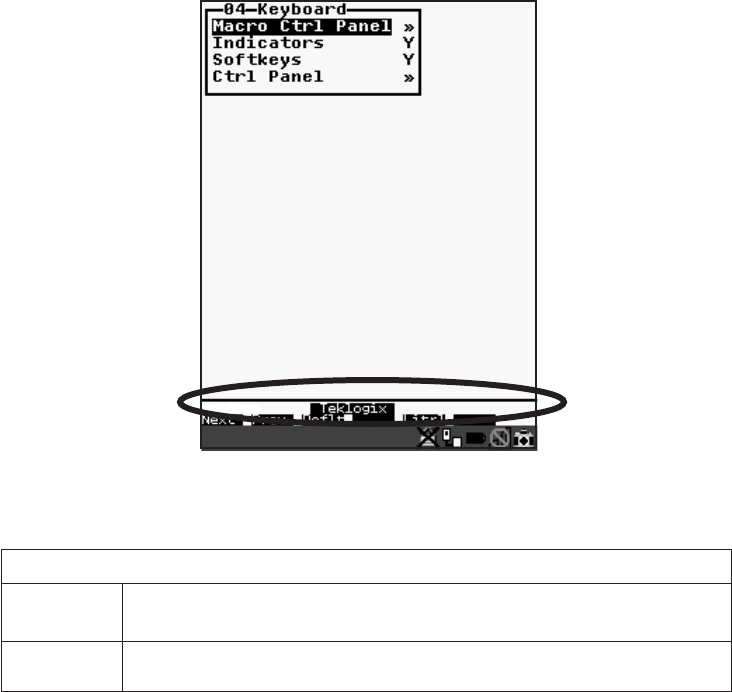
Psion Teklogix 7530 Hand-Held Computer User Manual153
Chapter 6: Tekterm Application
The Tekterm Status Area
6.4 The Tekterm Status Area
Tekterm provides a status area just above the softkey labels. The status area indi-
cates the operating condition of the hand-held.
Figure 6.2 Status Area
Table 6.2 outlines the options displayed in the status area.
Table 6.2 Status Area
Status Area Indicators
Security Level
Within Tekterm The security level assigned within the Tekterm application is displayed in the
status area. One of the following is displayed – User, Supervisor or Teklogix.
View Mode When <CTRL><ALT><V> is typed to place the 7535 in View mode, this
information is displayed in the status area.

Chapter 6: Tekterm Application
TESS Emulation
154Psion Teklogix 7530 Hand-Held Computer User Manual
6.5 TESS Emulation
TESS (Teklogix Screen Subsystem) is the normal operating mode of Psion Teklogix
computers. Teklogix protocol emulation software resident on network controllers or
a Psion Teklogix Software Development Kit (SDK) and installed in the host
converts host screens to TESS commands. The 9150 Access Point is also equipped
with protocol emulation software.
Note: If the message “RESET: Press Enter” flashes at the bottom of the TESS
screen when you turn on the 7530, press the <ENTER> key once.
6.5.1 Configuration
Note: Each TESS session must have a unique name assigned to it. The title
you assign will be displayed in the Display Menu.
The process of renaming an existing TESS session and adding a new session is
described in the section titled, “Applications” on page 194.
A unique number must be assigned in the “Terminal #” parameter for each TESS
session. Refer to “Terminal #” in the section titled “TESS Settings” on page 212
for details.
6.5.2 Working With Multiple Sessions
To display another session in TESS:
• Go to the startup ‘Display Menu’. If you are in a TESS session, press
<CTRL><ALT><0> to go to the ‘Display Menu’.
• Type the letter corresponding to the application you want to launch.
For example, suppose the sessions are listed in the “Display Menu” as
‘D TESS1’ and ‘E TESS2’. To launch the session named TESS2, type
the letter e.
6.5.3 The Field Types
Fixed Field – displays information that cannot be changed from the keyboard.
Entry Field – allows the operator to enter data. This type of field is usually shown
as: “........”
Match Field – the host computer loads data in the format of the expected entry. If
the entered data does not match the expected format, the unit emits a long beep.
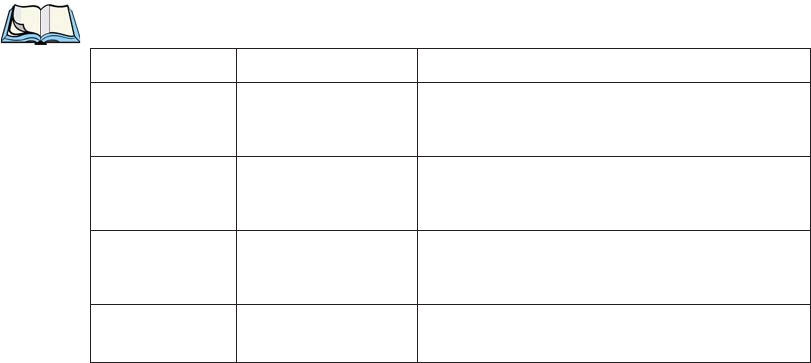
Psion Teklogix 7530 Hand-Held Computer User Manual155
Chapter 6: Tekterm Application
IBM 5250 Emulation Keys
Auto-tab Field – automatically moves the cursor to the next field when the current
field is filled.
Bar code only Field – is filled with data from a bar code reader. Keyboard entries
are not accepted in this type of field.
Serial I/O Field – is filled with data coming from a serial port. Keyboard input is
not accepted in this type of field.
6.5.4 IBM 5250 Emulation Keys
The following keys allow the Psion Teklogix computer to better emulate the
functions of a true IBM 5250 terminal.
Note: These keys are active at all times in TESS applications.
6.5.5 Data Entry
The 7535 accepts data until the operator presses a key that sends a transmission to
the host computer. The following actions cause the 7535 to transmit:
• Pressing a function key or the <ENTER> key (which is considered to be
<F0>) causes the 7530 to transmit.
• Completing data entry into a “transmit on entry” field also causes the
7535 to transmit.
Key Function Key Sequence Cursor Movement
Field Advance or
Tab <BLUE> <O>
(PgDn key)
Cursor moves to the first position in the next
input field. If already in the last field, the cursor
moves to the first input field on the screen.
Field Backspace <BLUE> <I>
(PgUp key)
Cursor moves to the beginning of the current
field. If already in the first position, the cursor
moves to beginning of the previous field.
Field Exit <BLUE> <P>
(End key)
Current field is cleared from the cursor position
to the end of the field, and the cursor moves to the
next input field.
Home <BLUE> <N>
(Home key) Cursor moves to the first input field on the screen.
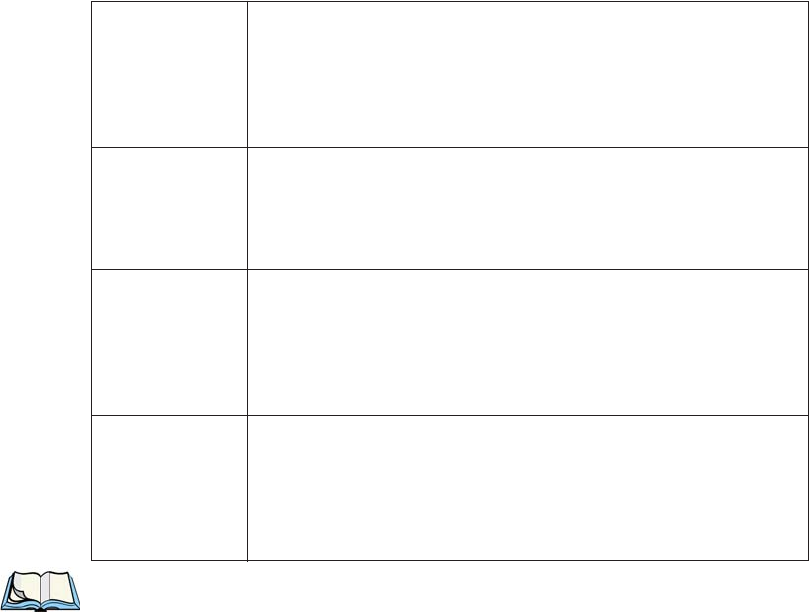
Chapter 6: Tekterm Application
TESS Edit Modes And Cursor Movement
156Psion Teklogix 7530 Hand-Held Computer User Manual
There are several ways to configure the 7530 hand-held to complete a data field:
• Pressing <ENTER> after entering data.
• Pressing a function key after entering data.
• Pressing an arrow key after entering data.
• Filling an auto-tab field.
6.5.5.1 TESS Edit Modes And Cursor Movement
The TESS editing modes and cursor movements in each type of mode are described
in the table below.
Note: When the “Enter on Arr” parameter is disabled (set to “N”), the <UP>
and <DOWN> arrow keys do not complete an entry field. Refer to
page 225 for details about this parameter.
Field mode
Press <CTRL> fto enter field mode. In this mode, once data entry
into a field has been completed, the entry cannot be changed without
retyping the entire field.
In field mode, the <RIGHT> and <LEFT> arrow keys do not perform
any functions. Pressing the <UP> or <DOWN> arrow key completes
the entry field and then, moves the cursor to the previous or next field.
Fcursor mode
Press <CTRL> uto enter fcursor mode. In this mode, once data
entry into a field has been completed, the entry cannot be changed
without retyping the entire field.
In fcursor mode, the <UP>, <DOWN>, <LEFT> and <RIGHT>
arrow keys move the cursor between fields.
Insert mode
Press <CTRL> ito enter insert mode. In this mode, data can be
entered between two characters that have been previously entered.
In insert mode, the <RIGHT> and <LEFT> arrow keys move the
cursor right and left within a field. The <UP> and <DOWN> arrow
keys complete the entry field and move the cursor to the previous or
next field.
Replace mode
Press <CTRL> rto enter replace mode. In this mode, data can be
entered over previously entered characters.
In replace mode, the <RIGHT> and <LEFT> arrow keys move the
cursor to the right and left within a field. The <UP> and <DOWN>
arrow keys complete the entry field and move the cursor to the previ-
ous or next field.

Psion Teklogix 7530 Hand-Held Computer User Manual157
Chapter 6: Tekterm Application
<DEL> Key Behaviour In TESS
6.5.5.2 <DEL> Key Behaviour In TESS
Field mode
• In a left justified field, the <DEL> key erases all characters in the
field and places the cursor in the left most position of that field.
• In a right justified field, the <DEL> key erases all characters in the
field and places the cursor in the right most position of that field.
• If the <DEL> key is used to clear data in a field that has been
pre-filled by the host application, the field is flagged as modified
and the updated information is sent to the host in the next response
message.
Replace mode
• In both left and right justified fields, the <DEL> key erases charac-
ters beginning from the current cursor position to the end of the
field. The cursor remains in the same position in the field.
• If the <DEL> key is pressed while cursor is in the right most
position in the field, the 7535 emits a keyboard error beep.
• If the <DEL> key is used to clear data in a field that has been
pre-filled by the host application, the field is flagged as modified
and the updated information is sent to the host in the next response
message.
Insert mode
• In both left and right justified fields, the <DEL> key erases the
characters from one character position to right of the cursor to
the end of the field.
• If the <DEL> key is pressed while the cursor is in the right most
position in the field, the 7535 emits a keyboard error beep.
• If the <DEL> key is used to clear data in a field that has been
pre-filled by the host application, the field is flagged as modified
and the updated information is sent to the host in the next response
message.
Fcursor mode • Refer to “Field Mode” at the beginning of this table. The <DEL>
key operates in the same manner in “Fcursor mode” as it does in
“Field mode”.

Chapter 6: Tekterm Application
<BKSP> Key Behaviour In TESS
158Psion Teklogix 7530 Hand-Held Computer User Manual
6.5.5.3 <BKSP> Key Behaviour In TESS
Field mode
• In a left justified field, the <BKSP> key erases the character directly
to the left of the cursor and then moves the cursor one position to the
left. When the last character in the field is deleted, the field displays
the value that it contained before it was modified, and the field is
opened.
• In a right justified field, the <BKSP> key erases the character on
which the cursor is positioned and shifts the remaining characters to
the right by one position. When the last character in the field is
deleted, the field displays the value that it contained before it was
modified, and the field is opened.
• If the <BKSP> key is pressed when the field is empty, the 7535 emits
a keyboard error beep.
• The <BKSP> key does not delete data pre-filled by the host applica-
tion.
• If the <BKSP> key is pressed in a field that has not been modified, the
7535 emits a keyboard error beep.
• If data is entered into a field and is then deleted before the field is
completed, the field remains unmodified when the cursor leaves the
field or when the screen is transmitted.
Replace mode
• In a left justified field, the <BKSP> key erases the character on which
the cursor is positioned unless it is one position to the right of the last
character in the string; in this case, the <BKSP> key erases the char-
acter to the left of the cursor.
• In a right justified field, the <BKSP> key erases the character on
which the cursor is positioned. The remaining characters are then
shifted to the left of the cursor, and the cursor is shifted to the right by
one position.
• If the <BKSP> key is pressed while the cursor is in the right-most
character position of the field, the cursor does not shift to the left
when that character is erased; it remains in the right most position in
the field.
• When the last character in a field is erased, the field remains empty –
that is, any pre-filled data is not displayed. Pressing the <BKSP> key
in the empty field results in a keyboard error beep.
• The <BKSP> key can delete data pre-filled by the host application.
• If data is entered in a field and is then deleted before the field is com-
pleted, the field remains unmodified when the cursor leaves the field
or when the screen is transmitted.

Psion Teklogix 7530 Hand-Held Computer User Manual159
Chapter 6: Tekterm Application
TESS Status Message
6.5.6 TESS Status Message
• Press <CTRL> <S> to continuously display the status message in the
lower left corner of the screen.
• Press <CTRL> <W> to make this message appear only when the 7535
locks. The message should look similar to the sample below:
V6.0 fld 0.6
“V6.0” is the TESS version number. “fld” indicates that TESS is currently in field
mode. Insert and replace mode are represented as “ins” and “rep” respectively. The
number “0.6” indicates the response time of the last transmission in seconds. Press
<CTRL> <T> to display the unit number instead of the TESS version number.
Insert mode
• In a left justified field, the <BKSP> function erases the character on
which the cursor is positioned, unless it is at the right end of the char-
acter string; in this case, it erases the character to the left of the cursor.
When the last character in a field is erased, the field remains empty,
and any further <BKSP> functions in the empty field result in a key-
board error beep.
• In a right justified field, the <BKSP> function erases the character
that is to the right of the cursor and then shifts the data remaining to
the right one position.
• If the <BKSP> key is pressed while the cursor is in the right-most
character position of that field, the cursor does not shift to the left
when that character is erased; it remains in the right-most position
in the field.
• When the last character in a field is erased, the field remains empty –
i.e. any pre-filled data is not displayed. Pressing the BKSP key in the
empty field sounds a keyboard error beep.
• The <BKSP> key can delete data pre-filled by the host application.
• If data is entered into a field and then deleted before the field is com-
pleted, the field remains unmodified when the cursor leaves the field
or when the screen is transmitted.
Fcursor mode • Refer to “Field Mode” at the beginning of this table. The <BKSP>
key operates in exactly the same manner in “Fcursor mode” as it does
in “Field mode”.
Chapter 6: Tekterm Application
Lock Messages
160Psion Teklogix 7530 Hand-Held Computer User Manual
6.5.7 Lock Messages
When information is transmitted to the host computer, the keyboard locks to
prevent further data entry until the 7535 receives a reply. A locked state is
indicated by either “LOCK-B” (base) or “LOCK-H” (host) in the lower left
corner of the display.
When the reply is received by the 7535, the lock message disappears and the
keyboard can be used again.
6.5.8 Control Commands
A group of <CTRL> key commands can be used within TESS to dictate how the
7535 will operate under a variety of conditions.
• <CTRL> <P> – Reprints the last print page sent from the host. This key
combination will not print anything if a print page from the host was not
previously received at the 7535 hand-held.
• <CTRL> <S> – Displays the 7535 status continuously. Below is a sample
status line as it might appear at the bottom of your screen:
Lock-B/Lock-H fld enh “
application name
”
• <CTRL> <W> – Displays the 7535 status when the unit is in “Lock B” or
“Lock H” mode. The status line would be similar to the sample above.
• <CTRL><T> – Displays the 7535 status with the terminal number instead
of the name.
Lock-B/Lock-H rep “
terminal
nn
”
• <CTRL> <H> – Displays a menu of available hosts.
6.5.9 Resetting A TESS Session
Resetting a TESS session requires that <CTRL> C be pressed three times within a
two second period to generate the “RESET – User request” message.
• Press and hold down the <CTRL> key, and press the <C> key three times
within a two second period.
• Press <ENTER>.
This procedure restarts the TESS session without affecting the rest of the 7535.
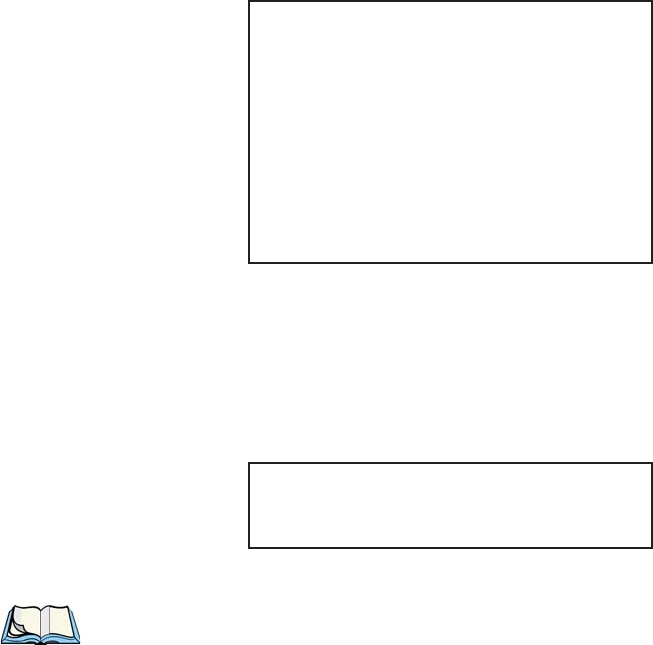
Psion Teklogix 7535 Hand-Held Computer User Manual 161
Chapter 6: Tekterm Application
The Local Menu
6.5.10 The Local Menu
The host can store local procedures in the 7530 for use when the unit is off-line.
A menu of these procedures appears whenever <CTRL> <L> is pressed
(see Figure 6.3).
• Press the function key corresponding to the procedure you want to perform.
Local procedures will not function when the “Lcl Process” and “Queuing”
parameters are disabled (see “Lcl Process – Save on Reset” on page 219
and “Queuing” on page 219).
Although using local procedures eliminates the advantages of an on-line 7530,
it allows work to continue when the host is unavailable. The “LOCK-B/H”
messages are replaced with “NEXT-B/H” in this mode.
Figure 6.3 Local Menu
6.5.11 Selecting Another Host Computer
• Press <CTRL> <H> or <F9> from the local menu to display a menu of
available hosts.
This menu appears only when more than one host is available.
Figure 6.4 Select Host Screen
Note: This feature will not function when the “Lcl Process” and “Queuing”
parameters are disabled (see “Lcl Process – Save on Reset” on page 219
and “Queuing” on page 219).
LOCAL MENU
F1 -
F2 -
F3 -
F4 -
F5 -
F6 -
F7 -
F8 -
F9 - Select Host
Select Host: ......
F1 - Host 1 F2 - Host 2
Chapter 6: Tekterm Application
Queuing Mode
162Psion Teklogix 7530 Hand-Held Computer User Manual
6.5.12 Queuing Mode
In some applications, queuing mode can decrease the computer lock time. In queuing
mode, the host computer may send several pages to a 7530 without waiting for
a response. These pages are stored in a queue within the 7530 hand-held. The
operator completes the entries on the first page and then, presses a function key.
The 7530 simultaneously transmits to the host and displays the next page in the
queue. The computer does not lock, allowing the operator to enter data on the next
page immediately. This continues as long as there are pages in the queue.
Queuing mode is used for repetitive tasks, and the queued screens look identical.
The 7530 displays a “Next” message indicating that a new page is on the display.
“Next” messages also contain information about radio communications: “NEXT-B”
indicates that the 7535 has data to transmit to the base station. “NEXT-H”
indicates that the base station has acknowledged a transmission. Unlike lock
messages, “Next” messages do not lock the keyboard. Keying is allowed while
“Next” messages are displayed.
While queuing mode may improve apparent response time, it can present difficulties
to hosts that are operating in real time. It should only be used after careful
consideration of the host environment. The 7530 must be configured for queuing
mode (see the “Queuing” parameter on page 219). Additional information on
queuing can be found in the TESS (Teklogix Screen Subsystem) Manual.
6.6 ANSI Emulation
The Psion Teklogix 7530 in ANSI mode operates like most other ANSI terminals.
This means software that supports ANSI terminals requires little or no changes.
6.6.1 Configuration
To configure the 7530 for ANSI mode, the “Name” and “Type” of session – in this
case, ANSI – must be specified in the Applications menu. This menu is described in
the section titled, “Applications” on page 194.
Next, a unique number must be assigned using the “Terminal #” parameter. This
number should be unique across the entire system – that is, each 7530 and each
application session in each 7530 across your system must have a unique number
assigned. This parameter is described in the section titled “ANSI Settings” on
page 195.
Once the 7530 is configured, an ANSI operation can be selected from the startup
“Display Menu”.
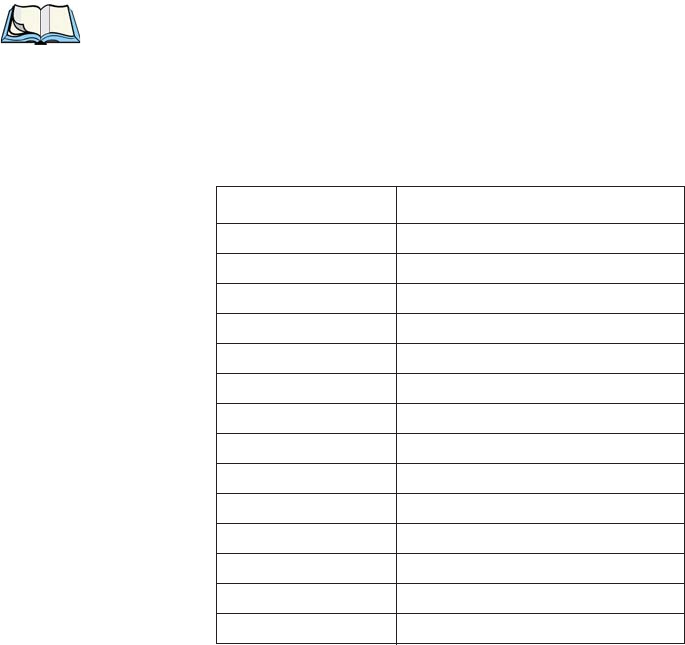
Psion Teklogix 7530 Hand-Held Computer User Manual163
Chapter 6: Tekterm Application
Sending Data To The Host
6.6.2 Sending Data To The Host
7530 hand-helds running ANSI sessions transmit characters to the host as soon as
they are typed. The 7530 provides parameters that determine when the computer
transmits characters to the host.
The 7530 can be configured to transmit after a number of characters are typed
in (the “Xmit Count” parameter) or after some time has elapsed (the “Xmit Wait”
parameter), or both. This reduces overhead on the radio link and improves response
time. See page 202 for more information about these parameters.
You can also determine whether the 7530 transmits immediately after the
<ENTER> key, an arrow key, or a function key is pressed.
The 7530 computer also responds immediately to the device attribute requests
“CSIc”, “CSI0c” and “ESCZ”.
Note: For a more detailed description of the parameter settings for ANSI,
refer to “ANSI Settings” on page 195.
6.6.3 Psion Teklogix Keyboard And VT220 Equivalent Keys
The Psion Teklogix keyboard differs from most ANSI terminals. Table 6.3 maps the
equivalent VT220 keys.
Psion Teklogix Key Equivalent VT220 Key
<UP> arrow Up arrow
<DOWN> arrow Down arrow
<RIGHT> arrow Right arrow
<LEFT> arrow Left arrow
<F1>-<F4> PF1-PF4
<F5> None
<F6>-<F10> F6-F10
<F11> F11 (ESC)
<F12> F12 (BS)
<F13> F13 (LF)
<F14> F14
<F15> Help
<F16> Do
<F17>-<F20> F17-F20
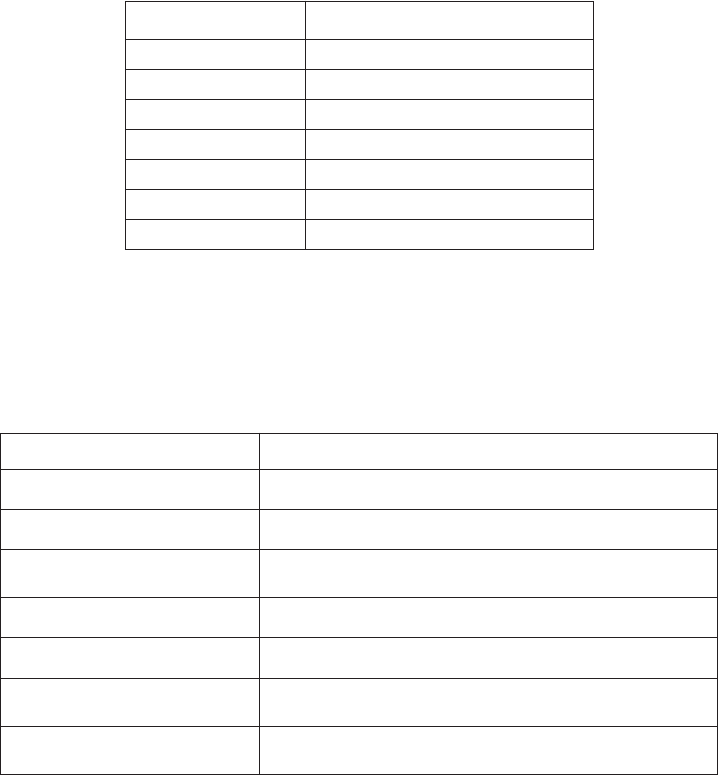
Chapter 6: Tekterm Application
Block Mode (Local Editing)
164Psion Teklogix 7530 Hand-Held Computer User Manual
Table 6.3 Psion Teklogix Keyboard And VT220 Equivalent Keys
6.6.4 Block Mode (Local Editing)
The Psion Teklogix 7530s support “block mode” (or Local Editing). Application
programs must be specifically written to support this mode. For software that
supports this mode, the keys shown in Table 6.4 have special meaning.
Table 6.4 Function Of Keys In Block Mode
<F21> Find
<F22> Insert Here
<F23> Remove
<F24> Select
<F25> Previous Screen
<F26> Next Screen
<F27>-<F36> None
Key Function
<ENTER> Starts transmission of data.
Function keys Start transmission of data.
Arrow keys Move cursor to the next unprotected position in the
appropriate direction.
<SHIFT> <RIGHT> arrow Moves the cursor to the next unprotected area.
<SHIFT> <LEFT> arrow Moves the cursor to the previous unprotected area.
<DEL> Deletes the character to the left of the cursor, and moves
cursor one position to the left.
<CLR> Erases the data in an area and moves the cursor to the
first position in the area.
Psion Teklogix Key Equivalent VT220 Key

Psion Teklogix 7530 Hand-Held Computer User Manual165
Chapter 6: Tekterm Application
Working With Sessions
6.6.5 Working With Sessions
Important: Use only lowercase letters when entering commands
at the “TCP >” prompt.
6.6.5.1 Establishing A New Session
• Press <CTRL>, and type a lowercase a.
At the TCP> prompt:
• Type tel in lowercase letters followed by the Host Name or IP address.
• Press <ENTER>.
• Log in as usual to begin working with the new session.
6.6.5.2 Listing Sessions And Moving To Other Sessions
To list the current sessions:
• Press <CTRL>, and type a lowercase a.
At the TCP> prompt:
• Type sess in lowercase letters, and press <ENTER>.
To move to another session:
• At the TCP> prompt, type sess in lowercase letters followed by the session
number to which you want to move.
e.g., Type sess 2 to move to session 2.
• Press <ENTER>.
6.6.5.3 Closing A Session
To close a session:
• Press <CTRL>, and type a lowercase a.
• At the TCP> prompt, type cl in lowercase letters followed by the session
number you want to close.
e.g., Type cl 2 to close session 2.
• Press <ENTER>.

Chapter 6: Tekterm Application
Printing A Screen
166Psion Teklogix 7530 Hand-Held Computer User Manual
6.6.5.4 Printing A Screen
To print each line of a screen with a CR/LF between each line:
• Press <CTRL>, and type p.
The screen will be printed using the port configured as “Print”.
6.6.5.5 Smart Echo – Disabling
In some circumstances – like entering a password – you many want to temporarily
disable “smart echo”, disguising the characters you type with ‘.’ (periods).
• Press <CTRL> <ALT> <P>, and type a ‘.’ (period).
• Type the necessary information using the keyboard, and then press
<ENTER> to return to “smart echo mode.
6.7 The Radio Statistics Screen
A radio statistics screen is automatically created when the Open Tekterm application
is launched.
To access the radios statistics screen, you’ll need to use the ‘Applications’ menu to
assign a radio title:
• In the ‘More Parameters’ menu, choose ‘Applications’.
• In the ‘Type’ field, choose RadioStats.
• In the ‘Title’ field, type a name for the radio screen – e.g., Radio.
• Press <F4> to save your changes, and then reset the 7535 – press and hold
down the <BLUE> and <ENTER> keys for a minimum of 6 seconds.
• In the ‘Display’ menu, type the letter corresponding to the radio statistics
screen. For example, in the sample screen below, you’d type d to display the
radio statistics screen.
A Parameters
B TESS
C ANSI
D Radio
01 Display Menu

Psion Teklogix 7530 Hand-Held Computer User Manual167
Chapter 6: Tekterm Application
The Radio Statistics Screen
802.IQ Stats Screen
• AP/Controller mac MAC address of the Teklogix access point/controller
with which this 7535 is currently associated.
• Terminal MAC MAC address of the 7535 hand-held computer.
• bootnum e.g., C33B – the boot number of the network controller.
This number increments each time the controller reboots
so that 7535s can detect the reboot when they reinitialize.
• rm number of unique received messages.
• xm number of unique transmitted messages.
• rb number of received beacons. This number should contin-
uously increment.
• xi number of initializations with the network controller.
• ra number of received acknowledgements. (Normally, this
number should match the value in xm.)
• xa number of transmitted acknowledgements. (Normally,
this number should match the value in rm.)
• bt beacon timeouts. Number of times the beacon has not
been received as expected.
AP/Controller MAC 00:00:00:00
Terminal MAC 00:00:00:00:00:00
bootnum: C33B
rm 12 xm 7
rb 50 xi 1
ra 7 xa 12
bt 0 xr 1
rt (avg/lst) 10000: 0
fr:00 ar:00
fh:00 ah:00
ca:0 tn:0 sts:0
typ:0 msk:0 Q:0
AcQ:1 TxQ:1
-----Address Info-------------
Radio Address 0
End of statistics.
802.IQ Stats
Chapter 6: Tekterm Application
The Tekterm Startup Display Menu
168Psion Teklogix 7530 Hand-Held Computer User Manual
• xr number of retransmissions. This number should remain
low if radio coverage is adequate.
• rt average round trip time. This number represents the milli-
seconds taken to send a message and receive a response
from the base station.
Cellular Protocol message numbers:
• fr forward remote number (hex).
• ar acknowledged remote number (hex).
• fh forward host number (hex).
• ah acknowledged host number (hex).
• ca radio address. This is the Cellular Address, including
session number (hex).
• tn host terminal number of session (decimal).
• sts session status (hex).
• typ data stream type (hex).
• msk message mask (hex).
• Q memory address of first message in receive queue (i.e. if 0
then the receive queue is empty).
• AcQ number of messages that have been sent but not yet
acknowledged by the Cellular Master (decimal).
• TxQ number of messages waiting to be sent (decimal).
6.8 The Tekterm Startup Display Menu
The values assigned to Tekterm parameters can be viewed and adjusted to optimize
communication at the site in which a 7530 is operating. While some parameters are
accessible through the “Parameter Manager”, others can be adjusted through the
Windows CE Control Panel. This section provides a description of all parameters and
how to adjust them.
• Press <CTRL> <ALT> <0> (zero) to work with the ‘Display’ menu.

Psion Teklogix 7530 Hand-Held Computer User Manual169
Chapter 6: Tekterm Application
Working With Menus
From this startup menu, you can launch the “Parameters” menu along with TESS
and/or ANSI sessions. You can also display the Radio Statistics screen.
Note: Aside from the ‘Parameters’ menu, all other applications listed in the
‘Display Menu’ are created in the ‘Applications’ menu. Refer to “Appli-
cations” on page 194 for details.
To launch an application, either type the letter to the left of the application you want
to use, or tap the stylus on the item.
For example, to display the “Parameters” menu:
• Type the letter a, or
• Tap the stylus on the “Parameters” item.
Note: To return to the ‘Display Menu’, press <F2> – the ‘Previous’ key.
6.9 Working With Menus
The 7535 offers two ways to navigate menus and choose values – you can either use
the keyboard or, if your unit is equipped with a touchscreen, you can select items
by tapping a stylus on the screen.
There are four types of parameters: numeric, Y/N, alpha and string entry. Some
menus have sub-menus attached to them and others utilize a Control Panel dialogue box
to make adjustments.
Important: Depending on the method you use when working with menus,
review either “Using The Keyboard To Navigate Through
Menus” on page 170 or “Using The Touchscreen To Navigate
Through Menus” on page 173.
A Parameters
B TESS
C ANSI
01 Display Menu
Chapter 6: Tekterm Application
Using The Keyboard To Navigate Through Menus
170Psion Teklogix 7530 Hand-Held Computer User Manual
6.9.1 Using The Keyboard To Navigate Through Menus
• Press the <UP> and <DOWN> arrow keys to move the cursor up and down
the current menu.
The currently selected parameter name will be displayed in reverse video.
6.9.1.1 Sub-Menus
The “»” character appearing to the right of the menu item indicates that it has
a sub-menu.
Displaying Sub-Menus
To display a sub-menu:
• Use the <UP> and <DOWN> arrow keys to position the cursor on the
menu item with the sub-menu you want to display.
• Press <F1> – the “NEXT” menu function key.
Returning To The Previous Menu
• Press <F2> – the “PREV” function key, or
• Press <ESC>.
6.9.1.2 Numeric Parameters
Numeric parameters are displayed in reverse video. To increment or decrement
a number:
• Press the <RIGHT> or <LEFT> arrow keys, or
• Type the desired number in the field. Negative values are entered by typing
a “-” (minus) sign and then the number.
• Press <ENTER>.
Each numeric parameter has a preset range of numbers assigned to it – for example,
a preset range of 1 through 10. If you attempt to enter a number which either
exceeds 10 or falls below 1, the incorrect value will be rejected – the original value
for this parameter, if any, will be displayed.

Psion Teklogix 7530 Hand-Held Computer User Manual171
Chapter 6: Tekterm Application
Y/N Parameters
6.9.1.3 Y/N Parameters
Y/N parameters can only be enabled (Y) or disabled (N). To enable or disable
a Y/N parameter:
• Press the <RIGHT> or <LEFT> arrow key once, or
• Type y to enable or n to disable the parameter.
Some Y/N parameters have sub-menus. For these parameters, a double right
arrow (») appears next to the “Y” or “N”.
6.9.1.4 Alpha Parameters
Alpha characters appear in reverse video in this type of parameter. The allowable
values for alpha parameters consist of a predetermined set of acceptable letters or
words. To cycle through the set:
• Press the <RIGHT> or <LEFT> arrow keys.
6.9.1.5 String Entry Parameters
Important: For detailed information about using string entry fields to
program macro keys, refer to “Macro Control Panel” on
page 181.
A sequence or string of characters can be entered in this type of parameter. When a
string entry parameter contains data, it is displayed in reverse video. (Empty fields
are not displayed in reverse video.) The methods that can be used to enter
information in string entry parameters are described in this section.
In string entry parameters, the <UP> arrow, <DOWN> arrow, <ENTER> and
<BKSP> keys have the following functions:
• The <UP> and <DOWN> arrow keys move the cursor between entry fields
in the direction of the arrow.
• <ENTER> completes the entry field.
• <BKSP> deletes the character to the left of the cursor.
• <DEL> (key combination <BLUE> <BKSP>) clears the entire field.

Chapter 6: Tekterm Application
String Entry Parameters
172Psion Teklogix 7530 Hand-Held Computer User Manual
Choosing An ASCII Character With The Arrow Keys
Important: Make sure the <CTRL> and <SHIFT> keys are turned off!
By pressing either the <RIGHT> or <LEFT> arrow key, you can cycle through
a set of printable characters not directly accessible from the keyboard.
• Press the <RIGHT> arrow to display the next character in this sequence,
and the <LEFT> arrow to display the previous one.
Adding Additional ASCII Characters
When you’ve chosen an ASCII character and want to add another one in the same
field, the cursor must be moved to the right of the existing character. Normally,
pressing the <RIGHT> arrow key moves the cursor to the right, but in a string entry
field, pressing the <RIGHT> arrow key cycles through the available ASCII
characters instead. If you’ve already chosen an ASCII character and want to
add another one in the field, you need to take a few extra steps to move the cursor
to the right.
To add another ASCII character in the string entry field, next to the one you’ve
already chosen:
• Type a numeric character – for example, type the number 7.
• Next, press the <BKSP> key.
The cursor is now positioned to the right of the previously selected ASCII character.
• Press the <RIGHT> or <LEFT> arrow key to scroll through the ASCII
characters, and select another character.
Entering Information In A String Entry Field
In addition to using the fixed set of ASCII values assigned to this type of parameter,
you can also type text in a string entry field.
• Type the required text in the string entry field – including letters, numbers
and symbols.
• Press <ENTER> to save the text.

Psion Teklogix 7530 Hand-Held Computer User Manual173
Chapter 6: Tekterm Application
Using The Touchscreen To Navigate Through Menus
Entering Unicode Values
Unicode is a trademark of The Unicode Consortium. To enter a Unicode™ value for
one-time use:
• Press and hold down the <ALT> key while typing a four digit decimal value
that represents the Unicode™ character you want to display.
• Release the <ALT> key.
Important: If you have a set of Unicode™ values that you use frequently, you
may want to create and save them in a pop-up window so that you
can access them whenever necessary. Refer to “Custom Charac-
ters (Unicode™)” on page 191 for details.
6.9.2 Using The Touchscreen To Navigate Through Menus
6.9.2.1 Sub-Menus
The “»” character appearing to the right of the menu item indicates that it has
a sub-menu.
Displaying Sub-Menus
To display a sub-menu:
• Tap the stylus on the menu item with the sub-menu you want
to display.
Returning To The Previous Menu
• If the softkey labels are visible at the bottom of the screen, tap the stylus on
the “PREV” (previous) softkey label.
• If the softkey labels are not visible, you’ll have to press <F2> – the “PREV”
function key.
Chapter 6: Tekterm Application
Numeric Parameters
174Psion Teklogix 7530 Hand-Held Computer User Manual
6.9.2.2 Numeric Parameters
Numeric parameters are displayed in reverse video.
•To decrease the numeric value, tap the stylus on the left side of the number.
•To increase the numeric value, tap the stylus on the right side of the
number.
Each numeric parameter has a preset range of numbers assigned to it – for example,
a preset range of 1 through 10. If you attempt to enter a number which either
exceeds 10 or falls below 1, the incorrect value will be rejected – the original value
for this parameter, if any, will be displayed.
6.9.2.3 Y/N Parameters
Y/N parameters can only be enabled (Y) or disabled (N). To enable or disable
a Y/N parameter:
• Tap the stylus on the Y/N value – the value will toggle between “Y”
and “N”.
Some Y/N parameters have sub-menus. For these parameters, a double right
arrow (») appears next to the “Y” or “N”.
• Tap the stylus on the sub-menu arrow (») to display the sub-menu.
6.9.2.4 Alpha Parameters
Alpha characters appear in reverse video in this type of parameter. The allowable
values for this type of parameter consist of a predetermined set of acceptable letters
or words. To cycle through the set:
• Tap the stylus on the alpha field to cycle through the options.
6.9.2.5 String Entry Parameters
You’ll need to use the keyboard to enter values in string entry fields. Refer to “String
Entry Parameters” on page 171 for details.

Psion Teklogix 7530 Hand-Held Computer User Manual175
Chapter 6: Tekterm Application
Saving Changes To Parameters
6.9.3 Saving Changes To Parameters
Whenever a parameter value is altered, the new value must be saved. To do this:
• Press <F4> – the “SAVE” key.
If you are using a touchscreen:
• Tap the stylus on the “SAVE” softkey label.
• If the softkey labels are not visible, you’ll have to press <F4> – the “SAVE”
function key.
If a parameter value is changed and the menu exited before the change is saved, a
dialogue box appears asking whether or not the operator wants to save the changes.
6.9.4 Retrieving Default Parameter Values
Important: When <F3> – the DEFAULT key – is pressed, all parameter
values revert to the factory defaults, including those values that
you’ve changed and saved.
• Press <F3> – the “DEFAULT” function key, or tap the stylus on the
“DEFAULT” softkey label – to reinstate the default parameter values.
• Press <F4> – the “SAVE” function key, or tap the stylus on the “SAVE”
softkey label – to save the changes.
• Reset the 7535. See "Resetting The 7535 Hand-Held Computer" in the next
section.
6.10 Resetting The 7530 Hand-Held Computer
Some parameter adjustments require that the 7530 be reset before the changes can
take effect. To reset the 7530:
• Press and hold down the <BLUE> key and the <ENTER/ON> key simulta-
neously for a minimum of six seconds.
A reset results in a complete reboot of the unit. All RAM memory contents are lost.
The contents of the flash memory and memory card are preserved. When the 7530 is
reset, the screen displays the Psion Teklogix and Microsoft® Windows® CE.net
splash screen before displaying the startup desktop.
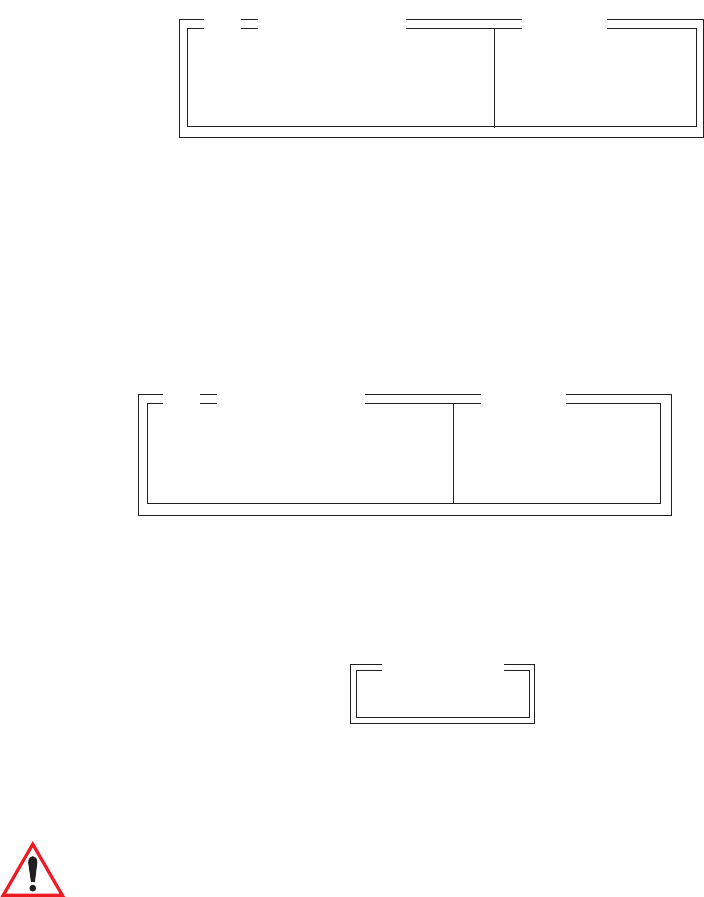
Chapter 6: Tekterm Application
The Parameters Menu
176Psion Teklogix 7530 Hand-Held Computer User Manual
6.11 The Parameters Menu
• At the ‘Display’ menu, type a to display the Parameters menu.
The “Parameters” menu allows you to adjust the screen contrast and select a security
level. With a Supervisory or Teklogix password, you can also access the parameters
listed in the “More Parameters” sub-menu.
6.11.1 Security Settings
To access the “More Parameters” sub-menus, the “Security” parameter must be set
to either a Supervisor or a Teklogix level password. The default security level is
User.
• Position the cursor on “Security”, and press the <RIGHT> arrow key to
display the Supervisor option.
• Press <ENTER>.
A Password screen is displayed.
• Type the supervisory level password – it is set at the factory to 123456.
• Press <ENTER>.
Changing A Password
Important: “Sup. Password” on page 186 describes how to change a supervi-
sory level password and how to change “User” options.
More Parameters » see page 177
Security User see page 176
Display » see page 177
01 Parameters Range
More Parameters » see page 177
Security User see text
Display » see text
01 Parameters Range
. . . . . .
Password
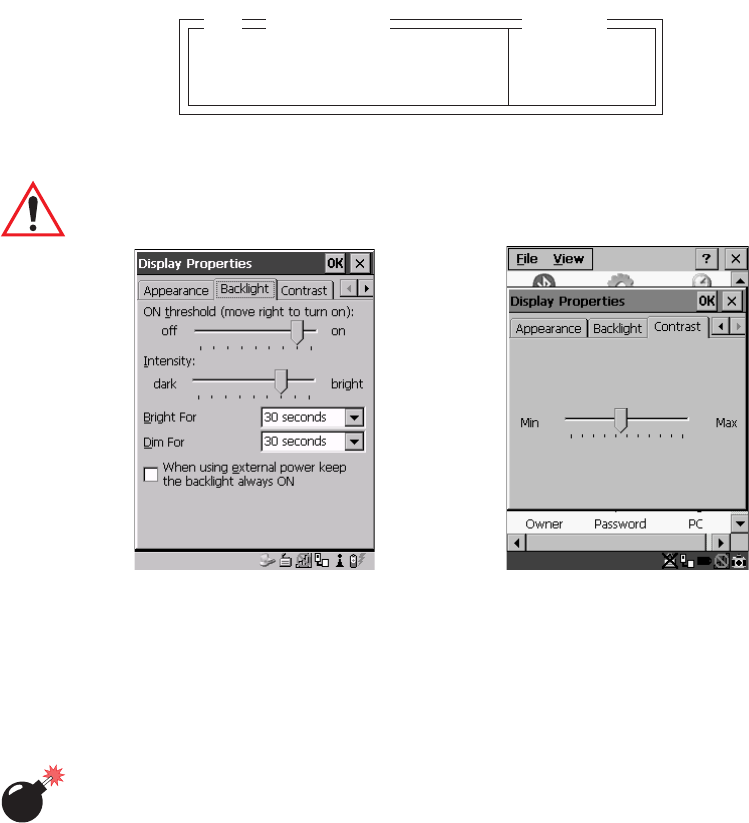
Psion Teklogix 7530 Hand-Held Computer User Manual177
Chapter 6: Tekterm Application
Display Options
6.12 Display Options
The ‘Display’ sub-menu is used to adjust your unit’s display properties.
• Press <F1> to access the ‘Display’ sub-menu.
The Display Properties dialogue box is displayed where you can adjust the appearance,
backlight and contrast of your 7530 display.
Important: ‘Display Properties’ dialogue box options are described in detail
beginning on page 88.
Figure 6.5 Display Properties
6.13 More Parameters
The “More Parameters” sub-menus contain the Tekterm parameters and can only be
accessed with the proper security password – either a Supervisory or a Teklogix
password. (Refer to “Security Settings” on page 176 for details.)
Warning: Parameters should not be altered without a clear understanding of
how they operate. Parameters that are incorrectly set can increase
response time or cause communication difficulties. Generally,
parameters are configured for each site during installation.
Backlight Ctrl Panel » see text
Contrast Ctrl Panel » see text
02 Range
Display
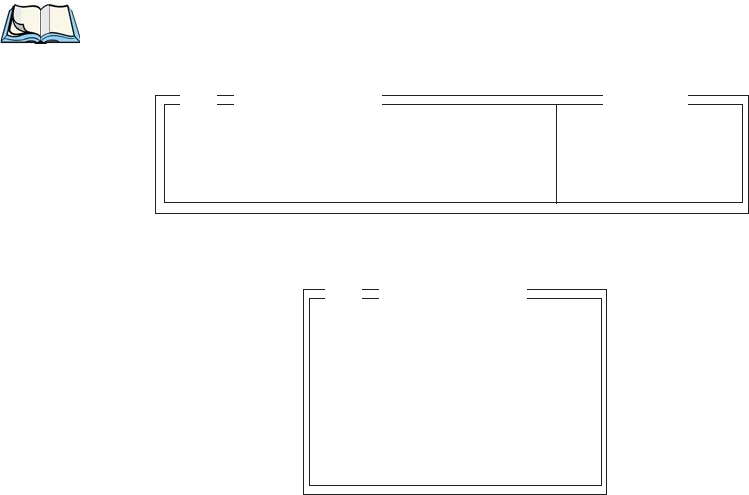
Chapter 6: Tekterm Application
More Parameters
178Psion Teklogix 7530 Hand-Held Computer User Manual
Note: Parameters can also be remotely modified using SNMP. Refer to “SNMP
(Simple Network Management Protocol) Setup” on page 134 for details.
• At the startup ‘Display’ menu, type ‘a’ to display the ‘Parameters’ menu.
• To open the ‘More Parameters’ menu, press <F1>.
More Parameters » see page 177
Security Supervisor see page 176
Display » see page 177
01 Parameters Range
Radio »
System »
Scanner Ctrl Panel »
View Manager »
Applications »
Ports »
Network »
02 Parameters
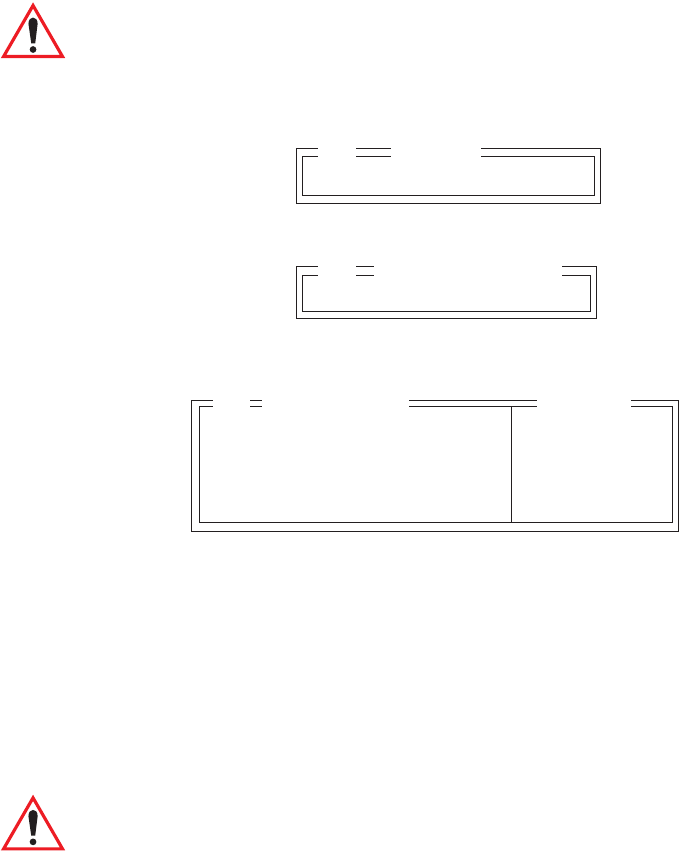
Psion Teklogix 7530 Hand-Held Computer User Manual179
Chapter 6: Tekterm Application
Radio Parameters
6.14 Radio Parameters
Important: Radio parameters should not be changed from their factory
settings without a clear understanding of your system.
The 7530 is equipped with an Intel 802.11b radio.
• Press <F1> to display the ‘Radio’ sub-menu.
• Press <F1> to access the ‘802.11’ sub-menu.
• Set ‘802.IQ v1’ to ‘Y’ to activate these parameters. and press <F1> to
display ‘802.IQ v1’ parameters.
802.IQ v1
When 802.IQ v1 is set to “Y”, the attached sub-menu of parameters is enabled.
Auto Radio Addr
If this parameter is enabled (set to “Y”), a request is sent to the network controller to
assign a radio address to the hand-held computer radio.
If “Auto Radio Addr” is set to “N”, the value entered in the “Radio Address”
parameter is used. (Refer to "Radio Address" in this section for details about
manually assigned radio addresses.)
Important: Ensure that all 7530s grouped in the system use the same
addressing process – that is, if you choose to use automatic
radio addressing, use this addressing process for all units
operating in the same system. If you choose to assign radio
addresses manually using the “Radio Address” parameter, use
this process for all units in the same system.
802.11 »
03 Radio
802.IQ v1 N »
04 802.11 DS SS
Auto Radio Addr Y Y/N
Radio Address 0 1-3840
Initial RTT 0 0-1000
Protocol Type 2457 1501-65535
Range
802.IQ v1
05
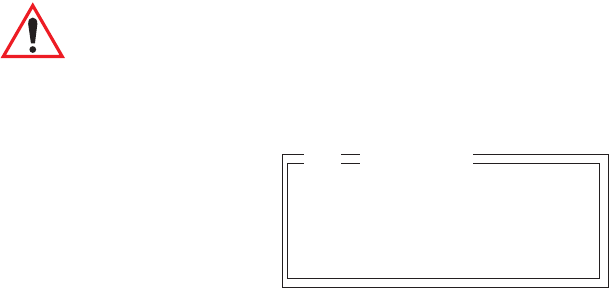
Chapter 6: Tekterm Application
System Parameters
180Psion Teklogix 7530 Hand-Held Computer User Manual
Radio Address
The value entered in the “Radio address” parameter is used to identify the
7530 over the radio link. A unique value from 1 to 3840 must be assigned
for each 7530 hand-held computer.
Initial RTT (Round Trip Time)
Round trip time is the elapsed time between a hand-held computer transmission and
an access point acknowledgement. Each 7535 continuously adjusts the acceptable
round trip time, calculating the average elapsed time over a number of transmis-
sions. If an acknowledgement takes longer to receive than the average round trip
time calculated, the computer will resend the transmission.
Because 7530s cannot calculate an average round trip time without a number of
transmissions, a starting point or “Initial Round Trip Time” is required. The com-
puter uses the time assigned to the “Initial RTT” parameter as a starting value for
round trip calculations. Once the 7530 begins transmitting and receiving data, this
value will be adjusted to reflect the actual average round trip time between transmis-
sions and acknowledgements.
Protocol Type
“Protocol Type” is used to identify the Ethernet packet frame type sent by the 7530.
The default value – 2457 – assigned to this parameter identifies the Teklogix 802.IQ
protocol Ethernet packet frame types.
The “Protocol Type ID” should only be altered if the default value is already being
used to specify another application Ethernet frame type.
Important: If you change the value assigned to “Protocol Type ID”, ensure
that all 7530s and 9150s in your system use the same number.
6.15 System Parameters
Keyboard »
Audio »
Pwr Mgmt Ctrl Panel »
Security »
03 System
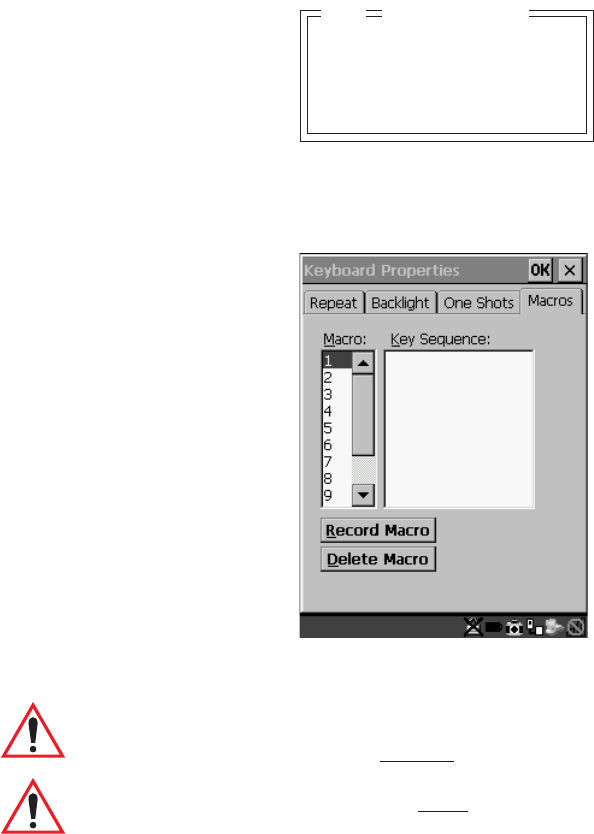
Psion Teklogix 7530 Hand-Held Computer User Manual181
Chapter 6: Tekterm Application
Keyboard
6.15.1 Keyboard
6.15.1.1 Macro Control Panel
• Highlight ‘Macro Ctrl Panel’, and press <F1> to display the Macros tab in the
Keyboard Properties dialogue box.
Figure 6.6 Macro Dialogue Box
Important: Refer to “Keyboard Macro Keys” on page 95 for detailed
instructions about creating macros.
Important: For information about using the macro keys you’ve created, refer
to “Macro Keys” on page 149.
Macro Ctrl Panel »
Indicators Y
Softkeys Y
Ctrl Panel »
Keyboard
04
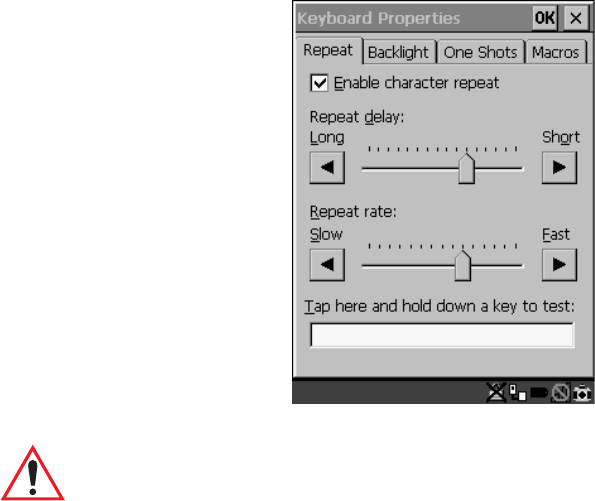
Chapter 6: Tekterm Application
Indicators
182Psion Teklogix 7530 Hand-Held Computer User Manual
6.15.1.2 Indicators
When the “Indicators” parameter is enabled (set to “Y”), onscreen indicators are
displayed to indicate the operating condition of the 7535. Refer to “Onscreen
Indicators” on page 45 for a list of possible indicators.
6.15.1.3 Softkeys
Enabling (setting to “Y”) the “Softkeys” parameter displays softkey labels at the
bottom of the screen to indicate the function of each softkey. To block the display of
softkey labels, set this parameter to “N”.
Softkeys are function keys which are programmed to execute specific actions when
pressed. Refer to Table 6.1 on page 149 for a list of softkey labels.
6.15.1.4 Ctrl Panel
This menu item displays the Keyboard Properties dialogue box in which you can adjust
the repeat rate of the keys, the intensity of the keyboard backlight and the behaviour
of the <BLUE> and <ORANGE> keys.
Figure 6.7 Keyboard Properties
Important: Refer to “Keyboard Properties” on page 92 for details about this
dialogue box.

Psion Teklogix 7530 Hand-Held Computer User Manual183
Chapter 6: Tekterm Application
Audio
6.15.2 Audio
Beep Tone And Beep Time
These parameters regulate the frequency and duration of beeps emitted in a TESS or
ANSI session when one of the following is received at the 7535: an advisory, a hey
you or a bell character. Tone is measured in hertz and time in milliseconds.
Error Tone And Error Time
These parameters determine the frequency and duration of each error tone. Tone is
measured in hertz and time in milliseconds.
Scan Tone 1 And Scan Time 1
“Scan tone 1” and “Scan time 1” determine the frequency and duration of the first
beep of a multiple beep. Tone is measured in hertz and time in milliseconds.
Scan Tone 2 And Scan Time 2
“Scan tone 2” and “Scan time 2” determine the frequency and duration of the
second beep of a multiple beep. Tone is measured in hertz and time in milliseconds.
Scan Tone 3 And Scan Time 3
“Scan tone 3” and “Scan time 3” determine the frequency and duration of the third
beep of a multiple beep. Tone is measured in hertz and time in milliseconds.
Beep Tone 3000 800-3000
Beep Time 250 0-2000
Error Tone 1000 800-3000
Error Time 1000 0-2000
Scan Tone 1 1500 800-3000
Scan Time 1 100 0-2000
Scan Tone 2 2000 800-3000
Scan Time 2 100 0-2000
Scan Tone 3 2500 800-3000
Scan Time 3 100 0-2000
Sounds Ctrl Panel » see text
Range
Audio
04
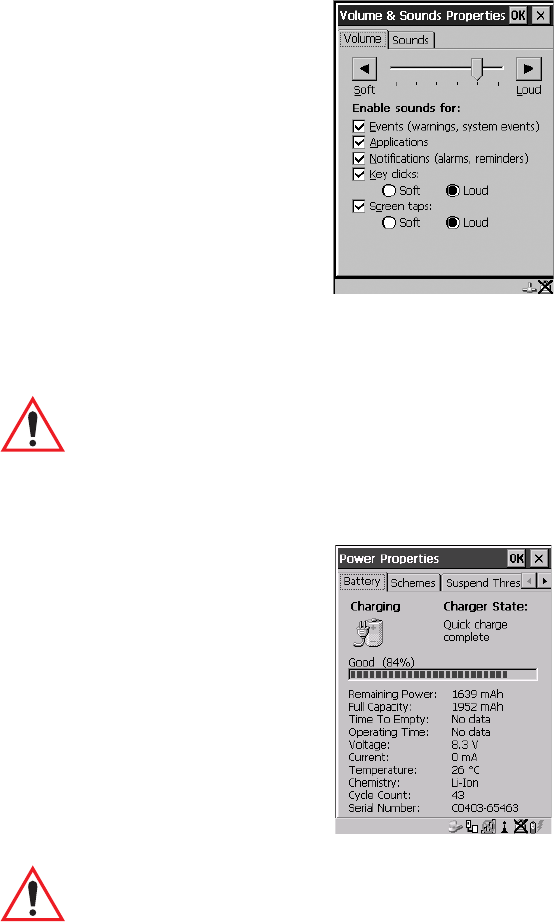
Chapter 6: Tekterm Application
Power Mgmt Ctrl Panel
184Psion Teklogix 7530 Hand-Held Computer User Manual
Sounds Ctrl Panel
This option displays the Volume & Sounds Properties dialogue box.
Figure 6.8 Adjusting The Volume
This dialogue box is used adjust the beeper volume and to select the conditions
under which the 7530 will emit a beep.
Important: Refer to “Volume And Sound Properties” on page 99 for details
about this dialogue box.
6.15.3 Power Mgmt Ctrl Panel
This menu item displays the Power Properties dialogue box.
Figure 6.9 Power Properties Dialogue Box
Important: Refer to “Power Management Properties” on page 100 for details
about this dialogue box.
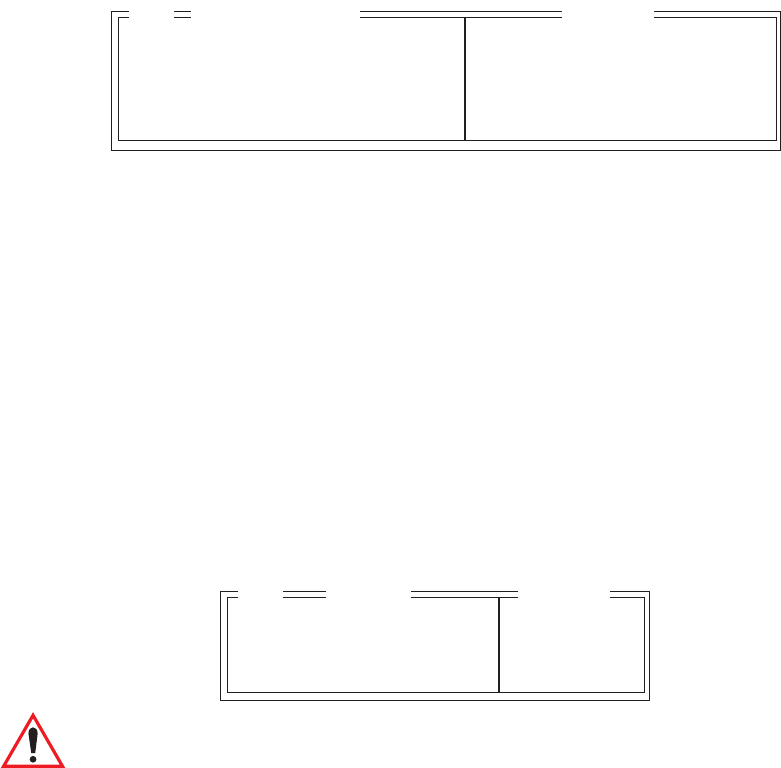
Psion Teklogix 7530 Hand-Held Computer User Manual185
Chapter 6: Tekterm Application
Security
6.15.4 Security
6.15.4.1 Default Mode
The value assigned to this parameter determines the operator’s level of access to
7530 parameters. The allowable values are User, Supervisor and Teklogix. “Default
mode” is set to User.
At User level, the operator is restricted to a small group of parameters. These are
listed in the “User” sub-menu. Refer to “User Level Options” on page 185 for
details. Choosing Supervisor allows access to all the parameters available in the
7530.
The Teklogix level password is only available to Psion Teklogix personnel.
• Press the <LEFT> or <RIGHT> arrow key to select the appropriate security
level – User, Supervisor or Teklogix.
6.15.4.2 User Level Options
Important: Only Supervisor and Teklogix level passwords can change the
values of the User options.
Screen Switch
When set to “Y”, the operator can use the “Split screen” parameter to toggle
between screens when multiple applications are running on the 7535. Refer to “Split
Screen” on page 188 for details about using this function.
Default mode User Supervisor, Teklogix
User » see text
Sup. password ###### see text
Allow Teklogix Y Y/N
Security
04 Range
Screen switch Y Y/N
View Mode Y Y/N
Font Chg Y Y/N
User
05 Range

Chapter 6: Tekterm Application
Sup. Password
186Psion Teklogix 7530 Hand-Held Computer User Manual
Font Chg
When “Font Chg” is set to “Y”, operators at the User level can change the font size
of their 7535s.
6.15.4.3 Sup. Password
Note: Only a Supervisor or Teklogix level password can change the Supervisor
password.
The supervisory password is set at the factory to 123456. You should change the
default password to better protect the 7535 settings. When you’ve changed the
password, write down the new password and file it in a secure place. If the
password is lost, the parameters can only be changed by Psion Teklogix personnel.
Your password can have up to six alphanumeric characters. To change your
password:
• Position the cursor on “Sup. password” and type a new value in the string
entry field.
• When you’ve completed the change, press <ENTER> and then, press <F4>
– the SAVE function key – to save your change.
Important: When you change your password, set all the 7535s to the same
password.
6.15.4.4 Allow Teklogix
Setting this parameter to “Y” allows Psion Teklogix personnel to use their support
level password to access 7530 parameters. If ‘Allow Teklogix’ is set to “N”, only
your supervisory level password can be used to access the parameters.
Warning: If you set this parameter to “N”, the Psion Teklogix support level
password will be rejected. Keep in mind that if you then lose your
supervisory level password, you will need to clear the entire config-
uration setup on all terminals to gain access to the parameters
menu.
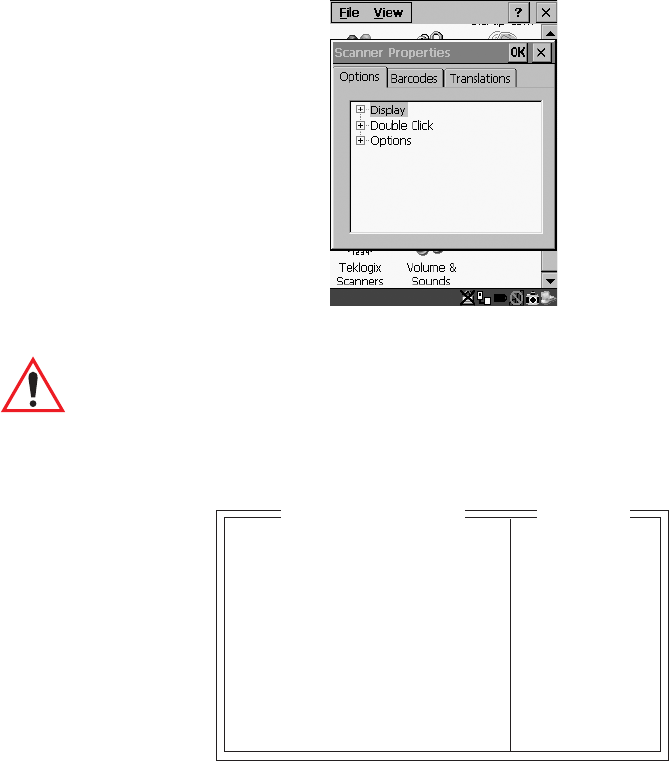
Psion Teklogix 7530 Hand-Held Computer User Manual187
Chapter 6: Tekterm Application
Scanner Control Panel
6.16 Scanner Control Panel
This menu item displays a Scanner Properties dialogue box in which you can set up the
particulars of your unit’s scanner performance, choose the bar codes which will be
decoded, and so on.
Figure 6.10 Scanner Properties Dialogue Box
Important: Refer to "Scanner Properties Setup" beginning on page 118 for
details about setting up your scanner.
6.17 View Manager
Display Shift
If this parameter is enabled (set to “Y”), the display in application screens shifts so
that there are no blank columns on the left-most side of the display.
Display Shift YY/N
Block Cursor Y Y/N
Use Increment N Y/N
X-increment 5 1..40
Y-increment 5 1..12
Split Screen » see text
Custom Chars » see text
Font Override N» see text
Default Colours » see text
View Manager
Range

Chapter 6: Tekterm Application
Split Screen
188Psion Teklogix 7530 Hand-Held Computer User Manual
Block Cursor
When this parameter is enabled (set to “Y”), the cursor is presented as a flashing
block. When “Block Cursor” is set to “N”, the cursor is presented as a flashing
underline character.
Use increment
When “Use increment” is enabled (set to “Y”) and the cursor is moved off the
display, the screen contents shift by the values specified in the “X-increment” and
“Y-increment” parameters.
X-increment
This parameter determines the number of spaces the screen shifts once the cursor
moves out of view. The value assigned here doesn’t take effect until “Use
Increment” is set to “Y”.
Y-increment
This parameter determines the number of spaces the screen shifts once the cursor
moves out of view. The value assigned here doesn’t take effect until “Use
Increment” is set to “Y”.
6.17.1 Split Screen
This parameter allows you to split the display view so that more than one
application screen can be displayed at the same time. The split screen parameters,
“Type” and “View IDs”, are used to tailor the screen view for your needs.
Type And View IDs
The “Type” parameter determines how a screen will be split. The 7535 supports up
to four application screens. The “View IDs” parameter determines which
application screens will be displayed in each pane of the split screen. “Moving
Between Split Screens” on page 190 describes how to move the cursor from one
split screen to the next.
Type 2 Way |||
View IDs A
04 Split screen

Psion Teklogix 7530 Hand-Held Computer User Manual189
Chapter 6: Tekterm Application
Splitting And Displaying Screens
6.17.1.1 Splitting And Displaying Screens
Before splitting the screen, you need to determine which applications should appear
in each pane of the split screen. The available applications are listed in the main
“Display Menu”. Each application listed in the “Display Menu” is preceded by a
letter – for example, Parameters is preceded by an A. This letter is used in the
“View IDs” string entry field to fix each pane of a split screen to a corresponding
application.
If you need to display the startup “Display Menu”:
• Press <CTRL> <ALT><0>.
To split a screen:
• With the cursor on the “Type” parameter, use the <RIGHT> or <LEFT>
arrow key to scroll through the types of split screens available.
The vertical and horizontal lines displayed at the “Type” parameter indicate how the
screen will be split – for example, in the sample screen on page 190, the vertical
lines indicate the screen will be vertically split into two segments. The screen can
also be split horizontally 3 ways or 4 ways.
Once you’ve indicated how you want to split the screen in the “Type” parameter:
• Use the <DOWN> arrow key to move the cursor to the “View IDs”
parameter.
• For each application you want to display, type the letter corresponding to
the application.
For example, suppose you want to split the screen into two vertical
segments with the Parameters menu in the left pane of the screen and
a TESS session in the right pane. In the “Display Menu”, the letter A
represents “Parameters” and B represents “TESS”. The “Type” and
“View ID” values would be represented as follows:
• Press <ENTER>.
To display the split screen on the 7535:
• Press <CTRL> <DOWN> arrow.
Type 2 Way |||
View IDs AB
04 Split screen

Chapter 6: Tekterm Application
Moving Between Split Screens
190Psion Teklogix 7530 Hand-Held Computer User Manual
6.17.1.2 Moving Between Split Screens
To move the cursor from one pane in a split screen to the next:
• Press <CTRL> <RIGHT> or <LEFT>. The cursor moves in order from the
left-most pane to the right and from the top-most pane to the bottom.
6.17.1.3 Toggling Between Full & Split Screens
To toggle between a split and full screen format:
• Press <CTRL> <DOWN> arrow.
The application displayed when toggling from a split to a full screen format is
determined by the cursor location in the split screen. For example, if the cursor
is in the pane of a split screen in which the TESS application is displayed and
<CTRL> <DOWN> is pressed to display a full screen, the TESS application will be
displayed in the full screen.
6.17.1.4 Using The Asterisk As A Wild Card
When a screen is split, the application displayed in each pane is fixed in the “View
IDs” parameter. Using an asterisk * in the “View IDs” parameter indicates that a
particular pane in the split screen is not fixed to any particular application and can be
changed as required.
For example, suppose you want to split the screen into two vertical segments with
the left pane containing the “Parameters” menu and the right pane containing no
fixed application. The “Type” and “View IDs” parameters would be completed as
follows:
To change the application displayed in the pane with no fixed application:
• If the cursor is not currently in the pane, press <CTRL> <RIGHT> or
<LEFT> arrow to move the cursor into the appropriate screen.
• Press <CTRL> <ALT><0> to display the startup “Display Menu”.
• Type the letter corresponding to the new application you want to display.
Type 2 Way |||
View IDs A*
04 Split screen

Psion Teklogix 7530 Hand-Held Computer User Manual191
Chapter 6: Tekterm Application
Custom Characters (Unicode™)
6.17.2 Custom Characters (Unicode™)
Note: The Unicode ™ characters created here are accessible only within the
Tekterm application. To create Unicode ™ characters that are accessible
system-wide, refer to “Unicode Mapping” on page 97.
The “Custom Characters” parameter allows you to create Unicode™ characters not
available directly from the keyboard, including accented characters. Unicode is a
trademark of The Unicode Consortium. You can create up to 20 Unicode™
characters that will be stored in a pop-up menu accessible from any application.
6.17.2.1 Creating A Unicode™ Character
Note: You can create a Unicode™ character by pressing and holding down
the <ALT> while typing the decimal value that represents the Unicode™
character you want to use. However, you will need to press <ALT> and
retype the decimal value each time you want to use the special character.
The advantage to creating special characters using the “Custom Chars”
parameters is that the characters you create in the customer characters
table are saved in a pop-up window that is accessible from any application.
• In the Parameters menu, highlight “View Manager” and press <F1>.
• Highlight “Custom Chars”, and press <F1> to display the custom
characters table.
• Position the cursor on the Fonts at the top of the table.
• Press the <LEFT> or <RIGHT> arrow keys until the character set you want
to use is displayed.
You can create up to 20 Unicode™ characters in the custom characters table.
To create a Unicode™ value:
• Replace the 0000 value with a hex value that represents the Unicode™
character you want to use.
Font Small
U+ 0000
U+ 0000
•
•
•
04 Custom Chars

Chapter 6: Tekterm Application
Displaying The Unicode™ Pop-up Window
192Psion Teklogix 7530 Hand-Held Computer User Manual
• Press the <DOWN> arrow key to accept the value and move the cursor to
the next field.
When you have finished creating the Unicode™ characters you want to use:
• Press <F4> to save your changes.
• Reset the 7535 – press and hold down the <ENTER> and <BLUE> key
simultaneously for a minimum of six seconds.
6.17.2.2 Displaying The Unicode™ Pop-up Window
The Unicode™ values you create are stored in a pop-up window that you can access
from any application.
To display the pop-up window within any application:
• Press <CTRL> <ALT> <A>.
Note: Unicode™ characters that cannot be displayed on your screen with the
font you are currently using are displayed as rectangles in the pop-up
window. (See the sample menu on page 192.) However, the actual Uni-
code™ value you created will be sent to the host.
• Use the <LEFT> or <RIGHT> arrow key to position the cursor on the
Unicode™ value you want to use, and press <ENTER>.
To close the pop-up menu when you’re done:
• Press the <ESC> key.
Select item with arrow keys.
Press ENTER when done.
Press ESC to cancel.
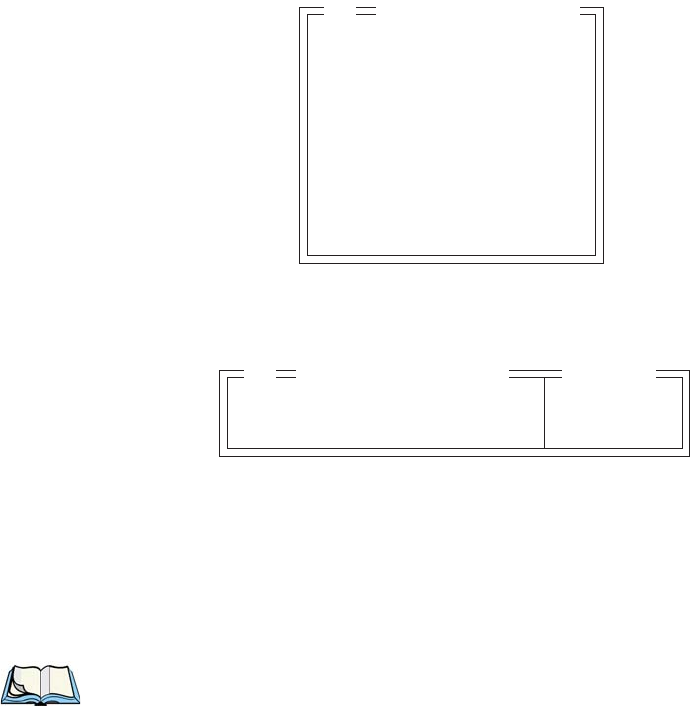
Psion Teklogix 7530 Hand-Held Computer User Manual193
Chapter 6: Tekterm Application
Displaying The Unicode™ Pop-up Window
Font Override
This parameter is used to redefine the font to which 5 different font codes refer.
Default Colours
Foreground And Background
This menu is used to select the foreground and background colours used within
Tekterm. If an unreadable combination is assigned – the foreground and background
have the same value – the foreground colour will be inverted.
The allowable values are: Red, Green, Yellow, Blue, Magenta, Cyan, White
and Black.
Note: The 7530 must be reset – press and hold down the <BLUE> and
<ENTER> keys for a minimum of six seconds – in order for the new
colour assignments to take affect.
Font Code 0
... is font 18x32
Font Code 1
... is font 18x32
Font Code 2
... is font 10x26
Font Code 3
... is font 18x32
Font Code 4
... is font 8x20
Font Override
04
Foreground Black see text
Background White see text
04 Default Colours
Range
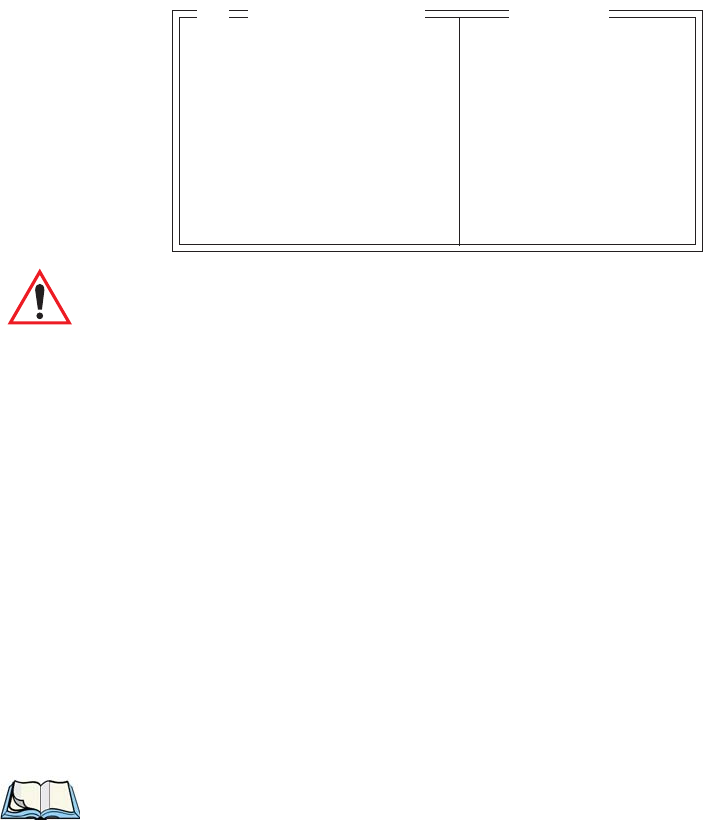
Chapter 6: Tekterm Application
Applications
194Psion Teklogix 7530 Hand-Held Computer User Manual
6.18 Applications
“TESS” and “ANSI” applications require unique names so that several different
sessions of “TESS” and “ANSI” can operate simultaneously. 7530s can support up
to 8 sessions at one time.
Important: These applications will become active only after the changes
made in the Application screen are saved by pressing <F4> –
the SAVE key.
Type And Title
Up to eight applications can be entered in this parameter. The “Type #” field
indicates the type of session you will be running. The “Title #” parameter should be
completed with a name that is meaningful to the operator.
• The available options for the “Type #” field are TESS, ANSI and None.
Use the <RIGHT> or <LEFT> arrow key to scroll through the options.
• The “Title #” field needs a name that is meaningful to the operator. In addi-
tion, “TESS” and “ANSI” applications require unique titles so that several
different sessions of “TESS” and “ANSI” can operate simultaneously.
These titles will appear in startup “Display Menu”. Each session will have
its own set of parameters.
• To display the “Settings” menu for your application, position the cursor
on “Settings”, and press <F1> – the NEXT key.
Note: Before you can access the “Settings” menu, you must first complete the
“Name” and “Type” fields.
Type1 #1 ANSI None, ANSI,TESS
Title1 #1 parts see text
Settings 1 » see text
.
.
.
Type1 #8 None
Title1 #8
Settings 8 »
Applications Range
03
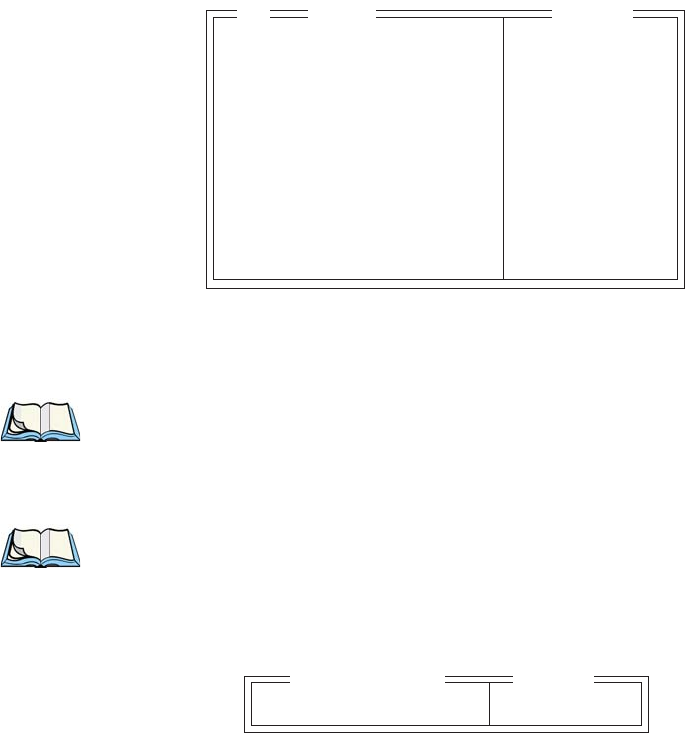
Psion Teklogix 7530 Hand-Held Computer User Manual195
Chapter 6: Tekterm Application
ANSI Settings
6.18.1 ANSI Settings
Each session you create has its own “Settings” parameters. Additional ANSI
information is documented in “ANSI Emulation” on page 162.
Auto Term#
Note: Refer to “Group” on page 195 for additional instructions.
When this parameter is set to “Y”, a unique number is assigned for the current
ANSI session. If “Auto Term#” is set to “Y”, any value assigned to the “Terminal #”
parameter is ignored.
Note: “Auto Term#” is available when 802.IQv2 is assigned to the “Host
Conn” parameter or when 802.IQv1 is enabled in the Radio Menu (see
“802.IQ v1” on page 179).
Group
When “Auto Term#” is set to “Y”, the ‘Group’ parameter is used to identify the
group or pool of numbers from which an auto-address is chosen.
Terminal #
For every application session you create, the “Terminal #” assigned must be non-
zero and unique. This parameter defines the number for the ANSI session and
uniquely identifies all transmissions to and from the 7530.
Auto Term # N» see text
Terminal # 1 1..1024
Host Conn » see text
Screen » see text
Xmit Modes » see text
Kbd Modes » see text
Edit Modes » see text
Serial » see text
Host Char Set » see text
Anchor View N» see text
Ansi Range
04
Group 1 1-5
Range
Auto Term#
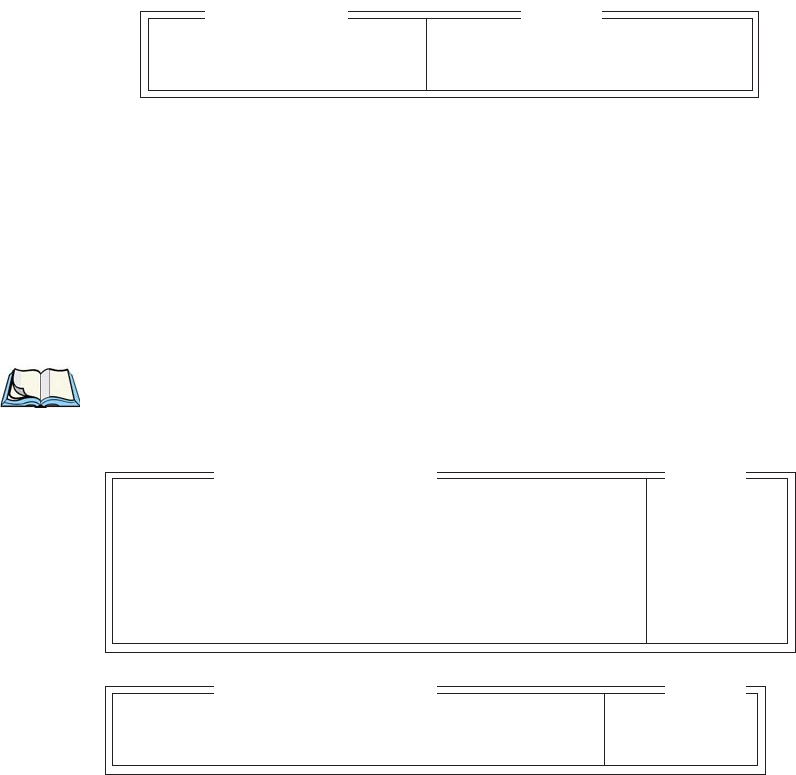
Chapter 6: Tekterm Application
Host Conn
196Psion Teklogix 7530 Hand-Held Computer User Manual
Other applications running in the 7530, such as a TESS session or another ANSI
session must each have a different number. In addition, each Psion Teklogix 7530
using the radio link must have a unique number.
6.18.1.1 Host Conn
Conn Type
The options for this a parameter vary depending on the type of application you are
running – ANSI or TESS and the type of radio installed in your terminal.
For ANSI applications, this parameter allows you to choose one of the following
types of connections: 802.IQv2, 9010t (TCP Direct) or Telnet. Keep in
mind that choosing Telnet allows the terminal to communicate directly with
the host.
Settings
Note: The “Settings” sub-menu is not available when 802.IQv2 is selected as
the “Conn Type”. In addition, this sub-menu varies depending on which
option you’ve selected – Telnet or 9010t.
Conn Type Telnet 802.IQv2, 9010t, Telnet
Settings » see text
Range
Host Conn
Host see text
Port 23 0-32767
ENTER Pmpt Press ENTER to connect see text
ESC Prompt Press ESC to cancel see text
Auto Login N» Y/N
Func Key Remap N» Y/N
Range
Telnet Settings
Host see text
Port 9999 0-9999
Range
9010t Settings

Psion Teklogix 7530 Hand-Held Computer User Manual197
Chapter 6: Tekterm Application
Host Conn
Host
This parameter is used to assign a host IP address using the format ###.###.###.###
or a host name if DNS is used.
Port
“Port” specifies the 9010t (TCP Direct) or Telnet port number. The default
9010t port number assigned is 9999, the maximum allowable value. The default
Telnet port number assigned is 23 with a maximum allowable value of 32767.
ENTER Pmpt
This string indicates that the terminal is waiting for the user to press <ENTER> at
the time of connection.
ESC Prompt
This string indicates that the user can press the <ESC> key to terminate a
connection attempt before the connection is established.
Auto Login
The “Auto Login” parameters are used to define whether or not the terminal will
attempt to log in automatically.
The Auto Login sequence is as follows:
1. Host sends “Login Prompt”.
2. Terminal responds with “Login”.
3. Host sends “Password Prompt”.
4. Terminal responds with “Password”.
5. Host may send password echo.
6. Terminal ignores password echo if “Password Echo” is set to “Y”,
otherwise skip to step 7.
7. Terminal looks for “Login Failed” in next transmission from host.
8. Login successful or Login failed and return to step 1.
Login Prompt gin: see text
Login see text
Password Prompt word: see text
Password see text
Password Echo Y Y/N
Login Failed incorrect see text
Range
Auto Login

Chapter 6: Tekterm Application
Host Conn
198Psion Teklogix 7530 Hand-Held Computer User Manual
Login Prompt
When the terminal receives the string assigned to this parameter, it will respond with
“Login”.
Login
The terminal responds with this string when it receives a “Login Prompt”.
Password Prompt
When the terminal receives this string, it responds with a “Password”.
Password
The terminal responds with this string when it receives a “Password Prompt”.
Password Echo
When this parameter is set to “Y”, the host will echo data back to the terminal after
receiving a “Password”.
Login Failed
When the terminal receives this string, it assumes that the login attempt has failed
and returns to the “Enter Pmpt”.
Func Key Remap
In ANSI, each function key has a default string associated with it. When a function
key is pressed, the corresponding default string is sent to the host. The ‘Func Key
Remap’ table allows these function key character sequences to be redefined.
F 1 1B 4F 50 00 00 00 00
F 2 1B 4F 51 00 00 00 00
F 3 1B 4F 52 00 00 00 00
•
•
•
F28 1B 5B 34 32 7E 00 00
F29 1B 5B 34 33 7E 00 00
F30 1B 5B 34 34
Func Key Remap
07
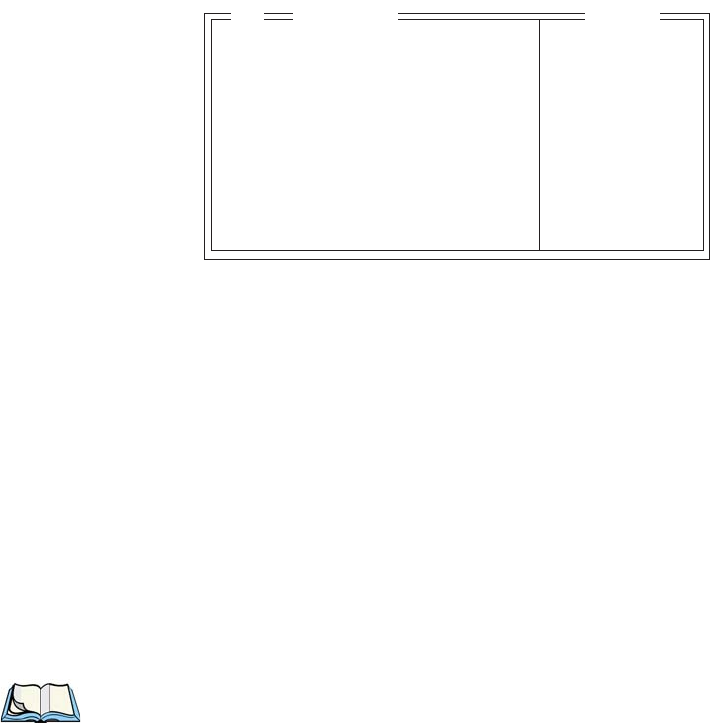
Psion Teklogix 7530 Hand-Held Computer User Manual199
Chapter 6: Tekterm Application
Screen
To change values:
• Press the <UP> or <DOWN> arrow key to highlight a function key.
• Press the <TAB> key to move through the string of values.
• Either type new values, or press the <LEFT> or <RIGHT> arrow key to
change the values.
6.18.1.2 Screen
# of Pages
This parameter defines how many pages are accessible to application programs. The
ANSI control functions – Next Page (NP) and Previous page (PP) – are used to
select another page. These pages are independent of each other so that if lines of text
scroll off a page, the other pages are unaffected.
There is no error indication from the hand-held computer if the memory required by
the selected number and size of pages exceeds the memory available in the
computer.
# of Rows
This parameter defines the logical page length (in lines) used by the host computer
application. Emulator systems trim the host application screens to this length. This
page length cannot be smaller than the length of the hand-held’s display. Display
panning is used if the page is longer than the display.
Note: The value in this parameter must be an even number.
# of Pages 4 0..16
# of Rows 24 4..60
# of Cols 80 80 or 132
Default Font 16x30 see text
80-col. Font 16x30 see text
132-col. Font 16x30 see text
Video » see text
Label F1-F6 » see text
Colour override N » see text
Range
Screen
05
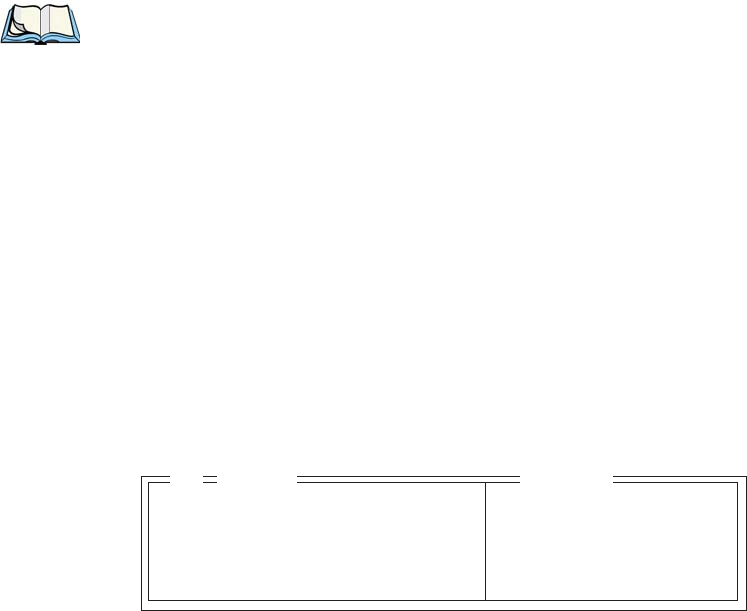
Chapter 6: Tekterm Application
Screen
200Psion Teklogix 7530 Hand-Held Computer User Manual
# of Cols
This parameter defines the logical page width (in characters) used by the host
computer application. Emulator systems trim the host application screens to this
width. This page width cannot be smaller than the width of the display. Display
panning is used if the page is wider than the display.
Note: The value in this parameter must be an even number.
Default font
This parameter determines the default font that appears when the 7535 memory is
reset.
• Use the <RIGHT> or <LEFT> arrow key to scroll through the available
options.
80-col. font & 132-col. font
These parameters are used to set the font size on the screen if the default font is not
acceptable. An escape sequence must be sent from the host before a hand-held can
switch to either 80-col. font or 132-col. font.
• Use the <RIGHT> or <LEFT> arrow keys to scroll through the size options
for these parameters.
Video
The possible attributes for these parameters are: “BLNK” (blink), “ULIN”
(underline), “REV” (reverse), and “NONE” (normal).
Bold
This parameter specifies the actual video attributes to be assigned to fields created
with the “Bold” ANSI attribute.
Bold NONE see text
Blink BLNK see text
Reverse REV see text
Underline ULIN see text
06 Video Range

Psion Teklogix 7530 Hand-Held Computer User Manual201
Chapter 6: Tekterm Application
Screen
Blink
This parameter specifies the actual video attributes to be assigned to fields
created with the “Blink” ANSI attribute.
Reverse
This parameter specifies the actual video attributes to be assigned to fields created
with the “Reverse” ANSI attribute.
Underline
This parameter specifies the actual video attributes to be assigned to fields
created with the “Underline” ANSI attribute.
Label F1-F6
Note: This menu uses string entry fields. For detailed information about com-
pleting this type of field, refer to “String Entry Parameters” on page 171.
Softkeys are function keys that have been programmed to perform specific actions
in your application. These keys are identified through softkey labels – reverse video
labels that are displayed at the bottom of the screen. These softkey labels can be
reconfigured using the menu attached to the “Label F1-F6” parameter.
To edit a label:
• Position the cursor in the appropriate function key field within the
Label menu, and type a new name – preferably one that describes
the corresponding key’s function.
Note: Although you can enter up to 9 characters for each softkey label, the text
will be shortened to better fit in the available space on your display.
F1
•
•
•
F6
Label F1-6
06
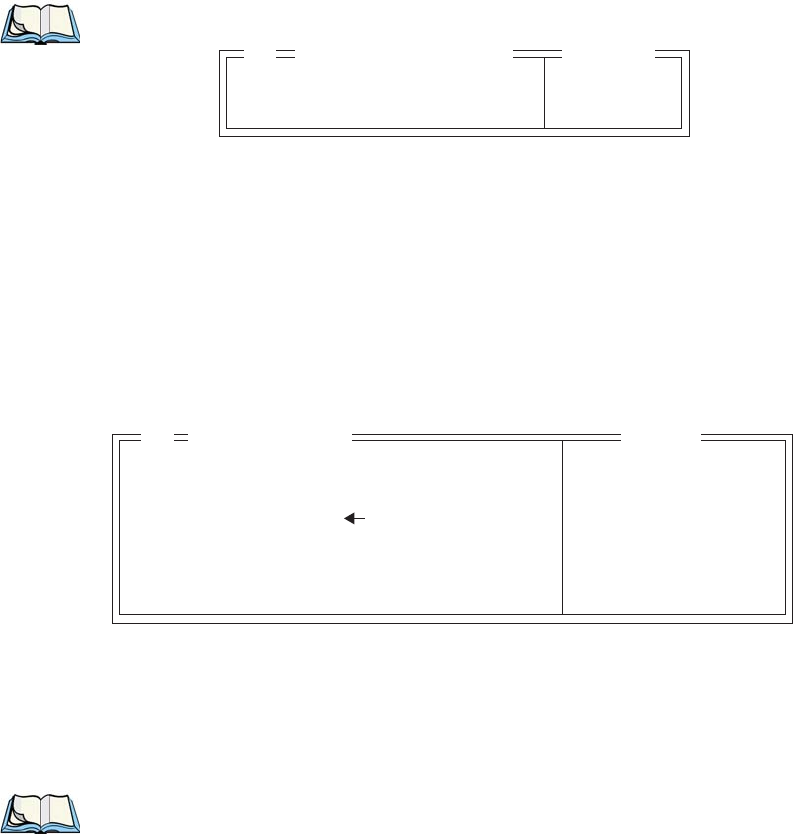
Chapter 6: Tekterm Application
Xmit Modes
202Psion Teklogix 7530 Hand-Held Computer User Manual
Colour Override
Note: This menu is available only if the 7535 is equipped with a colour display.
Foreground And Background
When “Colour Override” is set to ‘Y’, the colours chosen in this menu are displayed
in the ANSI sessions. These colour settings will override the “Default Colours” set
from within the “View Manager” menu. Refer to “Default Colours” on page 193 for
details.
The allowable values are: Red, Green, Yellow, Blue, Magenta, Cyan, White
and Black.
6.18.1.3 Xmit Modes
Xmit Count
This parameter determines how many characters from the keyboard or scanner are
buffered by the 7535 before being transmitted to the host. If 0 (zero) is selected, the
hand-held transmits only according to the “Xmit Wait” parameter. If the ANSI block
mode features are used, this parameter should be set to 99.
Note: If the 7535 is not in local edit mode, the <ENTER>, arrow, <CTRL>,
and function keys cause an immediate radio transmission regardless of
the “Xmit Count” parameter setting.
Foreground Black see text
Background White see text
06 Colour Override
Range
Xmit Count 99 0..99
Xmit Wait 1 0..999
Dev Attr [ ? 62;1;2;6c see text
Auto-Answer see text
7 bit Y Y/N
Block Mode » see text
05 Xmit Modes Range

Psion Teklogix 7530 Hand-Held Computer User Manual203
Chapter 6: Tekterm Application
Xmit Modes
Xmit Wait
This parameter determines the length of time the 7530 collects keystrokes before
transmitting them to the host. This value is specified in increments of one 10th of a
second (i.e., a value of 10 represents 1 second). If 0 (zero) is selected, the computer
transmits only according to the “Xmit Count” parameter.
Note: If the 7530 is not in local edit mode, the <ENTER>, arrow, <CTRL>,
and function keys cause an immediate radio transmission regardless of
the “Xmit Wait” parameter setting.
Dev Attr
This string entry parameter specifies a device attribute string. This string can be up
to 16 characters long. The computer sends this string to the host when it receives a
DA or DECID control. The example shown in the “Xmit Modes” screen sample on
page 202 is the device attribute sent to a VAX, identifying the Psion Teklogix hand-
held computer as a VT220 terminal. This parameter may or may not be set,
depending on the requirements of the host computer.
Auto-Answer
This string can be up to 30 characters long and is sent by the 7530 as a reply to
an “ENQ” character from the host. The “Auto-Answer” string is programmable in
the same manner as the keyboard macros. For example, this string can be used to
automatically send the username and password when logging into the host. Refer
to "Macro Control Panel" beginning on page 181 for additional details about
macros.
7 bit
When this parameter is disabled (set to “N”), the hand-held computer transmits 8 bit
controls. When enabled (set to “Y”), the hand-held transmits 7 bit controls. This
parameter applies to character mode, block mode, and media copy mode.

Chapter 6: Tekterm Application
Xmit Modes
204Psion Teklogix 7530 Hand-Held Computer User Manual
Block Mode
All modes in this section affect the data stream sent to the host computer, the serial
port and the console port. These modes apply to the Block mode (Local Editing)
and the Media Copy function, unless otherwise noted. Consult the Teklogix ANSI
Terminal Programmer’s Manual for more information.
Kbd lock
When this parameter is disabled (set to “N”), the 7530 does not lock the keyboard
after a block mode transmission. When enabled (set to “Y”), the keyboard is locked
after a transmission. The application program must unlock the keyboard by resetting
the Keyboard Action Mode (KAM), using the Reset Mode (RM) or Enable Manual
Input (EMI) controls.
Xmit key
When this parameter is disabled (set to “N”), the key that causes the 7530 hand-held
to transmit is not sent to the host as part of the transmitted data. When enabled
(set to “Y”), the key that causes a transmission is sent after the page data has
been sent to the host. This parameter applies only to block mode.
FETM
When the Format Effector Transfer Mode (FETM) parameter is disabled (set to
“N”), Format Effectors are inserted in data sent to the host or included in data when
transferred to the console or serial ports. When enabled (set to “Y”), the Format
Effectors are not inserted into the data sent to the host and are not included in the
data transferred to the console or serial ports.
Kbd lock N
Xmit key N
FETM N
GATM N
MATM N
SATM Y
TTM Y
EOL chars
EOB chars
06 Block Mode
Psion Teklogix 7530 Hand-Held Computer User Manual205
Chapter 6: Tekterm Application
Xmit Modes
GATM
When the Guarded Area Transfer Mode (GATM) parameter is disabled (set to “N”),
only unguarded data is transmitted to the host or transferred to the console or
serial ports. When enabled (set to “Y”), both guarded and unguarded data can be
transmitted to the host or transferred to the console or serial ports.
MATM
When the Multiple Area Transfer Mode (MATM) parameter is disabled (set to “N”),
only the selected area containing the cursor can be transmitted to the host or
transferred to the console or serial ports. When enabled (set to “Y”), all selected
areas can be transmitted to the host or transferred to the console or serial ports.
This mode is significant only if the Selected Area Transfer Mode (SATM) is disabled.
SATM
When the Selected Area Transfer Mode (SATM) parameter is disabled (set to “N”),
the selected areas defined by SSA/ESA and DAQ can be transmitted to the host or
transferred to the console or serial ports. When enabled (set to “Y”), the full contents
of the buffer can be transmitted to the host or transferred to the console or serial ports.
TTM
When the Transfer Termination Mode (TTM) parameter is disabled (set to “N”), the
cursor position determines the end of the string that can be transmitted to the host
or transferred to the console or serial ports. When enabled (set to “Y”), the cursor
position is ignored.
EOL chars
This string entry parameter specifies a string of up to 8 characters that are sent after
each line in a block transmission. If the parameter is not used, the rules specified in
“Transmitted Data Stream” are used to determine end of line characters.
EOB chars
This string entry parameter specifies a string of up to 8 characters that are sent after
each block transmission.

Chapter 6: Tekterm Application
Kbd Modes
206Psion Teklogix 7530 Hand-Held Computer User Manual
6.18.1.4 Kbd Modes
Arrow mode
This parameter determines whether arrow keys move the cursor within a field or
between fields. When set to “field”, pressing an arrow key causes the cursor to
move to the next field in the direction of the arrow. When set to “cursor”, pressing
the <LEFT> and <RIGHT> arrow keys move the cursor within the current field.
Echo Mode
This parameter selects echo mode for the 7530. The available modes are “Local”,
“Host”, and “Smart”.
Local: In this mode, any character entered using the keyboard is displayed
before being sent to the host. Certain keys cause additional action
at the 7530, as shown in Table 6.5 on page 207.
Host: In this mode, the hand-held computer sends all keyboard entries to
the host and displays only data received from the host.
Smart: This mode reduces or eliminates the delay between typing a
character on the keyboard and displaying the character echoed by
the host computer. The 7530 displays all printable characters on the
screen before sending them to the host. The hand-held compares
the characters echoed by the host to the characters placed on the
page and fixes the display if the host echoes are different.
Arrow mode cursor cursor, field
Echo mode Smart Smart, Local, Host
BKSP key DEL DEL, BS
PrintScreen key 16 1..255
Xmit Enter Y Y/N
Insert N Y/N
Newline N Y/N
Disable kbd N Y/N
DEC Cursor Keys cursor mode see text
05 Kbd Modes Range
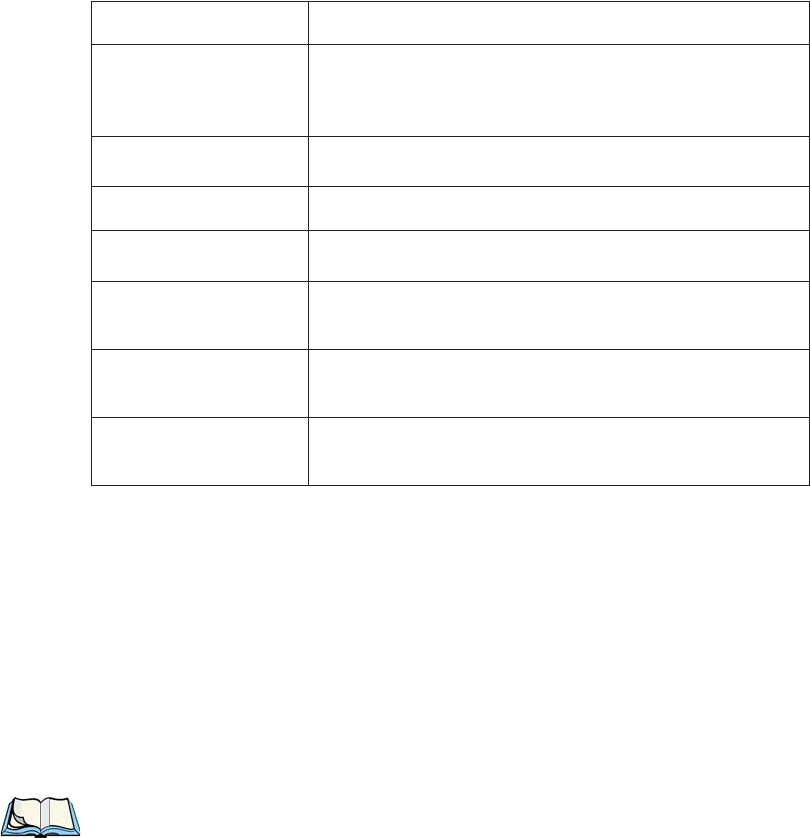
Psion Teklogix 7530 Hand-Held Computer User Manual207
Chapter 6: Tekterm Application
Kbd Modes
The maximum number of characters waiting for echo is 25.
Any additional characters are sent to the host but not displayed.
When the 7530 is in insert mode, smart echo is disabled.
Table 6.5 Function Of Special Keys In Local Echo Mode
BKSP Key
This parameter determines whether the <BKSP> key acts as a delete key, erasing
the character to the right of the cursor, or a backspace key, erasing the character
to the left of the cursor.
PrintScreen Key
This parameter determines the “hot-key” for printing the screen contents via the
7535 serial port. The default is <CTRL> P (16).
Note: The 7530’s port must be set to “printer” (see“Ports– Tether And Con-
sole” on page 235).
Key Function
ENTER In newline mode, this key moves the cursor to the first
column of the next line. In line feed mode, this key
moves the cursor to column one of the current line.
CTRL-G (Bell) The 7530 beeps.
CTRL-H (Backspace) The cursor moves back one space.
CTRL-I (Tab) The cursor moves to the next horizontal tab stop.
CTRL-J (Line Feed)
CTRL-L (Form Feed) The cursor moves down one line in the same column.
CTRL-K (Vertical
Tab) The cursor moves down to the next line with a vertical
tab set.
DEL This key deletes the character to the left of the cursor
and moves the cursor to the left by one position.
Chapter 6: Tekterm Application
Kbd Modes
208Psion Teklogix 7530 Hand-Held Computer User Manual
Xmit Enter
The <ENTER> key normally enters data into a field and moves the cursor to the
next field. However, some applications require that the <ENTER> key start a
transmission from the 7530. When enabled (set to “Y”), this parameter causes the
<ENTER> key to start a transmission.
Insert
When this parameter is disabled (set to “N”), it behaves in “replace” mode –
a character entered at the keyboard or received from the host replaces the
character at the cursor position. The cursor then advances one character position.
When enabled (set to “Y”), the character entered at the keyboard or received from
the host is inserted at the cursor position after shifting the characters at and following
the cursor forward one position. The cursor is advanced one position. The extent
of the characters affected by the shift depends on the setting of the “Edit Extent”
parameter (see page 209).
Newline
When this parameter is disabled (set to “N”), an LF character received from the
host causes the cursor to move down one line in the same column. In addition,
the <ENTER> key transmits a CR. When enabled (set to “Y”), an LF character
received from the host causes the cursor to move to the first column of the next
line. The <ENTER> key transmits both a CR and an LF.
Disable kbd
Setting this parameter to “Y” disables the keyboard and scanner. When this
parameter is set to “N”, the keyboard and scanner are enabled.

Psion Teklogix 7530 Hand-Held Computer User Manual209
Chapter 6: Tekterm Application
Edit Modes
6.18.1.5 Edit Modes
Auto wrap
If “Auto wrap” is disabled (set to “N”), characters received when the cursor is at the
right edge of the screen replace the previously displayed characters. If “Auto wrap”
is enabled (set to “Y”), the cursor wraps to the next line when the current line is
filled. The display scrolls up if the cursor is at the bottom margin.
Erasure mode
When this parameter is disabled (set to “N”), erase functions can only erase
unprotected characters. When enabled (set to “Y”), the erase functions can
erase characters regardless of their protected state.
Tab stop mode
When this parameter is disabled (set to “N”), the setting and clearing of horizontal
tab stops apply to the same horizontal position of all lines on the page. When enabled
(set to ‘Y”), horizontal tab setting and clearing apply only to the current line.
Edit extent
This parameter selects the extent of the display to be affected by the ICH and DCH
controls and received character insertion. The possible values are Line, Area,
Display or Fld. The shifting caused by ICH, DCH and character insertion is
confined to the selected extent.
Disp controls
When this parameter is disabled (set to “N”), any control codes received from the
host are performed as described. When enabled (set to “Y”), any received control
functions are displayed and are not performed. If any C0 or C1 controls are received
from the host, their standard ANSI mnemonics are displayed in reverse video. Other
characters are displayed as normal characters. This mode can also be set with the Set
Mode (SM) control but can only be reset from the Parameters menu.
Auto wrap N Y/N
Erasure mode N Y/N
Tab stop mode N Y/N
Edit extent Line see text
Disp controls N Y/N
04 Edit Modes Range

Chapter 6: Tekterm Application
Serial
210Psion Teklogix 7530 Hand-Held Computer User Manual
6.18.1.6 Serial
Primary Port & Secondary Port
ANSI print commands (such as ‘MC’ or Media Copy) control the transfer of data to
and from the serial and console ports on the 7535. At the 7535, the value assigned at
the ‘Primary Port’ and ‘Secondary Port’ parameters determines which port the
ANSI print command will identify and use as primary and secondary. The allowable
options are: Any Available, Ist printer, 2nd printer, 3rd printer,
4th printer, 1st Serial, 2nd Serial, 3rd Serial, 4th Serial and
Disabled.
Async In
When this parameter is enabled (set to “Y”), the serial (async) port is ready to
receive input at all times.
Start/End
These parameters specify the “start” and “end” characters of input received from
the serial (async) port.
6.18.1.7 Host Char Set
The ‘Host Char Set’ menu allows you to specify a character set in the ‘Lower’ and
‘Upper’ character tables.
Note: When an 8-bit set is selected from the ‘Lower’ character set, the ‘Upper’
character set will change to the same value. The ‘Upper’ character set
cannot be altered until a non-8-bit value is assigned for the ‘Lower’
character set.
Primary Port Any Available see text
Secondary Port Any Available see text
Async In N Y/N
Start 0 0..255
End 0 0..255
05 Serial Range
Lower VT220 Fren Cdn.
Upper Arabic IR-127
Host Char Set
05
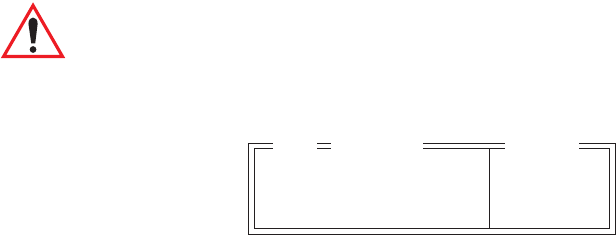
Psion Teklogix 7530 Hand-Held Computer User Manual211
Chapter 6: Tekterm Application
Anchor View
To choose ‘Lower’ and ‘Upper character sets:
• Position the cursor on the ‘Lower’ or ‘Upper’ parameter, and press the
<RIGHT> or <LEFT> arrow key to display the character set options.
• Press <F4> to save your selection to memory.
Important: When a character sent from the host cannot be displayed, a
rectangular box is used as a substitute.
6.18.1.8 Anchor View
When enabled (set to “Y”), this parameter locks the display at a defined location on
the screen, preventing it from shifting when the cursor is moved. The “x origin” and
“y origin” coordinates specify where the screen origin, the upper left corner of the
screen, will be fixed.
x origin and y origin
The “x origin” parameter is used to specify the column to which the upper left
corner of the screen will be anchored. The “y origin” parameter is used to specify
the row coordinate to which the screen will be anchored.
x origin 1 1..24
y origin 1 1..80
Anchor Range
05
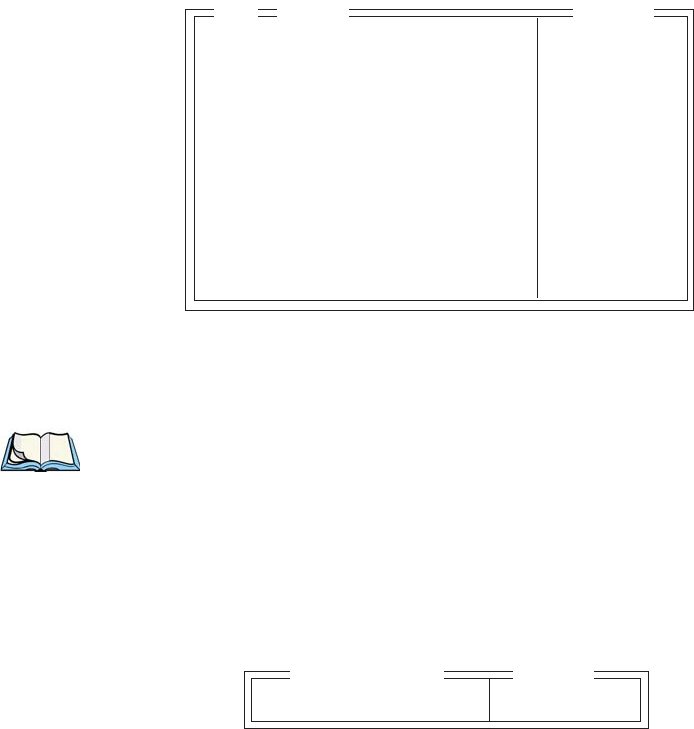
Chapter 6: Tekterm Application
TESS Settings
212Psion Teklogix 7530 Hand-Held Computer User Manual
6.18.2 TESS Settings
Each session you create has its own “Settings” parameters. Additional TESS
information is documented in “TESS Emulation” on page 154.
Auto Term#
Note: “Auto Term#” is available when 802.IQv2 is assigned to the “Host
Conn” parameter (page 213) or when 802.IQv1 is enabled in the Radio
Menu (see “802.IQ v1” on page 179).
When this parameter is set to “Y”, a unique unit number is assigned for the current
TESS session. If “Auto Term#” is set to “Y”, any value assigned to the “Terminal #”
parameter is ignored.
Group
When “Auto Term#” is set to “Y”, the ‘Group’ parameter is used to identify the
group or pool of numbers from which an auto-address is chosen.
Auto Term # N»
Terminal # 1 see text
Host Conn » see text
Screen » see text
Characters » see text
Tests » see text
Features » see text
Scanner » see text
Fields » see text
Anchor View N» see text
Emulation » see text
TESS Range
04
Group 1 1-5
Range
Auto Term#
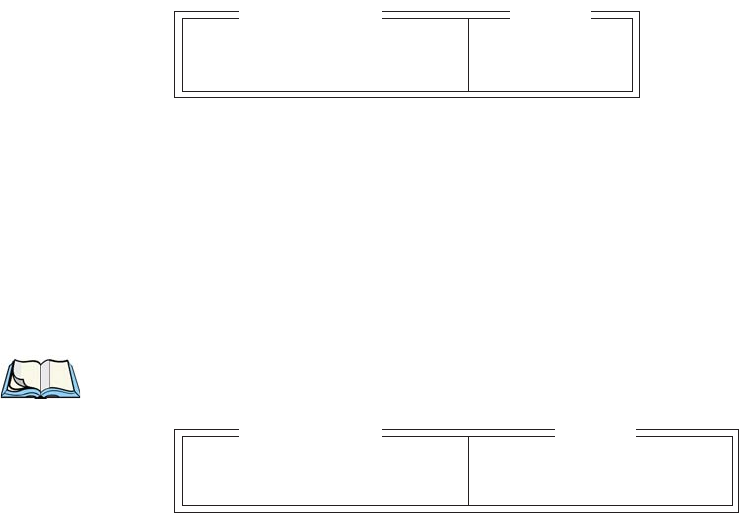
Psion Teklogix 7530 Hand-Held Computer User Manual213
Chapter 6: Tekterm Application
Host Conn.
Terminal #
For every application session you create, the “Terminal #” assigned must be non-
zero and unique. This parameter defines the terminal number for the TESS session
and uniquely identifies all transmissions to and from the 7530.
Other applications running in the 7530, such as an ANSI session or another TESS
session must each have a different number. In addition, each Psion Teklogix 7530
using the radio link must have a unique number.
6.18.2.1 Host Conn.
Conn Type
The options for this a parameter vary depending on the type of application you are
running – ANSI or TESS.
For TESS applications, this parameter allows you to choose one of the following
types of connections: 802.IQv2, 9010t (TCP Direct), 2392/Telnet,
3274/Telnet and 5250/Telnet.
Settings
Note: The “Settings” sub-menu is not available when 802.IQv2 is selected as
the “Conn Type”
Host
This parameter is used to assign a host IP address using the format ###.###.###.###
Port
“Port” specifies the port number. By default, the port is assigned the value 9999.
Conn Type 802.IQv2 see text
Settings » see text
Range
Host Conn
Host see text
Port 9999 0-9999
Range
Settings
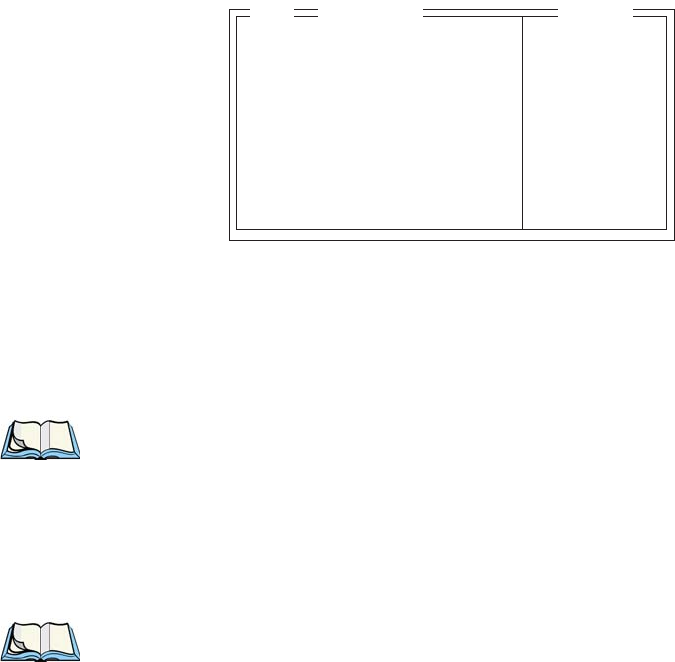
Chapter 6: Tekterm Application
Screen
214Psion Teklogix 7530 Hand-Held Computer User Manual
6.18.2.2 Screen
# of Cols
This parameter defines the logical page width (in characters) used by the host
computer application. Emulator systems trim the host application screens to this
width. This page width cannot be smaller than the width of the 7535 display.
Display panning is used if the page is wider than the display.
Note: The value in this parameter must be an even number.
# of Rows
This parameter defines the logical page length (in lines) used by the host computer
application. Emulator systems trim the host application screens to this length. This
page length cannot be smaller than the length of the hand-held computer’s display.
Display panning is used if the page is longer than the display.
Note: The value in this parameter must be an even number.
Origin Scroll
When enabled (set to “Y”), the display window moves to the origin (upper-left
corner) after “LOCK-H” or “LOCK-B” messages.
Field Scroll
When enabled (set to “Y”), the display window moves to the left after entering a
new entry field.
# of Cols 80 20..132
# of Rows 24 4..100
Origin Scroll N Y/N
Field Scroll N Y/N
Pages Saved 16 1..16
App. Parameter 0 -1..79
Label F1-6 » see text
Colour Override N» see text
Screen
05 Range
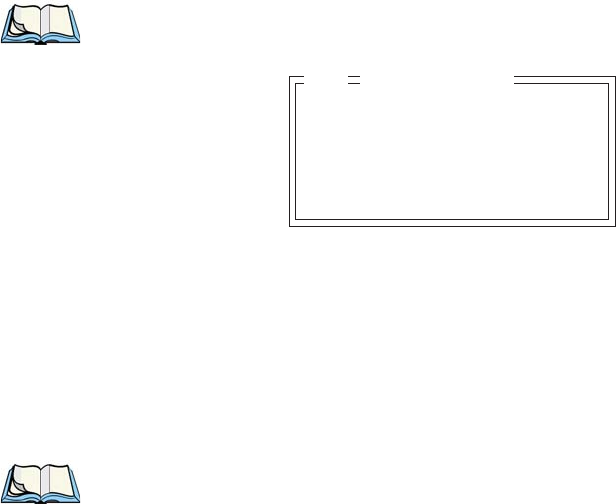
Psion Teklogix 7530 Hand-Held Computer User Manual215
Chapter 6: Tekterm Application
Screen
Pages Saved
This parameter determines the number of pages that can be stored and recalled at
the 7530. Storing frequently used page data at the 7530 reduces the need for the host
to retransmit complete page data over the radio link. Retransmitting data can reduce
the system response time. Increasing the number of saved pages decreases the
available memory for other functions.
App. Parameter
The “Application” parameter is sent to the host system as part of the response to
the TESS query command. Enter zero to disable this parameter.
Label F1-F6
Note: This menu uses string entry fields. For detailed information about com-
pleting this type of field, refer to “String Entry Parameters” on page 171.
Softkeys are function keys that have been programmed to perform specific actions
in your application. These keys are identified through softkey labels – reverse video
labels that are displayed at the bottom of the screen. These softkey labels can be
reconfigured using the menu attached to the “Label F1-F6” parameter.
To edit a label:
• Position the cursor in the appropriate function key field within the
Label menu, and type a new name – preferably one that describes
the corresponding key’s function.
Note: Although you can enter up to 8 characters for each softkey label, the text
will be shortened to better fit in the available space on your display.
F1
•
•
•
F6
Label F1-6
06
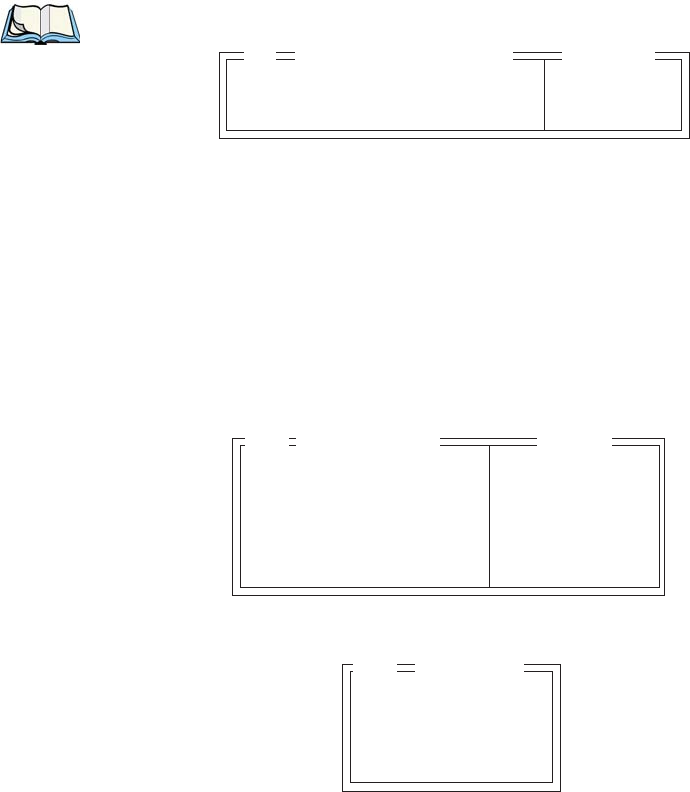
Chapter 6: Tekterm Application
Characters
216Psion Teklogix 7530 Hand-Held Computer User Manual
Colour Override
Note: The menu is available only if your 7530 is equipped with a colour display.
Foreground And Background
When “Colour Override” is set to ‘Y’, the colours chosen in this menu are displayed
in the TESS sessions. These colour settings override the “Default Colours” set from
within the “View Manager” menu. Refer to “Default Colours” on page 193 for
details.
The allowable values are: Red, Green, Yellow, Blue, Magenta, Cyan, White
and Black.
6.18.2.3 Characters
Char Set
This menu contains all the character sets available with your Psion Teklogix
computer. In this menu, the “Y” or “N” is used to visually guide you to the selected
character set. For example, in the sample menu above, the “Y” next to IBM
indicates that a character set has been chosen from this group.
Foreground Black see text
Background White see text
06 Colour Override
Range
Char Set » see text
V Match Char 0 0..255
H Match Char 0 0..255
Fill Chr 46 0..255
Upper Case N Y/N
Range
Characters
05
ISO N »
IBM Y »
DEC N »
Misc. N »
06 Char Set

Psion Teklogix 7530 Hand-Held Computer User Manual217
Chapter 6: Tekterm Application
Characters
To choose a character set:
• Position the cursor on the appropriate item – for example, ISO – and press
<F1> to display the character set options.
• To activate a character set, press the <RIGHT> or <LEFT> arrow key to set
it to “Y”.
Important: If you choose a Chinese character set from the ‘Misc.’ menu and
a character sent from the host cannot be displayed on the 7535
screen, a shaded box character is used as a substitute. Please
review “Default font” on page 226.
If you are using a Korean character set, a right arrow character is
used as a substitute.
V Match Chr
This parameter enables visible field matching and defines the character that identifies
visible field match data from the host. Field matching allows the host to pre-load
data into an entry field that is compared with the user’s input. The hand-held beeps if
the entered data does not match. Visible field matching means that the data to be
matched is displayed in the entry field.
Enter the decimal value for the ASCII character that will be used by the host to
identify visible match field data. Enter 0 (zero) to disable this feature.
Note: Another method of field matching is available directly through the
TESS data stream.
H Match Chr
This parameter enables hidden field matching and defines the character that identifies
hidden field match data from the host. Field matching allows the host to pre-load
data into an entry field that is compared with the user’s input. The 7535 beeps
if the entered data does not match. Hidden field matching means that the data to be
matched is not displayed in the entry field.
Enter the decimal value for the ASCII character that will be used by the host to
identify hidden match field data. Enter 0 (zero) to disable this feature.
Note: Another method of field matching is available directly through the
TESS data stream.
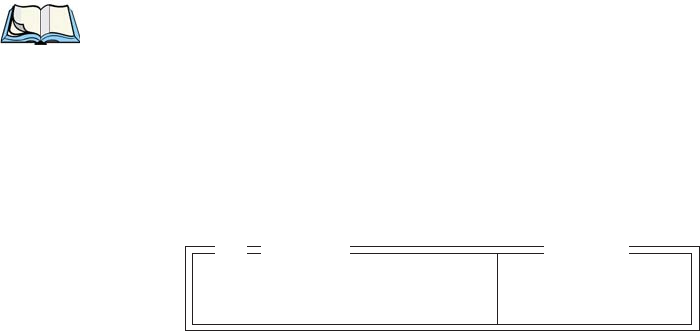
Chapter 6: Tekterm Application
Tests
218Psion Teklogix 7530 Hand-Held Computer User Manual
Fill Chr
This parameter specifies the character that identifies empty entry fields. Enter
the ASCII decimal equivalent of this character. The most commonly used
characters are:
_ (underline) Enter 95
. (period) Enter 46
Note: 7530s in some systems may use the “space” character with the host using
reverse video attributes to mark entry fields.
Upper Case
When this parameter is enabled (set to “Y”), lowercase input is converted
to uppercase.
6.18.2.4 Tests
AutoRep Fn
This parameter determines which function key is sent to the host in auto reply mode.
The value represents the number of the function key – not the ASCII decimal
equivalent. After sending this key, the unit locks and waits for the host to unlock the
7530. To disable “AutoRep Fn”, set the “AutoRep T/O” parameter to zero.
AutoRep T/O
This parameter determines the time (in seconds) between the 7535 unlocking and
the next transmission of the function key specified by the above parameter.
A value of zero disables auto reply mode.
AutoRep Fn 7 0..63
AutoRep T/O 5 0..255
05 Tests Range

Psion Teklogix 7530 Hand-Held Computer User Manual219
Chapter 6: Tekterm Application
Features
6.18.2.5 Features
Printer
This parameter enables and disables the pins in the serial port used for printers or
other external devices.
Binary print
When this parameter is enabled (set to “Y”), the page displayed on the 7530
computer is spooled as is, except for trailing white-space removal. When disabled
(set to “N”), each line of the page displayed on the hand-held is preceded by a
linefeed (LF) and followed by a carriage return (CR).
Queuing
This parameter enables and disables queuing mode (see “Queuing Mode” on
page 162). It also enables TESS procedures to be loaded into the 7530. This
parameter should be enabled if local procedures and the ability to switch between
hosts within a TESS session are required. Changes to this parameter take effect only
after the 7530 is reset.
Lcl Process – Save on Reset
The menu item “Local Process” has a sub-menu attached to it – “Save on Reset”.
When this parameter is enabled (set to “Y”), data stored in the 7530 is saved if the
unit is reset. Local procedures are defined on page 161.
Printer Y Y/N
Binary print N Y/N
Queuing Y Y/N
Lcl Process Y » see text
Send Mile N Y/N
Next X N Y/N
Kbd Locked N Y/N
Remap Passthru N Y/N
Disable Beep N Y/N
Serial » see text
05 Features Range
Chapter 6: Tekterm Application
Features
220Psion Teklogix 7530 Hand-Held Computer User Manual
Send Mile
This parameter controls the sending of a milestone from the 7530 after a “hey_you”
command. Consult the Teklogix Screen Subsystem (TESS) User Manual for more
information on milestones.
Next X
This parameter enables and disables the next messages used in queuing mode.
Kbd Locked
This parameter allows you to lock (set to “Y”) or unlock (set to “N”) the keyboard
for all alphanumeric input in TESS. When the keyboard is locked, the function
keys, arrow keys and the <ENTER> key are still functional. The 7535 emits
an error beep if a character is rejected because the keyboard is locked. Changes to
this parameter take effect only after the unit is reset.
Remap Passthru
When this parameter is set to “Y”, passthru data is remapped from the host charset
to the port charset. (Normally passthru data is sent as is to the port without any
remapping.)
Disable Beep
Setting this parameter to “y” disables the beep generated by the ‘o’, ‘G’ and ‘#’
TESS commands. Keep in mind that Error and Scan beeps are not disabled.

Psion Teklogix 7530 Hand-Held Computer User Manual221
Chapter 6: Tekterm Application
Features
Serial
Serial Port
TESS print commands control the transfer of data to and from the serial and printer
ports on the 7530. At the 7530 computer, the value assigned at the ‘Serial Port’
parameter ranks which port the TESS print command will identify and use as the
first to fourth port. The allowable options are: Any Available, 1st Serial,
2nd Serial, 3rd Serial, 4th Serial and Disabled.
Serial Out
This parameter enables serial port output fields.
Serial In
This parameter enables the serial port input fields. If enabled (set to “Y”), the TESS
application has exclusive use of the serial port. Acceptance of data in a SI field is
determined by the SI prefix and suffix.
SI mode
The possible values for this parameter are field (the default) and command. When
the SI mode is set to field, data received through the serial port is displayed in the
serial input fields. If you are using serial-input fields, make sure the “SI mode”
parameter is set to field.
When “SI mode” is set to command, data received by the serial port is transmitted as
Passthrough data to the host.
Note: “Command” mode is supported by SDKs but not by emulations.
Serial Port Any Available see text
Serial Out Y Y/N
Serial In N Y/N
SI mode see text
SI prefix 10 0..255
SI suffix 13 0..255
SI CRC N Y/N
SI Fkey 0 0..255
SO prefix 10 0..255
SO suffix 13 0..255
SO CRC N Y/N
06 Serial Range

Chapter 6: Tekterm Application
Features
222Psion Teklogix 7530 Hand-Held Computer User Manual
SI prefix
This parameter determines the start-of-message character on serial input. Enter an
ASCII numeric equivalent from 0 to 255 to represent the start character. A value of
0 (zero) indicates no prefix.
SI suffix
This parameter determines the end-of-message character on serial input. Enter an
ASCII numeric equivalent from 0 to 255 to represent the end character. A value of
0 (zero) indicates no suffix.
SI CRC
This parameter enables or disables CRC validity check on serial input. When
enabled (set to “Y”), a packet is rejected if the CRC is not valid.
Also, when this parameter is enabled (set to “Y”), each time a DLE (^P=0x10)
character is encountered in the serial input, it is removed and the character
following it will be replaced with its 1’s complement.
SI Fkey
This parameter allows you to choose the function key you want appended to the
serial input. For example, entering a value of “1” appends <F1> to serial input. A
value of “0” (zero) disables this parameter; a suffix is not added.
Note: Data is transmitted as soon as the function key has been appended.
SO prefix
This parameter determines the start-of-message character on serial output. Enter an
ASCII numeric equivalent from 0 to 255 to represent the start character. A value of
“0” (zero) indicates no prefix.
SO suffix
This parameter determines the end-of-message character on serial output. Enter an
ASCII numeric equivalent from 0 to 255 to represent the end character. A value of
“0” (zero) indicates no suffix.

Psion Teklogix 7530 Hand-Held Computer User Manual223
Chapter 6: Tekterm Application
Scanner
SO CRC
When this parameter is enabled (set to “Y”), a CRC16 value is appended to the
serial output message.
Also, when this parameter is enabled (set to “Y”), for each control character in
the serial output stream, a DLE is inserted to precede that character. The control
character is replaced with its 1’s complement.
6.18.2.6 Scanner
Cont Nxt Fld
This parameter only applies to string entry data. When enabled (set to “Y”), this
parameter allows bar codes that are longer than the field length to continue in the
next field.
If “ContNxtField” is disabled (set to “N”), OFF data will flow into the next field.
Append Enter
When enabled (set to “Y”), “Append Enter” causes an <ENTER> code to be
appended to the bar code. The <ENTER> code completes the entry of the bar code
and moves the cursor to the next field.
Append F0
When enabled (set to “Y”), this parameter causes an <F0> code to be appended to
the bar code. The <F0> code completes the entry of the bar code data in the field.
Cont Nxt Fld YY/N
Append Enter Y Y/N
Append F0 Y Y/N
Mixed AIAG N Y/N
Rjct if Alpha N Y/N
Beam Lockout N Y/N
Range
Scanner
05

Chapter 6: Tekterm Application
Fields
224Psion Teklogix 7530 Hand-Held Computer User Manual
Mixed AIAG
When this parameter is enabled (set to “Y”), AIAG labels are always accepted and
processed – even if mixed with keyboard input. The AIAG label can replace the
partially entered keyboard data. If this parameter is disabled, AIAG labels are
rejected if field entry is in progress.
Rjct if Alpha
When the cursor is in a numeric field and “Rjct if Alpha” is enabled (set to “Y”),
bar codes containing alphabetic characters are rejected.
Beam Lockout
When enabled (set to “Y”), this parameter disallows scanner use when the current
session is in “LOCK-H” mode.
6.18.2.7 Fields
Field Order
This parameter determines the mode of cursor movement between fields. The next
field can be defined by location on the screen or by the assignment of field numbers.
When enabled (set to “Y”), the cursor moves according to field location. If disabled
(set to “N”), the cursor moves according to the numeric order of the fields.
Field Order YY/N
Enter To F0 Y Y/N
Enter On Arrow Y Y/N
Video » see text
All Fld Video Y Y/N
Default Font 16x30 see text
Entry Mode field see text
Open Fky Only N Y/N
Ign Bcode_fld N Y/N
Enh Edit Mode N Y/N
Valid Numerics +-%*/.,$ see text
Range
Fields
05

Psion Teklogix 7530 Hand-Held Computer User Manual225
Chapter 6: Tekterm Application
Fields
Enter To F0
The <ENTER> key normally enters data into a field and moves the cursor to the
next field. However, some applications require that the <ENTER> key start a
transmission from the 7535. When enabled (set to “Y”), this parameter causes the
<ENTER> key to be interpreted as <F0> which starts a transmission.
Enter On Arr
When this parameter is enabled (set to “Y”), the arrow keys can be used to complete
data entry into a field.
Video
Blink
The value assigned to this parameter specifies the actual video attributes to be
assigned to fields created with the “Blink” TESS attribute – that is, “BLNK” (blink),
“ULIN” (underline), “REV” (reverse) or “NONE” (normal).
Bold
The value assigned to this parameter specifies the actual video attributes to be
assigned to fields created with the “Bold” TESS attribute – that is, “BLNK” (blink),
“ULIN” (underline), “REV” (reverse) or “NONE” (normal).
Reverse
The value assigned to the “Reverse” parameter specifies the actual video attributes
to be assigned to fields created with the “Reverse” TESS attribute – that is, “BLNK”
(blink), “ULIN” (underline), “REV” (reverse) or “NONE” (normal).
All Fld Video
Usually, the video attributes apply only to the text that is in an entry field. When this
parameter is enabled (set to “Y”), the entire field (including blanks) takes on the
video attributes. Some systems use this option to identify empty entry fields with
reverse video.
Blink BLNK see text
Bold ULIN see text
Reverse REV see text
Video Range
06
Chapter 6: Tekterm Application
Fields
226Psion Teklogix 7530 Hand-Held Computer User Manual
Default font
This parameter determines the default font that appears when the memory is reset.
• Use the <RIGHT> or <LEFT> arrow key to scroll through the options.
Entry Mode
“Entry Mode” parameters allow you to select a data entry mode. The modes are:
insert, replace, field and fcursor. “TESS Edit Modes And Cursor
Movement” on page 156 describes these modes in detail.
Open Fky Only
When this parameter is enabled (set to “Y”), the screen is open for function keys
only, and the cursor is not positioned. When this parameter is disabled, the screen is
open for data entry, and the cursor is placed in the first field (if it exists).
Ign Bcode_fld
When this parameter is enabled (set to “Y”), fields that were defined as “bar code
only” accept data from the keyboard as well as the bar code reader. In effect, they
behave as data entry fields.
Enh Edit Mode
This mode provides extended (enhanced) functions to users of Psion Teklogix’ IBM
5250 terminal emulation. When this parameter is enabled (set to “Y”), the arrow
keys move the cursor anywhere on the screen, unrestricted by fixed or entry fields.
Certain 5250 emulation keys (e.g. Field Exit) that were originally available only
when “Enh Edit Mode” was set to “Y” are now active at all times in TESS
applications.
Refer to “IBM 5250 Emulation Keys” on page 155 for details about these keys.
Valid Numerics
This parameter is used to configure valid characters for numeric fields to a
maximum of 39 characters. Since this field is numeric, numbers 0 through 9 do not
need to be configured. The default values for this parameter are: + - % / . , $.
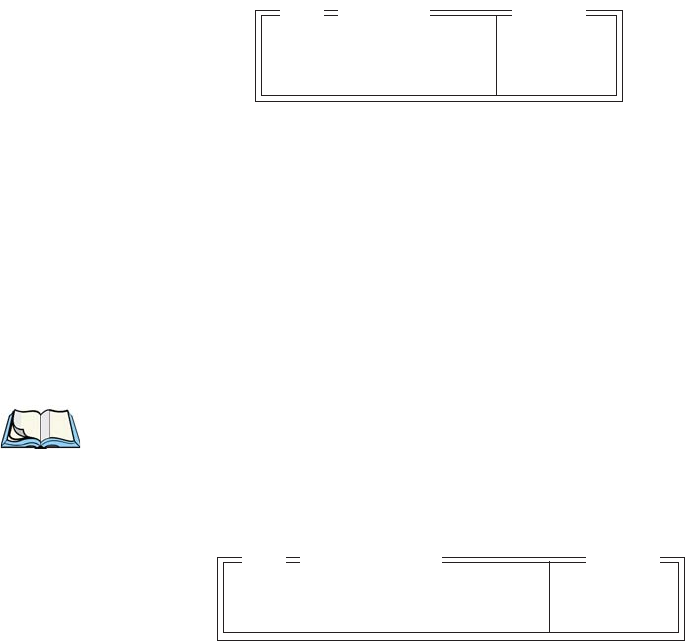
Psion Teklogix 7530 Hand-Held Computer User Manual227
Chapter 6: Tekterm Application
Anchor View
6.18.2.8 Anchor View
When enabled (set to “Y”), this parameter locks the display at a defined location on
the screen, preventing it from shifting when the cursor is moved. The “x origin” and
“y origin” coordinates specify where the screen origin, the upper left corner of the
screen, will be fixed.
x origin and y origin
The “x origin” parameter is used to specify the column to which the upper left
corner of the screen will be anchored. The “y origin” parameter is used to specify
the row coordinate to which the screen will be anchored.
6.18.2.9 Emulation
Note: These parameters are only accessible when one of the following TESS
‘Host Conn’ options is selected: ‘2392/Telnet’, ‘3274/Telnet’ or
‘5250/Telnet’.
2392/Telnet Emulation
Send CR with FKEY
A function key press generates a string of text to be sent back to the host. If this
parameter is enabled, a carriage return is appended to the function key.
x origin 1 1..24
y origin 1 1..80
Anchor Range
05
Send CR with Fkey N Y/N
Features » see text
Emulation Range
05

Chapter 6: Tekterm Application
Emulation
228Psion Teklogix 7530 Hand-Held Computer User Manual
Features – 2392/Telnet
Clear Entry Fields
When this parameter is set to ‘Y’, an empty entry field is created in place of an entry
field filled with spaces.
Note: This operation is only performed on screens received from the host. Data
sent to the host remains unaffected.
Passthru Printing
Setting this parameter to ‘Y’ allows the host to send data directly to the 7535 serial
port. This option is most commonly used for printing.
AIAG Character
This parameter is used to enter a decimal representation of the ASCII character code
of the AIAG character. A value of 0 (zero) disables this feature.
When a bar code data is scanned, the 7530 searches for AIAG fields on the current
page that can accept the bar code data. The application program distinguishes an
entry field as AIAG by preceding the field with this special mode character which
indicates the existence of AIAG fields.
Barcode Character
Barcode-input-only fields are special entry fields that only accept input from a bar
code reader. The application program identifies a barcode-input-only entry field by
preceding the field with a special character.
Clear Entry Fields N Y/N
Passthru Printing N Y/N
AIAG Character 0 0-255
Barcode Character 0 0-255
Serial IO Character 0 0-255
Fixed Field Ovrhd 5 0-80
Enable Alarm N Y/N
Command Region Up 0 0-24
Command Region Down 0 0-24
Command Region Left 0 0-80
Command Region Right 0 0-80
Features Range
06
Psion Teklogix 7530 Hand-Held Computer User Manual229
Chapter 6: Tekterm Application
Emulation
This parameter is used to enter a decimal representation of the ASCII character code
of the barcode-input-only character. A value of 0 (zero) disables this feature.
Serial IO Character
Serial I/O fields are special entry and fixed fields that accept input from and output
to a serial port. The application program distinguishes this field as Serial I/O by
preceding the field with a special character. If this character precedes a fixed field,
the data will be sent to the 7530’s serial port. If it precedes an entry field, the field
accepts data from the 7530’s serial port.
This parameter allows you to enter a decimal representation of the ASCII character
code of this special character. A value of 0 (zero) disables this feature.
Fixed Field Ovrhd
This parameter defines the maximum number of characters allowed within two
adjacent, fixed fields that can be sent as a single field. For example, if two fields are
4 characters apart and this parameter is set to 5, these fields are joined into a single
field of data. The allowable range for this field is 0 to 80.
This feature affects fields with the “Normal” display attribute only.
Enable Alarm
If this parameter is set to ‘Y’, the 7530 emits a beep when the word ALARM
appears on the application screen, in the location specified by the “Command
Region” parameter.
Command Region Up & Down And Command Region Left & Right
The value assigned to the ‘Command Region Up’ and ‘Command Region Down’
parameters represent rows on the 7530 screen. The allowable values range from
0 to 24.
The value assigned to ‘Command Region Left’ and ‘Command Region Right’
parameters represent columns ont he 7530 screen. The allowable values range
from 0 to 80.
These four numbers represent the row and column addresses of the upper left corner
and the lower right corner of the command region. Currently, the only commands
supported in the command region are ALARM and FONT:
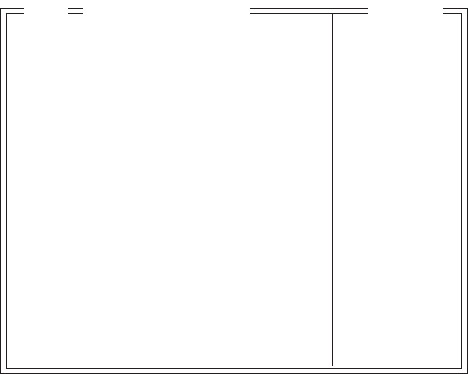
Chapter 6: Tekterm Application
Emulation
230Psion Teklogix 7530 Hand-Held Computer User Manual
3274/Telnet Emulation
Fujitsu Host
If this parameter is set to ‘Y’, data is sent in Fujitsu format. Enabling ‘Fujitsu Host’
causes the standard IBM formatting codes (for start of field, setting buffers, etc.) to
be replaced by the codes used by Fujitsu host computers.
Intl EBCDIC
If this parameter is enabled (set to ‘Y’), the ‘international’ EBCDIC character set is
used, swapping the positions of the ! and ] characters.
Nulls in Fields
Setting this parameter to ‘Y’ allows ‘null’ characters – e.g., hyphens (-) or periods
(.) – to fill in empty entry fields.
IP for SysReq
When the system request key is pressed, a Telnet “Interrupt Process” command is
generated. The “Interrupt Process” command is sent to the host in place of the
standard mechanism used to send the system request key press to a host using
Telnet.
Fujitsu Host N Y/N
Intl EBCDIC N Y/N
Nulls in Fields N Y/N
IP for SysReq N Y/N
BRK for Attn N Y/N
LU Name Enabled N Y/N
LU Name see text
Features » see text
FKEY0-7 » see text
FKEY8-15 » see text
FKEY16-23 » see text
FKEY24-31 » see text
FKEY32-39 » see text
Emulation Range
05

Psion Teklogix 7530 Hand-Held Computer User Manual231
Chapter 6: Tekterm Application
Emulation
BRK for Attn
When the attention key is pressed, a Telnet “Break” command is generated. This
command is sent to the host in place of the standard mechanism used to send the
attention key press to a host using Telnet.
LU Name Enabled
If enabled (set to ‘Y’), this parameter allows the 7530 to negotiate a specific device
name for itself.
LU Name
The value assigned in this field is used when the “LU Name Enabled” parameter
(see above) is set to ‘Y’. The current terminal number is appended to the name to
generate a unique device name (for example, LUA00001).
Features – 3274/Telnet
These parameters are identical to those described for 2392/Telnet. Refer to
"Features – 2392/Telnet" beginning on page 228.
Clear Entry Fields N Y/N
Passthru Printing N Y/N
AIAG Character 0 0-255
Barcode Character 0 0-255
Serial IO Character 0 0-255
Fixed Field Ovrhd 5 0-80
Enable Alarm N Y/N
Command Region Up 0 0-24
Command Region Down 0 0-24
Command Region Left 0 0-80
Command Region Right 0 0-80
Features Range
06
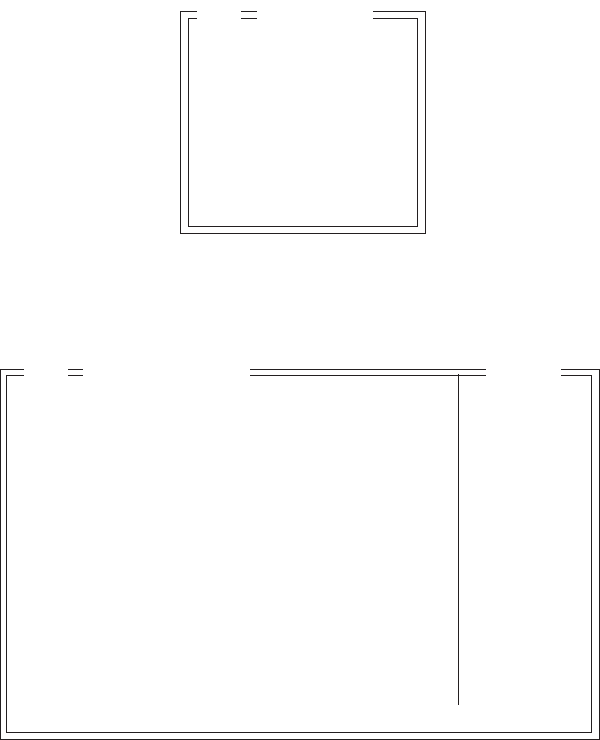
Chapter 6: Tekterm Application
Emulation
232Psion Teklogix 7530 Hand-Held Computer User Manual
FKEY0-7, FKEY8-15, FKEY16-23, FKEY24-31 And FKEY32-39
The sub-menus attached to these parameters allow you to map the 7530 function
keys.
5250/Telnet Emulation
WEC (Write Error Code)
This parameter determines the type of WEC used. If set to “advisory”, a TESS
advisory message is generated when the host sends a WEC command to the 7530.
Otherwise, if set to “screen text”, the 7530 locks the keyboard and displays the error
message contained in the WEC command on the screen at the line specified by the
host. In this case, the 7530 must be unlocked manually using the function key
mapped to RESET.
FKEY0 ENTER
FKEY1 F1
FKEY2 F2
FKEY3 F3
FKEY4 F4
FKEY5 F5
FKEY6 F6
FKEY7 F7
06 FKEY0-7
WEC Advisory see text
Remap Underline to None see text
Intl EBCDIC N Y/N
Nulls in Fields Y Y/N
Term Type IBM-5251-11 see text
Virtual Dev Enable N Y/N
Virtual Dev Prefix see text
Features » see text
FKEY0-7 » see text
FKEY8-15 » see text
FKEY16-23 » see text
FKEY24-31 » see text
FKEY32-39 » see text
Emulation Range
05
Psion Teklogix 7535 Hand-Held Computer User Manual 233
Chapter 6: Tekterm Application
Emulation
Remap Underline To
This parameter allows you to remap the underline cursor to: blink, bold or
reverse.
Intl EBCDIC
If this parameter is enabled (set to ‘Y’), the ‘international’ EBCDIC character set is
used, swapping the positions of the ! and ] characters.
Nulls In Fields
Setting this parameter to ‘Y’ allows ‘null’ characters – e.g., hyphens (-) or periods
(.) – to fill in empty entry fields.
Term Type
The value assigned for this parameter – IBM-5555-001 or IBM-5251-11 – indicates
the type of terminal to report during the Telnet negotiations. It determines how the
AS/400 host treats the terminal. IBM-5251-11 is a standard 5250 terminal. IBM-
5555-001 is a Korean language terminal.
Virtual Dev Enabled
If enabled (set to ‘Y’), this parameter allows the 7530 to negotiate a specific device
name for itself.
Virtual Dev Prefix
The prefix assigned in this field is used when the “Virtual Dev Enabled” parameter
(see above) is set to ‘Y’. The current terminal number is appended to the prefix to
generate a unique device name. You can assign up to 10 upper-case alphanumeric
characters in this field.
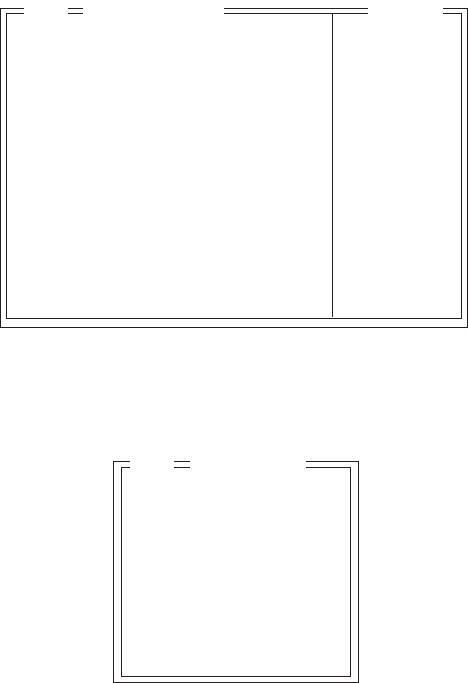
Chapter 6: Tekterm Application
Emulation
234Psion Teklogix 7530 Hand-Held Computer User Manual
Features – 5250/Telnet
These parameters are identical to those described for 2392/Telnet. Refer to
"Features – 2392/Telnet" beginning on page 228.
FKEY0-7, FKEY8-15, FKEY16-23, FKEY24-31 And FKEY32-39
The sub-menus attached to these parameters allow you to map the 7535 function
keys.
Clear Entry Fields N Y/N
Passthru Printing N Y/N
AIAG Character 0 0-255
Barcode Character 0 0-255
Serial IO Character 0 0-255
Fixed Field Ovrhd 5 0-80
Enable Alarm N Y/N
Command Region Up 0 0-24
Command Region Down 0 0-24
Command Region Left 0 0-80
Command Region Right 0 0-80
Features Range
06
FKEY0 ENTER
FKEY1 F1
FKEY2 F2
FKEY3 F3
FKEY4 F4
FKEY5 F5
FKEY6 F6
FKEY7 F7
06 FKEY0-7

Psion Teklogix 7530 Hand-Held Computer User Manual235
Chapter 6: Tekterm Application
Ports– Tether And Console
6.19 Ports– Tether And Console
6.19.1 Tether And Console Port Peripheral Options
The “Tether Port” and “Console Port” options allow you to enable, disable and
specify the accessories attached to these ports. Both the Tether Port and the Console
Port have the same options. These are: Disabled, Serial, Console, Printer
and Scan-See.
To scroll through the options for each port:
• Press the <RIGHT> or <LEFT> arrow key.
These ports operate differently depending on the accessories selected.
• Disabled – indicates that the serial port is not being used.
• Serial – standard serial port.
• Console – used to connect another PC to the 7535. A communication
program is required so that communication can proceed between the 7535
and the PC.
• Printer – all TESS print operations are directed to the port. All ANSI media
copy operations to the “primary port” are directed to this port.
• Scan-See – TESS and ANSI accepts input from the Scan-See through the
Tether or Console port.
Tether Port Console
Settings 1 »
Console Port Disabled
Settings 2 »
Ports
03
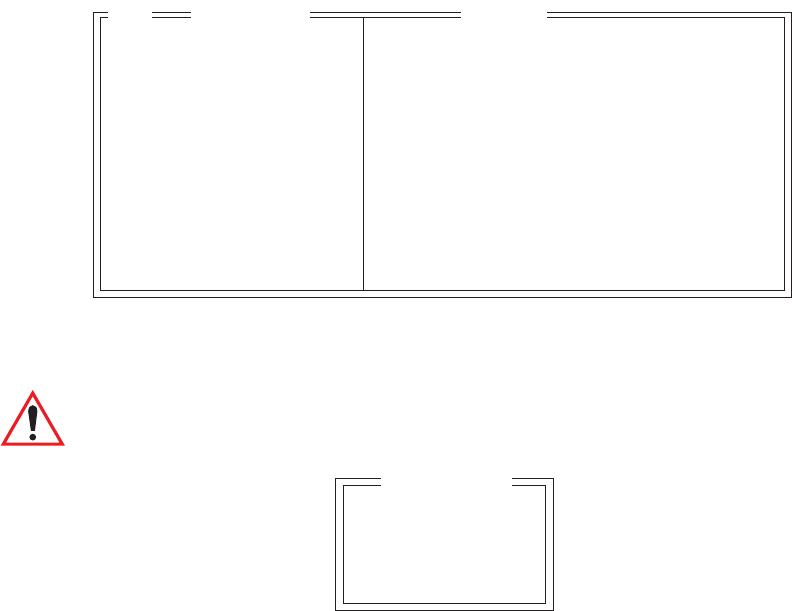
Chapter 6: Tekterm Application
Tether And Console Port Parameter Settings
236Psion Teklogix 7530 Hand-Held Computer User Manual
6.19.2 Tether And Console Port Parameter Settings
The parameters for the “Tether Port” and “Console Port” are identical.
Character Set
These menus define the character set for the 7530 port.
Important: When a character sent from the host cannot be displayed, a
right arrow character is used as a substitute.
This menu contains all the character sets available with your Psion Teklogix
computer. In this menu, the “Y” or “N” are used to visually guide you to the selected
character set. For example, in the sample menu above, the “Y” next to IBM
indicates that a character set has been chosen from this group.
Character Set » see text
Baud 9600 see text for range of baud rates
Data Bits 8 6..8
Parity none none odd even mark space
Stop Bits 1 1, 1.5, 2
Flow Ctrl None None Software Hardware Both
Buffer 512 1..2048
Retries 3 1..100
Input Tmo 2 1..100
Output Tmo 5 1..100
Test Y Y/N
Settings Range
04
ISO N »
IBM Y »
DEC N »
Misc. N »
Char Set

Psion Teklogix 7530 Hand-Held Computer User Manual237
Chapter 6: Tekterm Application
Tether And Console Port Parameter Settings
Choosing A Character Set
To choose a character set:
• Position the cursor on the appropriate item – for example, ISO – and press
<F1> to display the character set options.
• To activate a character set, press the <RIGHT> or <LEFT> arrow key to set
it to “Y”.
Important: If you choose a Chinese character set from the ‘Misc.’ menu and
a character sent from the host cannot be displayed on the screen,
a shaded box character is used as a substitute.
If you are using a Korean character set, a right arrow character is
used as a substitute.
Baud
This parameter determines the bit rate of the port. Allowable values include: 110
300 600 1200 2400 4800 9600 14.4kbps 19.2kbps 38.4kbps
56.0kbps 57.6kbps 115.2kbps 128.0kbps or 256.0kbps.
Data Bits
This parameter determines the number of bits for the data going through this port.
Possible values are: 6, 7, 8.
Parity
This parameter determines the type of parity checking used on the data going
through the port. The options are: none, odd, even, mark and space.
Stop Bits
This parameter specifies the number of stop bits – 1, 1.5, 2 – used for
asynchronous communication.
Flow Control
This parameter selects the type of flow control used in your hand-held computer.
The 7535 can perform Software or Hardware handshaking, or you can
choose Both to enable both of these options.
The function of each mode is as follows:
Enable: Used to input and output data.

Chapter 6: Tekterm Application
Tether And Console Port Parameter Settings
238Psion Teklogix 7530 Hand-Held Computer User Manual
Supports XON/XOFF or no handshaking.
Print: Used to output data only. All input characters except XON and
XOFF are ignored.
Supports XON/XOFF or no handshaking.
Output: Used to output data only. All input characters are ignored.
Supports no handshaking.
Note: To enable the input and/or output, ‘serial in’ and/or ‘serial out’ must be
enabled in the TESS menu.
Buffer
The value assigned to this parameter determines the size of the serial buffer used by
the application for both input and output. The buffer controls the amount of data the
application can send to or receive from a serial device.
Retries
This parameter determines the number of times the 7530 attempts to transmit a byte
from the serial port. If the count specified in this parameter is exceeded, the
transmission fails.
Input Tmo
This parameter sets the time in tenths of a second that the 7530 waits before passing
received data to the TESS or ANSI tasks.
Output Tmo
The value assigned at this parameter determines the maximum number of
milliseconds that the application will wait for a ‘write’ sent to the port to succeed
before it is aborted. The ‘write’ may be one or several bytes in length.
Test
When this parameter is enabled (set to “Y”), data is output through the serial port to
make certain that it is operating appropriately.
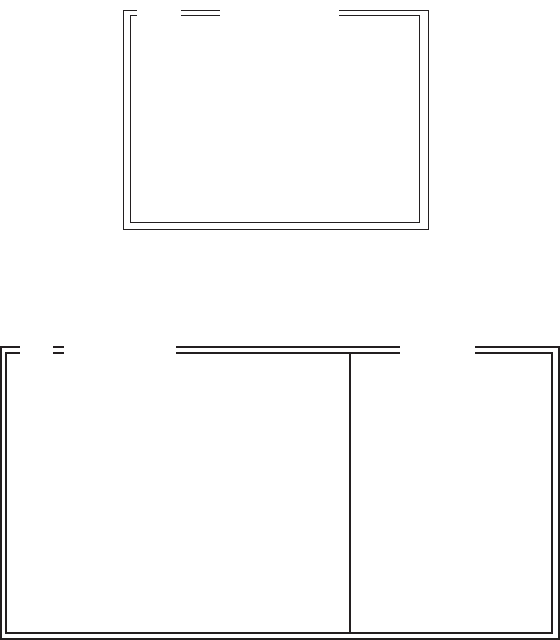
Psion Teklogix 7530 Hand-Held Computer User Manual239
Chapter 6: Tekterm Application
Tether And Console Port Scan-See Parameters
6.19.3 Tether And Console Port Scan-See Parameters
When ‘Scan-See’ is specified as the peripheral for either the Tether or the Console
port, the parameters listed under the “Scan-See” sub-menu are used to tailor the
operation of this type of scanner. The other parameters listed in this menu –
“Character Set”, “Baud” and so on – are identical to those described beginning on
page 235.
6.19.3.1 Scan-See Sub-Menu – Mapping The Viewport
Character Set »
Baud 9600
Data Bits 8
Parity none
Stop Bits 1
Retries 3
Input Tmo 2
Scan-See »
Scan See
05
Anchor Line 1 0...1
Anchor Column 19 0...19
Follow Cursor Y Y/N
Line Offset 0 -25...25
Column Offset 0 -80...80
Wraparound N Y/N
Panning Y Y/N
Line Scrolling N Y/N
Brightness 3 0 to 5
Arrows Bright Bright Horz Vert
Version 2 0...2
XON/XOFF Y Y/N
05 Scan-See Range

Chapter 6: Tekterm Application
Scan-See Sub-Menu – Mapping The Viewport
240 Psion Teklogix 7535 Hand-Held Computer User Manual
The Scan-See display is mapped to a specific area on the 7535 screen – called
the viewport – and is continuously updated to reflect that portion of the screen. The
Scan-See viewport is defined as follows:
Anchor Line/Anchor Column
A location on the Scan-See display – the anchor – is chosen as a reference point.
Line Offset/Column Offset
A predefined displacement – the offset – is added to the location of the 7535 cursor
to create a point – the pivot. This pivot is mapped to the anchor, and whatever is
displayed in its vicinity is also displayed on the Scan-See.
For example:
• the anchor is chosen as (9,0) whereas “9” is the column and “0” is the line
(on the Scan-See display)
• the offset is chosen as (4,2)
• the cursor on the 7535 is currently located at (7,5)
• the pivot would thus be located at (7+4, 5+2) or (11,7)
• and so the area displayed on the Scan-See will be:
(11–9,7–0) to (11–9+9,7–0+1) or (2,7) to (11,8). 1
1These computations assume that “Wraparound” (described on page 242) is disabled
(set to “N”) and that “Follow Cursor” (described on page 242) is enabled (set to “Y”).
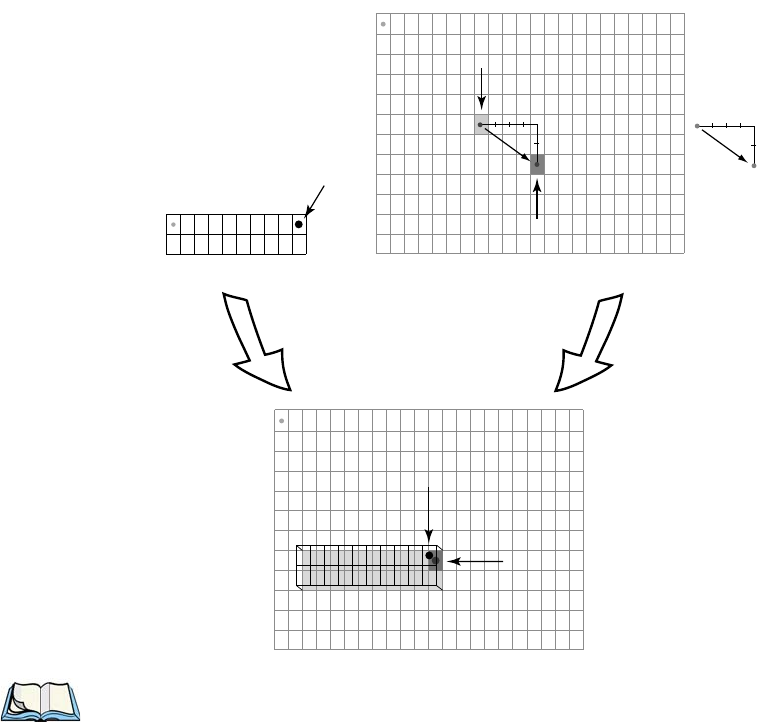
Psion Teklogix 7535 Hand-Held Computer User Manual 241
Chapter 6: Tekterm Application
Scan-See Sub-Menu – Mapping The Viewport
Note: To enter negative values, press the “-” (minus) key and then, type the
number you want to use.
The <LEFT> arrow key can also be used to decrement the value assigned
to the parameter. Each time the <LEFT> arrow is pressed, the number is
decremented by one. For example, to enter a value of “–5”, start from
zero and press the left arrow key five times.
(9,0)
anchor
Scan-See Display Terminal Display
superimposing
the anchor on the pivot
anchor
pivot
(11, 8)
(11, 7)
Scan-See Viewport
(2,7)
(11, 7)
offset
+4
+2
(4,2)
offset
+4
+2
terminal
cursor
pivot = + offset
(7,5)
terminal cursor
(0,0)
0123456789101112131415161718192021 . . .
(0,0)
0
1
2
3
4
5
6
7
8
9
10
11
. . .
0123456789101112131415161718192021 . . .
0
1
2
3
4
5
6
7
8
9
10
11
. . .
0123456789
0
1
(0,0)

Chapter 6: Tekterm Application
Scan-See Sub-Menu – Mapping The Viewport
242Psion Teklogix 7530 Hand-Held Computer User Manual
Follow Cursor
When the “Follow Cursor” parameter is disabled (set to “N”), the cursor is always
assumed to be located at the origin. Using the previous example:
•the area displayed will be (4–9,2–0) to (4–9+9, 2–0+1), or, after clipping
values that are negative or higher than 80: (0,2) to (4,3).
Wraparound
When “Wraparound” is enabled (set to “Y”), the Scan-See display is treated as a
one-line by 20 column display, rather than 2 lines by 10 columns.
Panning
If “Panning” is disabled (set to “N”), the Scan-See viewport does not move when the
cursor moves one position to the right, and the pivot is still inside the Scan-See
display. However, the Scan-See display is updated to reflect the changes within that
viewport. If the pivot goes outside the viewport, or if the 7535 display changes
without the cursor being moved, the viewport is re-synchronized to coincide
the pivot with the anchor.
Line Scrolling
When “Line Scrolling” is enabled (set to “Y”), the Scan-See display is treated as
two separate one line by 10 column displays. The top line always displays the
previous value of the bottom line. In an application where the cursor skips from one
entry field to another, the field that the cursor just entered is displayed on the top
line, and the next field is displayed at the bottom.
Note: When this feature is enabled (set to “Y”), the “Panning” option should be
disabled to prevent updates to both lines after every keystroke
Brightness
The “Brightness” parameter controls the backlight brightness of the display. It only
has an effect on Model 7000 Scan-Sees – scanners equipped with LED (light
emitting diode) displays.
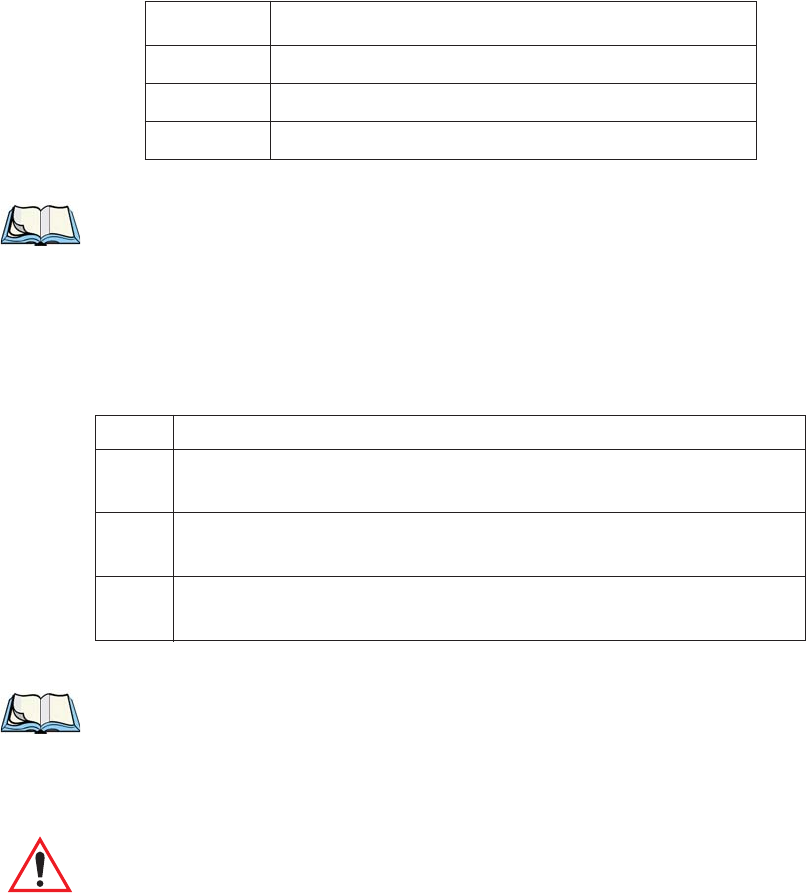
Psion Teklogix 7530 Hand-Held Computer User Manual243
Chapter 6: Tekterm Application
Scan-See Sub-Menu – Mapping The Viewport
Arrows
The “Arrows” parameter assigns one of three possible functions to the two arrow
keys on the Scan-See keyboard:
Table 6.6 “Arrow” Parameter Options
Note: For “Horiz” and “Vert,” changing the offset will take affect only after the
7535 display has been updated.
Version
Scan-See units with serial numbers that read 1594120224 or higher contain
firmware that implements a different communication protocol with the 7535
than older units. The “Version” numbers represent the following unit versions:
Table 6.7 Scan-See Versions
Note: To interface the 7535 to the Scan-See units with older firmware
(serial number lower than 1594120224), set “Parity = space”;
all other parameters are identical to the newer firmware.
XON/XOFF
Important: IF YOU ARE USING TRANSCEIVERS WITH YOUR
SCAN-SEE, this parameter must be set to “Y”.
Value Function
“Bright”Arrow keys control Scan-See display brightness
“Horiz”Arrow keys control “Column Offset”
“Vert”Arrow keys control “Line Offset”
Value Scan-See Version
0•First LED version – up to serial number 1594080275; these are
encased in grey plastic.
1•Model 7000 LED units – versions after the serial number above;
these are also encased in grey plastic.
2•Metrologic 7000M LCD units; these are encased in grey plastic.
•Psion Teklogix 7000M LCD units; these are encased in black plastic.

Chapter 6: Tekterm Application
Scan-See Keyboard Mapping
244Psion Teklogix 7530 Hand-Held Computer User Manual
When this parameter is set to “Y”, the XON and XOFF characters are not passed to
the TESS or ANSI tasks. A received XOFF character stops the serial port from
transmitting. A received XON character starts the serial port transmissions again.
6.19.3.2 Scan-See Keyboard Mapping
•Digits (0-9) are passed verbatim
•The CLR key forces a sign-on message and display refresh. This only
occurs when CLR is pressed and the CLR key on the display is pressed,
then released.
•The three F-keys are mapped to F1, F2 and F3, respectively.
•The ENT key is mapped to the carriage-return (‘\r’) character.
•The two arrow keys are handled locally, and control the brightness, and the
line and column offsets, as described on page 242.
•Bar-code data is stripped off any identifying headers (symbology, etc.)
and passed verbatim.
The Scan-See is capable of displaying only a subset of the default PC-8 ASCII
character set. Any characters that cannot be displayed are currently translated to ‘.’.
6.20 Network
Ctrl Panel »
802.IQv2 »
Network
03
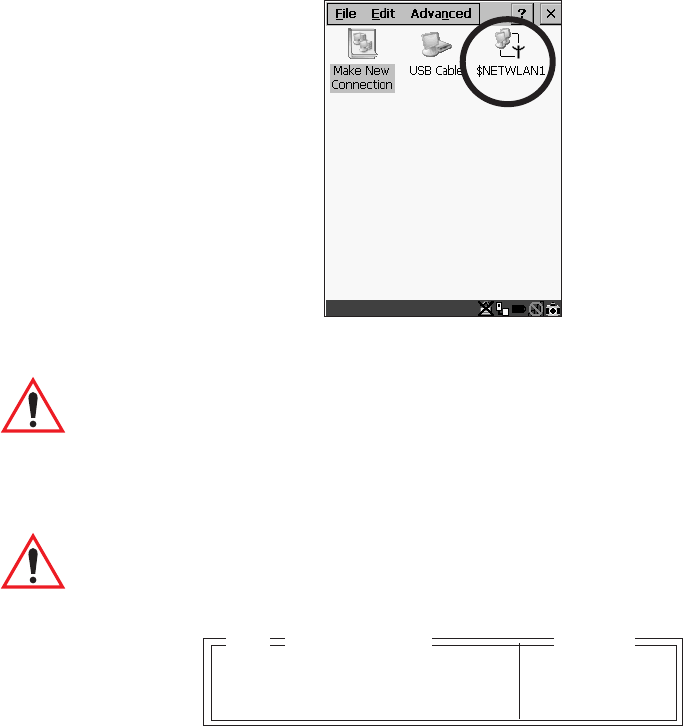
Psion Teklogix 7530 Hand-Held Computer User Manual245
Chapter 6: Tekterm Application
Network Ctrl Panel Settings
6.20.1 Network Ctrl Panel Settings
This option displays a Windows CE screen where you can set up your radio, launch an
existing network connection or create a new connection. The radio icon
(NETWLAN1in the sample screen) in this window is used to configure the radio
installed in the 7530
Figure 6.11 Network Settings
Important: Follow the steps outlined in “Configuring An IEEE 802.11 Radio
Installed In The 7530” on page 18 for details about configuring
your radio.
6.20.2 802.IQ v2
Important: For setup information about 802.IQ v2, refer to the “9400 and
9450 Network Controllers User Manual” and/or the “9150
Wireless Gateway User Manual”.
Port 8888 see text
More Parameters » see text
802.IQ v2 Range
04
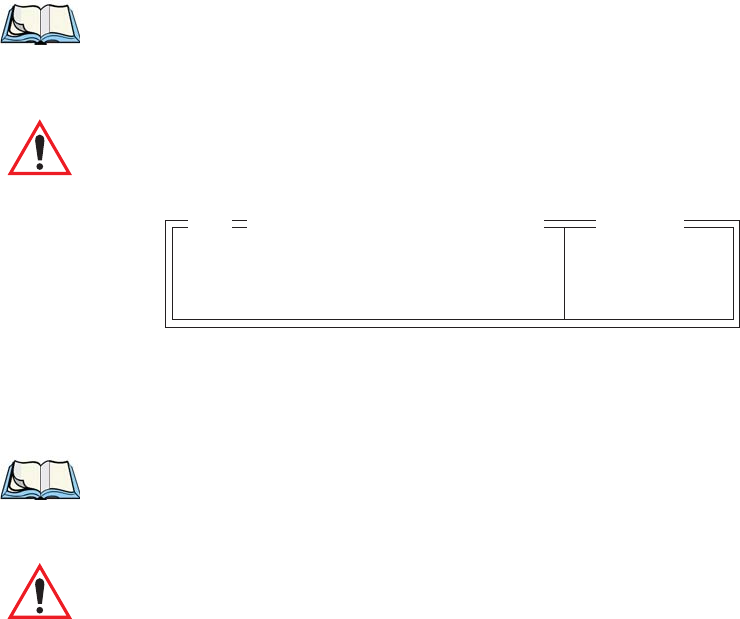
Chapter 6: Tekterm Application
802.IQ v2
246Psion Teklogix 7530 Hand-Held Computer User Manual
Port
“Port” specifies the UDP port used by 802IQ v2. The default value is 8888. Keep in
mind that the value assigned here must match the value set at the network controller.
Note: When using 802.IQ v2, make certain that the 7530 “Net Mask” matches
the network controller net mask.
More Parameters
Important: The 802.IQ radio items listed in this menu are only available to
Psion Teklogix personnel.
Auto Radio Addr
If this parameter is set to “Y”, the 7530 requests an automatically assigned radio
address.
Note: If ‘Auto Radio Addr’ is enabled (set to “Y”), any value assigned to the
‘Radio Address’ parameter is ignored.
Radio Address
Important: “Radio Address” only takes effect when “Cellular” is
enabled (set to “Y”).
The value entered in the “Radio address” parameter is used to identify the 7535
hand-held over the radio link. A unique value from 1 to 3840 must be assigned for
each 7530.
Auto Radio Addr Y Y/N
Radio Address 0 1 to 3840
Initial RTT 100 500...5000
802.IQ v2 Parameters Range
05
Psion Teklogix 7530 Hand-Held Computer User Manual247
Chapter 6: Tekterm Application
802.IQ v2
Initial RTT (Round Trip Time)
Round trip time is the elapsed time between a 7530 hand-held computer transmis-
sion and an access point acknowledgement. Each 7530 continuously adjusts the
acceptable round trip time, calculating the average elapsed time over a number of
transmissions. If an acknowledgement takes longer to receive than the average
round trip time calculated, the 7530 will resend the transmission.
Because 7530s cannot calculate an average round trip time without a number of
transmissions, a starting point or “Initial Round Trip Time” is required. The 7530
uses the time assigned to the “Initial RTT” parameter as a starting value for round
trip calculations. Once the 7530 begins transmitting and receiving data, this value
will be adjusted to reflect the actual average round trip time between transmissions
and acknowledgements.

Psion Teklogix 7530 Hand-Held Computer User Manual249
PERIPHERAL DEVICES & ACCESSORIES7
7
7.1 External Bar Code Readers..........................251
7.1.1 PowerScan™ Standard, LR and XLR Bar Code Scanners ......251
7.1.2 Entering Data With The Bar Code Reader...............251
7.2 The 7530 Battery ...............................251
7.2.1 Lithium-Ion Battery Safety Precautions ................252
7.3 Important Charger Safety Instructions ....................253
7.4 Chargers ...................................254
7.5 Gang Charger.................................254
7.5.1 Installation ...............................255
7.5.2 Operator Controls ...........................255
7.5.3 Charge Indicators ...........................256
7.5.4 Charging Batteries ...........................256
7.5.5 Troubleshooting ............................257
7.5.5.1 Excessive Charge Duration ...................257
7.5.5.2 Indicator Flashing Red .....................257
7.5.5.3 Power LED Does Not Light Up.................257
7.5.5.4 Indicator Does Not Light When Battery Installed .......258
7.6 Combo Charger................................258
7.6.1 Installation ...............................258
7.6.2 Operator Controls ...........................259
7.6.3 Using the Combo Charger With The 7530...............259
7.6.4 Charging The Spare Battery ......................259
7.6.5 Charge Indicators ...........................260
7.6.6 Troubleshooting ............................260
7.7 Combo Dock .................................261
7.7.1 Installation ...............................261
7.7.2 Using The Combo Dock ........................261
7.7.3 Network Access ............................261
Chapter 7: Peripheral Devices & Accessories
250Psion Teklogix 7530 Hand-Held Computer User Manual
7.7.4 Troubleshooting.............................262
7.8 Quad Dock ..................................262
7.8.1 Installation ...............................262
7.8.2 Indicators And Controls ........................263
7.8.3 Using The Quad Dock .........................263
7.8.4 Network Access.............................263
7.8.4.1 Network Addressing ......................263
7.8.5 Battery Charging ............................263
7.8.6 Troubleshooting.............................264
7.8.6.1 Network Link Unsuccessful ..................264
7.8.6.2 7530 LED Does Not Light When Docked...........264
7.9 Portable Docking Module (PDM) ......................264
7.10 Bluetooth Peripherals ............................268
7.11 The 7535 Picker Cradle ...........................268
7.11.1 Picker Cradle Mounting Recommendations .............269
7.11.1.1 Mounting Template ......................269
7.11.2 Wiring Guidelines ...........................270
7.11.3 Using The Picker Cradle .......................270
7.11.4 Maintaining The Picker Cradle ....................270
7.11.5 Powered Cradle Installation In High Voltage Vehicles ........271
7.11.5.1 Extreme Wet Environments..................271
7.11.6 Powered Cradle Installation ......................272
7.11.6.1 Wiring Vehicle Power To The Cradle.............273
7.11.7 The Port Replicator ..........................274

Psion Teklogix 7530 Hand-Held Computer User Manual251
Chapter 7: Peripheral Devices & Accessories
External Bar Code Readers
7.1 External Bar Code Readers
7.1.1 PowerScan™ Standard, LR and XLR Bar Code Scanners
Note: Refer to “SE1200 High Performance & Long Range Specs” on page 281
for detailed specifications.
The 7530 supports Psion Teklogix’ PowerScan™ industrial bar code scanner with
standard, long range and extra long range options.
To connect this scanner to the 7530, attach the device to the tether port at the upper-
right side of the 7530. Before using the bar code reader, you may need to change
some parameters. For details, review “Scanner Properties Setup” on page 118 and
“Bar Codes” on page 121.
7.1.2 Entering Data With The Bar Code Reader
Note: For helpful scanning tips, refer to “Scanning Techniques” on page 49.
When a label is scanned successfully, the 7530 will beep if configured appropriately
and the scan LED will flash. Occasionally, the bar code labels are poorly printed or
damaged and cannot be read properly. In this case, use the keyboard to enter data
from the label.
7.2 The 7530 Battery
Note: Battery specifications are detailed in“Lithium-Ion Battery Pack” on
page 288.
7530 Lithium-Ion batteries operate for a minimum of ten hours1 after a charge.
These batteries do not require conditioning. Typical battery life is 300 cycles or 3
years average use. A full charge is completed in 4 hours with a typical charge time
of 1.5 hours.
1Times are approximate and may vary depending on operating conditions.

Chapter 7: Peripheral Devices & Accessories
Lithium-Ion Battery Safety Precautions
252Psion Teklogix 7530 Hand-Held Computer User Manual
7.2.1 Lithium-Ion Battery Safety Precautions
Important: It is critical that this safety information be reviewed and that all
warnings be strictly followed.
Warning: BATTERIES ARE CONSIDERED HAZARDOUS WASTE and
must be returned to Psion Teklogix for proper disposal. All used
batteries must be forwarded to one of the following offices:
Psion Teklogix Inc. Psion Teklogix Corp.
2100 Meadowvale Blvd. 1810 Airport Exchange Blvd.
Mississauga, Ontario Suite 500
Canada Erlanger, Kentucky
L5N 7J9 USA 41018
Psion Teklogix S.A.
La Duranne; 135 Rue Rene Descartes; BP 421000
13591 Aix-En-Provence
Cedex 3; France
Warning: TO PREVENT the battery from leaking acid, generating heat or
exploding, adhere to precautions listed below.
•The battery incorporates built-in safety devices. To ensure
their proper function, do not disassemble or alter any parts
of the battery.
•Do not short-circuit the battery by directly connecting any of the exposed
terminals with metal objects such as wire. Do not transport or store the
battery together with metal objects such as necklaces, hair pins, etc.
•Do not dispose of batteries in fire.
•Do not use or leave the battery near a heat source such as a fire
or heater.
•Do not immerse the battery in water.
•When charging, use the battery charger specifically designed for
the battery.
•Do not pierce, strike, throw or step on the battery.
•Do not directly solder the battery.
•Do not connect the battery to an electrical outlet, vehicle
cigarette lighter, etc.
•Do not put battery into a microwave oven or pressurized container.
•Do not use the battery in combination with primary batteries (such as
dry-cell batteries) or batteries of different capacities or brands.
•Immediately remove the battery from the device or battery charger
and stop use if the battery gives off an odor, generates heat, becomes
discoloured or deformed, or in any way appears abnormal during use.

Psion Teklogix 7530 Hand-Held Computer User Manual253
Chapter 7: Peripheral Devices & Accessories
Important Charger Safety Instructions
•Do not continue charging the battery if it does not recharge within the
specified charge time.
•The battery may burst or ignite if the battery leaks. Always ensure that it
is away from any exposed flames.
•If leaking electrolyte sprays into your eyes, rinse them with clean
running water, and immediately seek medical attention.
•Do not store the battery in extremely high temperatures (e.g., a vehicle,
strong direct sunlight, etc.). This may cause the battery to overheat
or ignite, and it may also reduce the performance and service life of
the battery.
•Do not use in areas where static electricity is greater than what the
manufacturer guarantees.
•Keep batteries out of reach of children.
7.3 Important Charger Safety Instructions
•SAVE THESE INSTRUCTIONS – This manual contains important safety and
operating instructions for battery charger s.
•Before using the battery charger, read all instructions and cautionary
markings on (1) battery charger, (2) battery, and (3) product using battery.
•The mains power cord shall comply with national safety regulations of the country
where the equipment is to be sold.
•Use of an attachment not recommended or sold by the battery charger
manufacturer may result in fire, electric shock, or personal injury.
•To reduce risk of damage to the electric plug and cord when unplugging the
charger, pull the plug rather than the cord.
•Make sure the cord is positioned so that it is not stepped on, tripped over,
or otherwise subjected to damage or stress.
•Do not operate the charger with a damaged cord or plug.
Replace immediately.
•Do not operate the charger if it has received a sharp blow, been dropped, or other-
wise damaged in any way; it should be inspected by qualified service personnel.
•Do not disassemble the charger; it should be repaired by qualified service person-
nel. Incorrect reassembly may result in electric shock or fire.
•To reduce risk of electric shock, unplug the charger from the outlet before
attempting any maintenance or cleaning.
•An extension cord should not be used unless absolutely necessary. Use of an
improper extension cord could result in fire or electric shock.
If an extension cord must be used, make sure:
•The plug pins on the extension cord are the same number, size,
and shape as those on the charger.

Chapter 7: Peripheral Devices & Accessories
Chargers
254Psion Teklogix 7530 Hand-Held Computer User Manual
•The extension cord is properly wired and in good electrical
condition and that the wire size is larger than 16 AWG.
•Do not expose the charger to rain or snow.
•Do not place batteries in the charger if they are cold from extended
exposure to a freezer or outside temperatures below 10°C (50°F). Allow them to
warm up to room temperature for at least two hours.
•Do not use the charger if, after an overnight charge, any of the batteries feel warmer
than the charger housing. The charger should be inspected by
qualified service personnel.
•Do not use the charger if any of the batteries or the charger get more than luke-
warm. The equipment should be inspected by qualified personnel.
7.4 Chargers
Note: Initially, new batteries that have been fully charged may indicate less than
100% charge. No special conditioning is required. The full capacity of the
battery will reach 100% after 5 cycles through the charger.
It can take from 1.5 to 4 hours to charge a battery. The 7530’s intelligent charging
system protects the battery from over-charging by terminating the charge process
when the battery is at maximum capacity.
Important: To preserve battery integrity, the charger will proceed with a
charge only when the battery temperature falls between 0˚ C and
39˚ C (32˚ F to 102˚ F). If the battery is too hot or cold, the battery
status LED flashes yellow and the charge is suspended.
7.5 Gang Charger
The gang charger is designed to charge up to six 7530 Lithium-Ion batteries at one
time. Your charger is shipped with the appropriate IEC mains power cord. If the
supplied power cord is incorrect for your country, contact Psion Teklogix for
assistance (see Appendix A: Support Services And Worldwide Offices).
Note: The gang charger is shipped with a user manual. It is critical that this
manual be reviewed for additional information and updates.
Psion Teklogix 7530 Hand-Held Computer User Manual255
Chapter 7: Peripheral Devices & Accessories
Installation
7.5.1 Installation
The gang charger can be wall mounted using the wall mount kit – PN 1010039 – or
it can be operated on a flat surface. Install the charger in an area that is free from
excessive dirt, dust and contaminants. The ambient temperature must be in the range
0˚ C to 39˚ C (32˚ F to 102˚ F). The charger will not charge batteries outside
of this temperature range. For maximum performance, it is recommended that
the charger be operated at room temperature – a temperature range between
18˚ C to 25˚ C (64˚ F to 77˚ F).
The charger can consume up to 2A @ 120VAC or 1A @ 240VAC. Check to ensure
the mains circuit supplying the charger is adequate for this loading (especially if
several chargers are being powered from the same circuit).
After unpacking the unit:
•Visually check the charger for damage.
•Install the IEC power cord and apply power.
A green indicator in the lower-right lights to indicate power is present. All charge
indicators flash momentarily at powerup to indicate that the charger is ready for
operation.
If you choose to wall mount the charger, follow the instructions packaged with the
mounting bracket kit. Be sure to locate the charger in an area where there is no risk
of injury to persons walking in the vicinity.
7.5.2 Operator Controls
The gang charger does not have operator controls or a power switch.
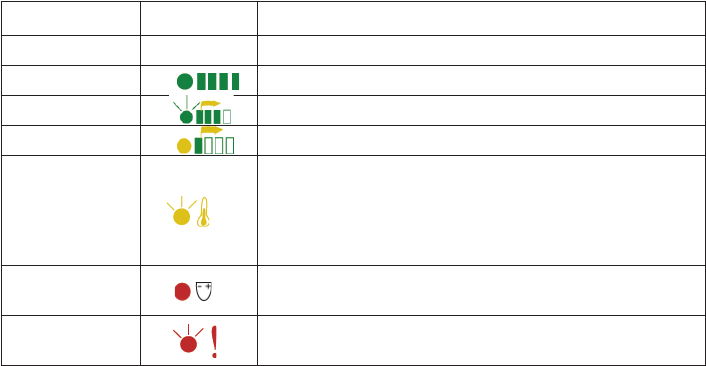
Chapter 7: Peripheral Devices & Accessories
Charge Indicators
256Psion Teklogix 7530 Hand-Held Computer User Manual
7.5.3 Charge Indicators
Each battery charge slot is equipped with a tri-coloured LED to indicate the charge
status of the battery. When 7535 batteries are inserted in the charger, the colour and
behaviour of the LEDs associated with the charge wells in use indicate the status of
the charge.
Table 7.1 Gang Charger Indicators
7.5.4 Charging Batteries
•Install the battery with the battery contacts facing the charger. Slide the
battery between the guide rails until it lightly latches in place.
The LED directly below the slot in which a battery is inserted lights up immediately.
A solid yellow LED indicates that the battery is being charged. If the battery
temperature is outside 0˚ C to 39˚ C (32˚ F to 102˚ F), the LED flashes yellow until the
temperature is acceptable. A fully discharged battery will normally take between 1.5
and 4 hours to charge. When the battery charge reaches 75%, the indicator flashes
green. At full capacity, it turns solid green.
When the battery is fully charged, the charger stops applying power; the battery
cannot be overcharged if left in the charger slot. The 75% charge indicator is handy
if you need a quick recharge – it often occurs after less than an hour.
LED Behaviour Icon Charge Status
Off No battery detected in the slot.
Solid green Battery is fully charged.
Flashing green Battery is charged to 75% capacity.
Solid yellow Charge in progress.
Flashing
yellow
Battery temperature out of charge range between 0˚ C
to 39˚ C (32˚ F to 102˚ F). This icon indicates that the
charger is waiting to charge. Charging is attempted
every five minutes until the battery is within the appro-
priate temperature range.
Solid red Battery rejected (at insertion) or unable to complete
charge on battery
Flashing red Charging circuit problem. Refer to “Troubleshooting”
on page 257.
Psion Teklogix 7530 Hand-Held Computer User Manual257
Chapter 7: Peripheral Devices & Accessories
Troubleshooting
7.5.5 Troubleshooting
7.5.5.1 Excessive Charge Duration
The charger is equipped with a recalibration function – a function that fully
discharges and then fully recharges the battery. This process is necessary to
recalibrate the battery capacity gauge internal to the battery. The charger attempts
recalibration when:
•the battery capacity is at less than 30%, and
•the battery has undergone more than 40 partial charge cycles since the last
full discharge.
A complete battery discharge takes between 1.5 and 4 hours to complete. When in
discharge mode, the LED indicator flashes yellow. The recalibration function
extends the charge time by up to 2 hours.
7.5.5.2 Indicator Flashing Red
If the indicator flashes red:
•Remove all batteries and disconnect the mains power cable.
•Wait at least 20 seconds, and then plug the cable in again.
If any of the charge slot LEDs continue to flash red, the charger is defective and
requires service. If all indicators are flashing red, there is a power supply problem
and the charger requires service.
7.5.5.3 Power LED Does Not Light Up
•Remove all batteries, and unplug the charger.
•Connect another device to the mains outlet to ensure there is power.
•Remove the IEC mains power cable from the charger, and check it for
damage.
•Reconnect the mains cable in the charger and mains outlet.
If the power LED still does not light up:
•Unplug the mains cable, and check the fuse at the rear of the charger.
If the fuse appears to be intact, the charger requires service.

Chapter 7: Peripheral Devices & Accessories
Indicator Does Not Light When Battery Installed
258 Psion Teklogix 7535 Hand-Held Computer User Manual
7.5.5.4 Indicator Does Not Light When Battery Installed
•Remove the battery, and clean the contacts on the battery and the
charge slot.
•Reinstall the battery, and check that it is fully seated in the slot.
•Inspect the charge slot contacts for damage (are they bent, flattened, twisted
or broken).
•Try inserting a battery that you know to be working in the charger slot.
•Reconnect the mains power cable, and check that the slot indicator flashes
at powerup.
7.6 Combo Charger
The 7535 combo charger is a desktop charger designed to charge the 7535 internal
battery along with a spare battery pack. The combo charger provides sufficient
power to operate and fast charge the 7530 internal battery, while recharging the
spare battery pack.
Note: The combo charger is shipped with a user manual. It is critical that this
manual be reviewed for additional information and updates.
7.6.1 Installation
Keep the combo charger away from excessive dirt, dust and contaminants. The
combo charger will not charge batteries outside an ambient temperature range of
0˚ C to 39˚ C (32˚ F to 102˚ F). It is recommended that this charger be operated at
room temperature – between 18˚ C and 25˚ C (64˚ F to 77˚ F) for maximum
performance.
After unpacking the unit:
•Visually inspect the charger for possible damage.
•Install the IEC power cord and apply power.
A green LED in the lower-right corner of the front panel lights to indicate that power
is present. The charge LED flashes momentarily at powerup. The charger is now
ready for operation.

Psion Teklogix 7530 Hand-Held Computer User Manual259
Chapter 7: Peripheral Devices & Accessories
Operator Controls
7.6.2 Operator Controls
The combo charger has no operator controls or power switch.
7.6.3 Using the Combo Charger With The 7530
•Gently slide the 7535 into the cradle portion of the combo charger until
lightly latched. An icon is displayed indicating that the 7530 is properly
installed in the combo charger – .
The battery charge LED on the 7530 lights up indicating that the unit has external
power and battery charging may begin. It is safe to leave the 7530 in the combo
charger cradle while it is not in use – the battery will not be overcharged.
7.6.4 Charging The Spare Battery
•Install the battery with the latch facing towards the rear of the charger –
slide it between the guide rails until it lightly latches in place.
The LED for the slot lights up immediately. A solid yellow LED indicates the
battery is being charged. A flashing yellow LED indicates that the battery
temperature is outside the acceptable charge range – between 0˚ C and 39˚ C
(32˚ F to 102˚ F).
A fully discharged battery normally takes between 1.5 and 4 hours to charge. When
the battery capacity reaches 75%, the LED flashes green. When the battery is at full
capacity, the indicator turns solid green.
The combo charger stops applying power to the battery when it is fully charged –
there is no risk of overcharge if the battery remains in the charge slot. The 75%
charge indicator is handy if you need a quick recharge – a quick charge often takes
less than one hour.
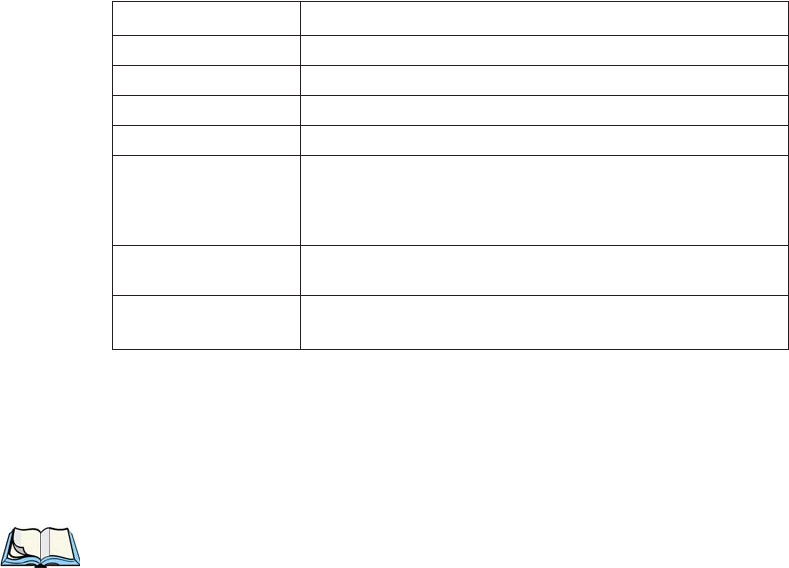
Chapter 7: Peripheral Devices & Accessories
Charge Indicators
260Psion Teklogix 7530 Hand-Held Computer User Manual
7.6.5 Charge Indicators
The spare battery charge slot has an associated tri-colour LED indicator on the
lower-right area of the front panel.
Table 7.2 Combo Charger Indicators
The combo charger supplies DC power to enable the 7535 internal fast charger.
Charge status is displayed on the 7535 charge LED – the lower-right LED. Refer to
“Charge LED” on page 43 for details.
Normally, it takes from 1.5 to 4.0 hours to fully charge the 7530 internal battery.
Note: Battery charging continues whether the 7530 is switched on or off.
7.6.6 Troubleshooting
The gang charger troubleshooting section also applies to the combo charger. Refer
to “Troubleshooting” on page 257, for helpful tips.
LED Behaviour Charge Status
Off No battery detected in the slot.
Solid green Battery is fully charged.
Flashing green Battery is charged to 75% capacity.
Solid yellow Charge in progress.
Flashing yellow
Battery temperature outside the charge range of between
0˚ C to 39˚ C (32˚ F to 102˚ F). Charging is attempted every
five minutes until the battery is within the appropriate tem-
perature range.
Solid red Battery rejected (at insertion) or unable to complete charge
on battery.
Flashing red Charging circuit problem. Refer to “Troubleshooting” on
page 257 for details.

Psion Teklogix 7530 Hand-Held Computer User Manual261
Chapter 7: Peripheral Devices & Accessories
Combo Dock
7.7 Combo Dock
The combo dock is identical to the combo charger with one exception – the combo
dock is equipped with a 10/100 BaseT Ethernet interface. The charging information
in “Combo Charger” beginning on page 258 also applies to the combo dock.
7.7.1 Installation
Refer to the “Installation” guidelines for the combo charger beginning on page 258.
•Attach a CAT5 RJ45 network patch cable (shipped with the combo dock)
between your network and the RJ45 jack on the rear of the dock.
A green LED is illuminated next to the RJ45 connector when a valid network link is
established.
A user application needs to be loaded onto each 7535 that utilizes the combo dock
for communication. With the network connected and this application loaded, the
combo dock is ready for use.
7.7.2 Using The Combo Dock
• Gently slide the 7530 into the cradle portion of the combo dock until
lightly latched. The 7530 detects combo dock and displays the appropriate
icon – .
The battery charge LED (lower-right LED) on the 7530 lights up to show it has
external power and may start charging the battery.
Interaction with the 7530 while in the combo dock is a function of the user
application software used to communicate with the host network.
7.7.3 Network Access
The combo dock includes a dedicated USB to Ethernet converter. This USB
converter appears as a USB slave to the 7530 USB host controller. The 7530
automatically detects insertion into a combo dock and loads the appropriate drivers
to communicate with the USB/Ethernet converter.
See “Network Addressing” on page 263 for details about network addressing issues
with the combo dock.

Chapter 7: Peripheral Devices & Accessories
Troubleshooting
262Psion Teklogix 7530 Hand-Held Computer User Manual
7.7.4 Troubleshooting
Troubleshooting issues for the combo dock are identical to those of the quad dock.
Refer to “Troubleshooting” on page 264 for helpful tips.
7.8 Quad Dock
Note: The quad dock is shipped with a user manual. It is critical that this man-
ual be reviewed for additional information and updates.
The Quad Dock permits each of four docked 7530 hand-helds to communicate with
a 10/100 BaseT Ethernet network at greater than 2Mbps. It also provides sufficient
power to operate and fast charge the batteries in the 7530s.
7.8.1 Installation
The quad dock should be located away from excessive dirt, dust and contaminants.
The ambient temperature must fall between 0˚ C to 39 ˚C (32˚ F to 102˚ F). The
7535 internal charger will not charge batteries outside of this temperature range. For
maximum performance, it is recommended that the quad dock be operated at room
temperature – from 18˚ C to 25˚ C (64˚ F to 77˚ F).
The quad dock can consume up to 3A @ 120VAC or 1.5A @ 240VAC. Ensure that
the mains circuit supplying the unit is adequate, especially if several docks are being
powered from the same circuit.
After unpacking the unit:
•Visually inspect the unit for any damage.
•Install the IEC power cord and apply power.
A green indicator in the lower-right corner of the front panel lights up to indicate
that power is present.
•Attach a CAT5 RJ45 network patch cable (supplied) between your network
and the RJ45 jack on the rear of the dock.
A green LED is illuminated next to the RJ45 connector when a valid network link is
established.
A user application must be loaded onto each 7530 that utilizes the quad dock for
communication. When the network is connected and this application is loaded, the
quad dock is ready for use.

Psion Teklogix 7530 Hand-Held Computer User Manual263
Chapter 7: Peripheral Devices & Accessories
Indicators And Controls
7.8.2 Indicators And Controls
The quad dock has no user controls. It is equipped with a power indicator LED and
RJ45 link and traffic indicator LEDs. When a valid network link is established, a
green LED is illuminated next to the RJ45 connector.
7.8.3 Using The Quad Dock
•Gently slide the 7535 into the cradle portion of the quad dock until lightly
latched.
The 7535 detects that it is in a quad dock and displays the appropriate icon in the
taskbar – . The battery charge LED on the 7535 lights up to show it has external
power and may start charging the battery.
Interaction with the 7535 while in the quad dock is a function of the user application
software used to communicate with the host network.
7.8.4 Network Access
The quad dock includes a four port 10/100 Ethernet hub. Each of the four
downstream ports are connected to dedicated USB-to-Ethernet converters. These
USB converters appear as USB slaves to the 7530 USB host controller. The 7530
automatically detects insertion into a quad dock and loads the appropriate drivers to
communicate with the USB/Ethernet converters.
7.8.4.1 Network Addressing
Although the USB converters have fixed Ethernet MAC addresses, there is generally
no correlation between these addresses and a specific 7530 hand-held. The host
application uses standard TCP/IP protocol to name, locate and communicate with a
specific 7530 on the network.
If a link is established between a 7530 and a host, the application on the host and on
the 7530 must have a recovery mechanism in the event that the 7530 is removed
from the dock and the link is interrupted.
7.8.5 Battery Charging
The quad dock supplies DC power to enable the 7530 internal fast charger. Charge
status is displayed on the 7530 charge LED (see “Charge LED” on page 43). Battery
charging continues whether the 7530 is switched on or off.
Normally, it takes between 1.5 and 4 hours to fully charge the 7530 internal battery.

Chapter 7: Peripheral Devices & Accessories
Troubleshooting
264Psion Teklogix 7530 Hand-Held Computer User Manual
7.8.6 Troubleshooting
The indicators, applications and drivers required to use and monitor the docking
station are installed on the 7530 – no indicators or applications are present on the
docking station itself.
7.8.6.1 Network Link Unsuccessful
If a network link fails, the 7530 application alerts the operator that the link was
unsuccessful.
7.8.6.2 7535 LED Does Not Light When Docked
•Check that the quad dock has power – is the Power LED on the quad
dock illuminated?
• Try inserting the 7530 in another slot in the quad dock.
•Check for dirt or contamination on the docking contacts at the bottom of the
7530. Wipe the contacts with a damp cloth if necessary.
•Check the pogo pins inside the dock cradle for dirt. Gently wipe with a
damp cloth if they appear to be dirty or discoloured.
•Check that the pogo pins are not bent or damaged.
• Remove and reinsert the 7530 in the cradle, and check that the latch is
holding the unit in place (the pogo pins must be compressed for proper
contact).
• Make certain that the battery installed in the 7530 is defective.
7.9 Portable Docking Module (PDM)
Warning: The mains power cord for the DC adapter shall comply with
national safety regulations of the country where the equipment
is to be sold.
The Portable Docking Module (PDM) clips onto the base of the 7530 and is most
often used to charge the 7530 battery when a desktop charger is not convenient. The
PDM also offers additional communication ports, making it useful for upgrading
software in the 7530 from a USB-equipped laptop computer. Figure 7.2 on page 267
illustrates the connectors on the PDM.

Psion Teklogix 7530 Hand-Held Computer User Manual269
Chapter 7: Peripheral Devices & Accessories
Picker Cradle Mounting Recommendations
7.11.1 Picker Cradle Mounting Recommendations
Warning: Before mounting a picker cradle in a vehicle, there are a number
of operator safety issues that require careful attention. An improp-
erly mounted cradle may result in one or more of the following:
operator injury, operator visibility obstruction, operator distraction
and/or poor ease of egress for the operator. Psion Teklogix strongly
recommends that you seek professional mounting advice from the
vehicle manufacturer.
Cable routing within a vehicle cab also requires careful consider-
ation, especially for separately tethered scanners and other devices
with loose cables. If you are unable to obtain suitable advice,
contact Psion Teklogix for assistance (see Appendix A: Support
Services And Worldwide Offices). Note also that for better protec-
tion, the equipment should be mounted inside the vehicle roll cage.
Pedestal mounts are recommended for all fixed mount locations because they offer
optimal operator access. In addition, for safety reasons, only pedestal mounts with
fully locking joints should be used in vehicles. Always adjust the pedestal for the
optimum viewing angle, and securely tighten the hex and wing screws.
The most effective way to mount the picker cradle is to use the four #8-32 threaded
inserts on the rear of the unit. Bolts must not extend more than 10mm (3/8") into the
cradle.
To accommodate the service loop of the connector cable, leave a 4" clearance at the
bottom of the cradle. Leave a 7" (minimum) clearance at the top of the cradle to
allow easy removal of the hand-held. Also remember to leave at least a 3" clearance
at the sides of the cradle to allow activation of the release knobs. Refer to the
detailed assembly instructions that are packaged with the cradle when selecting a
mounting location.
7.11.1.1 Mounting Template
The picker cradle is shipped with detailed mounting instructions including a drill
template.
Chapter 7: Peripheral Devices & Accessories
Wiring Guidelines
270Psion Teklogix 7530 Hand-Held Computer User Manual
7.11.2 Wiring Guidelines
Before installing the cables between the cradle and other devices, consider
the following:
•Ensure that drilling holes will not damage the vehicle or its wiring.
•Protect cable runs from pinching, overheating and physical damage.
•Use grommets to protect cables that pass through metal.
•Use plastic straps and tie-downs to secure cables and connectors in their
desired location, away from areas where they may get snagged or pulled.
•Keep cables away from heat sources, grease, battery acid and other
potential hazards.
•Keep cables away from control pedals and other moving parts that may
damage the cables or interfere with the operation of the vehicle.
7.11.3 Using The Picker Cradle
If your 7535 is equipped with a shoulder strap or cover, these accessories need to be
removed before installing the unit in a picker cradle. There is no need to remove
handstraps, pistol grips or tethered devices from the unit.
• Slide the 7530 into the cradle, and press firmly downward until it locks into
place. On a vehicle, it’s a good idea to pull up on the 7535 to be certain that
it is secure.
• To remove the 7530, press firmly on one of the knobs on either side of the
cradle until it releases. You do not need to press both knobs.
7.11.4 Maintaining The Picker Cradle
Two latches in the cradle hold the 7530 firmly in place. Although these latches are
designed for at least 80,000 cycles, they will wear over time and will no longer lock
the 7530 securely in the cradle. For replacement parts and instructions contact Psion
Teklogix (see Appendix A: Support Services And Worldwide Offices). Partial
disassembly is required.

Psion Teklogix 7530 Hand-Held Computer User Manual271
Chapter 7: Peripheral Devices & Accessories
Powered Cradle Installation In High Voltage Vehicles
7.11.5 Powered Cradle Installation In High Voltage Vehicles
Warning: Voltages exceeding 60VDC are considered hazardous. For powered
cradle installations on vehicles with batteries above this voltage,
ensure the powered cradle power connector is mounted in a dry
location on the vehicle, or that the connector is insulated with an
appropriate waterproof material after installation. The connector
must also be installed out of the vehicle operator’s reach. Exposing
an accessible power connector to water or other liquids could create
a hazardous situation resulting in serious injury or death.
Installation of powered cradles in vehicles that operate above 60VDC require
special consideration.
Due to the hazardous voltages present on these vehicles, it is necessary to ensure
that the powered cradle power supply cable connector is not accessible to the
vehicle operator, and does not get exposed to water or other liquids. This can be
accomplished in one of the following ways:
•Ensure the power connector is installed in a dry location on the vehicle,
away from the vehicle operator’s reach (perhaps under a vehicle dash or in a
sealed housing).
•Cover the power connector with a waterproof heat shrink material (see
“Extreme Wet Environments” note below for additional details).
•Wrap the connector securely with a waterproof electrical tape in an area out
of the vehicle operators reach.
All other installation requirements outlined in this document should also be
followed for High Voltage vehicles to insure safe installation and operation of the
powered cradle.
7.11.5.1 Extreme Wet Environments
For extreme wet environments, or environments where it is difficult to restrict
vehicle operator access to the power connector, Psion Teklogix offers a waterproof
heat shrink kit (PN 1030022). The kit contains 3 pieces of waterproof, high shrink
ratio heat shrink tubing which can be used to encapsulate the entire connector
assembly. If using this kit, please ensure that you order sufficient material to cover
installation and service, remembering that heat shrink is one-time use, and must be
replaced if it is removed from the connector for any reason.

Chapter 7: Peripheral Devices & Accessories
Powered Cradle Installation
272Psion Teklogix 7530 Hand-Held Computer User Manual
7.11.6 Powered Cradle Installation
The powered cradle option is designed to allow the 7530 to be powered by a vehicle
battery. The battery installed in the 7530 is also recharged by the vehicle battery.
This option accepts DC power sources over the range 12V to 80V.
The 7530 picker cradle can be ordered with the powered cradle option installed, or it
can be retrofitted later at an authorized Psion Teklogix service depot. Service offices
are listed in Appendix A: Support Services And Worldwide Offices.
The 7530 charging LED (see Section 3.6.1.1 on page 43) indicates that external
power is available, and it also indicates the charging status of the internal battery.
Warning: Applying a voltage above 90VDC or reversing polarity may result
in permanent damage to the cradle power option and will void the
product warranty.
Warning: TO AVOID ELECTRIC SHOCK when the powered cradle option
is installed, always ensure that the rear panel ground lug on the
picker cradle is connected to the vehicle chassis. Failure to do this
could result in serious injury or death.
The metal chassis of the picker cradle must be connected directly to the chassis of
the vehicle. A safety ground lug (clearly labelled on the rear of the cradle chassis) is
provided for this purpose. The grounding strap must connect from the ground stud
on the picker cradle to a solid, reliable contact point on the main portion of the
vehicle chassis. It must not be connected to battery negative or a terminal block.
This grounding strap ensures that if there is a fault in the vehicle wiring or in the
picker cradle power module, the picker cradle cannot be at a hazardous voltage with
respect to the vehicle chassis.
Connection between the picker cradle ground lug and the vehicle chassis should be
done with a 16 gauge ground strap (ground wire). Connect the ground strap to the
picker cradle utilizing the ground lug hardware supplied with the picker cradle and a
#10 heavy duty wire crimp ring terminal. Torque the ground lug hardware to 23.0
+/- 2.0 in-lbs. Connect the other end of the ground strap to a solid, reliable point on
the main portion of the vehicle chassis, ensuring a solid electrical connection.
As with other vehicle cables, the routing of the ground strap should be carefully
considered to ensure it does not pose a hazard to the operator or the safe operation of
the vehicle. If necessary, secure the ground strap with cable ties or some other
mechanical means to prevent loops or loose lengths of wire that could catch on
stationary items when the vehicle is in motion.
Psion Teklogix 7530 Hand-Held Computer User Manual273
Chapter 7: Peripheral Devices & Accessories
Wiring Vehicle Power To The Cradle
7.11.6.1 Wiring Vehicle Power To The Cradle
A 1.8 meter (6 foot) extension power cable (PN 13985) is supplied with your power
cradle. This cable should be wired to a filtered, fused (maximum 10A) accessory
supply on the vehicle. The power cradle draws no more than 8A (less if the
accessory supply is greater than 12V). Any additional wiring, connectors or
disconnects used should be rated for at least 10A.
The red lead of the power cable attaches to the positive vehicle supply. The black
lead connects to the negative supply – this should be connected to a proper terminal
block and not to the vehicle body. The power cradle is fully isolated and can be used
with both negative and positive chassis vehicles.
You may have the option of connecting power before or after the ‘key’ switch. It is
preferable to wire the power cradle after the key switch – that is, it cannot be turned
on without the key on. However, if the operator switches the key off repeatedly for
long periods during a shift, it may make more sense to wire the cradle before the
switch.
Keep in mind that the 7530 will continue to operate with or without vehicle power
as long as its battery has sufficient charge.
If an unfused power source must be used, a fuse assembly (PN 19440) must be
added to the extension power cable (the fuse and instructions are supplied with the
cable). Use only a 10A slow blow UL approved fuse in the fuse assembly.

Chapter 7: Peripheral Devices & Accessories
The Port Replicator
274Psion Teklogix 7530 Hand-Held Computer User Manual
7.11.7 The Port Replicator
The port replicator is an optional accessory that allows tethered devices (e.g.,
scanners) as well as mounted peripherals (e.g., bar code printers or weigh scales) to
be attached to the picker cradle. The replicator can be used with or without the
cradle power option.
The functionality of the 7535 tether port is duplicated on the port replicator. In
addition to the tether port, the replicator is equipped with a standard 9 pin RS232D
serial interface. This interface is typically used for fixed peripherals such as printers.
Your serial device likely includes a suitable cable connector for this port.
Note: The 7530 picker cradle can be ordered with the port replicator option
installed, or it can be retrofitted later by an authorized Psion Teklogix
service depot. Service offices are listed in Appendix A: Support Services
And Worldwide Offices.

Psion Teklogix 7530 Hand-Held Computer User Manual275
SPECIFICATIONS 8
8
8.1 7530 Hand-Held Computer Specifications ..................277
8.2 Radio Specifications .............................279
8.3 Bar Code Scanning ..............................279
8.3.1 Internal Scanners............................279
8.3.2 Internal Scanner Port..........................280
8.3.3 External Scanners ...........................280
8.4 Internal Scanner Specifications........................281
8.4.1 SE1200 High Performance & Long Range Specs ...........281
8.4.2 SE1200 Advanced Long Range & SE2223 PDF Specs ........282
8.4.3 Decode Zones .............................284
8.5 External Scanner Specifications .......................284
8.5.1 PowerScan™ LR and XLR Industrial Scanner Specs .........284
8.5.2 PowerScan™ Standard Range Scanner Specs.............287
8.6 Lithium-Ion Battery Pack ..........................288

Psion Teklogix 7530 Hand-Held Computer User Manual277
Chapter 8: Specifications
7530 Hand-Held Computer Specifications
Note: Performance specifications are nominal and subject to change
without notice.
8.1 7530 Hand-Held Computer Specifications
Size•4" (102mm) width x 2.5" (62.5mm) depth x 9.6" (244mm) length
•Keypad area: 3" (75.5mm) width x 1.4" (36mm) depth
Weight
With battery 21.7 oz (700g)
With pistol grip add 4.3 oz (125g)
Operating System
Microsoft® Windows® CE.net Version 4.x
Processor And Memory
•400 MHz XScale PXA255 Processor
•RAM: 64MB SDRAM (Future option 128MB)
•Flash ROM: 32MB FLASH
Power
•7.2V @ 1800mAh Li-ion rechargeable battery.
•Intelligent fast charge.
•10 hour battery operation (5 scans, transmit & receive/min).
•Built-in gas gauge & performance monitor.
•Quick swap battery packs.
•Built-in fast charger (1.75 hour typical recharge).
•Self-guiding & latching battery pack design.
•System backup (10 minutes) during battery swap.
•1 week real-time clock backup.
Chapter 8: Specifications
7535 Hand-Held Computer Specifications
278Psion Teklogix 7530 Hand-Held Computer User Manual
Communication
Ports Tether port (optional) with:
- one RS232 serial port (decoded scanner,
printer)
undecoded scanner port
USB host port, power out
- Docking station port with:
one RS232 serial port including diagnostics
USB device port, USB host port, power in/out
Environmental
Guaranteed Operating 32°F to 122°F (0°C to +50°C)
Temperature Range Short exposure to temperatures outside this range
may cause the 7535 monochrome screen to
become very dark or light temporarily.
Long exposure to temperatures below -40˚C (-
40˚F) may damage the screen. Prolonged expo-
sure to temperatures above +60˚C (+140˚F) will
damage the main battery and temperatures above
+70˚C (+158˚F) may damage the unit.
Storage Temperature -13°F to 140°F (-25°C to +60°C)
Rain And Dust Resistance IEC 529, classification IP54.
Humidity 5% - 95% RH non-condensing
Drop Durability Multiple 5 ft. (1.5m) drops to polished
concrete.
Cradle shock: 30g in each axis.
Cradle vibration: 1.5g RMS PSD (4Hz-500Hz).
Approvals
Safety UL 1950, CSA C22.2 No950, LVD EN60950
EMC FCC Part 15 Class B, EMC Directive Class B
Laser IEC 825-1 Class 2 (EN60825-1), 21CFR1040
Class II
Psion Teklogix 7530 Hand-Held Computer User Manual279
Chapter 8: Specifications
Radio Specifications
8.2 Radio Specifications
802.11b Direct Sequence Spread Spectrum
802.11b/g
Tranmit Power 15 dBm for 'b'
13 dBm for 'g'
Frequency Range 2.412-2.462 for USA, Canada
2.412-2.472 GHz for EU
Channels 1 to 11 for USA, Canada
1-13 for EU countries
Data Rates 1,2,5.5 and 11 Mbps
6,9,12,18,24,36,48 and 54 Mbps
8.3 Bar Code Scanning
Scanner Types Decoded and non-decoded.
Non-Decoded Codes Supported Code 39, code 128, EAN 13, EAN 8,
EAN 128, UPC-A, UPC-E, Codabar,
Code 93, Code 11, Interleaved 2-of-5,
MSI/PLESSY, Discrete 2-of-5.
Decoded Codes Supported Dependent on external scanner choice.
Code Discrimination Automatic for all selected codes, Non-
Decoded input. Decoded input is external
scanner dependent.
8.3.1 Internal Scanners
Base Options High performance, long range, advanced
long range, wide angle, imager scanner and
2-D raster laser scanner.
Chapter 8: Specifications
Internal Scanner Port
280Psion Teklogix 7530 Hand-Held Computer User Manual
Scan Triggering If an aiming dot is available on the installed
scanner, the aiming dot will be enabled for
a configurable time period after which
normal scanning begins. Double-clicking
trigger will override aiming delay and initiate
immediate scan.
8.3.2 Internal Scanner Port
Compatibility Symbol:
SE1200HP 1D non-decoded, standard range
SE1200LR 1D non-decoded, long range
SE1200ALR 1D non-decoded, advanced
long range
SE1200 WA, non-decoded wide angle
SE2223 PDF decoded raster
8.3.3 External Scanners
Supported Types Decoded and Non-Decoded 5V only.
Interface Via tether port.

Psion Teklogix 7530 Hand-Held Computer User Manual281
Chapter 8: Specifications
Internal Scanner Specifications
8.4 Internal Scanner Specifications
8.4.1 SE1200 High Performance & Long Range Specs
Table 8.1 SE1200HP And SE1200LR Scanner Specifications
Parameter
7530 High Performance
(SE 1200HP) 7530 Long Range
(SE 1200LR)
Light Source Visible Laser Diode,
675nm ± 5nm Visible Laser Diode,
650nm ± 5nm
Laser Class CDRH Class II
DIN EN 60825: July
1993, Class 2
CDRH Class II
DIN EN 60825: July
1993, Class 2
Laser Power 1.0 mW Max. Average Radiant
Power 1.0 mW Max. Average
Radiant Power
Pulse Power Duration Continuous Continuous
Scan Angle 42˚ ± 2˚23˚ ± 2˚
Scan Repetition 36 ± 3 scans/second
(bidirectional) 36 ± 3 scans/second
(bidirectional)
Skew Tolerance ± 65˚ from normal ± 60˚ from normal
Pitch Angle ± 55˚ from normal ± 65˚ from normal
Roll Tolerance ± 20˚ from vertical ± 10˚ from vertical
Specular Dead Zone ± 2˚ from normal ± 2˚ from normal
Decode Depth of Field Minimum bar width is 5.0 mil
(0.127 mm) Minimum bar width is 10.0
mil (0.254 mm)
Print Contrast
Minimum 20% absolute dark/light reflec-
tive measured at 675 nm. 40% absolute dark/light reflec-
tance measured at 675 nm.
Ambient Light
Immunity Sunlight: 8000 ft. candles
Artificial Light: 450 ft. candles Sunlight: 8000 ft. candles
Artificial Light: 450 ft. candles

Chapter 8: Specifications
SE1200 Advanced Long Range & SE2223 PDF Specs
282Psion Teklogix 7530 Hand-Held Computer User Manual
8.4.2 SE1200 Advanced Long Range & SE2223 PDF Specs
Table 8.2 SE1200 ALR And SE2223 PDF Scanner Specifications
Parameter 7530 Advanced Long Range
(SE 1200ALR) 7530 PDF
(SE 2223 PDF)
Light Source Visible Laser Diode 650 nm Visible Laser Diode 650 nm
Scan Rate 35 (± 5) scans/sec (bi-directional) 590 scans/sec. 22 frames/sec.
Scan Angle
Horizontal:
Vertical 13º
± 2º34º
12.5º
Scan Patterns Linear Linear and Smart Raster
Minimum Print
Contrast
Minimum 40% absolute
dark/light reflectance measured
at 650 nm
- 35% absolute dark/light
reflectance differential (PDF)
- 25% absolute dark/light
reflectance differential (1-D)
Symbologies
UPC/EAN, Code 128, Code 39,
Code 93, I 2 of 5, Discrete 2 of 5,
Codabar, MSI UCC/EAN 128,
TriOptic Code 39
PDF417, Micro PDF,
UPC/EAN, Code 39,
Interleaved 2 of 5, Code 128,
Codabar, MSI Plessey
Programmable
Parameters
Laser On Time, Aim Duration,
Power Mode, Trigger Mode,
Bi-directional Redundancy,
Symbology types/lengths, Data
formatting, Serial Parameters,
Beeper Tone
Laser On Time, Aim Duration,
Power Mode, Trigger Mode,
Bi-directional Redundancy,
Symbology types/lengths,
Data formatting, Serial Param-
eters, Beeper Tone, Scan
Angle, Pattern controls
Ambient Light:
Artificial:
Sunlight:
450 ft. candles (4,844 lux)
8,000 ft. candles (86,112 lux) 450 ft.-candles/4,844 lux
8,000 ft.-candles/86,112 lux
with correct enclosure.
Operating Temperature: -22º to 131ºF (-30º to 55ºC) 22º to 140° F/-30º to 60º C @
100% duty cycle
Storage Temperature: -40° to 140°F (-40° to 60°C) -40º to 158º F/-40º to 70º C
Humidity: 5% to 95% noncondensing 5% to 95% noncondensing
Power:
Input Voltage:
Input Current:
Standby Current:
5.0 VDC ± 10%
115 mA typical
70 µA max.
5VDC ± 10%
230mA
6.5mA
Shock 2,000 G 2,000 G
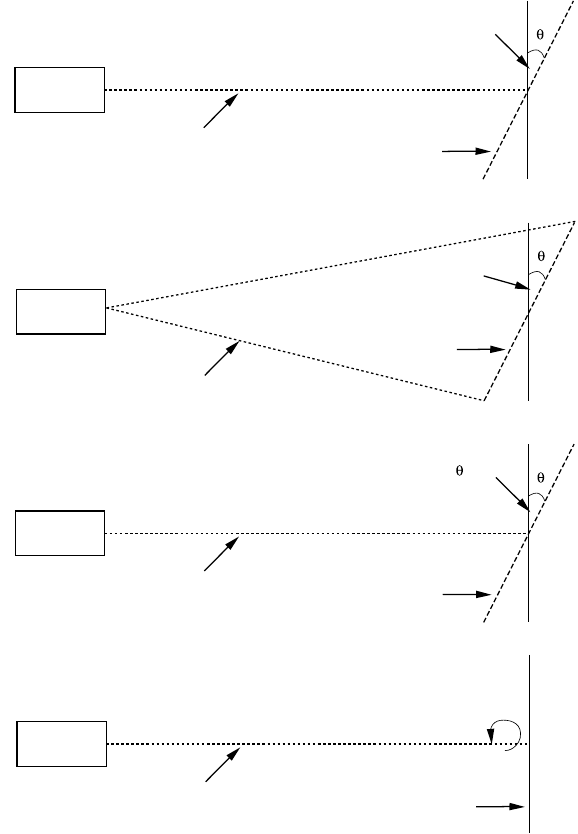
Psion Teklogix 7530 Hand-Held Computer User Manual283
Chapter 8: Specifications
SE1200 Advanced Long Range & SE2223 PDF Specs
Figure 8.1 Pitch, Skew And Specular Dead Zone
Pitch Pitch Angle
Scan Beam
Scan Beam
Scan Pattern
Skew Angle
Barcode Surface
Barcode Surface
Barcode Surface
Scanner
Side View
Top View
Side View
Scanner
Scanner
Skew
Specular Dead Zone < 2º
Scan Beam Barcode Surface
Side View
Scanner
Roll
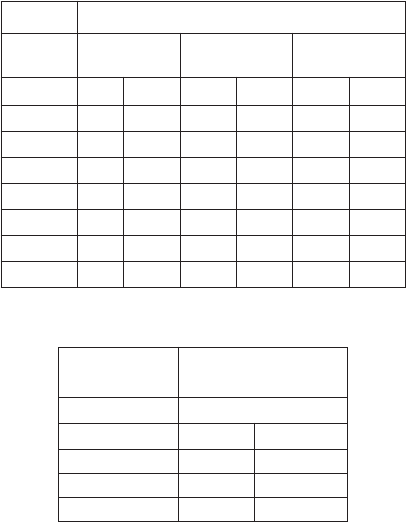
Chapter 8: Specifications
Decode Zones
284Psion Teklogix 7530 Hand-Held Computer User Manual
8.4.3 Decode Zones
Table 8.3 Decode Zones – HP, LR And ALR
Table 8.4 Decode Zones – PDF Scanner
8.5 External Scanner Specifications
8.5.1 PowerScan™ LR and XLR Industrial Scanner Specs
Communication
Undecoded Standard and Intermec-compatible.
Mechanical
Dimensions 6.9 x 11.2 x 18.3 cm (2.7 x 4.4 x 7.2 in)
Weight Scanner - 280 g (9.9 ozs)
Cable (82.3 cm 32 in) - 176 g (6.2 ozs)
Cable lengths Collapsed: 81 cm (32 in)
Max working: 183 cm (72 in)
Bar Code Read Distance
High
Performance Long Range Advanced
Long Range
Min Max Min Max Min Max
5 mil 3.0"4.5"
7.5 mil 3.0"8.5"
10 mil 2.5"12.5"13.0"17.5"
15 mil 2.5"18.5"8.5"33.5"20.0"50.0"
20 mil 2.5"20.5"9.5"38.5"30.0"60.0"
40 mil 3.0"29.5"9.5"79.5"30.0"98.0"
55 mil 3.5"35.5"9.5"89.5"27.0"115.0"
Bar Code Raster Laser Scanner
Read Distance
PDF Bar Codes S2223
Min Max
6.5 mil 2.5"6.5"
10 mil 2.5"9.5"
15 mil 2.5"15.5"
Psion Teklogix 7530 Hand-Held Computer User Manual285
Chapter 8: Specifications
PowerScan™ LR and XLR Industrial Scanner Specs
Electrical
Operating voltage 4 VDC to 14 VDC
Operating current - nominal Undecoded: 75 mA @ 5 VDC
Decoded: 100 mA @ 5 VDC
Idling current - low power mode < 50 µA @ 5 VDC
Optical
Light source Extra bright 650 nm Visible Laser Diode
(VLD)
Scan System Frictionless lifetime flexure mechanism
Rate 35 scans/sec nominal
Depth of field - Long Range Paper Labels (decoded)
7.5 mil 6 to 10 in (15 to 25 cm)
10 mil 5 to 20 in (13 to 51 cm)
15 mil 5 to 32 in (13 to 81 cm)
20 mil 5 to 48 in (15 to 122 cm)
40 mil 8 to 85 in (20 to 216 cm)
55 mil 15 to 108 in (38 to 274 cm)
Reflective Labels (decoded)
40 mil 22 to 100 in (56 to 254 cm)
55 mil 30 to 104 in (76 to 366 cm)
70 mil 40 to 180 in (102 to 457 cm)
100 mil 45 to 264 in (114 to 671 cm)
Depth of Field-Extra Long Paper Labels (decoded)
Range 15 mil 28 to 60 in (71 to 152 cm)
20 mil 28 to 72 in (71 to 182 cm)
40 mil 28 to 144 in (71 to 144 cm)
55 mil 40 to 180 in (102 to 457)
Reflective Labels (decoded)
40 mil 40 to 180 in (102 to 457 cm)
70 mil 80 to 300 in (2032 to 762 cm)
100 mil 80 to 432 in (203 to 1097 cm)
Chapter 8: Specifications
PowerScan™ LR and XLR Industrial Scanner Specs
286Psion Teklogix 7530 Hand-Held Computer User Manual
Print Contrast Ratio 25% minimum
Pitch ± 65˚
Skew ± 55˚
Ambient Light Immunity Artificial light: 1200 ft. candles.
Sunlight: 8000 ft. candles.
Environmental
Temperature Rating Operating: -22˚ to 122˚ F (-30˚ to 50˚ C)
Storage: -40˚ to 158˚ F (-40˚ to 70˚ C)
Humidity 5 to 95% NC
Shock (at 23˚ C) Withstands multiple 6 foot drops to concrete.
Vibration Meets MIL-STD-810E
Water and Dust IEC529 rating IP54DW
Decoding Capabilities
Auto-discriminates between: UPC A, E/EAN8, 13/JAN8, 13
(P2/P5, Code 128 EAN add-ons)
Code 128, MSI/Plessey, Code 39, Interleaved
2 of 5, Code 39 Full Ascii,
Standard 2 of 5, Code 93, Codabar,
Safety/Regulatory
Electrical Complies to: Gost R; TUV; UL; cUL
Emissions Complies to: FCC-A;EN55022-B
BCIQCNS13438; AS/NZS3548;
VCCI-B
Laser Classification CDRH Class 2;IEC60825 Class 2
Psion Teklogix 7530 Hand-Held Computer User Manual287
Chapter 8: Specifications
PowerScan™ Standard Range Scanner Specs
8.5.2 PowerScan™ Standard Range Scanner Specs
Communication
Undecoded Standard and Intermec-compatible.
Mechanical
Dimensions 6.9 x 11.2 x 18.3 cm (2.7 x 4.4 x 7.2 in)
Weight Scanner - 280 g (9.9 ozs)
Cable (82.3 cm 32 in) - 176 g (6.2 ozs)
Cable lengths Collapsed: 81 cm (32 in)
Max working: 183 cm (72 in)
Optical
Light source Extra bright 650 nm Visible Laser Diode
(VLD)
Scan System Frictionless lifetime flexure mechanism
Rate 35 scans/sec nominal
Depth of field - Standard Paper Labels (decoded)
7.5 mil 3.0 to 6 in (9 to 15 cm)
10 mil 1.5 to 15 in (4 to 38 cm)
15 mil 1.0 to 25 in (2.5 to 64 cm)
20 mil 1.0 to 35 in (2.5 to 89 cm)
(paper) 55 mil 6.0 to 60 in (15 to 152 cm)
High Density (decoded)
3 mil 1.0 to 2 in (2.5 to 5.1 cm)
4 mil 1.0 to 3 in (2.5 to 8 cm)
5 mil 0.8 to 3.8 in (2 to 10 cm)
7.5 mil 0.6 to 4.5 in (1.5 to 11 cm)
10 mil 0.2 to 5.5 in (0.5 to 14 cm)
Print Contrast Ratio 25% minimum
Pitch ± 65˚
Skew ± 55˚
Ambient Light Immunity Artificial light: 1200 ft. candles.
Sunlight: 8000 ft. candles.
Chapter 8: Specifications
Lithium-Ion Battery Pack
288Psion Teklogix 7530 Hand-Held Computer User Manual
Electrical
Operating voltage 4 VDC to 14 VDC
Operating current - nominal Undecoded: 75 mA @ 5 VDC
Decoded: 100 mA @ 5 VDC
Idling current - low power mode < 50 µA @ 5 VDC
Environmental
Temperature Rating Operating: -22˚ to 122˚ F (-30˚ to 50˚ C)
Storage: -40˚ to 158˚ F (-40˚ to 70˚ C)
Humidity 5 to 95% NC
Shock (at 23˚ C) Withstands multiple 6 foot drops to concrete.
Vibration Meets MIL-STD-810E
Water and Dust IEC529 rating IP54DW
Decoding Capabilities
Auto-discriminates between: UPC A, E/EAN8, 13/JAN8, 13
(P2/P5, Code 128 EAN add-ons)
Code 128, MSI/Plessey, Code 39,
Interleaved 2 of 5, Code 39 Full Ascii,
Standard 2 of 5, Code 93, Codabar,
Safety/Regulatory
Electrical Complies to: Gost R; TUV; UL; cUL
Emissions Complies to: FCC-A;EN55022-B
BCIQCNS13438; AS/NZS3548;
VCCI-B
Laser Classification CDRH Class 2;IEC60825 Class 2
8.6 Lithium-Ion Battery Pack
Technology Lithium-Ion (Li-Ion)
Operating Temperature -20˚C to 60˚C (-4˚F to 140˚F)
Charge Temperature 0˚C to 39˚C (32˚F to 102˚F)
Storage Temperature -30˚C to 60˚C (-22˚F to 140˚C)
(Storage at elevated temperatures is not
recommended.)
Charge Cycles Minimum of 300 charge cycles with no deg-
Psion Teklogix 7530 Hand-Held Computer User Manual289
Chapter 8: Specifications
Lithium-Ion Battery Pack
radation below 70% of nominal capacity
Charge Time Charge time is typically 1.5 hours.
Voltage 7.4 V nominal (6V min. to 8.4V max.)
Cell Configuration 2 series connected cells
Capacity 1800 mAh nominal at 300mA discharge
20˚C to 6.0V (minimum)
Supported Chargers 6-Gang Charger
Combo Charger
Combo Docking Station
Quad Docking Station
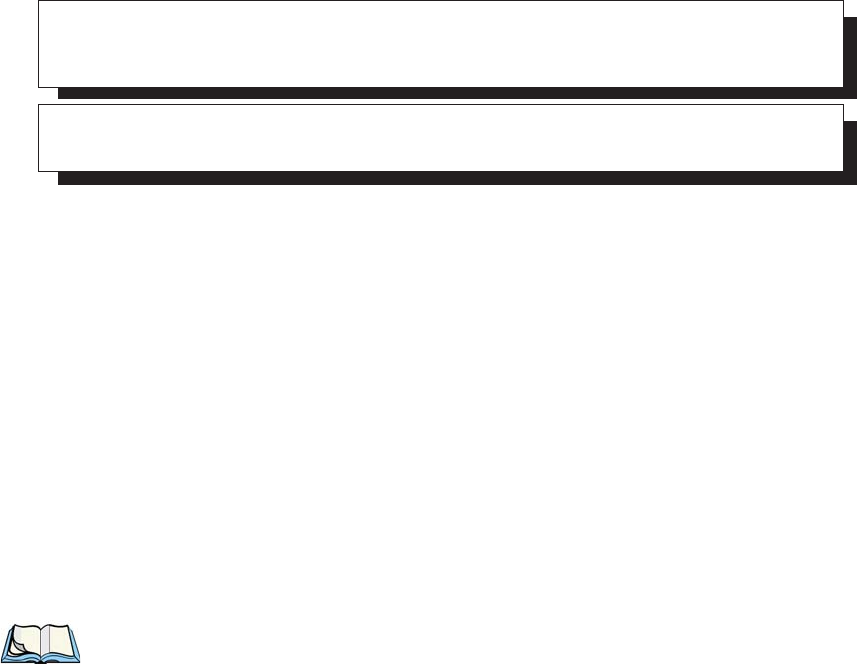
Psion Teklogix 7530 Hand-Held Computer User Manual A-1
APPENDIX A
A
SUPPORT SERVICES AND WORLDWIDE OFFICES
A.1 Support Services
Psion Teklogix provides a complete range of product support services to its
customers worldwide. These services include post-installation technical support and
product repairs.
A.1.1 Canada and USA: Technical Support and Repair Services
In Canada and the U.S.A. these services can be accessed through the Psion Teklogix
Helpdesk. The Helpdesk coordinates repairs, helps you troubleshoot problems over
the phone, and arranges for technicians or engineers to come to your site.
Canadian and U.S. customers may receive access to technical support services,
ranging from phone support to emergency on-site system support, by calling the
toll-free number below, or via our secure web site.
Note: Customers calling the toll-free number should have their Psion Teklogix
customer number or trouble ticket number available.
Voice: 1 800 387-8898
Fax: 1 905 812-6304
Web Site: http://service.psionteklogix.com
A.1.2 International Support
For technical support outside of Canada or the U.S.A., please contact your local
Psion Teklogix office. See page A-3 for a listing of worldwide offices.
Psion Teklogix 7530 Hand-Held Computer User Manual A-3
A.2 WORLDWIDE OFFICES
COMPANY HEADQUARTERS
AND CANADIAN SERVICE CENTRE
Psion Teklogix Inc.
2100 Meadowvale Boulevard
Mississauga
Ontario
Canada L5N 7J9
Tel: +1 905 813 9900
Fax: +1 905 812 6300
Email: salescdn@psion.com
INTERNATIONAL SUBSIDIARIES
Psion Teklogix GmbH
Jakob Kaiser Straße 3
D-47877 Willich Münchheide
Deutschland
Tel: +49 2154 9282 0
Fax: +49 2154 9282 59
Email: info@teklogix.de
Psion Teklogix S.A.
La Duranne
135 Rue Rene Descartes
BP 421000
13591 Aix-En-Provence
Cedex 3; France
Tel: +33 (0) 4.42.908.809
Fax: +33 (0) 4.42.908.888
Email: tekeuro@psion.com
Psion Teklogix LTD.
3, Lancaster Court
Coronation Road High Wycombe
Bucks HP123TD, England
Tel: +44 1494 450666
Fax: +44 1494 450155
WWW: www.teklogix.co.uk
Email: tekuk@psion.com
Psion Teklogix AB
Stora Badhusgatan 18-20
411 21 Göthenburg, Sweden
Tel: +46 31 13 15 50
Fax: +46 31 13 57 80
Email: info@teklogix.se
NORTH AMERICAN HEADQUARTERS
AND U.S. SERVICE CENTRE
Psion Teklogix Corp.
1810 Airport Exchange Boulevard
Suite 500
Erlanger, Kentucky
USA 41018
Tel: +1 859 371 6006
Fax: +1 859 371 6422
Email: salesusa@psion.com
Psion Teklogix Finland
Metsänneidonkuja 8
02130 Espoo
Finland
Tel: +358 9 4307 8390
Fax: +358 9 4307 8395
Email: tekeuro@psion.com
Psion Teklogix Danmark
Vesterballevej 4-6
7000 Fredericia
Danmark
Tel: +45 76 24 0133
Fax: +45 75 94 4679
Email: tedk@psion.com
Psion Teklogix Italia S.r.I
Via Galilei, 47
20092 Cinisello Balsamo
Milan, Italy
Tel: +39 2 6604 5410
Fax: +39 2 6604 5412
Email: tkxitalia@psion.com
Psion Teklogix Benelux
Nieuwe weg 1
2070 Zwijndrecht
Belgium
Tel: +32 (0)3 250 22 00
Fax: +32 (0)3 250 22 20
Email: info@psionteklogix.be
Psion Asia Pacific Pte. Ltd.
210 South Bridge Road
#03-01 Singapore 058759
Tel: +65 67358108
Fax: +65 67335990
E-mail: teksing@teklogix.com
Psion Teklogix de Mexico, S.A. de C.V.
Sierra Mojada 626, 2º Piso
Col. Lomas Barrilaco, C.P. 11010
Mexico, D.F., Mexico
Tel: ++52 55 5 327 1124
Fax: +52 5 327 1123
Email: salesusa@psion.com
Psion Teklogix do Brasil, Ltda.
Al. Casa Branca, 851 - conj. 101 e 102
São Paulo - SP - 01408-001
Brasil
Tel: +55 11 3064 0868
Fax: +55 11 3068 8198
WWW: www.teklogixbrasil.com.br
Email: tekbr@psion.com
Chile Psion Teklogix International Inc.
Avenida Vitacura 2909, Oficina 703
Las Condes
Santiago, Chile
Tel: +56 2 334 9344
Fax: +56 2 233 3868
Email: ventas@psion.com
A-4 Psion Teklogix 7530 Hand-Held Computer User Manual
Psion Teklogix de Argentina, S.A.
Avenida Moreau de Justo 1180
Piso 1, Oficina C-105
Buenos Aires 1107
Argentina
Tel: +54 11 4343 0193
Fax: +54 11 4343 6310
Email: tekar@psion.com
Psion Teklogix España, S.L.
Cityparc Ronda de Dalt
Ctra. Hospitalet 147-149
Edificio Atenas 2˚ 3ª
08940 Cornellà de Llobregat (Barcelona)
España
Tel: +34 9 3475 0220
Fax: +34 9 3475 0230
Email: teklogix@apdo.com
Psion Teklogix Africa
Postnet Suite 39, Private Bag x11
Halfwayhouse, 1685 Ground Floor East
Waterfall Edge Phase 2, Waterfall Park
Bekker Road MIDRAND 1685
South Africa
Tel: 27-11-805-7440/1/2
Fax: 27-11-805-7444
Psion Teklogix Systems India Pvt. Ltd.
M-74, 1st Floor, “M” Block Market
Greater Kailash-Il
New Delhi - 110048
India
Tel: +91 11 621 9257
Fax: +91 11 621 9076
Email: tekind@psion.com
Psion Teklogix B.V.
Venrayseweg 57,
5928 NZ Venlo
Nederlands
Tel: 0031-77-32400.44
Fax: 0031-77-32400.53
A.3 WORLD WIDE WEB
www.psionteklogix.com
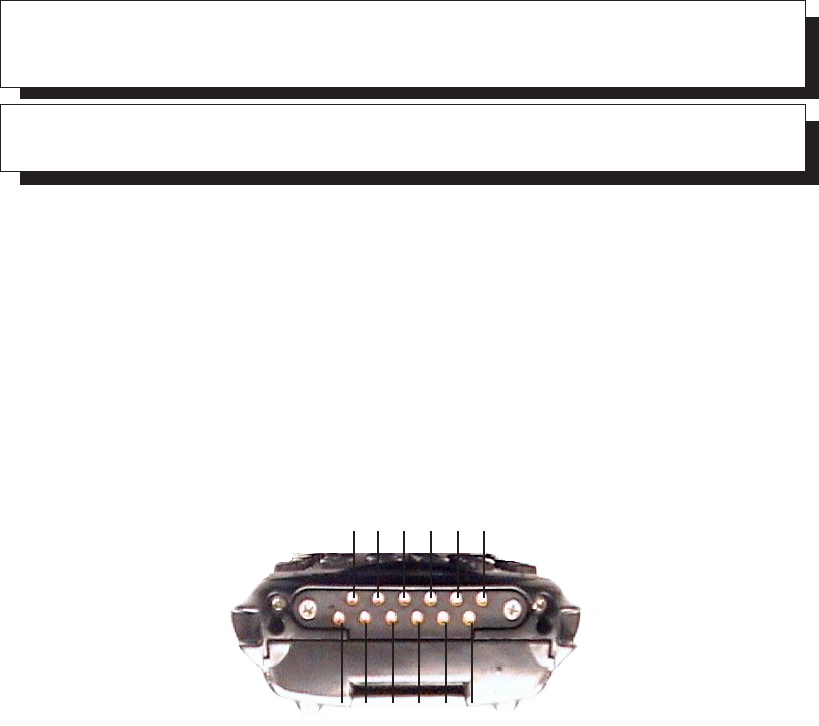
Psion Teklogix 7530 Hand-Held Computer User ManualB-1
APPENDIX B
B
PORT PINOUTS
B.1 7535 Tether Port Pinout
The tether port connector incorporates multiplexed undecoded scanner, decoded
scanner, RS232 serial, and USB interfaces. In order for it to operate, a special wiring
scheme is needed. If you have a need to create cables for the tether port, contact
Psion Teklogix and request document # 1010008 “Instruction Tether Port Termina-
tion”. Attempting to interface to the tether connector without following this docu-
ment may cause damage to the 7530 or the tethered device.
B.2 Docking Station Connector
1. Ext 5V Switched. Used by external peripherals. 5V, 1A max.
2. RX Data. Console receive pin.
3. TX Data. Console transmit pin
4. DC Power In. External power adapter plus input (13-15V).
5. USB Host Minus. For connecting USB devices.
6. USB Host Plus. For connecting USB devices.
7. DC Power In. Same as pin 4.
8. Docking Station Id. Identifies device attached to the docking station.
Resistor between this pin and ground.
2 4 6 8 10 12
1 3 5 7 9 11
Appendix B: Port Pinouts
Battery Contacts
B-2Psion Teklogix 7530 Hand-Held Computer User Manual
9. Ground.
10. USB Device Minus. When terminal operated as a USB device.
11. USB Device Plus. When terminal operated as a USB device.
12. Ground
B.3 Battery Contacts
These contacts represent right to left numbering with the 7530 docking port pointing
toward you.
1. Battery Plus
2. SMBUS CLK
3. Battery ID. Identifies battery type (2 cell-100K resistor to Battery
Negative, 3-cell 100K resistor to battery Negative).
4. SMBUS Data.
5. Battery Negative.

Psion Teklogix 7530 Hand-Held Computer User ManualC-1
APPENDIX C
C
USB SETUP APPLICATION
C.1 USB Setup
The USB Setup application (PN 1000997) is used to update a Windows PC so that it
can connect to a Psion Teklogix 7530.
System Requirements
•Windows® 2000 or XP
•ActiveSync 3.1 or later
The two driver classes that control USB communication are usbstor (for commu-
nication with a device running BooSt) and wceusbsh (for communication
through ActiveSync with a device running Windows CE). These drivers must be
updated with 7530-specific information so that the 7530 can be recognized by
your PC.
The install program:
•updates copies of the device installation scripts usbstor.inf and
wceusbsh.inf with Psion Teklogix-specific information,
• sets up a USB connection between the PC and the 7530, and
• installs the 7530 as a device on your PC. This may require notifying the
PC OS that the device should be reinstalled and then reconnecting the
USB device.
C.1.1 Launching The Application
The log file is initialized and the program introduction is written to it.
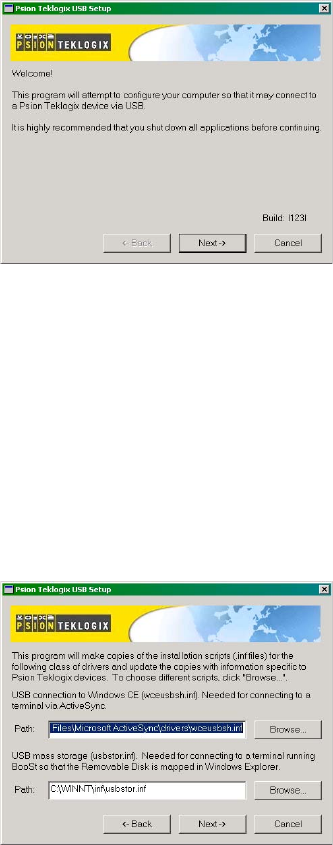
Appendix C: USB Setup Application
Pre-Installation: Updating usbstor.inf And wceusbsh.inf
C-2Psion Teklogix 7530 Hand-Held Computer User Manual
C.1.2 Pre-Installation: Updating usbstor.inf And wceusbsh.inf
1. Welcome Dialogue Box:
You can click on the <Back> and <Next> buttons to navigate between
the pre-install windows. At any time during the pre-installation process,
you can tap on <Cancel> to exit the program.
•Shut down all other software programs – especially ActiveSync – to avoid a
restart request during installation.
•Tap on the <Next> button.
The program checks that ActiveSync is installed and that it is a supported
version – 3.1 or later. If the version installed on your PC is not supported,
you’ll need to exit the USB Setup application, and install a later version of
ActiveSync.
2. Device Driver INF File Selection Dialogue Box:
This dialogue box allows you to choose the paths of the appropriate
inf files. Default file paths are provided in this dialogue box.
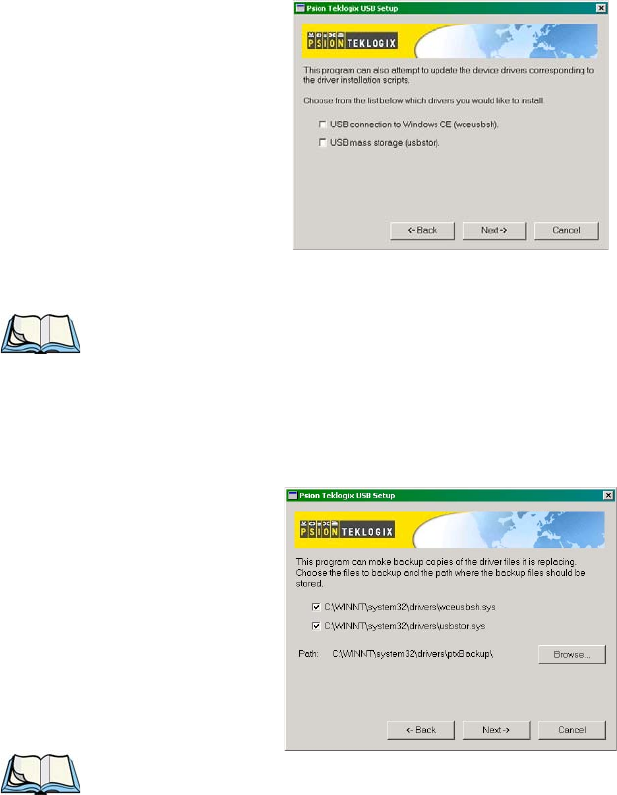
Psion Teklogix 7530 Hand-Held Computer User ManualC-3
Appendix C: USB Setup Application
Pre-Installation: Updating usbstor.inf And wceusbsh.inf
•If necessary, tap on the <Browse> buttons to select different paths for the
inf files.
3. Device Driver Install Selection Dialogue Box:
You can choose to have the device drivers installed immediately by
selecting the check box (√), or you can leave the check box blank and
Windows will install the 7530 the next time it is connected. It is recom-
mended that the device be installed immediately.
•Select the drivers you want to update – wceusbsh and usbstor.
•Tap on the <Next> button.
Note: None of the drivers are updated by default. To complete the process, you
must establish USB connections.
4. Device Driver Backup Selection Dialogue Box:
The USB Setup application will attempt to back up the driver .sys
files before attempting the installation. It specifies which files it will try
to back up and the location to which it will back them up.
Note: Both drivers are selected for backup by default. The backup directory is
<system directory>\drivers\ptxBackup.
Appendix C: USB Setup Application
Installation: Installing The 7530 As a Device On Your PC
C-4Psion Teklogix 7530 Hand-Held Computer User Manual
C.1.3 Installation: Installing The 7530 As a Device On Your PC
1. Install Dialogue Box:
The .sys files you selected are copied to the backup directory. If an
unknown error occurs during the backup, you are asked whether you’d
prefer to cancel the install or continue with the process. The
wceusbsh.inf and usbstor.inf files are updated.
2. If you indicated that the wceusbsh driver should be installed, the
Install dialogue box appears again. The USB Setup application will
attempt to install the drivers immediately. This will succeed only if a
valid USB connection to the device that is running Windows CE exists.
•If the install fails due to an unknown error, the install for this particular
driver is aborted.
•If the install fails because there was an inappropriate USB connection, there
are two possibilities:
•An appropriate USB connection was never established between the PC
and the 7530 running Windows CE. In this case, when an appropriate
USB connection with this device exists, Windows will automatically
attempt to install the device driver.
•An appropriate USB connection exists between the PC and the 7535
running Windows CE, but it has since been severed. Windows may or
may not attempt to automatically install the device drivers on the next
appropriate USB connection.
•A window is displayed where you can tap on <Cancel> to abort the
wceusbsh driver installation and continue. It also contains instructions to
boot your device into Windows CE and establish a USB connection
between the device and the PC. When you create the appropriate connec-
tion, Windows automatically installs the device drivers. The ‘Found New
Hardware’ wizard may appear. Your only interaction with this window is to
click on the <Finish> button.
•If this is the first appropriate connect between the device and the PC –
i.e., there was no previous devnode for the device in the system – the
<Continue> button is activated as soon as the connection is made. Where
there was a devnode present in the system and it has been marked for rein-
stall, the <Continue> button will not become active until Windows has
Psion Teklogix 7530 Hand-Held Computer User ManualC-5
Appendix C: USB Setup Application
Post Installation
completed the driver installation and the device is no longer marked for
reinstall. Only one devnode per device can be ‘unset’ when the device
drivers are finally installed.
3. If you indicated that the usbstor driver should be installed, the same
steps as described above are carried out for usbstor except that the
7530 must be running BooSt. (Press and hold down the <SCAN>
<BLUE> <ENTER> keys for a minimum of 6 seconds to launch the
BooSt program.) Keep in mind that a device running BooSt has a dif-
ferent hardware ID than when it is running Windows CE.
C.1.4 Post Installation
1. Done Dialogue Box:
This dialogue box indicates the success or failure of the installation.
•To view the log file, tap on the <Log File> button
•To exit the program, tap on the <Exit> button.

Psion Teklogix 7535 Hand-Held Computer User Manual I
Boldface indicates a parameter name.
INDEX
# of Cols (ANSI) 200
# of Cols (TESS) 214
# of Pages (ANSI) 199
# of Rows (ANSI) 199
# of Rows (TESS) 214
A
accents, adding (Custom Characters) 191
accessories
bar code readers, connecting 251
hand strap 14
picker cradle (7535) 268
pistol grip 15
acknowledged host number (ah) 168
acknowledged remote number (ar) 168
acknowledgements, transmitted (xa) 167
acknowledgements received 167
AcQ (# of messages sent but not acknowl-
edged by cellular master) 168
Addendum 125, 127, 128
addresses, network See also Network
addresses 244
Ad Hoc network 21
Advanced (wireless connection) 26
advanced long range (SE1223ALR)
scanner 282
ah (acknowledged host number) 168
AIAG
AIAG Character 228
AIAG Strip 123
Mixed AIAG 224
AIAG Character 228
AIAG Strip 123
aiming dot, duration of 120
All Fld Video 225
Alpha parameters 171, 174
ALR (advanced long range) scanner 282
ALT Key 37
anchor (viewport) 239
Anchor Column 240
Anchor Line 240
Anchor View
x origin 211, 227
y origin 211, 227
ANSI
# of Cols 200
# of Pages 199
# of Rows 199
Applications menu 194
arrow keys 163
auto-answerback string 203
Auto Login (Telnet Settings) 197
Auto Term# 195, 212
Group 195, 212
block mode 164, 204–205
Colour Override 202
configuration 162
Conn Type (connection type) 196
CR character 208
device attribute requests 163
device attribute string 203
disabling the keyboard/scanner 208
Edit Modes 209
ENTER key 163, 207
ENTER Pmpt (Telnet Settings) 197
ESC Prompt (Telnet Settings) 197
Func Key Remap (Telnet Settings)
198
Function key equivalents 163
Group Auto Term# 195, 212
Host (Telnet Settings) 197
Kbd Modes 206–208
keyboard lock 204
LF character 208
local editing mode 164, 202
Login (Telnet Settings) 198
Login Failed (Telnet Settings) 198
Login Prompt (Telnet Settings) 198
Media Copy 204
mnemonics 209
multiple sessions 194
Password (Telnet Settings) 198
Password Echo (Telnet Settings) 198

Index
II Psion Teklogix 7535 Hand-Held Computer User Manual
Boldface indicates a parameter name.
Password Prompt (Telnet Settings)
198
Port 197
sessions, closing 165
sessions, establishing new 165
sessions, listing 165
sessions, moving between 165
settings 195–211
Telnet connection 196
Terminal # 195
transmitting data 124, 126, 204
Xmit Modes 202–205
802.IQ connection 196
ANSI Settings
Connection Type - Telnet & TCP Direct
196
Screen settings 199
AP/Controller mac , displaying 167
App. parameter 215
appearance (display colour scheme) 91
Append Enter 223
Append F0 223
appending to bar codes
characters 120, 124, 126
Applications
ANSI Settings 195–211
character attributes (TESS) 216
Character Sets (TESS) 216
Fields parameters (TESS) 224
Host Conn (ANSI) 196
Host Conn (TESS) 213
menu (Applications) 194
Scanner parameters (TESS) 223
Screen parameters (ANSI) 199
Screen parameters (TESS) 214
TESS Settings 212–227
Type and Title 194
approvals
7535 (including scanner) 278
ar (acknowledged remote number) 168
arrow keys 163
completing a data field 156, 225
cycling through special
characters 172
Enh Mode, using 226
moving the cursor 36
Arrow mode 206
Arrows 243
ASCII
decimal equivalents of characters 218
Full Ascii 122
matching fields 217
Async In 210
attributes, video 200–201, 225
Audio 183
audio indicators
adjusting volume 48
description of beep conditions 47
volume adjustment using the BLUE
key 48
authentication, network (Shared Mode) 22
Auto-Answer 203
Auto Login (ANSI Telnet Settings) 197
Auto Radio Addr 179, 246
AutoRep Fn (function key sent
to host) 218
AutoRep T/O 218
auto tab fields 155
Auto Term# (ANSI) 195, 212
Auto wrap 209
B
backlight
display 89
intensity 40
keyboard 40
backspace (CTRL H) 207
bar code
AIAG 224
appending to 120, 124, 126
connecting bar code reader 251
decodes required 120
decoding edge-to-edge 120
displaying type of bar code 118
external bar code reader 251
parameters 121–132
prefix character 124, 126
Security 120
stripping characters 124, 126
suffix character 124, 126
symbologies
Codabar 128
Code 11 128
Code 128 124
Code 39 122–123
Code 93 128
Discrete 2 of 5 129
EAN 13 125

Psion Teklogix 7530 Hand-Held Computer User Manual III
Index
Boldface indicates a parameter name.
EAN 8 126
IATA 2 of 5 130
Interleaved 2 of 5 129
MSI Plessey 129
UPC A 127
UPC E 127
Barcode Character 228
bar-code-only fields 155
bar code reader
external (specs) 280
external scanner, operation of 251
integrated scanner, operation of 48
internal or integrated (specs) 279
batteries
a description of 251
capacity dialogue box 100
charger dialogue box 103
charging 13, 33
gauge 46
installing 32, 33
installing in 7535 17
power info 71
power saving scheme dialogue box 101
removing 32
run time, maximizing 53
safety precautions 252
specifications 288
suspend threshold dialogue box 102
battery charger
safety instructions 253–254
battery pack 251–253
battery safety 252–254
battery See also batteries 251
Baud 237
beacons received (rb) 167
beacon timeouts (bt) 167
Beam Lockout 224
beep conditions 183
beeper
adjusting volume 48
description of beep conditions 47
volume adjustment using the BLUE
key 48
beeper sounds 183
Beep Tone and Beep Time 183
bell (CTRL G) 207
Binary print 219
BKSP (DEL Key) 37
BKSP/DEL Key
TESS sessions, BKSP key behaviour in
157
TESS sessions, DEL key behaviour in
158
blinking video attribute 201, 225
Block Cursor 188
block mode, ANSI 164, 204–205
Bluetooth radio
ISM band 106
Bluetooth setup 106
GPRS setup 111
peripherals 268
bold video attribute 200, 225
Bootloader (Shutdown menu) 75
bootnum
802.IQ 167
802.IQ, displaying 167
Bright For (backlight) 90
Brightness 242
Brk for Attn 231
bt (beacon timeouts) 167
Buffer 238
C
ca (cellular address) 168
cable diagrams B-1
calibrating (touchscreen) 41, 104
cellular address (ca) 168
changing password (Start Menu security)
69
changing softkey labels (Label F1-F5)
201
changing softkey labels (Label F1-F6)
215
Character parameters (TESS) 216
characters
appending to bar codes 124, 126
Char Set, choosing (TESS) 216
cycling through 172
decimal values of 218
EOB chars 205
EOL chars 205
Lower (ANSI) 210
prefix 124, 126
stripping 124, 126
suffix 124, 126
Upper (ANSI) 210
character set (Tether & Console Port) 236
Character Sets

Index
IV
Psion Teklogix 7530 Hand-Held Computer User Manual
Boldface indicates a parameter name.
Host Char Set 210
character sets
choosing in TESS 216
Lower (ANSI) 210
Upper (ANSI) 210
charger
descriptions of 33
safety instructions 253–254
charging (battery) 13
Char Set (TESS) 216
Check Digit 128
check digit 125, 128, 129, 130
Check Digit, One 129
Clear Entry Fields 228
Click Data (scanner double-click) 120
Click Time (scanner double-click)
119
CLR/DEL key
Local Echo mode (ANSI) 207
CLR Key 244
Codabar 128
Code 11 128
Code 128 124
Code 39 122–123
Code 93 128
Cold Reset (Shutdown menu) 75
Colour Override 202, 216
Column Offset 240
columns
number of in ANSI screen 200
number of in TESS screen 214
Command Prompt 72
Command Region Up, Down, Left &
Right 229
Communities 136
configuring IEEE 802.11 radio 18
configuring softkey labels (Label F1-F5)
201
configuring softkey labels (Label F1-F6)
215
connecting
Auto Login (ANSI Telnet Settings)
197
ENTER Pmpt (ANSI Telnet
Settings) 197
Login (ANSI Telnet Settings) 198
Login Failed (ANSI Telnet Settings)
198
Login Prompt (ANSI Telnet
Settings) 198
Password (ANSI Telnet Settings) 198
Password Echo (ANSI Telnet
Settings) 198
Password Prompt (ANSI Telnet
Settings) 198
connection, host 196, 213
Conn Type (connection type) 196, 213
Contact 135
Cont Nxt Fld 223
contrast, adjusting 41
contrast, adjusting display 41
control codes 209
control panel
accessing 83
basic setup 88
Display Properties 88
icons 84
keyboard properties 92
power management properties 100
stylus properties 103
Convert to UPC-A 127
country code 125
CR/LF
CTRL J 207
LF character 208
Newline 208
cradle See also Picker cradle 268
CRC (serial I/O) 222, 223
CTRL commands
CTRL a 165
CTRL c 160
CTRL f 156
CTRL G (Bell) 207
CTRL h 161
CTRL H (Backspace) 207
CTRL h (host select) 160
CTRL i 156
CTRL I (Tab) 207
CTRL J (Line Feed) 207
CTRL K (Vertical Tab) 207
CTRL L 161
CTRL L (Form Feed) 207
CTRL p (reprint) 160
CTRL r 156
CTRL s 159
CTRL s (status, displaying
continuously) 160

Psion Teklogix 7530 Hand-Held Computer User Manual V
Index
Boldface indicates a parameter name.
CTRL t 159
CTRL t (status, display with unit #) 160
CTRL u 156
CTRL w 159
CTRL w (status, display in Lock B & H
mode) 160
CTRL Key 37
cursor
changing shape of 188
Enh Edit mode 226
field advance (tab) 155
field backspace 155
field exit 155
Field Order 224
home 155
linefeed mode (ANSI) 207
moving between fields 206, 224
newline mode (ANSI) 207
Custom Characters 191
cycle tasks 71
D
data
entering 155, 226
Ign Bcode_fld 226
with a bar code reader 251
serial I/O 222
Serial In/Out 221
transmitting from the terminal 208, 225
transmitting from the 7535 155, 202
Data Bits 237
data stream type (typ) 168
dead zone 283
decimal values of keys 218
decode zones (internal scanners) 284
decoding bar codes
decodes required 120
Security 120
2-D scanner 284
decrementing parameters 170, 174
Default Colour 193
Default font 200, 226
DEFAULT key (F3) 148
DEFLT key (F3) 175
DEL (BKSP) Key 37
DEL/CLR key
BKSP key (ANSI) 207
Local Echo mode (ANSI) 207
desktop connection, remote 83
Dev Attr 203
device attribute requests 163
device attribute string 203
dialogue box, using 76
digit
check digit 125, 128, 129, 130
number system 127, 128
Dim For (backlight) 90
Disable kbd 208
disabling/enabling Y/N parameters 171,
174
disconnecting
ESC Prompt (ANSI Telnet Settings)
197
Discrete 2 of 5 129
Disp controls 209
display
Anchor Column 240
Anchor Line 240
Anchor View 211, 227
appearance (colour scheme) 91
backlight 89
backlight, adjusting 40
Brightness 242
contrast (control panel) 88
contrast, adjusting 41
Display Properties 88
Display Shift 187
Field Scroll 214
ICH/DCH controls 209
Line Scrolling 242
moving 188
Origin Scroll 214
Panning 242
positioning 214
split screens 188
Use Increment 188
video attributes 200–201, 225
viewport, mapping 239
Wraparound 242
X-Increment 188
Y-Increment 188
display contrast, adjusting 41
displaying TESS version number 159
Display Menu
selecting a TESS session 154
Display menu 168
Display Properties 88
Display Shift 187

Index
VI
Psion Teklogix 7530 Hand-Held Computer User Manual
Boldface indicates a parameter name.
docking device icons 47
docking station
uploading data using 56
Dot Time 120
double-click
appending characters to a decoded
bar code 120
scanner trigger 119
Double-Tap (stylus settings) 104
E
EAN/UCC 128 125
EAN 13 125
EAN 8 126
EAP (Extensible Authentication Protocol)
23
Echo Mode 206
Edit extent 209
editing 202
Edit Modes 209
edit modes, TESS 156
empty entry fields 218
Emulation
2392 Telnet 227
AIAG Character 228
Barcode Character 228
Clear Entry Fields 228
Command Region Up, Down, Left
& Right 229
Enable Alarm 229
Features 228
Fixed Field Overhd 229
Passthru Printing 228
Send CR with FKEY 227
Serial IO Character 229
3274 Telnet 230
BRK for Attn 231
Features 231
FKEY0-39 232
Fujitsu Host 230
Intl EBCDIC 230
IP for SysReq 230
LU Name 231
LU Name Enabled 231
Null In Fields 230
5250 Telnet 232
Features 234
FKEY0-39 234
Intl EBCDIC 233
LU Name Enabled 233
LU Name Prefix 233
Nulls In Fields 233
Remap Underline To 233
Term Type 233
WEC (Write Error Code) 232
Emulation 227
emulation keys
field advance (tab) 155
field backspace 155
field exit 155
home 155
tab (field advance) 155
emulation keys, IBM 5250 155
Enable Alarm 229
enabling/disabling Y/N parameters 171,
174
End (ANSI) 210
Enh Edit Mode (TESS) 226
ENTER key 163
completing a data field 156
CR/LF character 208
Enter on Arrows 225
Local Echo mode (ANSI) 207
newline mode (ANSI) 207
Xmit Enter 208
Enter On Arr 225
ENTER Pmpt (ANSI Telnet Settings) 197
Enter To F0 225
ENT Key 244
entry fields 154
empty fields 218
Function keys 226
hidden match 217
Ign Bcode_fld 226
video attributes 200–201, 225
visible match 217
Entry Mode 226
entry mode 226
EOB chars 205
EOL chars 205
Erasure Mode 209
Error Accept 123
Error Tone and Error Time 183
ESC Key 37
ESC Prompt (ANSI Telnet Settings) 197
Estimated Battery Backup Time 102
Estimated Operating Time 102

Psion Teklogix 7530 Hand-Held Computer User Manual VII
Index
Boldface indicates a parameter name.
Extensible Authentication Protocol (EAP)
23
F
Fcursor mode 156
features (of 7535) 5
Features (2392 Telnet) 228
Features (3274 Telnet) 231
Features (5250 Telnet) 234
FETM 204
fh (forward host number) 168
field advance 155
field advance key function 155
field backspace 155
field backspace key function 155
field exit key function 155
Field mode 156
Field Order 224
fields
Arrow mode 206
auto-tab fields 155
bar-code-only fields 155
completing a data field 156, 225
Enh Edit mode 226
entry fields 154, 218
field advance (tab) 155
field backspace 155
field exit 155
Field Order 224
Field Scroll 214
Field Size 123
fixed fields 154
hidden match 217
home 155
Ign Bcode_fld 226
“insert” mode 208, 226
match fields 154
“replace” mode 208, 226
serial I/O fields 155
Serial In/Out 221
size 123
tab (field advance) 155
“transmit on” 155
video attributes 200–201, 225
visible match 217
Fields parameters (for TESS Settings) 224
Fill Chr 218
Fixed Field Overhd 229
fixed fields 154
F Keys (function keys) 244
FKEY0-39 232, 234
Flow Control 237
Follow Cursor 242
font
Default Font 200, 226
Font Chg 186
Font Override 193
fonts, changing 150
Foreground & Background (Colour
Override) 202, 216
Foreground & Background (Default
Colour) 193
Format Effector Transfer
Mode (FETM) 204
form feed (CTRL L) 207
forward host number (fh) 168
forward remote number (fr) 168
fr (forward remote number) 168
Fujitsu Host 230
Full Ascii 122
Func Key Remap (ANSI Telnet Settings)
198
Function Keys 147
softkeys 148
36-key keyboard 147
58-key keyboard 147
Function keys 163
ANSI equivalents 163
auto reply mode 218
completing a data field 156
entering data 226
executing procedures from the
local menu 161
FKEY0-39 (3274 Telnet) 232
FKEY0-39 (5250 Telnet) 234
Label F1-F5, changing 201
Label F1-F6, changing 215
Open Fky Only 226
serial I/O 222
G
GATM (Guarded Area Transfer
Mode) 205
GPRS (bluetooth) 111
Group (ANSI Auto Term#) 195, 212
H
hand strap, installing on 7535 14

Index
VIII
Psion Teklogix 7530 Hand-Held Computer User Manual
Boldface indicates a parameter name.
helpdesk 4, A-1
hidden fields match 217
high performance (SE1200HP) scanner
281
H Match Chr 217
home key function 155
host
multiple hosts 161
selecting a host 161
switching between hosts 219
Host (ANSI Telnet Settings) 197
Host (TESS Connection Type) 213
Host Char Set 210
Host Connection
ANSI 196
TESS 213
Host echo mode 206
host select (CTRL h) 160
host terminal number of session (tn) 168
I
I/O fields 155
IATA 2 of 5 130
IBM 5250 Emulation Keys 155
ICD/DCH controls, displaying 209
IEEE radio, configuring 18
Ign Bcode_fld 226
imager (2D) scanner 51
Include Check 125, 126, 128, 129, 130
Include Check (Discrete 2 of 5
symbology) 130
Include Check (Interleaved 2 of 5
symbology) 129
Include Chk 122, 127, 128
Include Country 125
Include Number Sys 127, 128
Include Sym (Code 128) 124
incrementing parameters 170, 174
Indicators 182
indicators
battery gauge 46
docking devices 47
LED functions 42
modifier keys 46
onscreen 45
radio signal quality 46
scanner message 50, 51
security level 47
status area 153
task bar 66
tethered device 47
inf usbstor, installing C-4
usbstor, updating C-2
wceusbsh, installing C-4
wceusbsh, updating C-2
Infrastructure network 21
initialized messages, transmitted (802.IQv1
xi) See xi (transmitted initialize
messages) 167
Initial RTT 180, 247
Input 133
input
bar-code-only fields 155
bar code reader 251
I/O fields 221
Input tmo 238
“insert” mode 208, 226
Open Fky Only 226
Output tmo 238
“replace” mode 208, 226
serial I/O 222
serial I/O fields 155
Serial In/Out 221
Input Panel (control panel) 87
Input Tmo 238
Insert mode 156
“insert” mode 208, 226
installation
hand strap 14
pistol grip 15
integrated scanner option 48
Intensity (7035 backlighting) 90, 93
Interleaved 2 of 5 129
Internet Explorer 72
Intl EBCDIC 230, 233
IP address, assigning 24
IP for SysReq 230
ISM band, Bluetooth radio 106
ITF Check (Discrete 2 of 5 symbology)
130
ITF Check (IATA 2 of 5 symbology) 130
ITF Chk (I 2 of 5 symbology) 129
I 2 of 5
Short Code 120
K
Kbd lock 204

Psion Teklogix 7530 Hand-Held Computer User Manual IX
Index
Boldface indicates a parameter name.
Kbd Locked 220
Kbd Modes 206–208
keyboard
compatibility with VT220 ANSI
keyboard 163
disabling the keyboard 208
function keys 163
Kbd modes 206–208
key repeat 92, 93
lock 204, 220
lock messages 160
one shot mode 94
36-key keyboard 38
58-key 37
Keyboard (Tekterm) 181
keyboard backlight 40
keyboard keys 35
ALT 37
arrow keys 36
BKSP 37
CTRL 37
DEFAULT key (F3) 148
DEL 37
ESC 37
function keys, accessing 147
LITERAL key (F5) 149
macro keys 95, 149, 181
modifiers 35
navigating using the keyboard 62
NEXT key (F1) 148
one shot mode 94
PREVIOUS key (F2) 148
SAVE key (F4) 149
SCAN 37
SHIFT 36
softkeys 148
SPACE 37
TAB 37
keyboard mapping (Scan-See) 244
keyboard modes 150
Keyboard Properties 92, 93
backlight 93
one shot mode 94
key function
field advance (tab) 155
field backspace 155
field exit 155
home 155
tab (field advance) 155
Key Index, assigning 22
Key Repeat tab 92
keys
alpha keys, 36-key keyboard 38
emulation keys, IBM 5250 155
transmit key 204
L
Label F1-F5 201
Label F1-F6 215
labels, changing softkey (Label F1-F5)
201
labels, changing softkey (Label F1-F6)
215
launching
DOS 168
Parameters menu 168
Tekterm 168
Lcl Process 161, 219
LED
charge 43
functions (7535) 42
receive 44
scan 44
transmit 44
LED Scan-See
Brightness 242
LF/CR
CTRL J 207
LF character 208
Newline 208
Line Offset 240
Line Scrolling 242
LITERAL key (F5) 149
Lithium-Ion batteries
installing 33
removing 32
local
editing mode, ANSI 164, 202
Local echo mode 206
menu 161
procedures 161
process 161, 219
Save on Reset 219
Location 135
“LOCK–B” message 160, 214
locked keyboard 204, 220
locked 7535 218
“LOCK–H” message 160, 214

Index
X
Psion Teklogix 7530 Hand-Held Computer User Manual
Boldface indicates a parameter name.
lock time, decreasing with
queuing mode 162
Login (ANSI Telnet Settings) 198
Login Failed (ANSI Telnet Settings) 198
Login Prompt (ANSI Telnet Settings) 198
long range (SE1200LR) scanner 281
Lower (ANSI Host Char Set) 210
LU Name 231
LU Name Enabled 231, 233
LU Name Prefix 233
M
MAC address, access point/controller 167
MAC address, 7535 167
Macro keys
accessing 149
executing a macro 96, 97
Macros menu, accessing 95, 181
recording and saving 95
36-key keyboard 149
58-key keyboard 149
Main Battery Status 102
maintenance (7535) 56
mapping keyboard (Scan-See) 244
mapping viewport 239
match fields 154
MATM 205
Media Copy (ANSI) 204
memory, resetting 175
menu, local 161
Menu mode
taskbar (switching between apps) 152
menus, working with 169
message mask (msk) 168
messages
enabling/disabling next message 220
“LOCK–B” 160, 214
“LOCK–H” 160, 214
“NEXT–B” 161, 162
“NEXT–H” 161, 162
“RESET: Press Enter” 154
Scan Indicator 119
scanner warning message 119
Scan Result 118
TESS status message 159
messages, retransmitting (802.IQv1 xr) See
xr (retransmissions) 168
messages received (rm) 167
messages transmitted (xm) 167
milestone 220
Mixed AIAG 224
mnemonics (ANSI) 209
mode
serial I/O 221
Model 7000
Brightness 242
modes, keyboard 150
modifier keys 35
locking 36
One Shot Mode 94
unlocking 36
Mod 10 Check 123, 130
Mod 10 Check (Discrete 2 of 5
symbology) 129
Mod 10 Chk (I 2 of 5 symbology) 129
Mod 43 Check 123
moving the display 188, 214
MSI Plessey 129
msk (message mask) 168
multiple
ANSI sessions 194
applications 194
hosts 161
TESS sessions 194
Multiple Area Transfer
Mode (MATM) 205
N
Name 137
name servers, assigning 25
network
Ad Hoc 21
connection, monitoring 55
control panel settings 244
infrastructure 21
Network addresses 244
network authentication (Shared Mode) 22
Network Key, assigning 22
Newline 208
“NEXT–B” message 161, 162
“NEXT–H” message 161, 162
NEXT key (F1) 148
Next X 220
Null In Fields 230
Nulls In Fields 233
number
of columns (ANSI) 200
of columns (TESS) 214

Psion Teklogix 7530 Hand-Held Computer User Manual XI
Index
Boldface indicates a parameter name.
of pages (ANSI) 199
of rows (ANSI) 199
of rows (TESS) 214
Terminal # (ANSI) 162, 195
Terminal # (TESS) 154
number system digit 127, 128
numeric fields (Rjct if Alpha) 224
numeric parameters 170, 174
numeric parameters, minimum/maximum
limits to 170, 174
O
Off & On buttons 16, 34
offices list 4, A-3
off-line 7535
using local procedures 161
offset (viewport) 239
On & Off button 16, 34
One Check Digit 129
one dimensional internal scanner 50
One Shot Mode 94
ON Threshold 90, 93
Open Fky Only 226
order of fields in TESS screen 224
Origin Scroll 214
Output 133
output/input fields, serial port 221
Output Tmo 238
P
pages
# of Cols (TESS) 214
# of Columns (ANSI) 200
# of Pages (ANSI) 199
# of Rows (ANSI) 199
# of Rows (TESS) 214
positioning 214
queuing mode 162
reprinting 160
size/shape 200
Pages Saved (TESS) 215
Panning 242
parameters
Alpha parameters 171, 174
numeric 170, 174
saving changes to 175
string entry 171, 172, 174
Y/N (boolean) 171, 174
Parity 237
Passthru Printing 228
Password (ANSI Telnet Settings) 198
password, supervisor 186
Password Echo (ANSI Telnet Settings)
198
Password Prompt (ANSI Telnet Settings)
198
PDF internal scanner 51
period – ASCII decimal equivalent 218
peripherals, defining connections 235
picker cradle 268
installing cable 270
powered 10-55 VDC 268
powered 12 VDC 268
unpowered 268
pinouts B-1
pins – enabling for printing 219
pistol grip, installing on 7535 15
pitch, scanning 283
pivot (viewport) 239
pocket PC compatibility 83
Port (ANSI Telnet Settings) 197
Port (TESS Connection Type) 213
Port (802.IQ v2) 246
port pinouts B-1
ports
ANSI Connection Type 197
Baud 237
Buffer 238
Data Bits 237
Flow Control 237
Input tmo 238
Output tmo 238
parameters 236
Parity 237
Retries 238
serial 221
Serial In/Out 221
settings 235
settings (tether & console port) 235
settings for Tether and console 236
Stop Bits 237
TESS Connection Type 213
Test 238
Tether and Console Port settings 235
port settings (tether & console) 235–238
position
of screen 214
power information 71

Index
XII
Psion Teklogix 7530 Hand-Held Computer User Manual
Boldface indicates a parameter name.
Power Management Properties 100
battery capacity 100
charger 103
scheme, power saving 101
suspend threshold 102
Power Mgmt 184
Power Scheme 101
power up 7535 16
preferred networks 26
prefix (serial I/O) 222
Prefix Char 124, 126
PREVIOUS key (F2) 148
PREV key (F2) 170, 173
printing
Binary print parameter 219
pages 160
Printer parameter 219
PrintScreen key 207
procedures, local 219
process, local 161, 219
Programs
Command Prompt 72
Internet Explorer 72
Remote Desktop Connection 72
Windows Explorer 72
protocol, 802.IQ v1 179
Protocol Type 180
punctuation marks, accessing (SHIFT
Key) 36
Q
Q (memory address of first message in
receive queue) 168
queue, memory address of first message in
receive queue (Q) 168
queue, transmissions waiting in (TxQ) 168
queuing
enabling/disabling next message 220
mode 162, 219
pages 162
Queuing parameter 161, 219
response time, improving 162
R
ra (received acknowledgements) 167
radio
adding new network connection 20
advanced settings of 26
Auto Radio Addr (narrow band radio)
246
Configure button 20
configuring 18
adding a new network connection
20
Ad Hoc 21
authentication, network 22
Configure button 20
Connect button 20
EAP (Extensible Authentication
Protocol) 23
Infrastructure 21
Key Index 22
Key Index, assigning 22
network authentication 22
Network Key 22
Network Key, assigning 22
wireless information 20
wireless properties 21
802.1X authentication 23
Connect button 20
Initial RTT (WaveLAN 802.11 DS
SS) 180, 247
IP address, assigning 24
name servers 25
preferred networks, arranging 26
Protocol Type 180
Radio Address (narrow band radio)
246
Radio Address (WaveLAN 802.11 DS
SS) 180
signal quality 46
statistics screen
802.IQ 166
wireless connection, setting up 18
802.IQ statistics screen 166
Radio Addr
Auto Radio Addr (narrow band radio)
246
Radio Address 180, 246
narrow band radio 246
WaveLAN 802.11 DS SS 180
802.IQ v1 180
radio address, automatic (802.IQ v1) 179
radio specifications 279
radio statistics screen
802.IQ 166
rb (received beacons) 167

Psion Teklogix 7530 Hand-Held Computer User Manual XIII
Index
Boldface indicates a parameter name.
recalibrating (touchscreen) 41, 104
received acknowledgements 167
received beacons (rb) 167
received messages (rm) 167
receive LED 44
Remap Underline To 233
Remote Desktop Connection 72
remote desktop connection 83
Repeat Delay (between key repeats) 93
Repeat Rate (of key repeats) 93
Repeat tab (key repeat settings) 92
Replace mode 156
“replace” mode 226
reprinting a page 160
“RESET: Press Enter” message 154
resetting
default parameter values 175
TESS session 160
7535 memory 175
resetting the 7535 28
response time, improving with
queuing mode 162
retransmissions (802.IQv1 xr) See xr
(retransmissions) 168
Retries 238
reverse video attribute 201, 225
Rights 137
Rjct if Alpha 224
rm (received messages) 167
round trip time (rt) 168
rows
number of in ANSI screen 199
number of in TESS screen 214
rt (round trip time) 168
Run (Start Menu) 74
S
safety instructions
battery charger 253–254
general xv
scanner 48
safety warning, scanner 48
SATM 205
SAVE key (F4) 149
Save on Reset 219
Scan Beep 119
Scan Indicator 119
SCAN Key 37
Scan Log File 119
scanner
advanced long range (ALR) 282
aiming (target) dot duration 120
Append Enter 223
Append F0 223
appending data 120
bar code, appending data to 120
Click Data (appending data) 120
Click Time (double-click) 119
Cont Nxt Fld 223
disabling the scanner 208
Dot Time 120
double-click 119
high performance (HP) 281
long range (LR) 281
one dimensional (1D) internal scanner
50
parameters (for TESS Settings) 223
PDF internal scanner dimensional (1D)
51
safety warnings 48
Scan Beep 119
Scan Log File 119
Scan Result Time 119
SE1200HP 281
SE1200LR 281
SE1223ALR 282
SE2223 2-D 282
specifications 281
target dot duration 120
techniques (scanning) 49
TESS Scanner parameters 223
troubleshooting tips 50
two dimensional (2-D) 282
two dimensional (2D) imager scanner
51
warning message 118, 119
2-D (two dimensional) 282
scanning
AIAG 224
aiming (target) dot duration 120
Append Enter 223
Append F0 223
appending characters 120, 124, 126
check digit 125, 128, 129, 130
Click Data (appending data) 120
Click Time 119
Cont Nxt Fld 223
country code 125
decode zones 284

Index
XIV
Psion Teklogix 7530 Hand-Held Computer User Manual
Boldface indicates a parameter name.
Dot Time 120
double-click 119
Input (translate) 133
locked 7535 224
number system digit 127, 128
Output (translate) 133
pitch 283
prefix character 124, 126
removing characters 124, 126
Rjct if Alpha 224
safety instructions 48
Scan Beep 119
Scan Indicator 119
Scan Log File 119
Scan Result 118
Scan Result Time 119
Scan-See 235
Security 120
Short Code 120
skew 283
specular dead zone 283
suffix character 124, 126
symbologies 121
target (aiming) dot duration 120
TESS Scanner parameters 223
Verify 120
Scan Result 118
Scan Result Time 119
Scan-See
keyboard mapping 244
parameters, setting 239–244
port settings 235
serial number 243
viewport, mapping 239
Scan Tone and Scan Time 183
screen
stylus, using to navigate 61
touch pen, using 61
Windows CE, navigating 61
Screen parameters
ANSI 199
TESS 214
screens
# of Cols (ANSI) 200
# of Cols (TESS) 214
# of Rows (ANSI) 199
# of Rows (TESS) 214
Anchor View 211, 227
Display Shift 187
Field Scroll 214
moving between fields 206, 224
Origin Scroll 214
page size/shape 199, 214
positioning 214
splitting view of 188
Type and View IDs (Split screen) 188
Use Increment 188
x and y origin 211, 227
X-Increment 188
Y-Increment 188
Screen Switch 185
scrolling
Field Scroll 214
Origin Scroll 214
Security 120
security level icon 47
Security Settings 69
changing password 69
configuring taskbar 70
level 69
Supervisor 69
Teklogix 69
User 69
security settings 176
default mode 185
Font Chg 186
Screen Switch 185
supervisor password 186
user level options 185
Selected Area Transfer Mode (SATM) 205
select host (CTRL h) 160
selecting a host 161
Send Mile 220
Send with FKEY) 227
serial I/O
TESS command 221
serial I/O fields 155
Serial In 221
Serial IO Character 229
serial number (Scan-See) 243
Serial Out 221
Serial Port 221
serial port
enabling pins for printers 219
I/O fields 221
Serial In 221
Serial Out 221
Serial Port 221
SI CRC 222

Psion Teklogix 7530 Hand-Held Computer User Manual XV
Index
Boldface indicates a parameter name.
SI Fkey 222
SI mode 221
SI prefix/suffix 222
SO CRC 223
SO prefix/suffix 222
service information 4, A-1
session status (sts) 168
Set Mode (SM) control 209
Settings
Control Panel 73
Network and Dial-up connections 73
Run 73
Taskbar and Start Menu 73
setting the session number 154
SE1200HP 281
SE1200LR 281
SE1223ALR 282
SE2223 2-D 282
Shared Mode (network authentication) 22
SHIFT Key 36
Short Code 120
Shutdown
Bootloader 75
Cold Reset 75
Suspend 75
Warm Reset 75
Shutdown (Start Menu) 75
SI CRC 222
SI Fkey 222
signal quality,radio 46
SI mode 221
Simple Network Management (SNMP)
See SNMP 134
SIP (Soft Input Panel 87
SI prefix/suffix 222
size
of fields 123
Size/Chars (bar code scanning)
123
skew, scanning 283
Sled See picker cradle. 268
Smart echo mode 206
SNMP (Simple Network Management
Protocol) 134
Communities 136
Contact 135
Location 135
Name 137
Rights 137
SO CRC 223
Soft Input Panel (SIP) 87
softkey function keys 148
softkeys 182
softkeys (Function keys) 148
softkey labels, changing (Label F1-F5)
201
softkey labels, changing (Label F1-F6)
215
Softkeys (parameter) 182
SO prefix/suffix 222
sound 183
Sound Ctrl 184
SPACE Key 37
specifications
advanced long range (ALR) scanner
SE1223ALR 282
battery 288
for 7535 277
high performance (HP) scanner
SE1200HP 281
long range (LR) scanner SE1200LR
281
scanner 281
SE1200HP 281
SE1200LR 281
SE1223ALR 282
SE2223 2-D 282
2-D scanner SE2223 2-D 282
specular dead zone 283
Split Screen
dividing and displaying 189
moving the cursor between
split screens 190
parameters used 188
toggling between full and
split screens 190
Type and View IDs 188
using a Wild Card (asterisk) 190
Split Screen 188
Standard (Code 128) 125
Start (ANSI) 210
Start Menu 68
cycle tasks 71
desktop 68
power info 71
programs 72
Run 74
Security 69

Index
XVI
Psion Teklogix 7530 Hand-Held Computer User Manual
Boldface indicates a parameter name.
Settings 73
Shutdown 75
system tray 70
task manager 71
start up menu 168
statistics screen
802.IQ 166
status, displaying continuously 160
status, displaying in Lock B & Lock H
mode 160
status, displaying unit # 160
status area (Tekterm) 153
status message, TESS 159
Stop Bits 237
string entry parameters 171, 172, 174
adding special characters to 172
cycling through special characters 172
key function description 171, 174
Strip Leading 124, 126
Strip Trailing 124, 126
sts (session status) 168
stylus (touch pen), using 61
Stylus Properties 103
Double-tap (stylus sensitivity) 104
sub-menus, accessing 170, 173
suffix
serial I/O 222
suffix (serial I/O) 222
Suffix Char 124, 126
Supervisor security level 69
support services 4, A-1
Suspend (Shutdown menu) 75
Suspend State 101
Suspend Threshold 102
symbologies
IATA 2 of 5 130
symbologies, bar code 121
displaying type of bar code 118
System parameters (Tekterm) 180
system tray 70
T
tab (CTRL I) 207
tab (field advance) 155
tab, vertical (CTRL K) 207
TAB Key 37
Tab stop mode 209
target dot, duration of 120
taskbar
onscreen indicators
battery gauge 46
docking devices 47
modifier keys 46
radio signal quality 46
security level 47
tethered device 47
using 66
task manager 71
TCP Direct connection 196, 213
Teklogix security level 69
Tekterm 147
Telnet connection 196, 213
Telnet connection (ANSI) 196
terminal
Terminal # (ANSI) 195
Terminal # (ANSI) 195
Terminal # (TESS) 213
Terminal (7535) mac, displaying 167
Term Type 233
TESS 154
# of Cols 214
# of Rows 214
All Fld Video 225
Append Enter 223
Append F0 223
Applications menu 194
BKSP key behaviour 157
Blink (video attrib.) 225
Bold (video attrib.) 225
Colour Override 216
configuration 154
Conn Type (connection type) 213
Cont Nxt Fld 223
CTRL commands 156
cursor movement (in edit modes) 156
DEL key behaviour 158
displaying version number 159
Display menu, using 154
edit modes 156
Enh Edit Mode 226
Enter On Arr 225
Enter To F0 225, 226
Entry Mode 226
Fcursor mode 156
Field mode 156
Field Order 224
Field parameters 224
Host (Connection Type) 213

Psion Teklogix 7530 Hand-Held Computer User Manual XVII
Index
Boldface indicates a parameter name.
Ign Bcode_fld 226
Insert mode 156
Kbd Locked 220
keyboard lock 220
matching fields via data stream 217
milestone 220
modes (edit) 156
multiple sessions 194
number of columns in screen 214
number of rows in screen 214
Pages Saved 215
Port 213
query command 215
Replace mode 156
resetting a TESS session 160
Reverse (video attrib.) 225
running multiple sessions 154
selecting a session 154
settings 212–227
status message 159
switching between hosts 219
Terminal # 213
Tests 218
Valid Numerics 226
video attributes 225
802.IQ connection 213
9010t connection 213
TESS Settings
character attributes 216
character sets, choosing 216
Connection Type - Telnet & TCP Direct
213
Fields parameters 224
Scanner parameters 223
screen settings 214
Test 238
Tether & Console Port
character set 236
peripheral devices 235
scan-see parameters 239
Tether & Console Ports
Baud 237
Buffer 238
Data Bits 237
Flow Control 237
Input Tmo 238
Output Tmo 238
Parity 237
Retries 238
Stop Bits 237
Test 238
tethered device
connecting and disconnecting 52
taskbar icons 47
threshold, setting (backlight) 90, 93
timeouts, beacon (bt) 167
tn (host terminal number of session) 168
touch pen, using 61
touchscreen
recalibration 41, 104
stylus, using 61
touch pen, using 61
Transfer Termination Mode (TTM) 205
transmissions waiting in queue (TxQ) 168
transmit LED 44
transmitted acknowledgements (xa) 167
transmitted initialized messages (xi) 167
transmitted messages (xm) 167
transmitting data 202, 204, 208, 225
“transmit on” entry field 155
trigger, double-click 119
troubleshooting tips (scanning) 50
TTM 205
turning 7535 off 16
turning 7535 on 16
two dimensional (SE2223 2-D) scanner
282
TxQ (messages waiting to be sent) 168
typ (data stream type) 168
Type 188
typing in upper case 218
U
UCC 128(Code 128) 125
underline
ASCII decimal equivalent 218
video attribute 201
Unicode values, entering 173
UPC A 127
UPC E 127
Upper (ANSI Host Char Set) 210
Upper Case 218
USB Setup Application C-1
installing usbstor & wceusbsh inf C-4
launching C-1
updating usbstor & wceusbsh inf C-2
usbstor.inf, installing C-4
usbstor.inf, updating C-2
Use Increment

Index
XVIII
Psion Teklogix 7530 Hand-Held Computer User Manual
Boldface indicates a parameter name.
X-Increment 188
Y-Increment 188
Use increment 188
User security level 69
V
Valid Numerics (TESS) 226
Variations (Code 128) 125
Verify 120
Version 243
Version (Scan-See) 243
version number – TESS 159
vertical tab (CTRL K) 207
video attributes 200–201, 225
All Fld Video 225
Blink 201, 225
Bold 200, 225
Reverse 201, 225
Underline 201
View IDs 188
View mode
exiting 151
fonts, changing 150
font size, changing 150
launching 150
viewport, mapping 239
visible fields match 217
V Match Chr 217
volume, adjusting 184
VT220 Function keys – equivalent Psion
Teklogix keyboard Function keys 163
W
Warm Reset (Shutdown menu) 75
warnings 119
warranty 4
wceusbsh.inf, installing C-4
wceusbsh.inf, updating C-2
website address A-4
WEC (Write Error Code) 232
Windows® Start Menu See Start Menu 68
Windows CE
dialogue box 76
files, folders, & programs, working
with 63
Windows CE, navigating in 61
Windows Explorer 72
wireless connection setup 18
Wireless Information Tab 20
Wireless Properties tab 21
worldwide offices 4, A-3
wrap, auto 209
Wraparound 242
Write Error Code (WEC) 232
X
xa (transmitted acknowledgements) 167
xi (transmitted initialize messages) 167
X-Increment 188
xm (transmitted messages) 167
Xmit Count 202
Xmit Enter 208
Xmit key 204
Xmit Modes 202–205
Xmit Wait 203
XON/XOFF 243
x origin 211, 227
xr (retransmissions) 168
Y
Y/N parameters, enabling and disabling
171, 174
Y-Increment 188
y origin 211, 227
1D internal scanner 50
132-col. font 200
2-D (SE2223 2-D) scanner 282
2D imager scanner 51
2392 Telnet See Emulation - 2392 Telnet
227
3274 Telnet See Emulation - 3274 Telnet
230
36-key keyboard
alpha keys, accessing 38
uppercase letters, creating 38
5250 emulation keys 155
5250 Telnet See Emulation - 5250 Telnet
232
58-key keyboard 37
7 bit parameter 203
7530
approvals 278
display 278
off-line 161
specifications 277

Psion Teklogix 7530 Hand-Held Computer User Manual XIX
Index
Boldface indicates a parameter name.
7530 picker cradle See also Picker Cradle
268
80-col. font 200
802.IQ connection (ANSI) 196
802.IQ connection (TESS) 213
802.IQ v1(protocol)
Auto Radio Addr 179
802.IQ v2 245
802.1X authentication, enabling 23
802.11b radio, configuring 18
9010t connection (TESS) 213